 Dr. Jeff Harper | Comments Off |
Dr. Jeff Harper | Comments Off | My most current blog entry:
Entries in Buddha (40)
Chinese New Year in Bangkok's Chinatown
 Wednesday, February 1, 2023 at 10:36AM
Wednesday, February 1, 2023 at 10:36AM 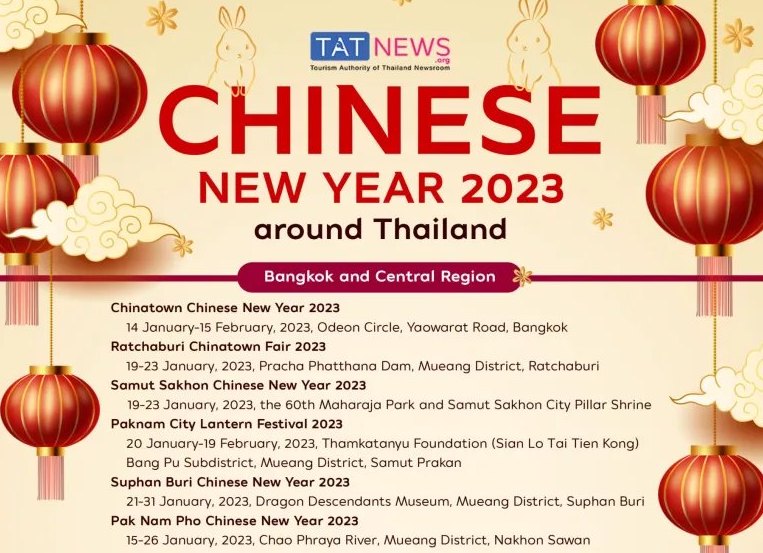
I saw this in my feed online and thought it might be interesting to go to the Bangkok Chinatown for Chinese New Year. I had never been to Chinatown on Chinese New Years in all my years in Bangkok . . . plus, the Bangkok Chinatown is the largest Chinatown outside of China. I took the Bangkok underground and popped out . . .
[This trip was also an opportunity to test my new camera, the Fuji X-T5, in a variety of challenging lighting conditions: bright sunlight, deep shadow, and night street photography. The X-T5 takes 40mp photos, but are posted here in only 850px on the long edge. You be the judge . . . but I am very happy with the results!]
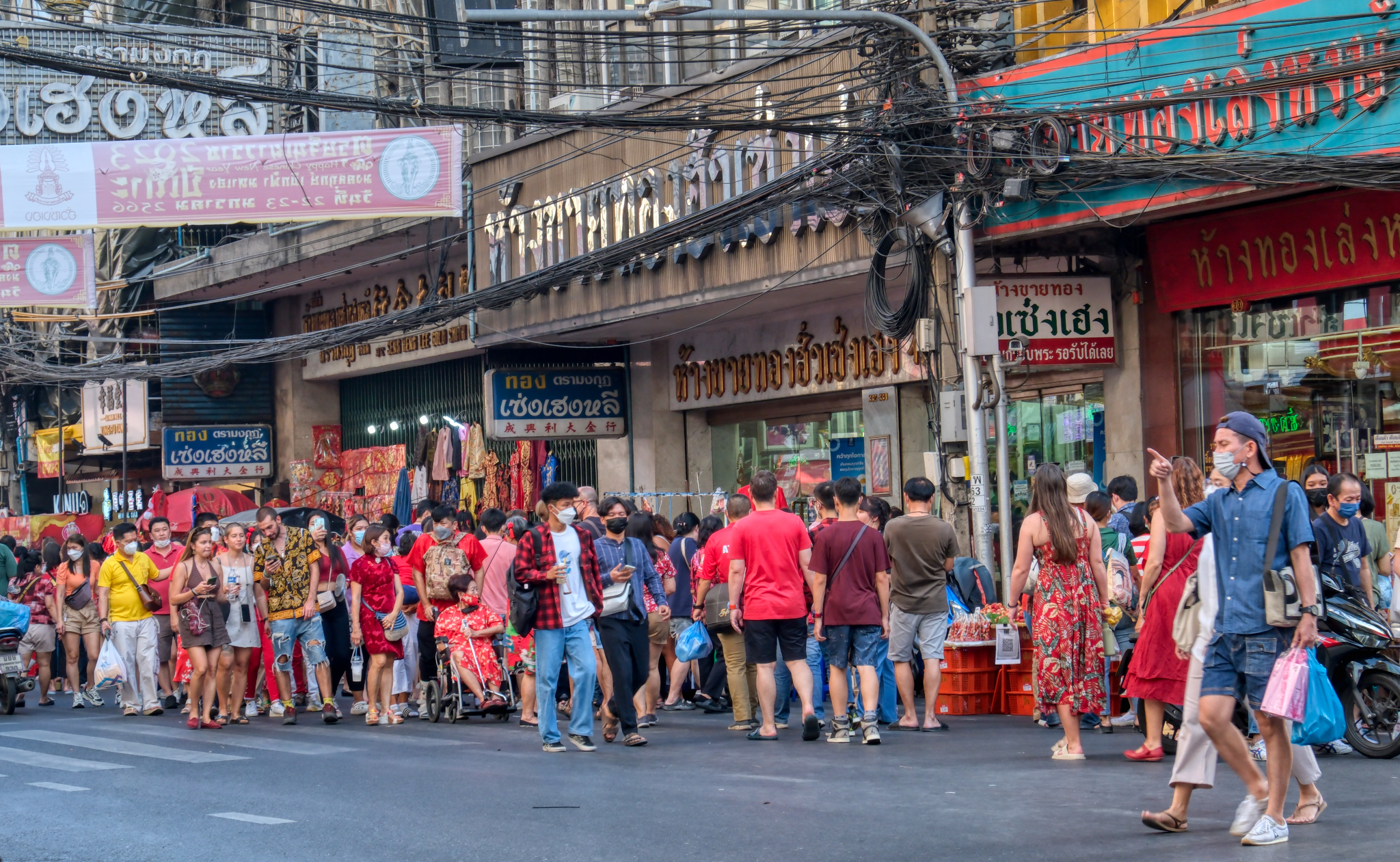 . . . I popped out a few blocks from the center of Chinatown . . . in the middle of a huge crowd. It seems that I was not the only one with the idea.
. . . I popped out a few blocks from the center of Chinatown . . . in the middle of a huge crowd. It seems that I was not the only one with the idea.
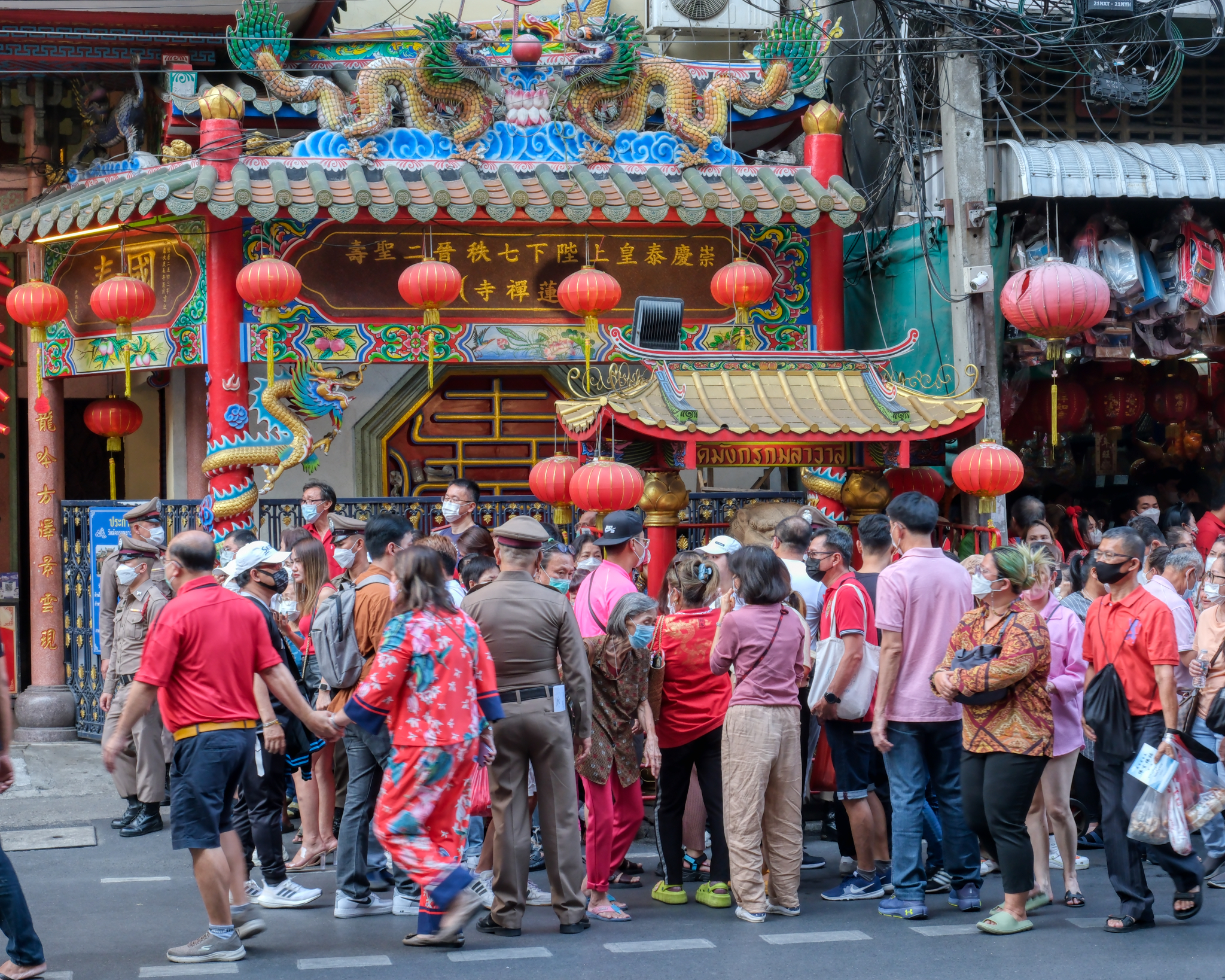 Part of the crowd was congregating around this Chinese Temple. We found out that one of the Thai Royal Family was due to arrive there soon to pay respects. It was a big day in the Bangkok Chinatown.
Part of the crowd was congregating around this Chinese Temple. We found out that one of the Thai Royal Family was due to arrive there soon to pay respects. It was a big day in the Bangkok Chinatown.
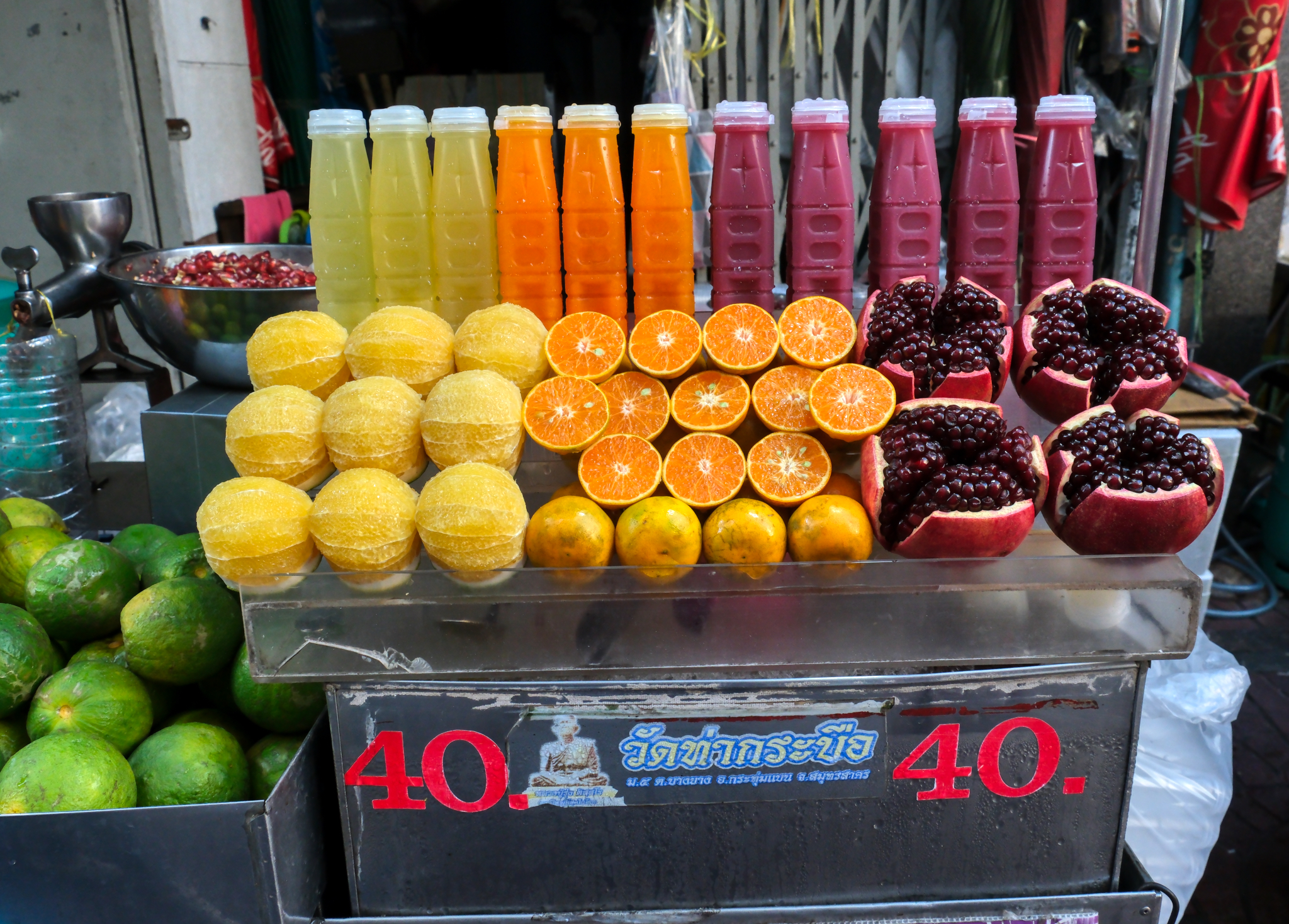 I was hot and thirsty so I bought a pomegranate juice and was happy.
I was hot and thirsty so I bought a pomegranate juice and was happy.
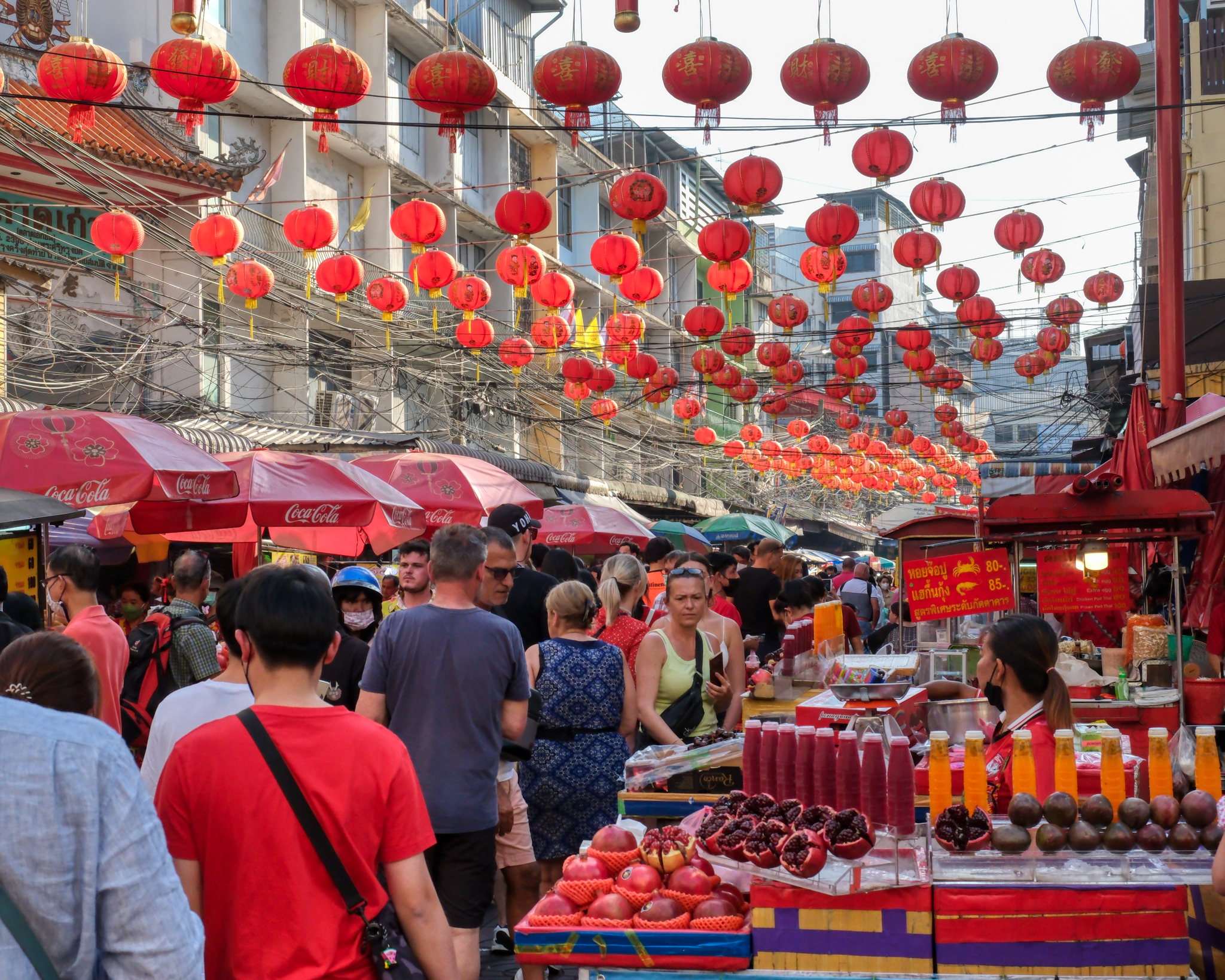 We cut through an alley to get to the center of the action. The whole highly decorated area was a crush of people, many of whom were foreign tourists.
We cut through an alley to get to the center of the action. The whole highly decorated area was a crush of people, many of whom were foreign tourists.
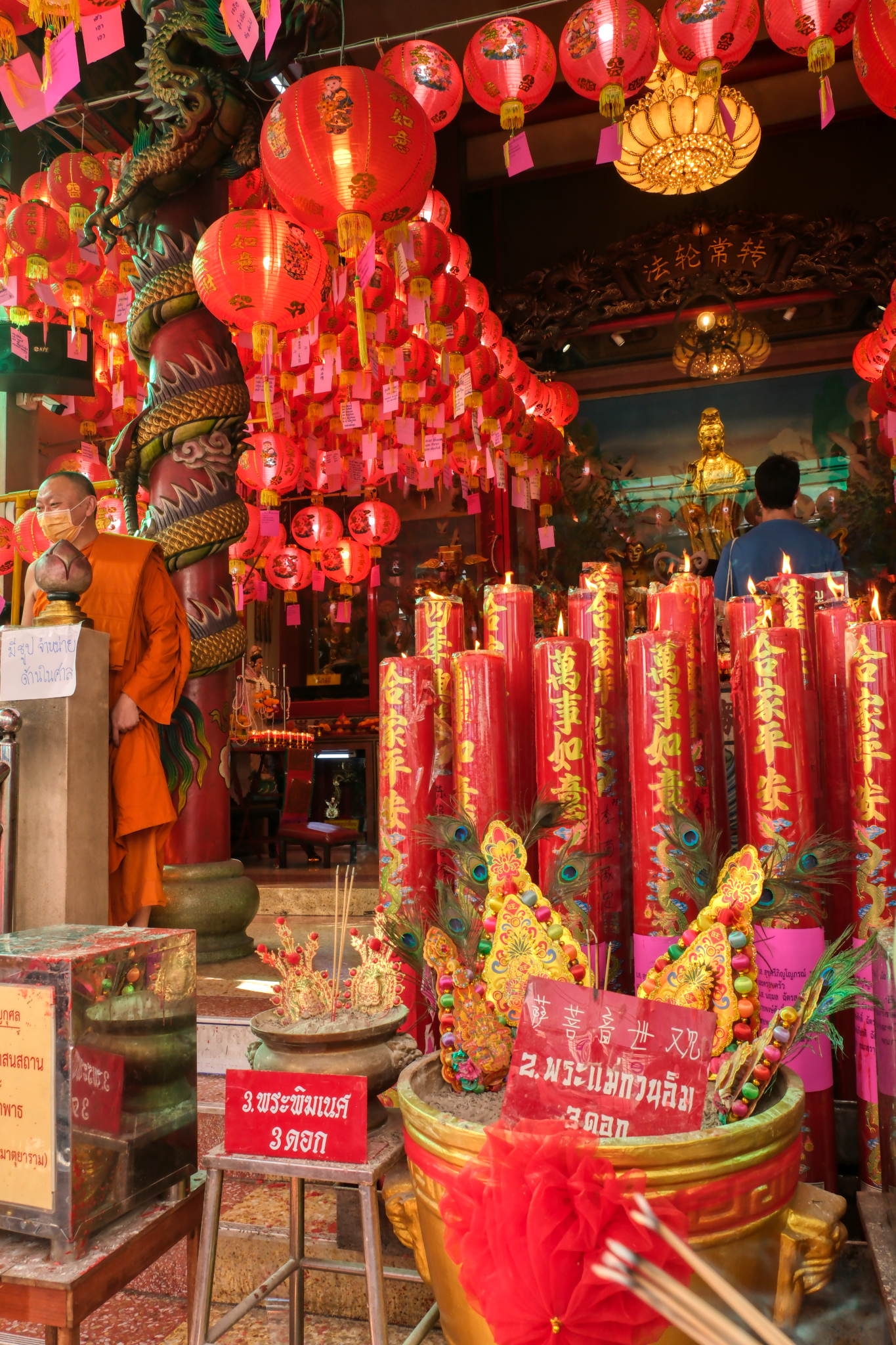 The many small Chinese temples were busy with devotees leaving alms and donations and being blessed by the monks.
The many small Chinese temples were busy with devotees leaving alms and donations and being blessed by the monks.
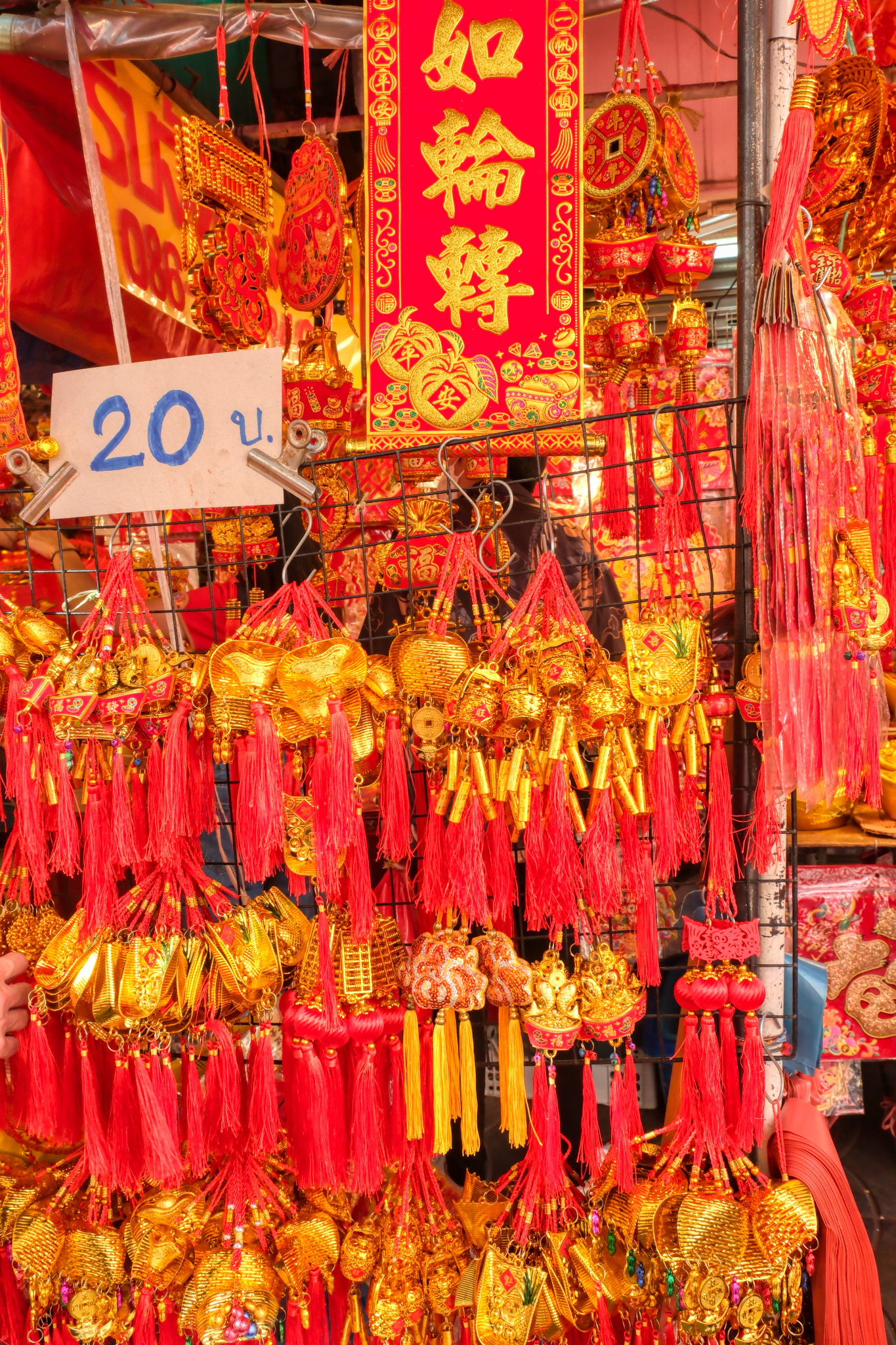 Every imaginable kind of 'altar toy' was for sale in gold and red. Fantastic!
Every imaginable kind of 'altar toy' was for sale in gold and red. Fantastic!
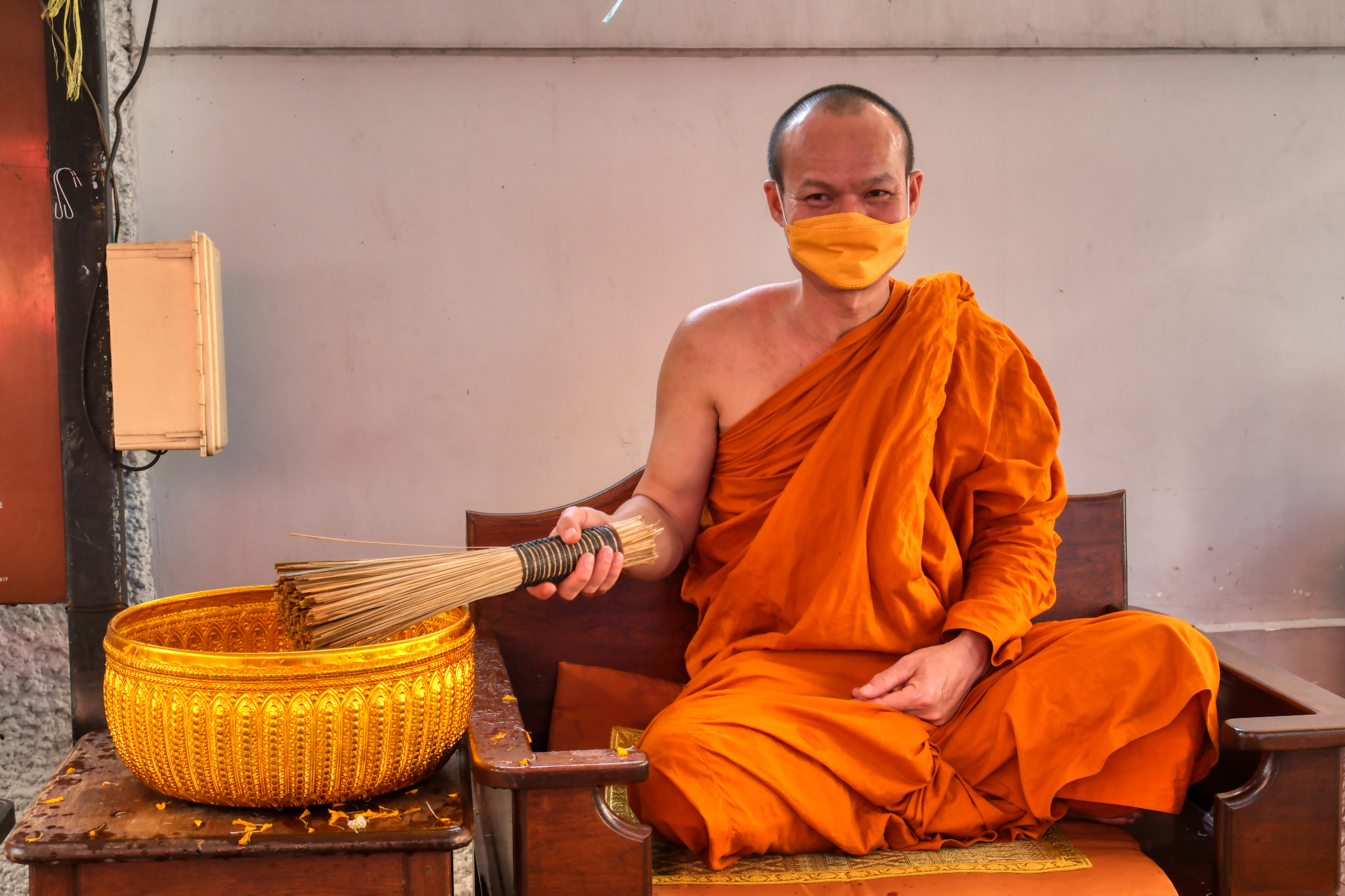 This good natured monk seemed to enjoy giving water blessings to whomever stopped and donated.
This good natured monk seemed to enjoy giving water blessings to whomever stopped and donated.
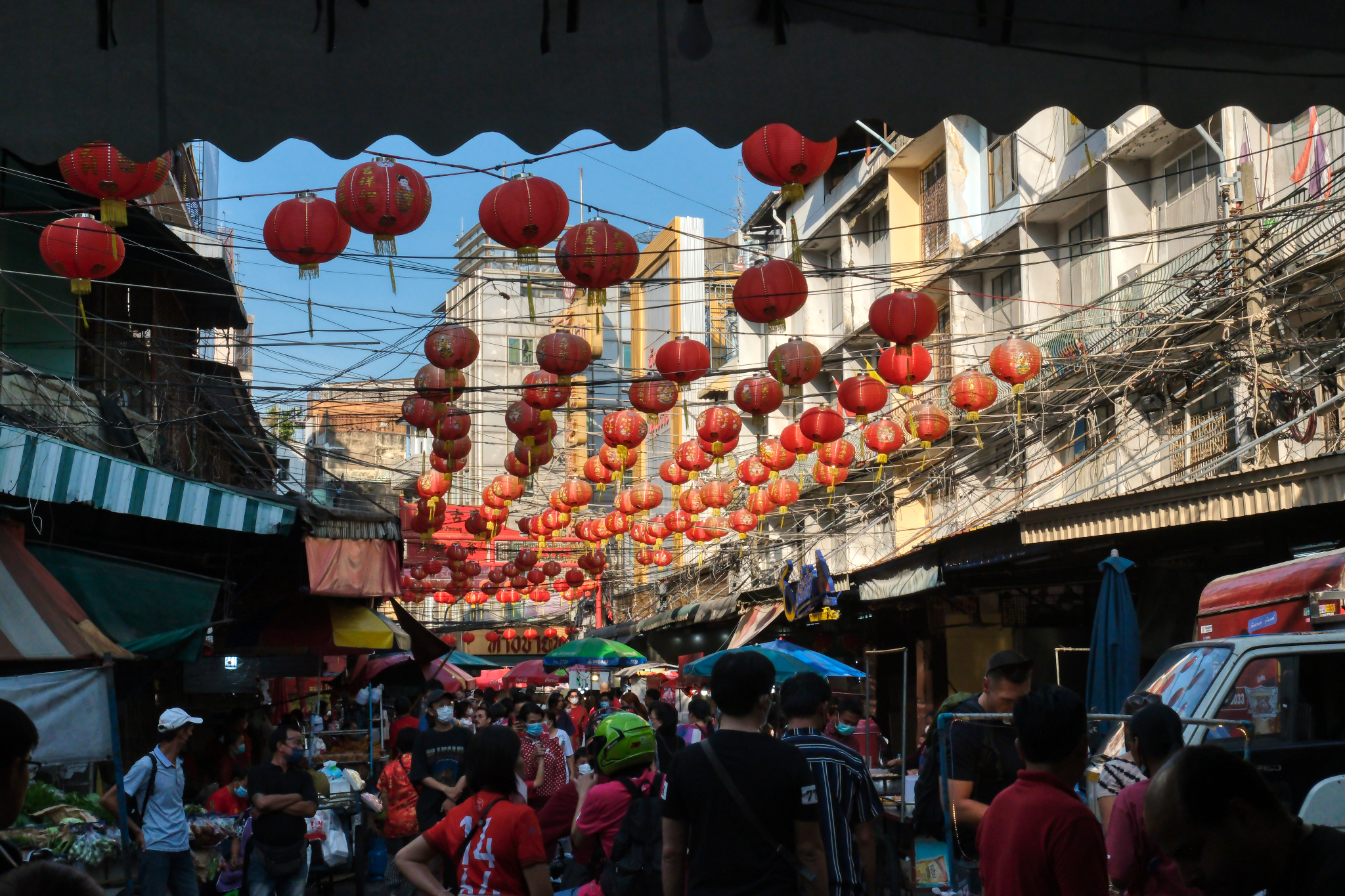 We explpored deep down the beautifully decorated side streets of Bangkok's Chinatown.
We explpored deep down the beautifully decorated side streets of Bangkok's Chinatown.
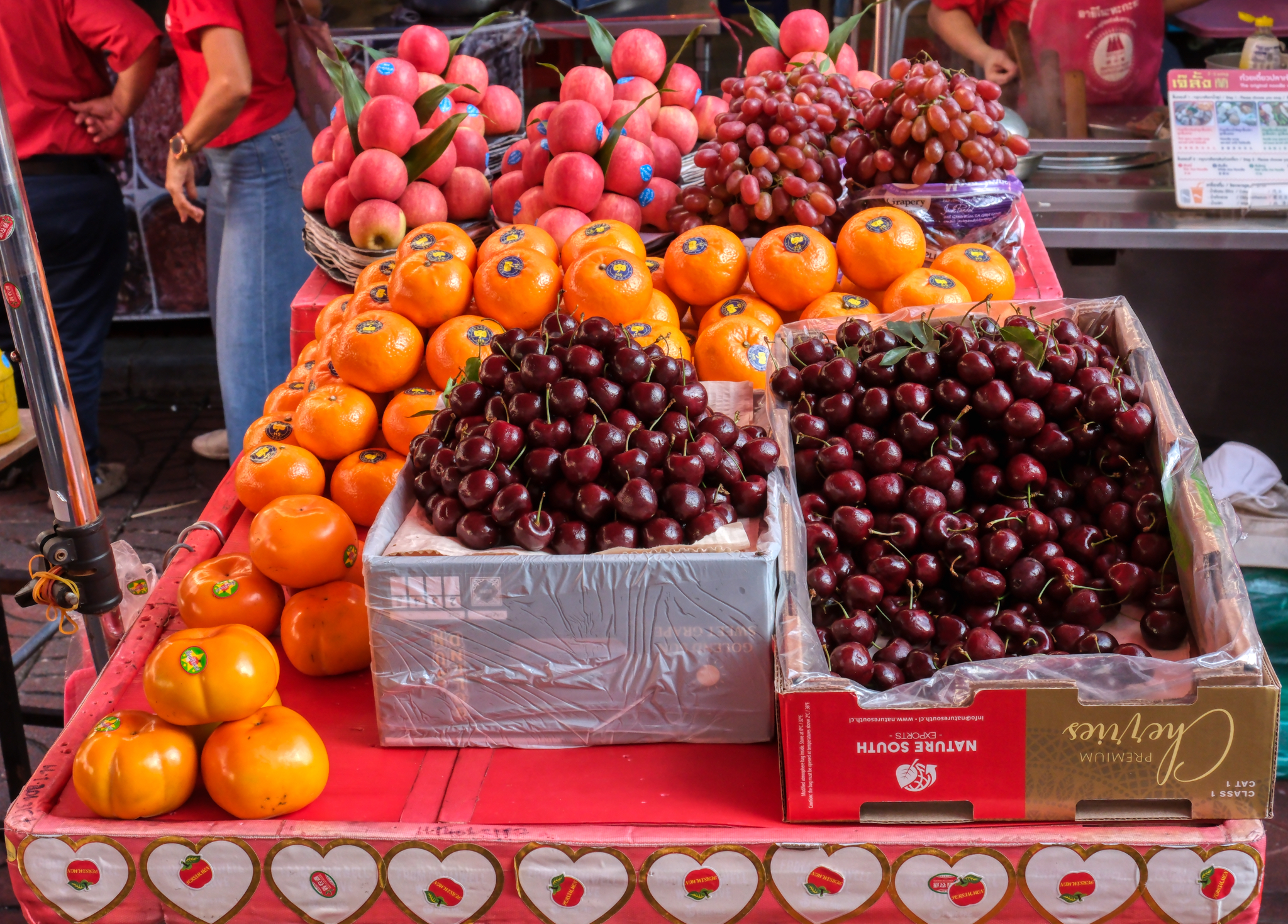 Chinese New Year is a traditional time for fruit purchasing, apparently.
Chinese New Year is a traditional time for fruit purchasing, apparently.
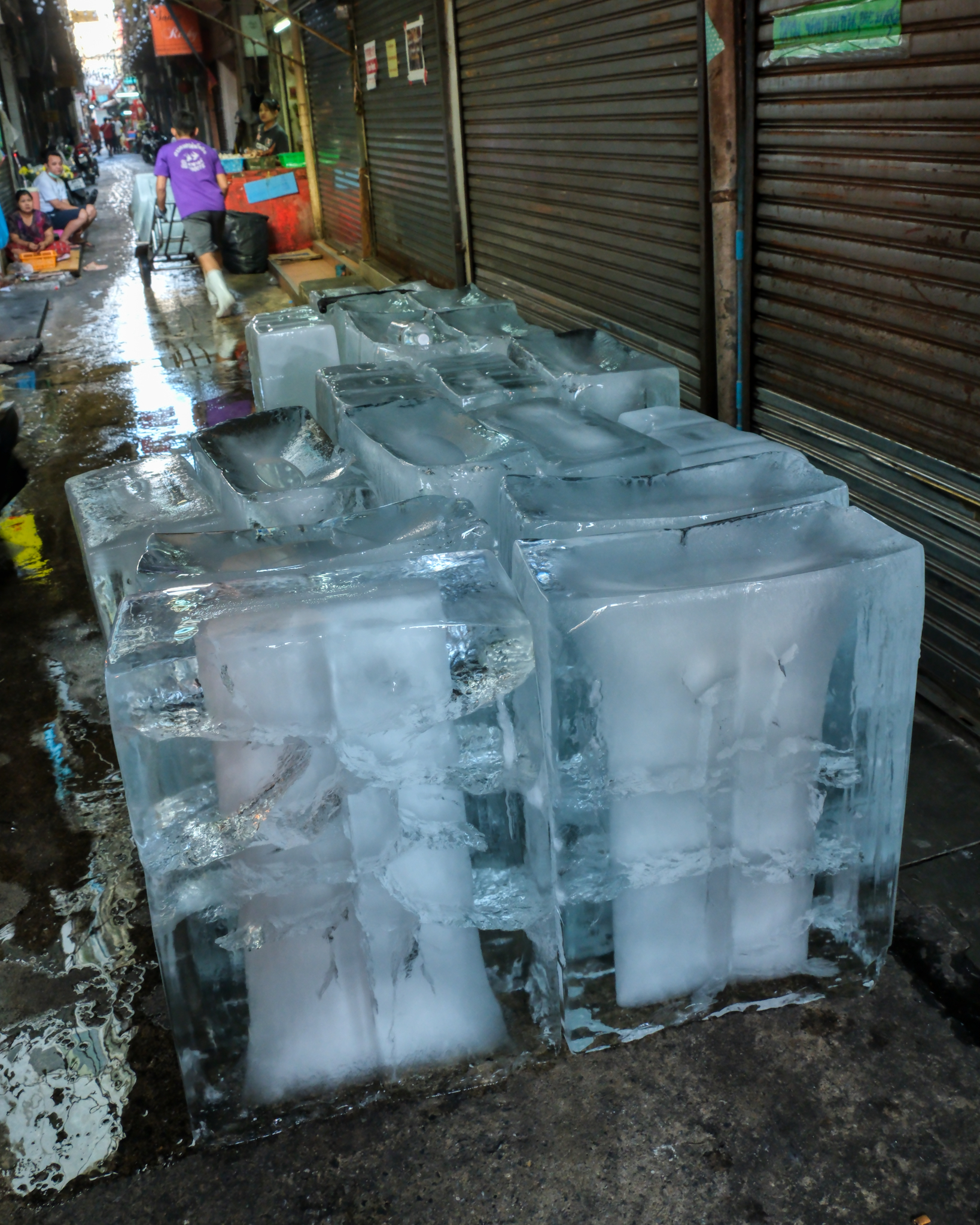 These ice blocks sitting in an alley looked inviting . . . as a shortcut over to the next street . . . and as a way of avoiding the crushing crowds.
These ice blocks sitting in an alley looked inviting . . . as a shortcut over to the next street . . . and as a way of avoiding the crushing crowds.
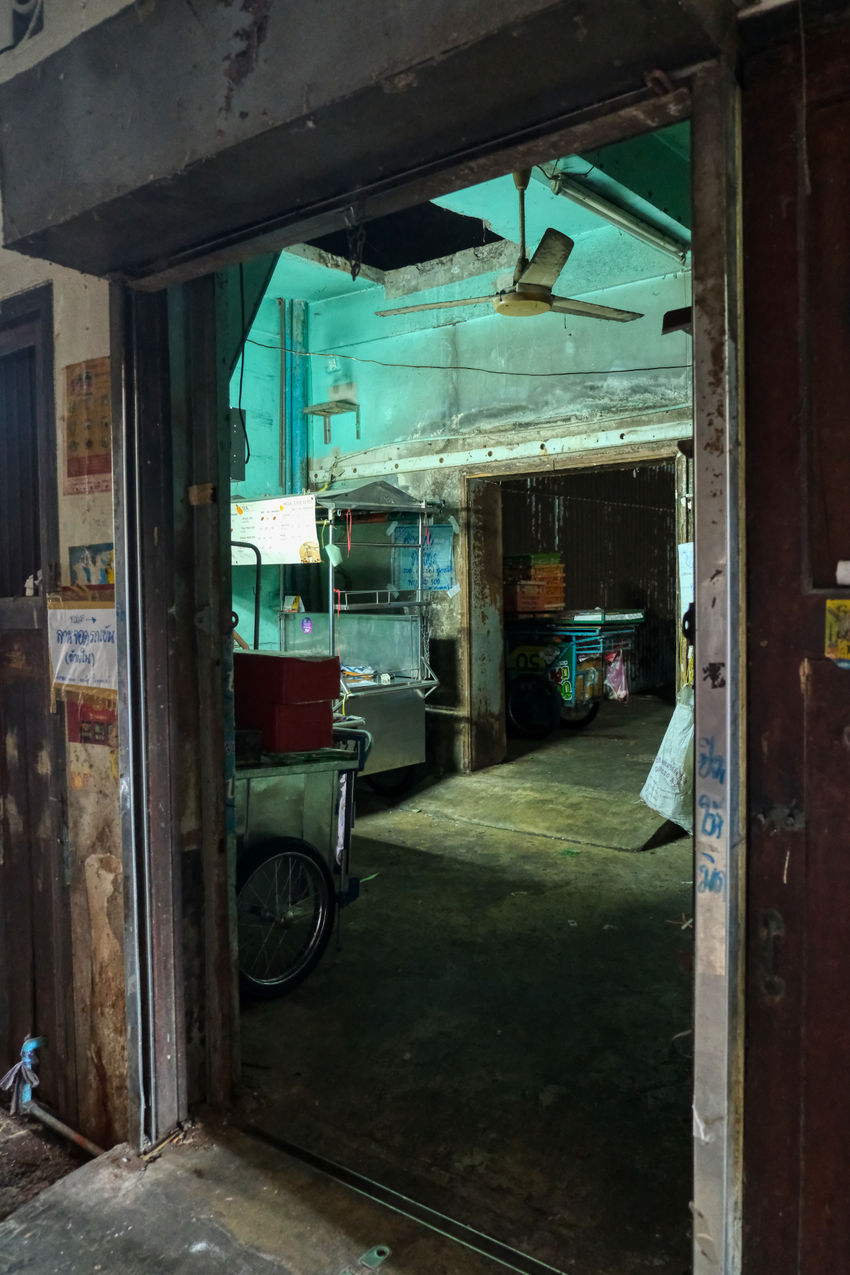 Chinatown alleys always offer up surprise images, like this very old small industry.
Chinatown alleys always offer up surprise images, like this very old small industry.
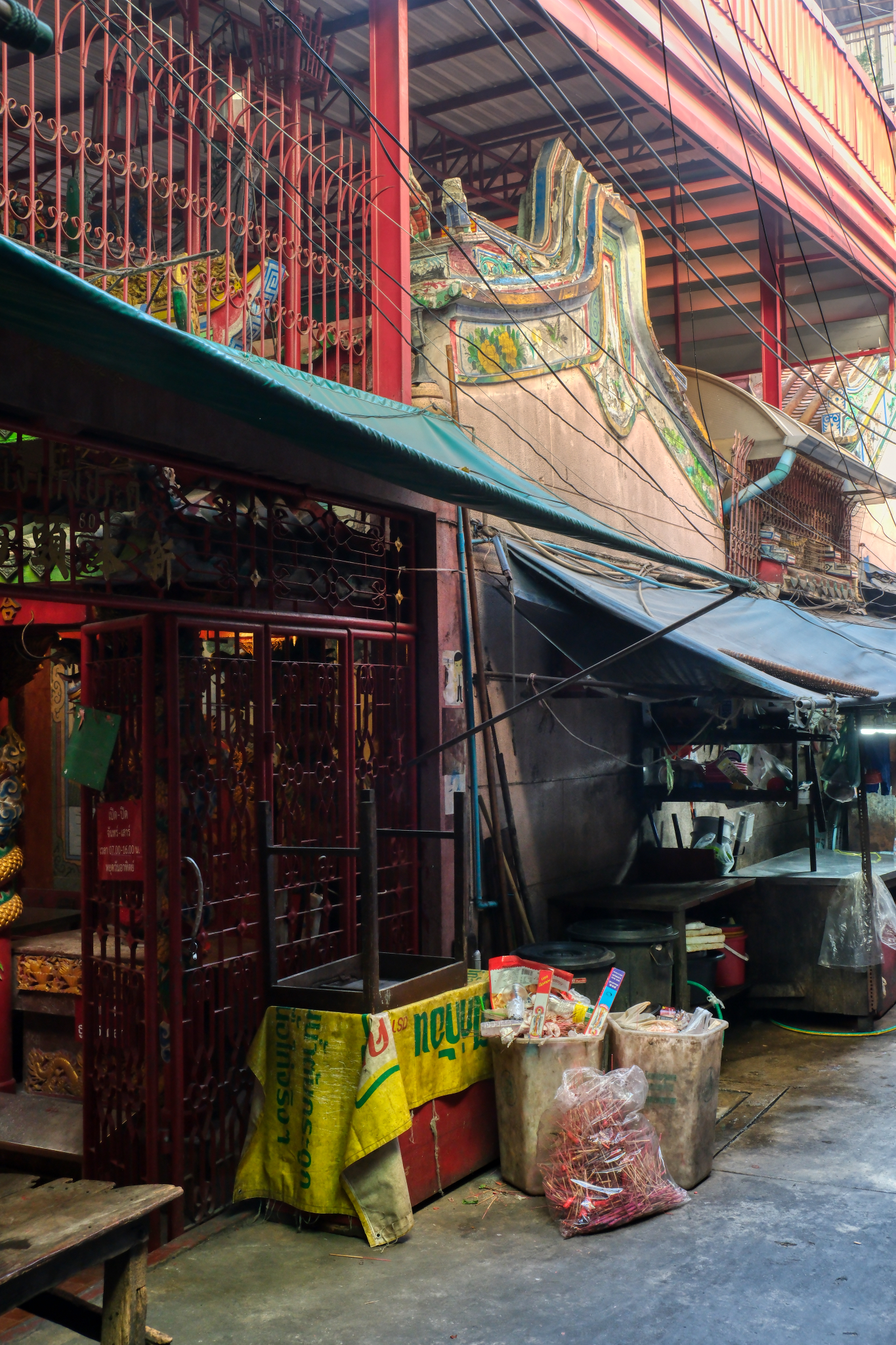 Spotted amid the complex patterns of the alley was some kind of temple . . . let's explore . . .
Spotted amid the complex patterns of the alley was some kind of temple . . . let's explore . . .
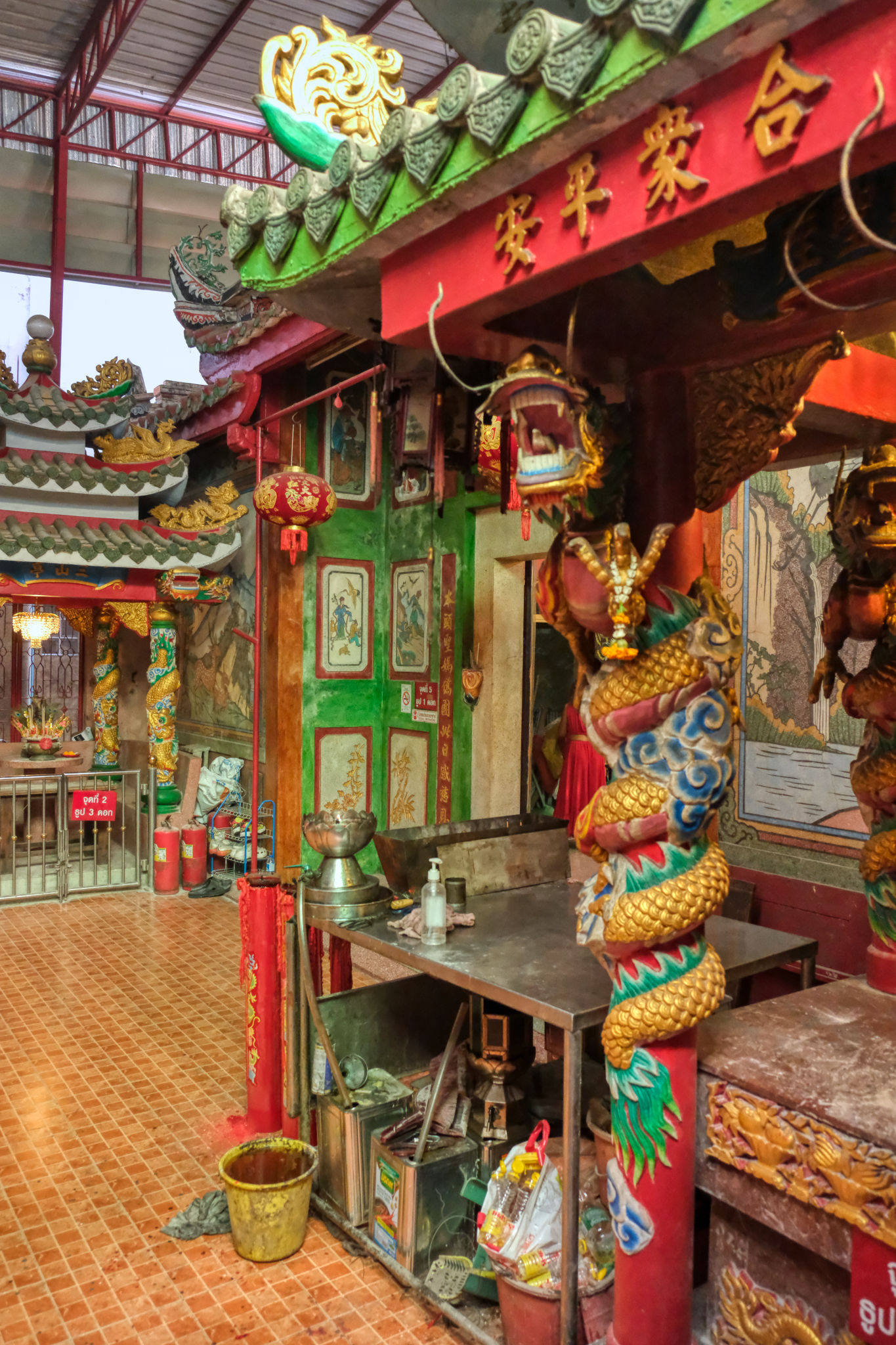 Looking inside, we found this marvelous Chinese Buddhist Temple. Serendipity!
Looking inside, we found this marvelous Chinese Buddhist Temple. Serendipity!
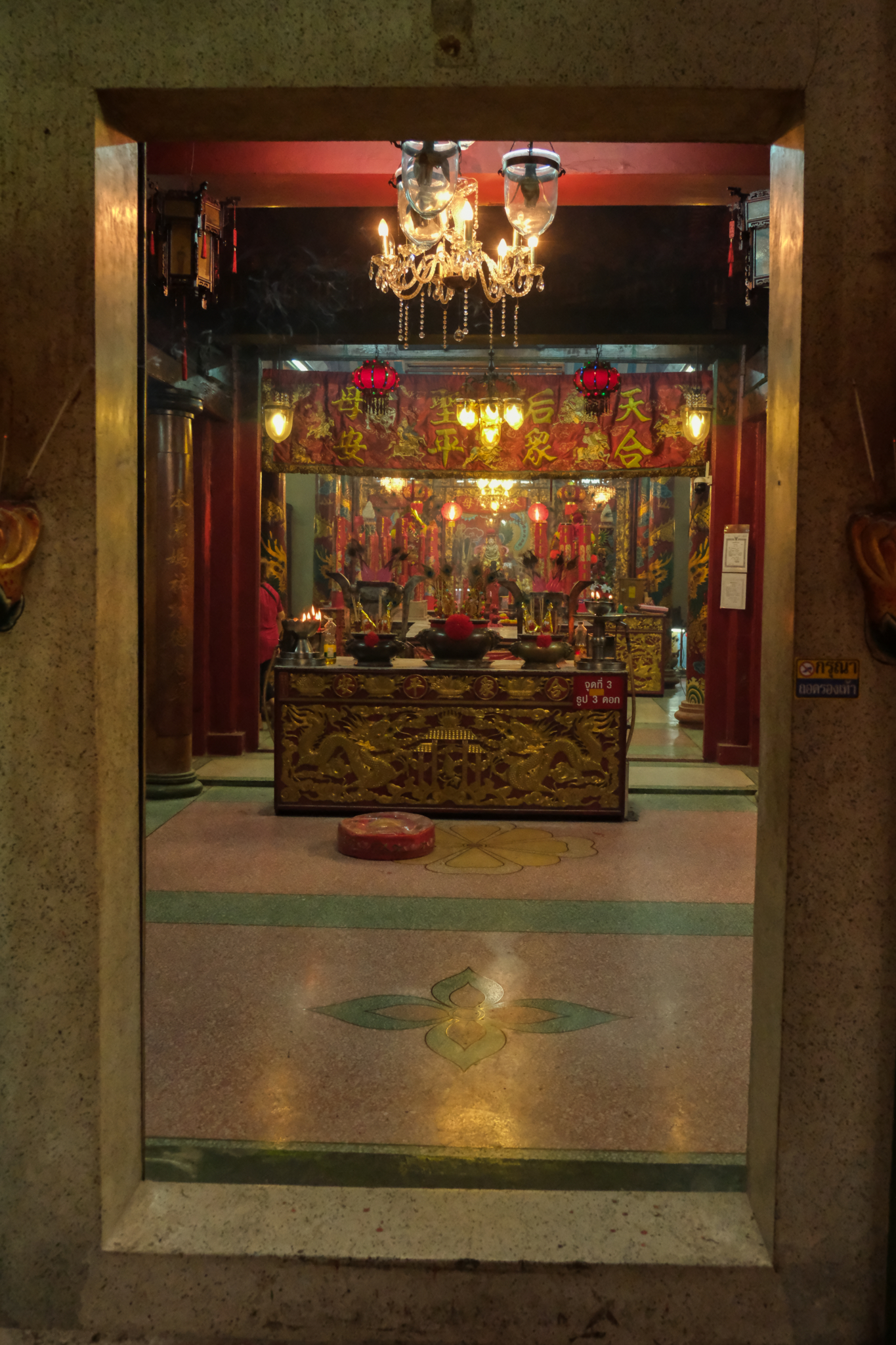 The temple inner altar was fantastically decorated.
The temple inner altar was fantastically decorated.
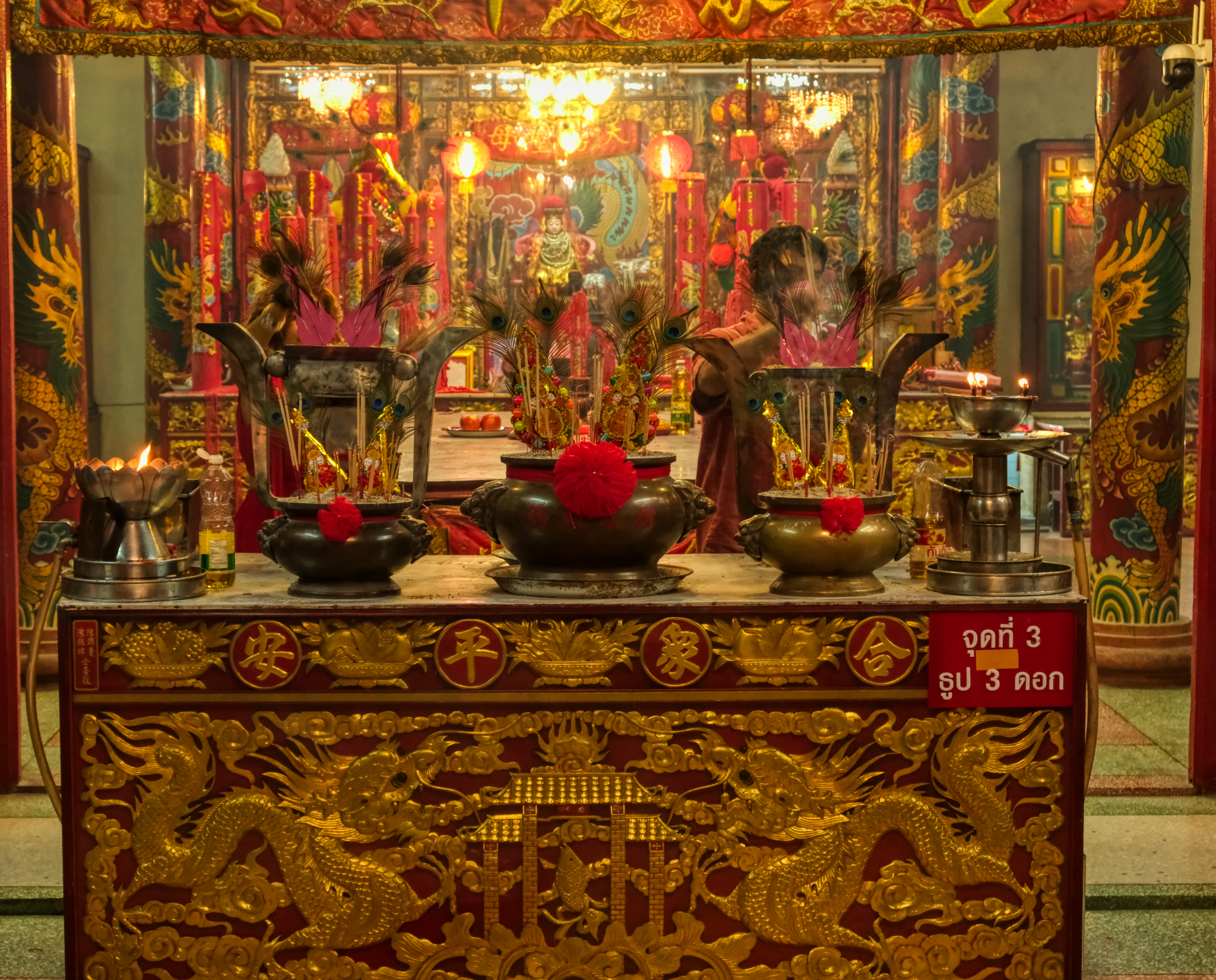 The inner temple altar in all its phantasmagoria!
The inner temple altar in all its phantasmagoria!
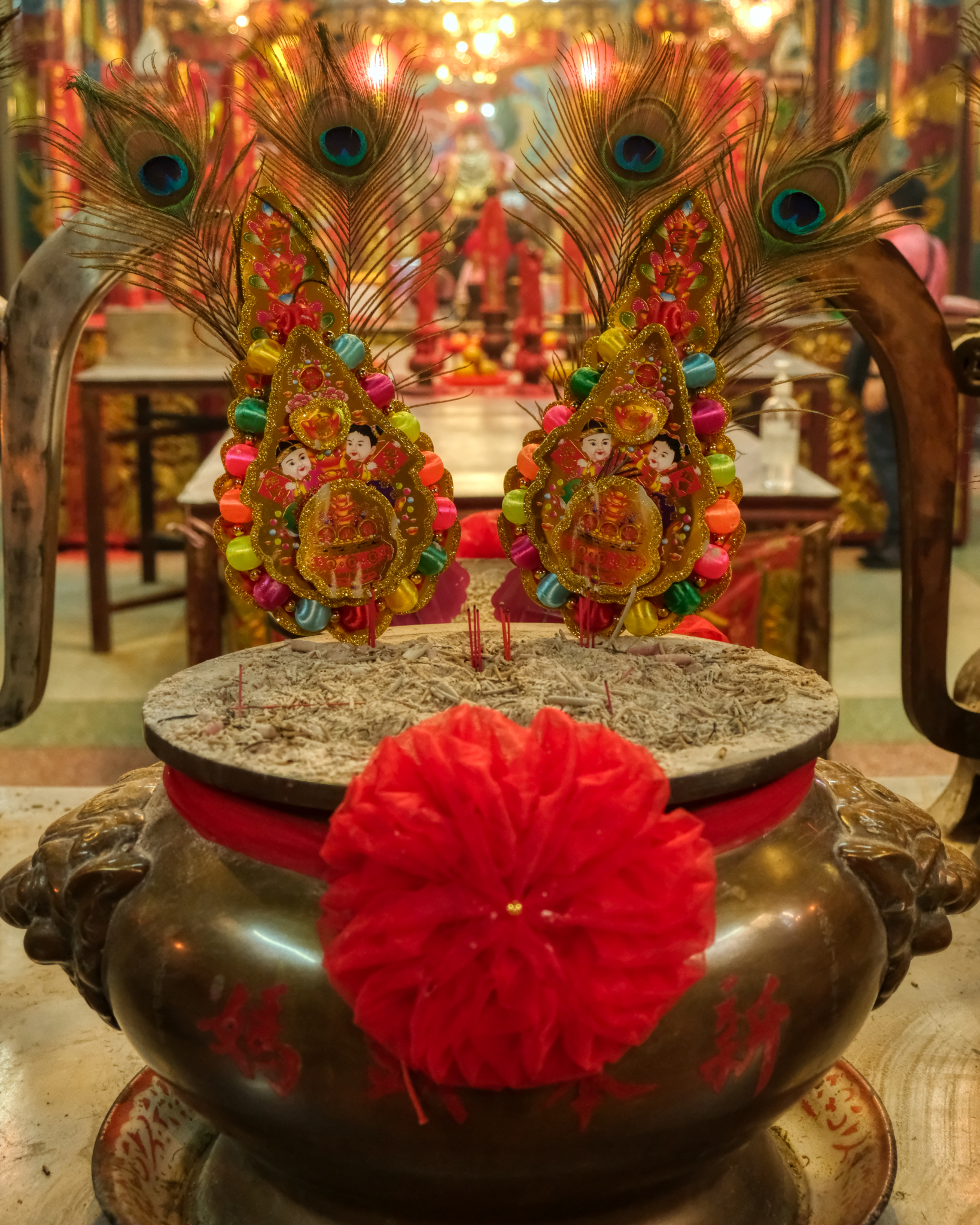 Incense pot . . .
Incense pot . . .
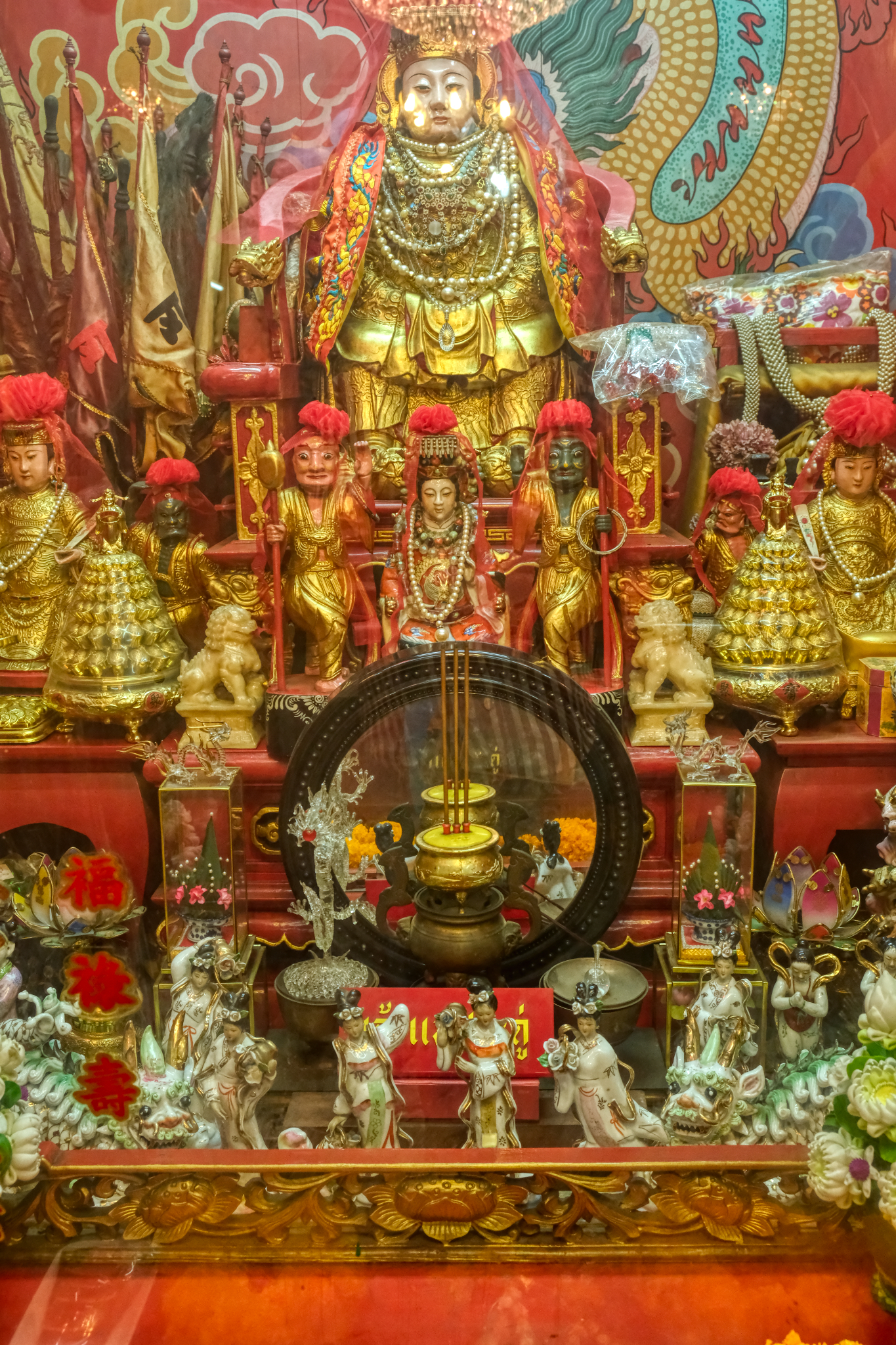 The main altar displayed the pantheon of Chinese spiritual deities and revered monks behind glass.
The main altar displayed the pantheon of Chinese spiritual deities and revered monks behind glass.
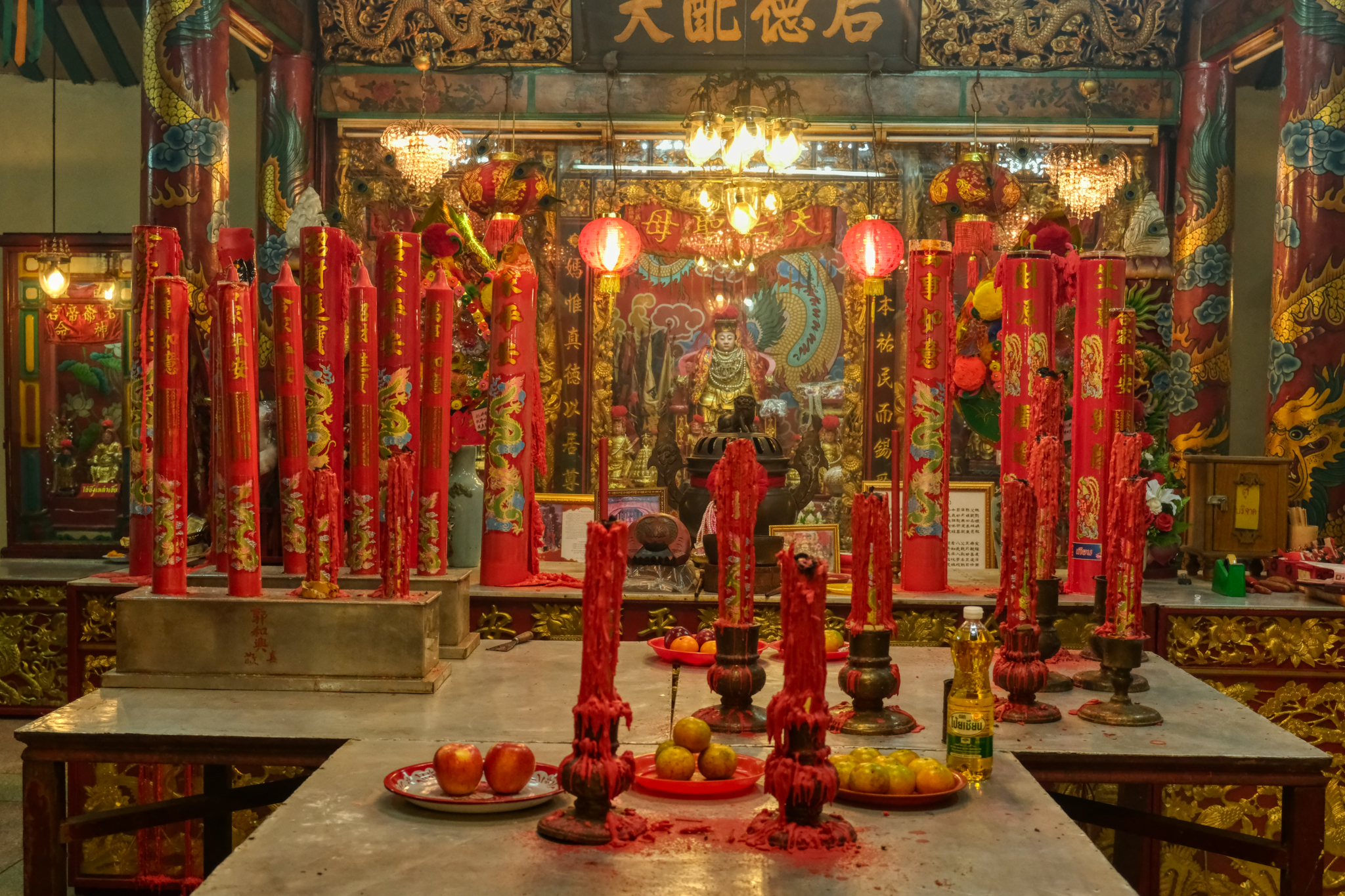 The opportunities for amazing photos were endless here . . . I took many more excellent photos in there than I have posted here . . . perhaps I need an entry just for this marvelous place.
The opportunities for amazing photos were endless here . . . I took many more excellent photos in there than I have posted here . . . perhaps I need an entry just for this marvelous place.
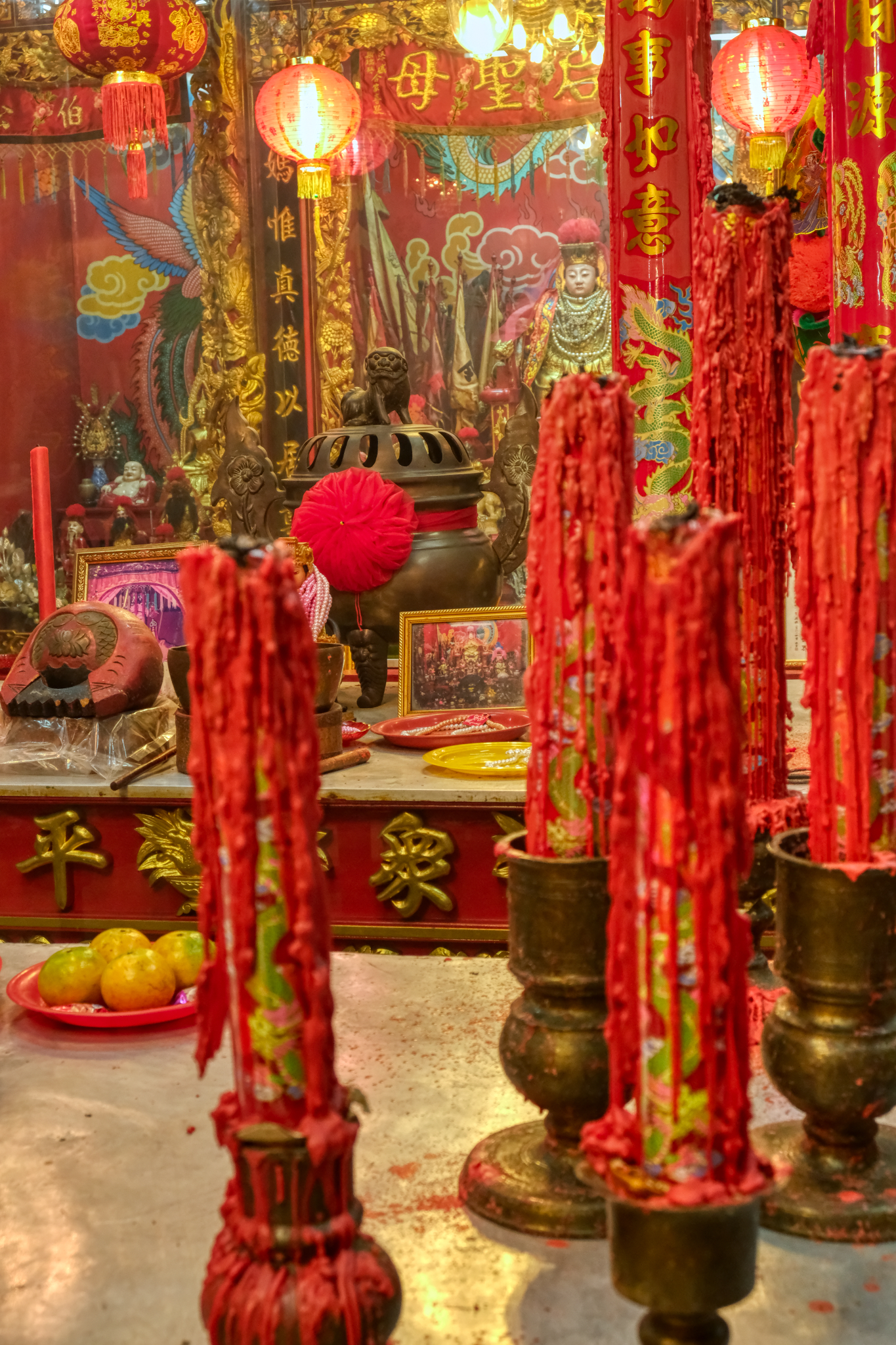 These were very low light (and smoky) conditions for photography . . . such beauty everywhere!
These were very low light (and smoky) conditions for photography . . . such beauty everywhere!
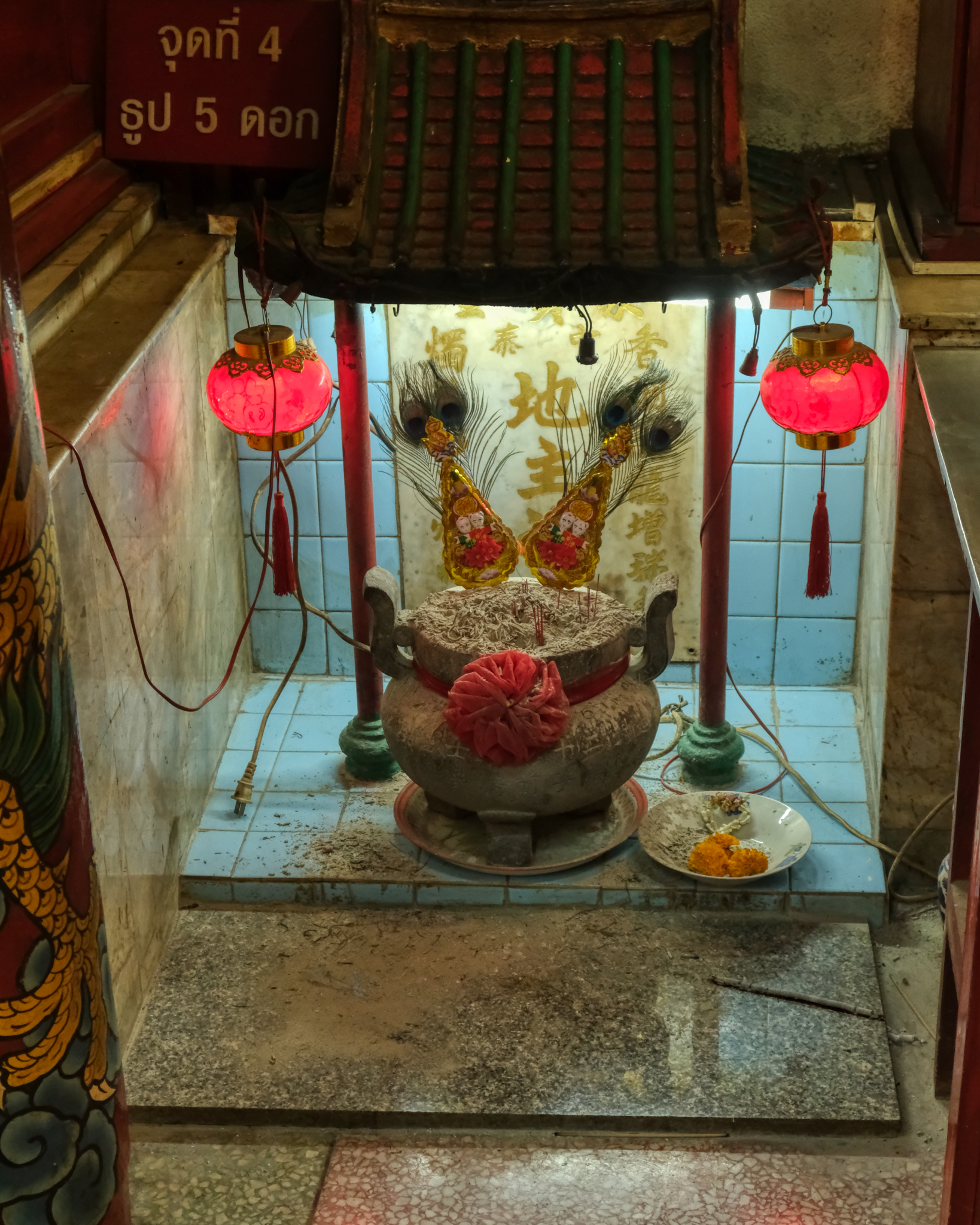 There were several small "side altars" around the inner chamber.
There were several small "side altars" around the inner chamber.
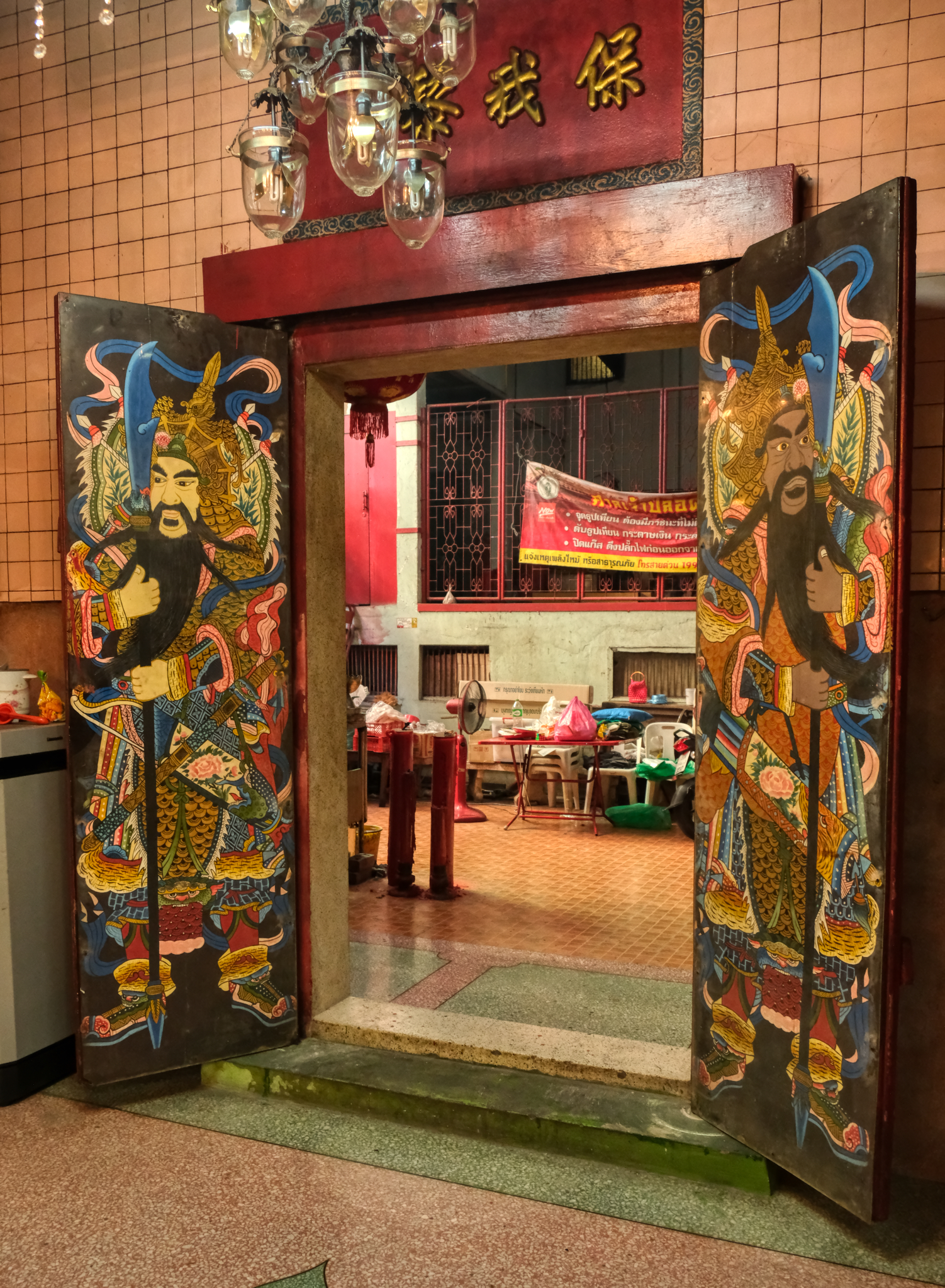 We spent quite a abit of time inside the Chinese Temple . . . and could have spent a whole day documenting this old, photogenic, spiritual space . . . but we left for the alley again and onward to the New Year celebrations about to happen.
We spent quite a abit of time inside the Chinese Temple . . . and could have spent a whole day documenting this old, photogenic, spiritual space . . . but we left for the alley again and onward to the New Year celebrations about to happen.
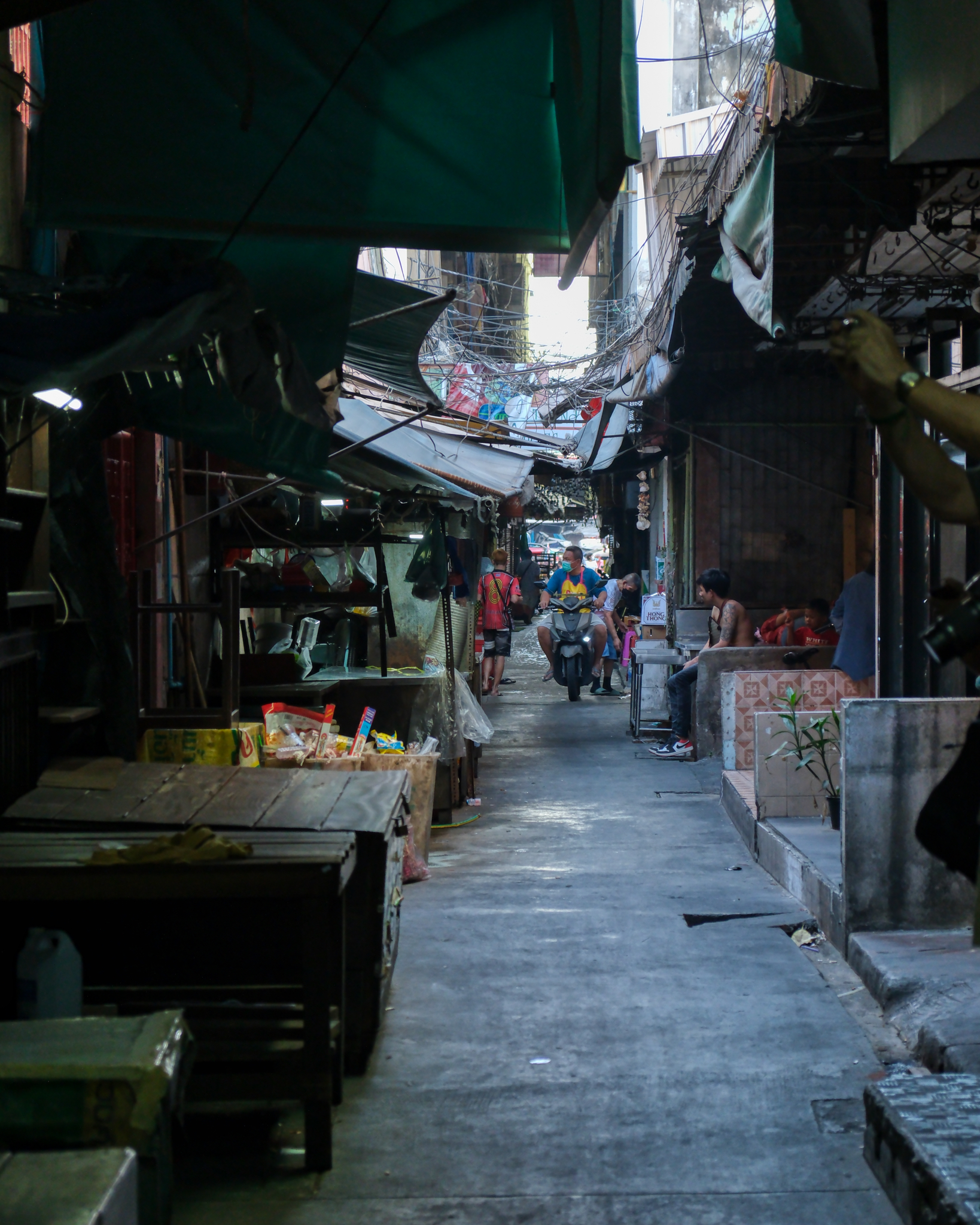 Back out in the small alley . . . it is fun to explore for images here.
Back out in the small alley . . . it is fun to explore for images here.
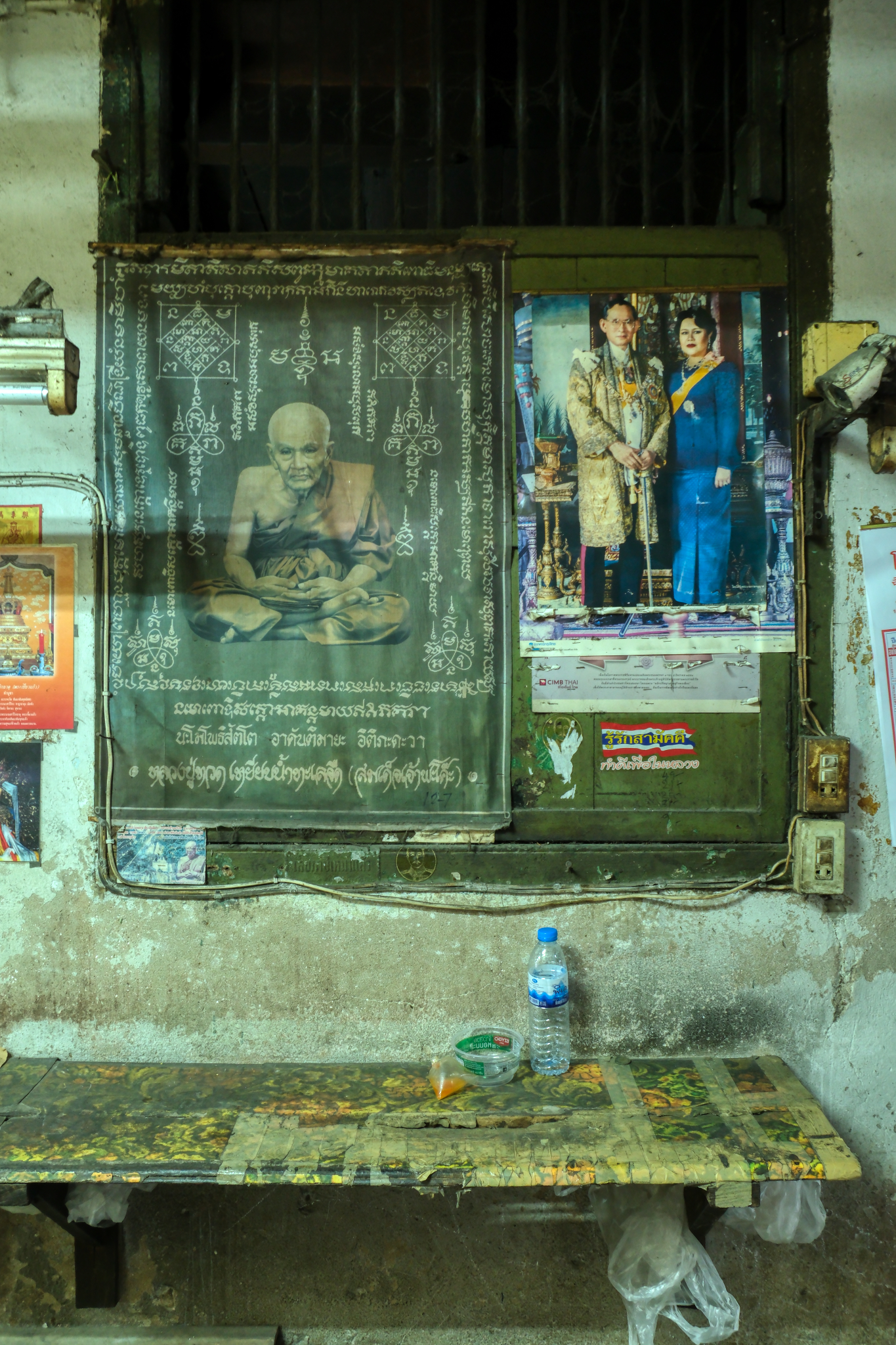 Many visual wonders to see along the alley walls . . .
Many visual wonders to see along the alley walls . . .
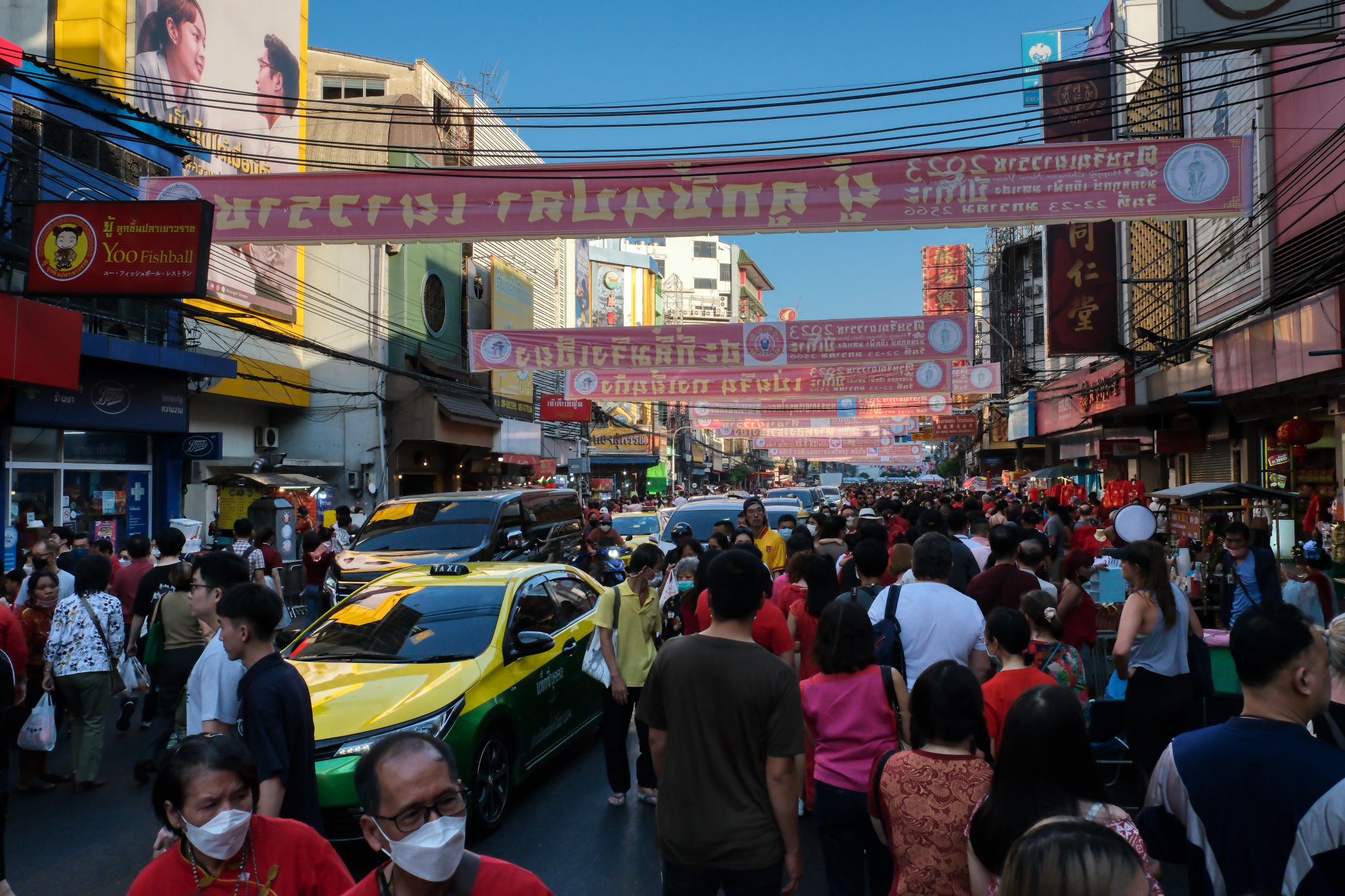 We popped out on the very crowded main street leading to the performance stage . . .
We popped out on the very crowded main street leading to the performance stage . . .
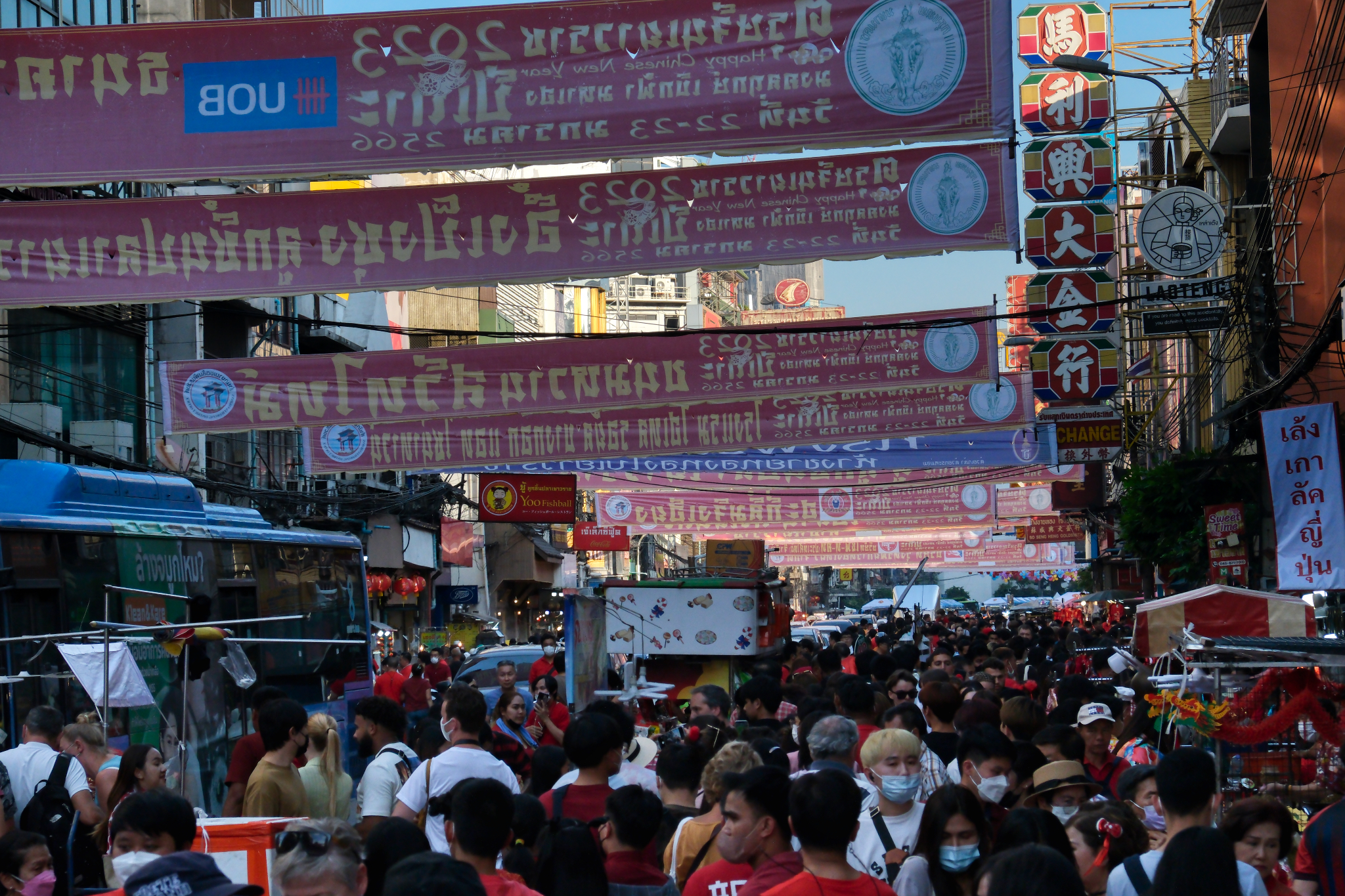 Moments before the street was finally closed to auto traffic . . . and vendors and 'selfie' takers took over.
Moments before the street was finally closed to auto traffic . . . and vendors and 'selfie' takers took over.
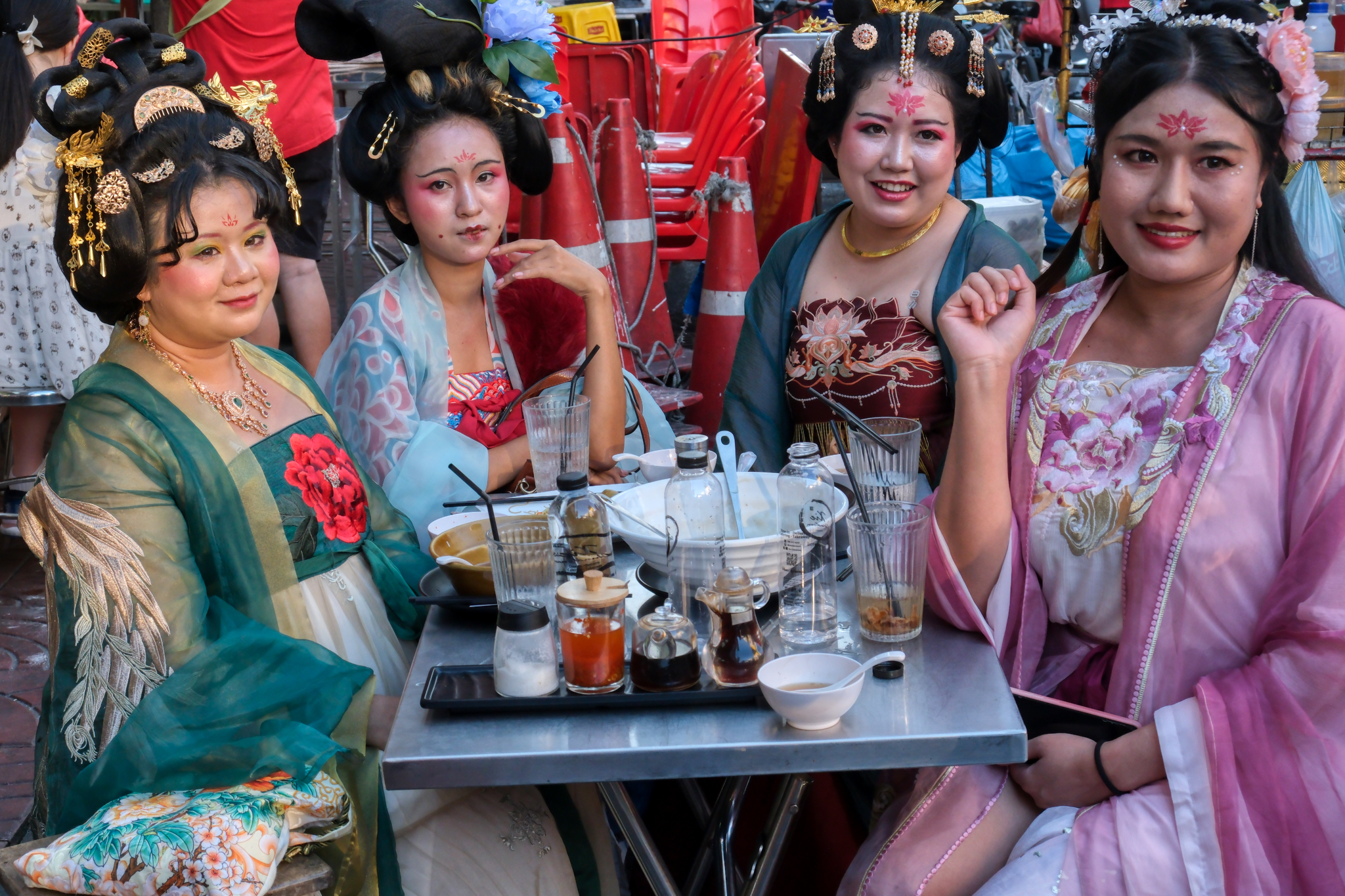 Four local ladies all dressed up for a night of celebration.
Four local ladies all dressed up for a night of celebration.
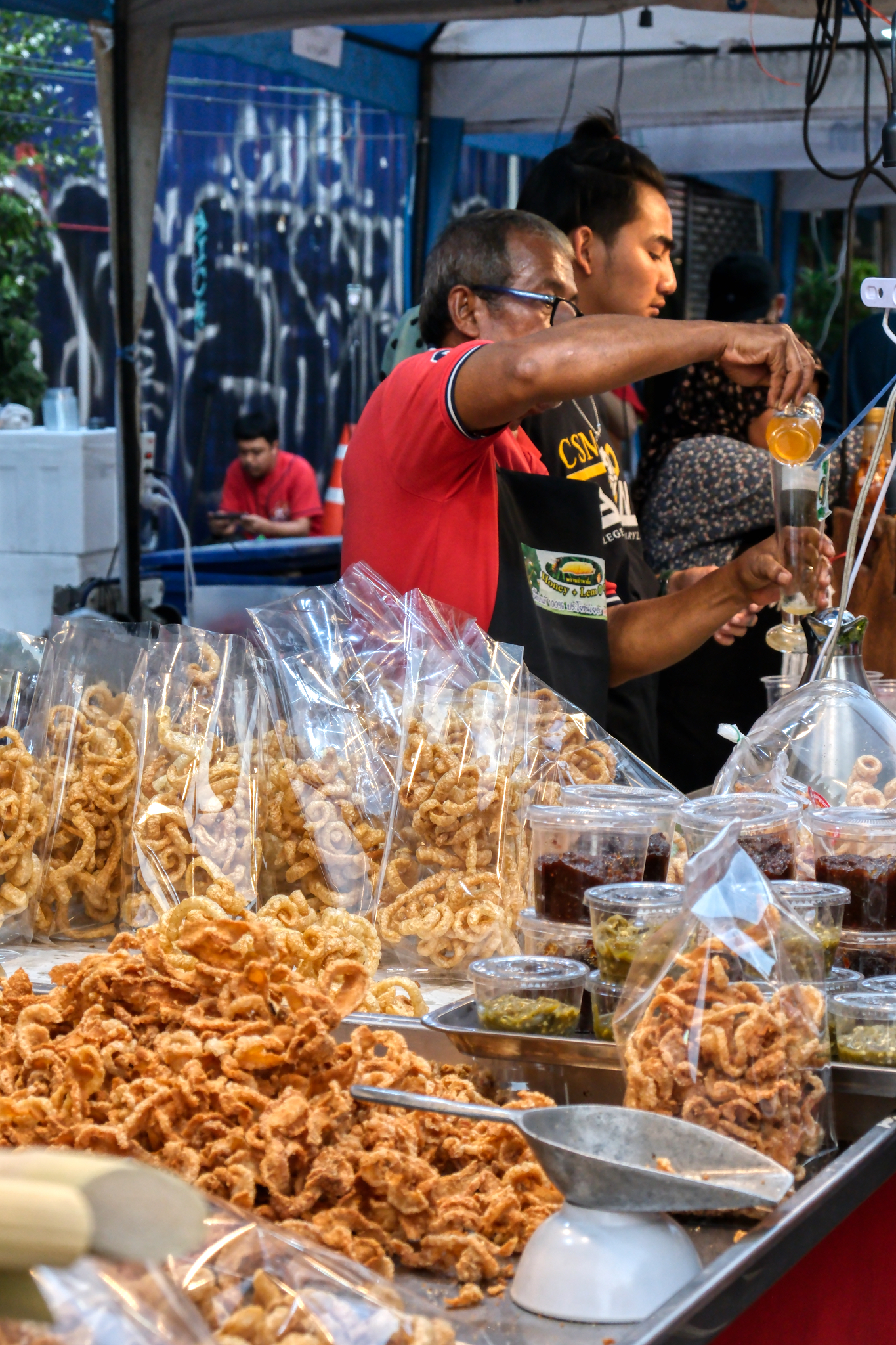 Plenty of goodies to eat . . . healthy and otherwise!
Plenty of goodies to eat . . . healthy and otherwise!
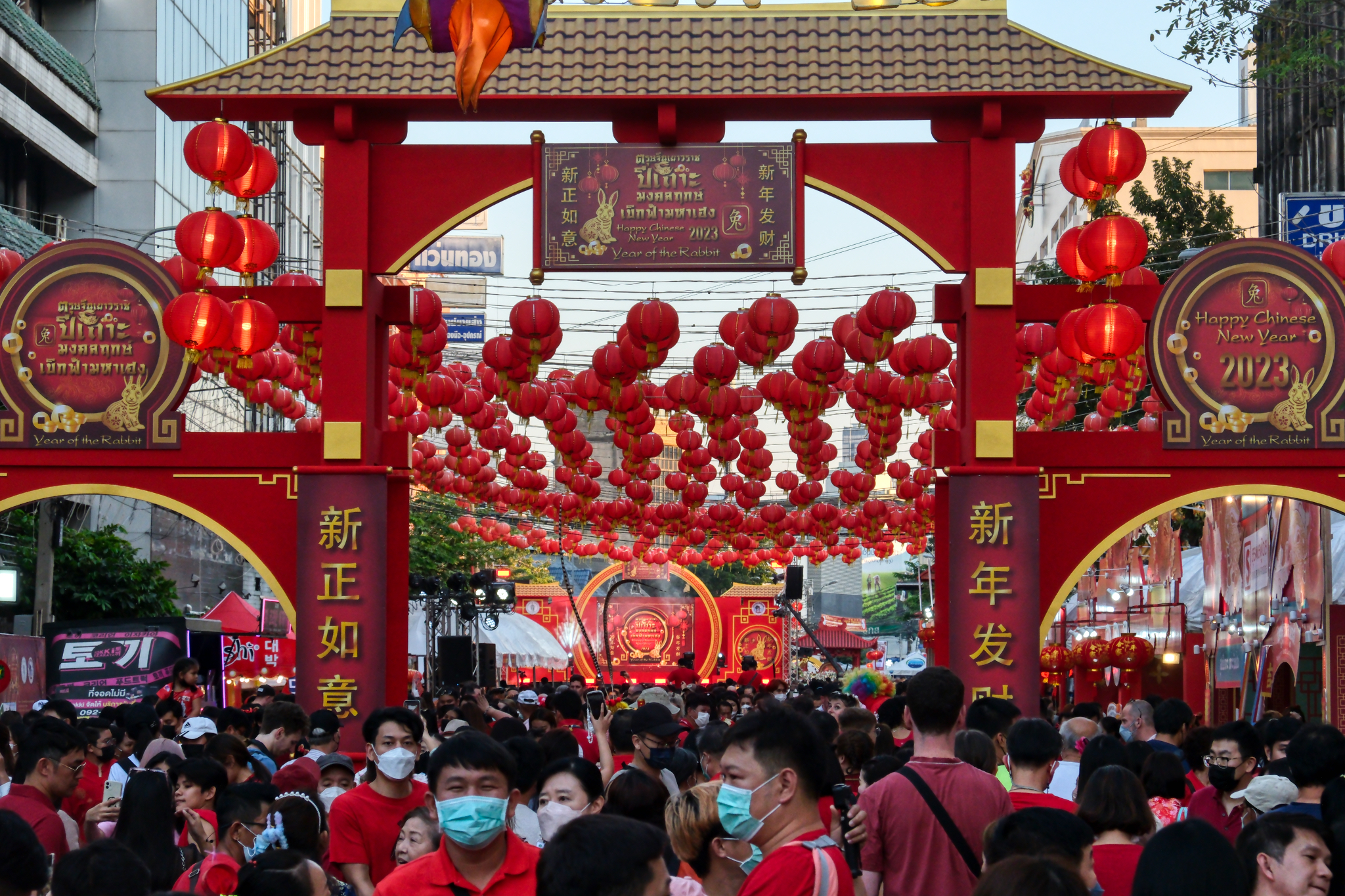 As evening approached the crowd migrated toward a "main stage" for the nighttime events.
As evening approached the crowd migrated toward a "main stage" for the nighttime events.
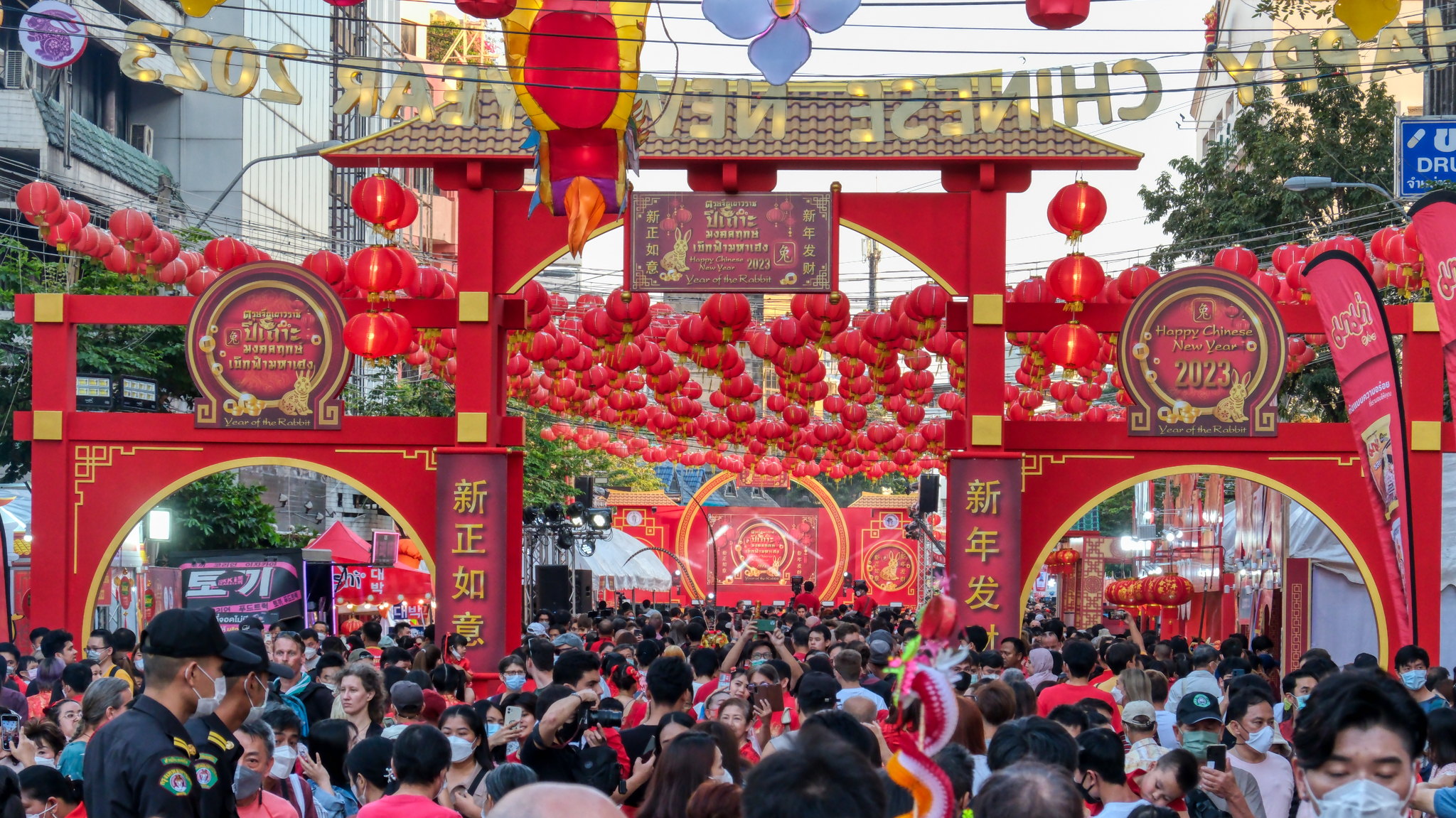 It became almost impossible to get to the intersection where the stage was set . . . but we somehow pushed our way through.
It became almost impossible to get to the intersection where the stage was set . . . but we somehow pushed our way through.
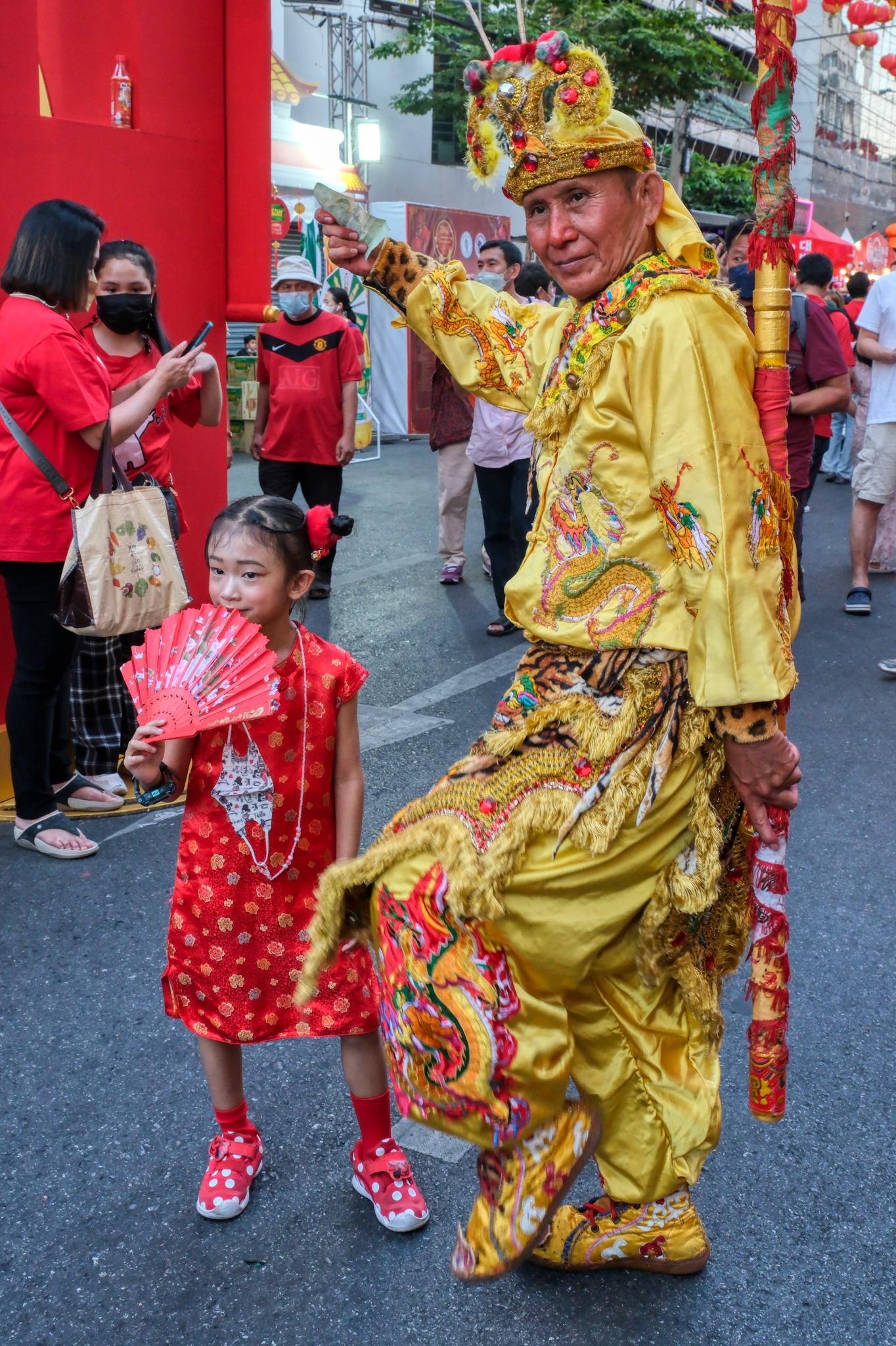 Revellers found time to pose with traditionally dressed street photo hawkers.
Revellers found time to pose with traditionally dressed street photo hawkers.
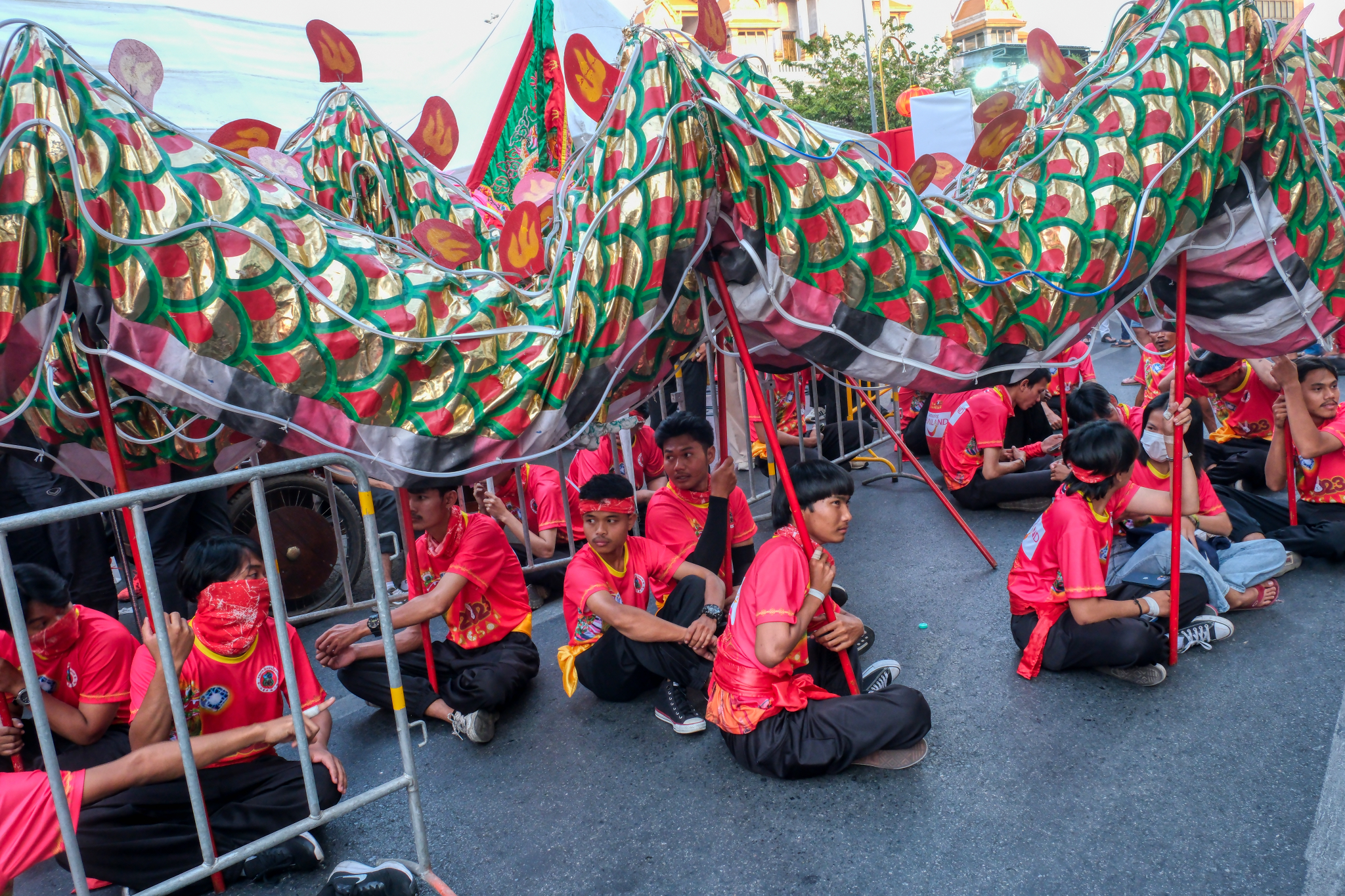 We finally made it to an area behind the stage where the handlers of the dragon were waiting to do their dragon dance down the crowded avenue.
We finally made it to an area behind the stage where the handlers of the dragon were waiting to do their dragon dance down the crowded avenue.
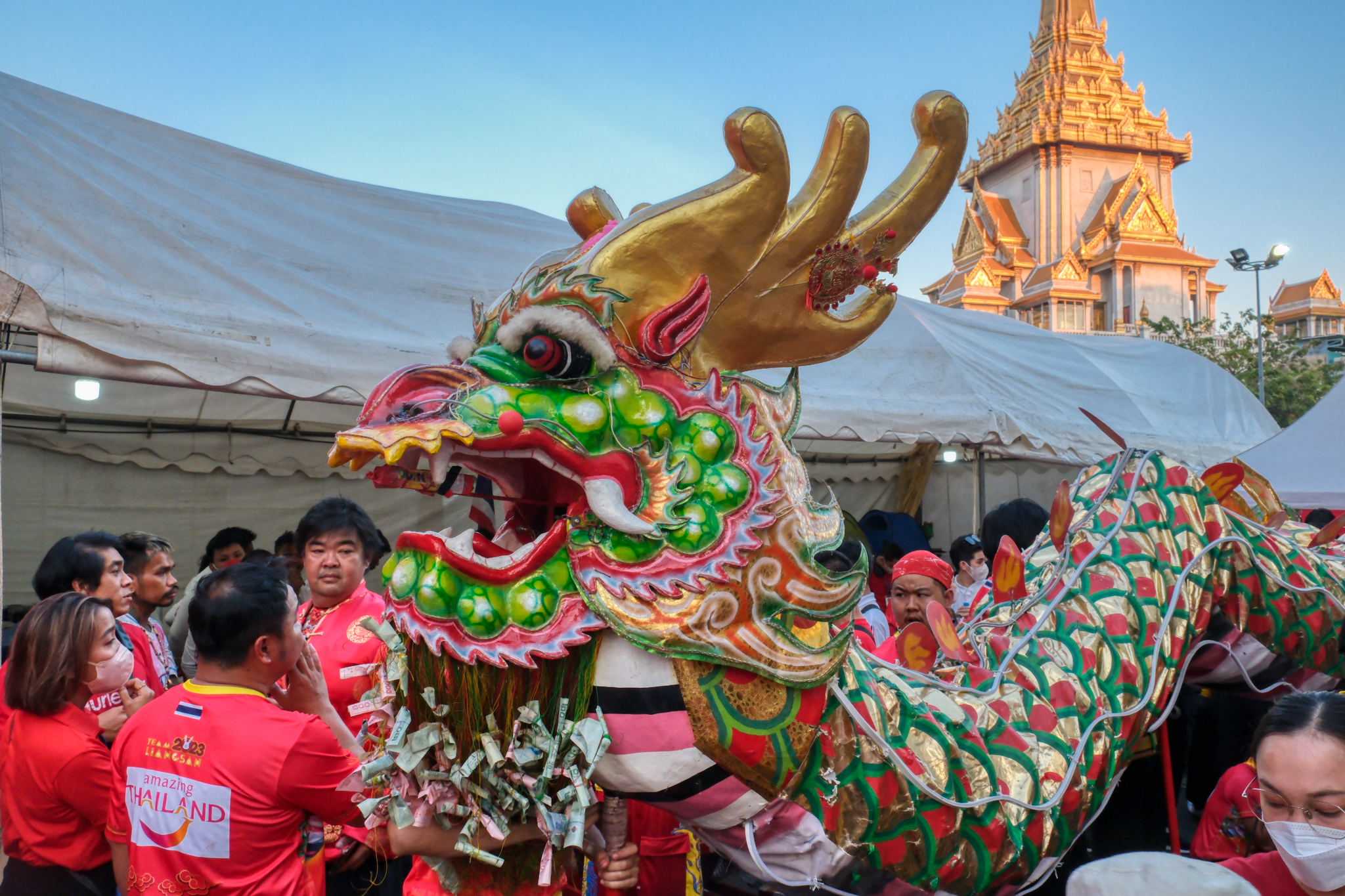
The dragon head . . . staged and ready.
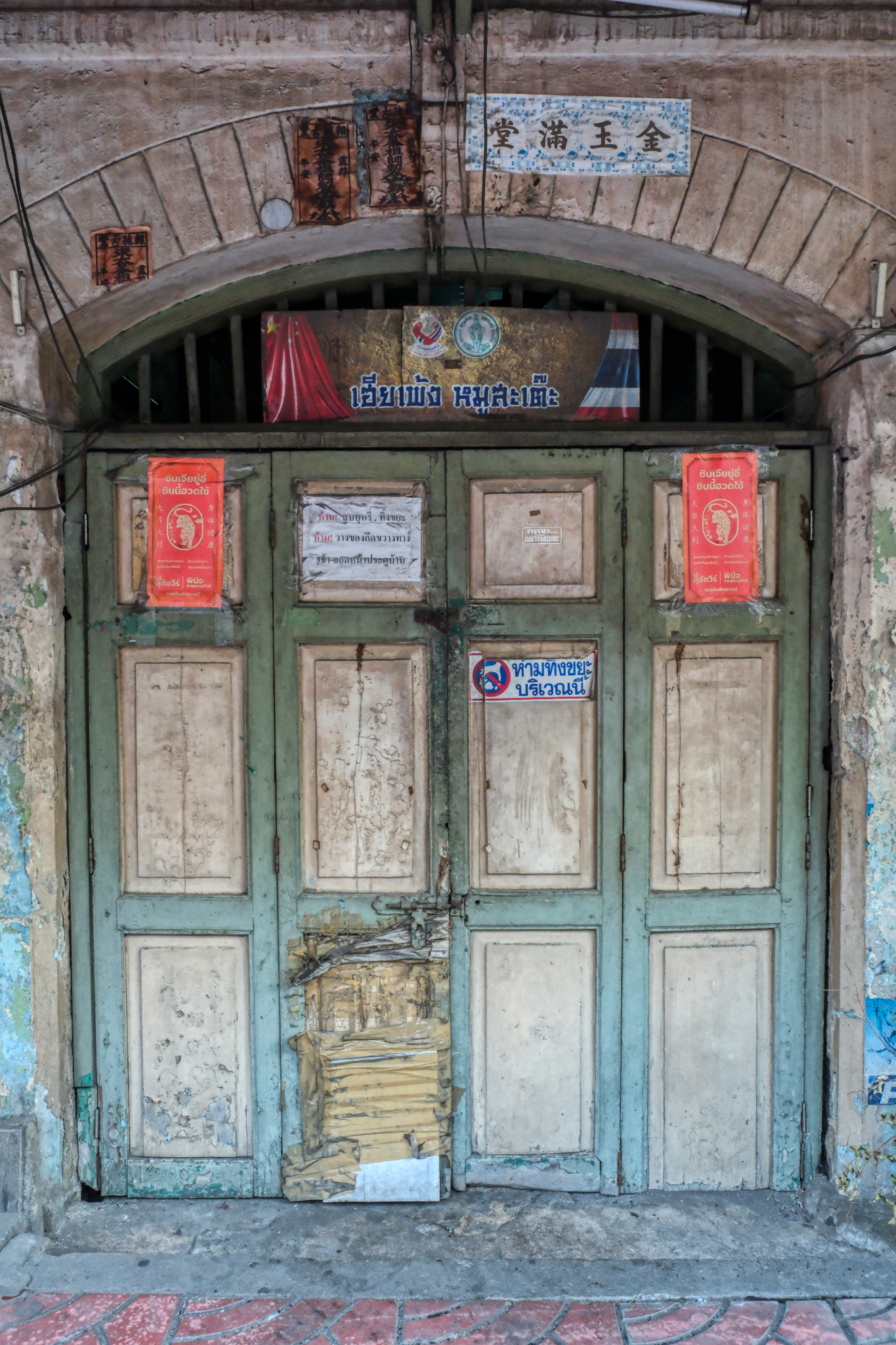 We roamed the side streets looking for interesting images to capture with our cameras. We are never disappointed in Bangkok Chinatown for photogenic scenes.
We roamed the side streets looking for interesting images to capture with our cameras. We are never disappointed in Bangkok Chinatown for photogenic scenes.
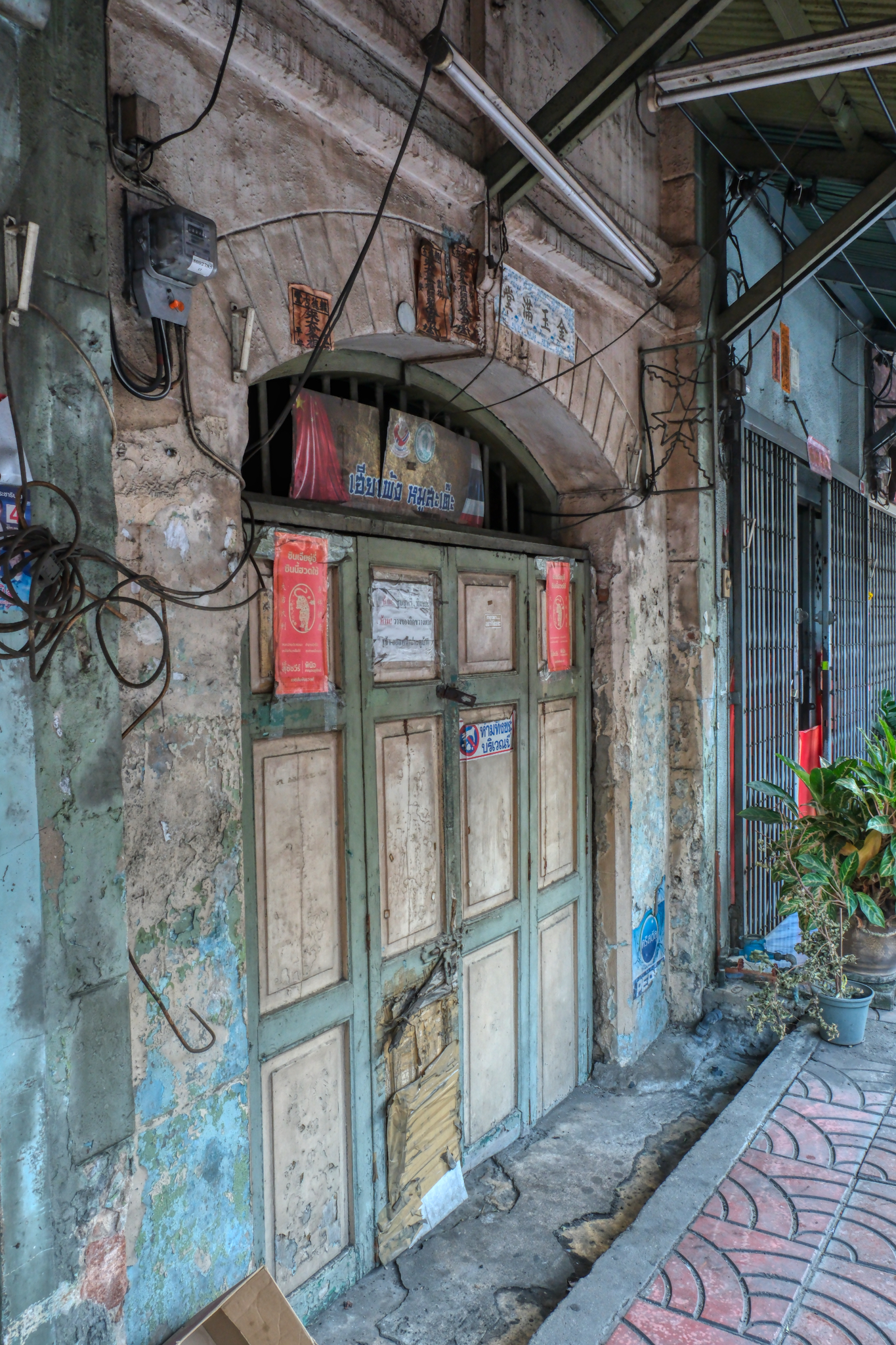 A beautiful Chinatown scene . . .
A beautiful Chinatown scene . . .
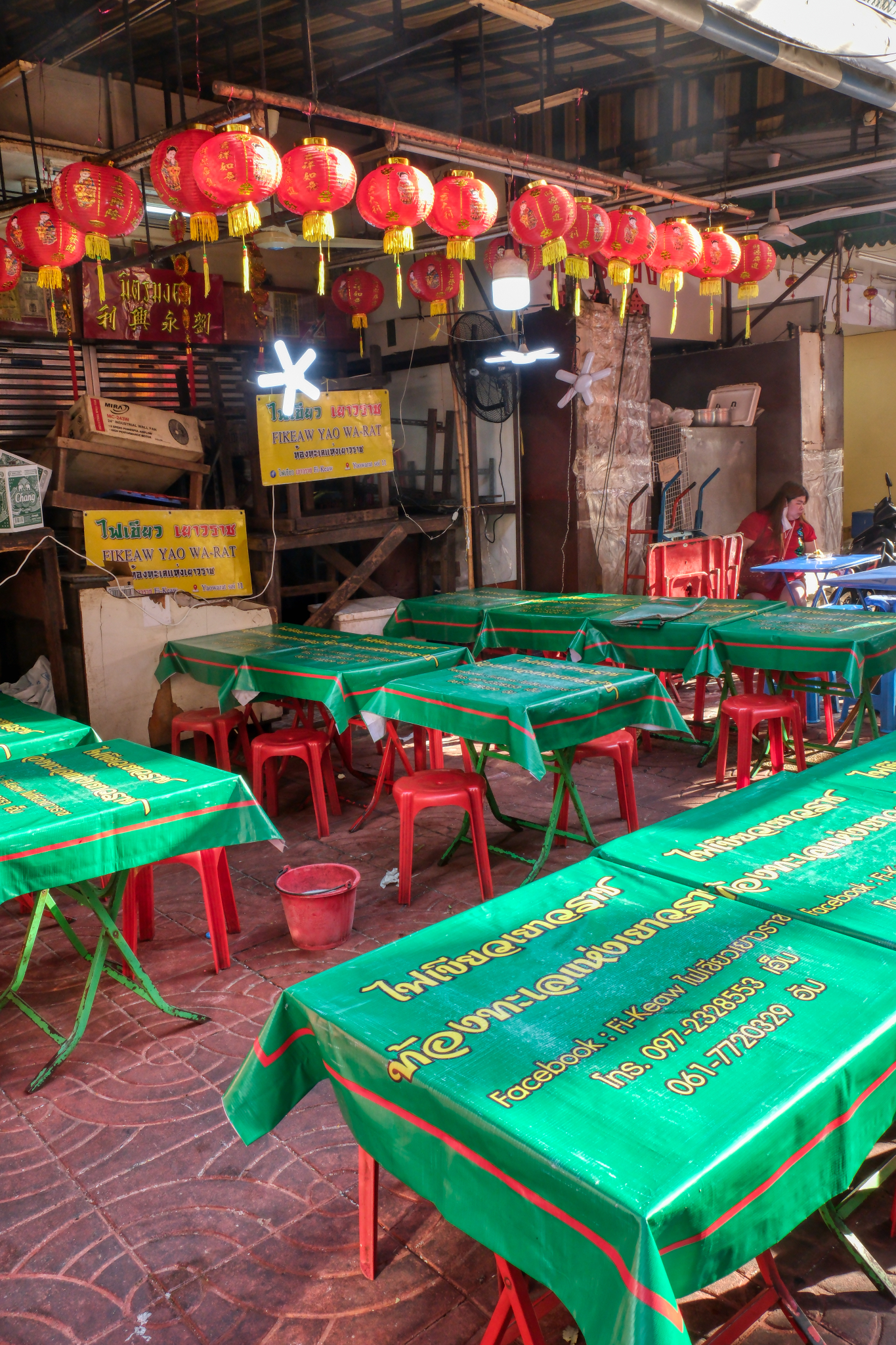 These small side street restaurants would become full after the street celebrations later in the evening.
These small side street restaurants would become full after the street celebrations later in the evening.
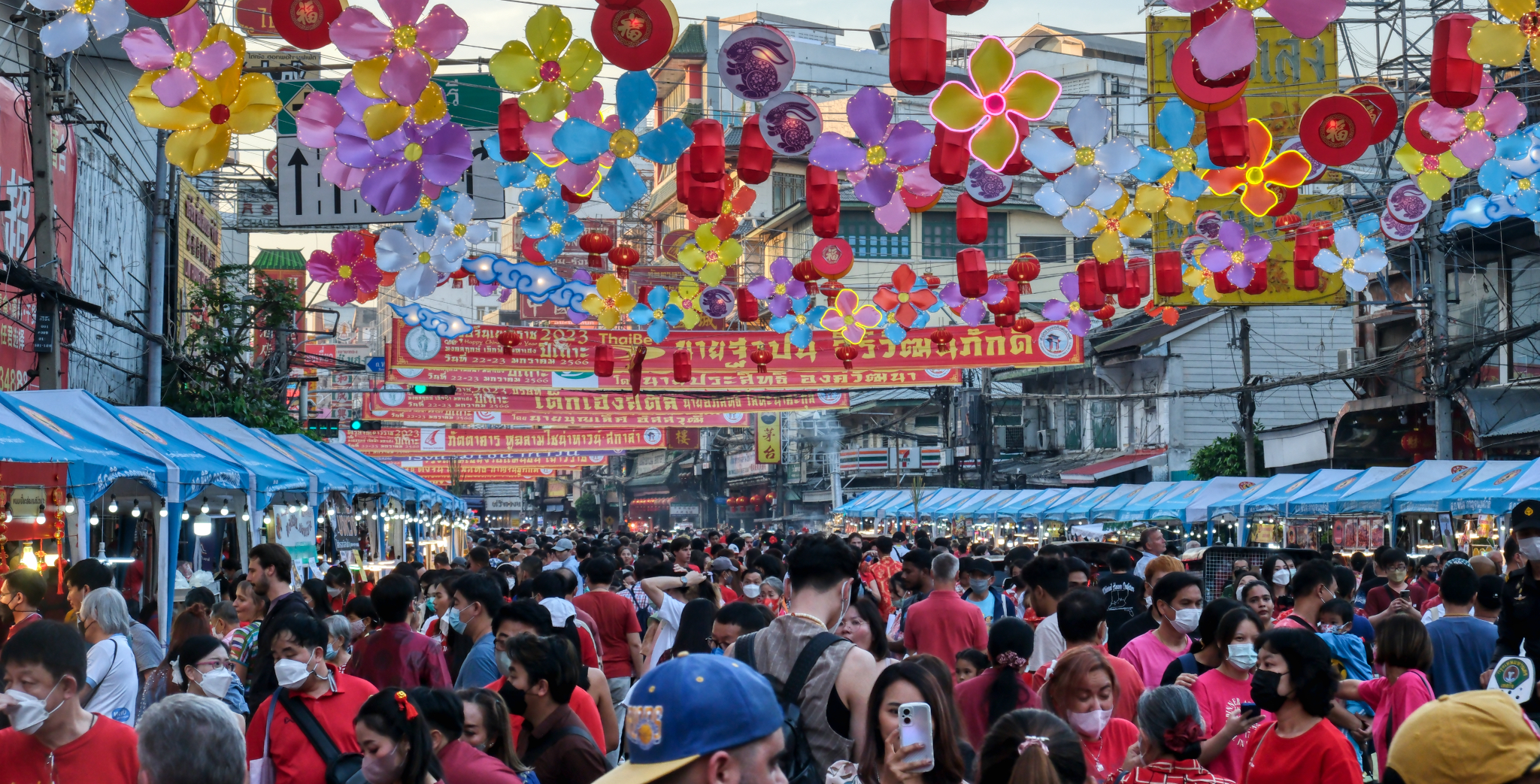 The crows were becoming a crush on the main avenue . . .
The crows were becoming a crush on the main avenue . . .
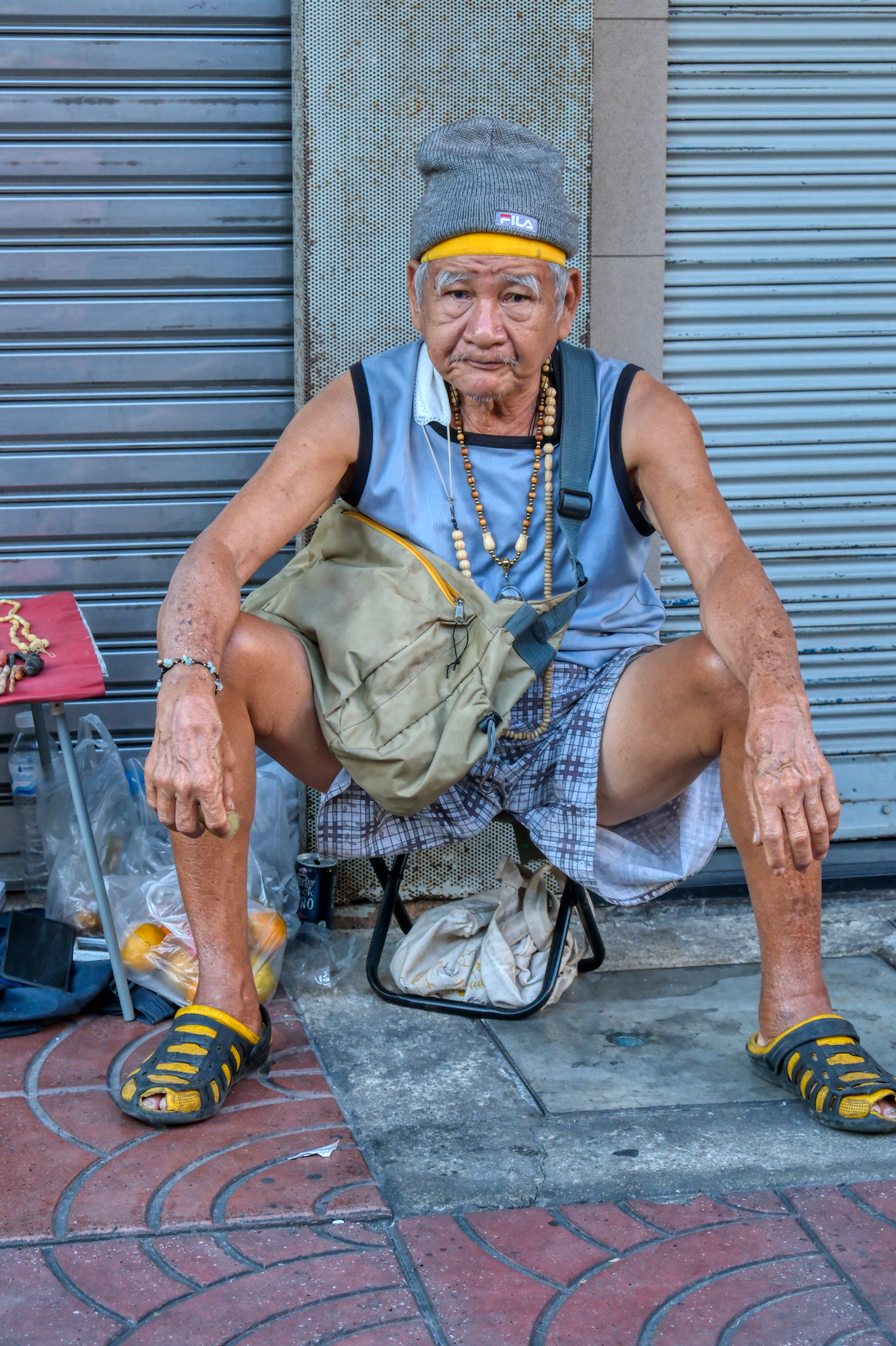 The anticipation was just killing him!!!!
The anticipation was just killing him!!!!
---------------------------------------------------------------------------
Night Arrives!
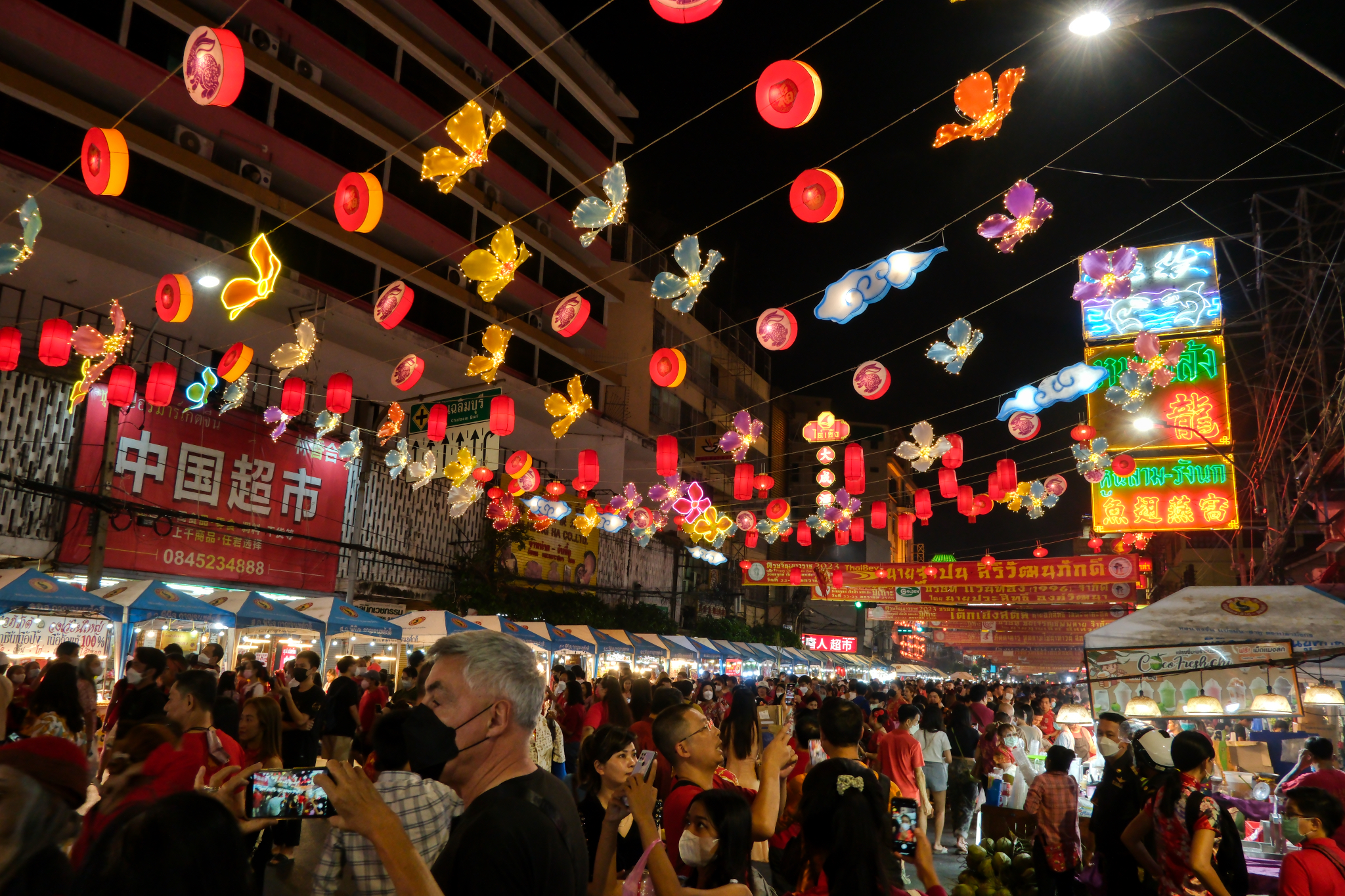 Night arrived at last . . . and we wriggled our way through this crowd to an area behind the stage where the performers were getting ready for the show.
Night arrived at last . . . and we wriggled our way through this crowd to an area behind the stage where the performers were getting ready for the show.
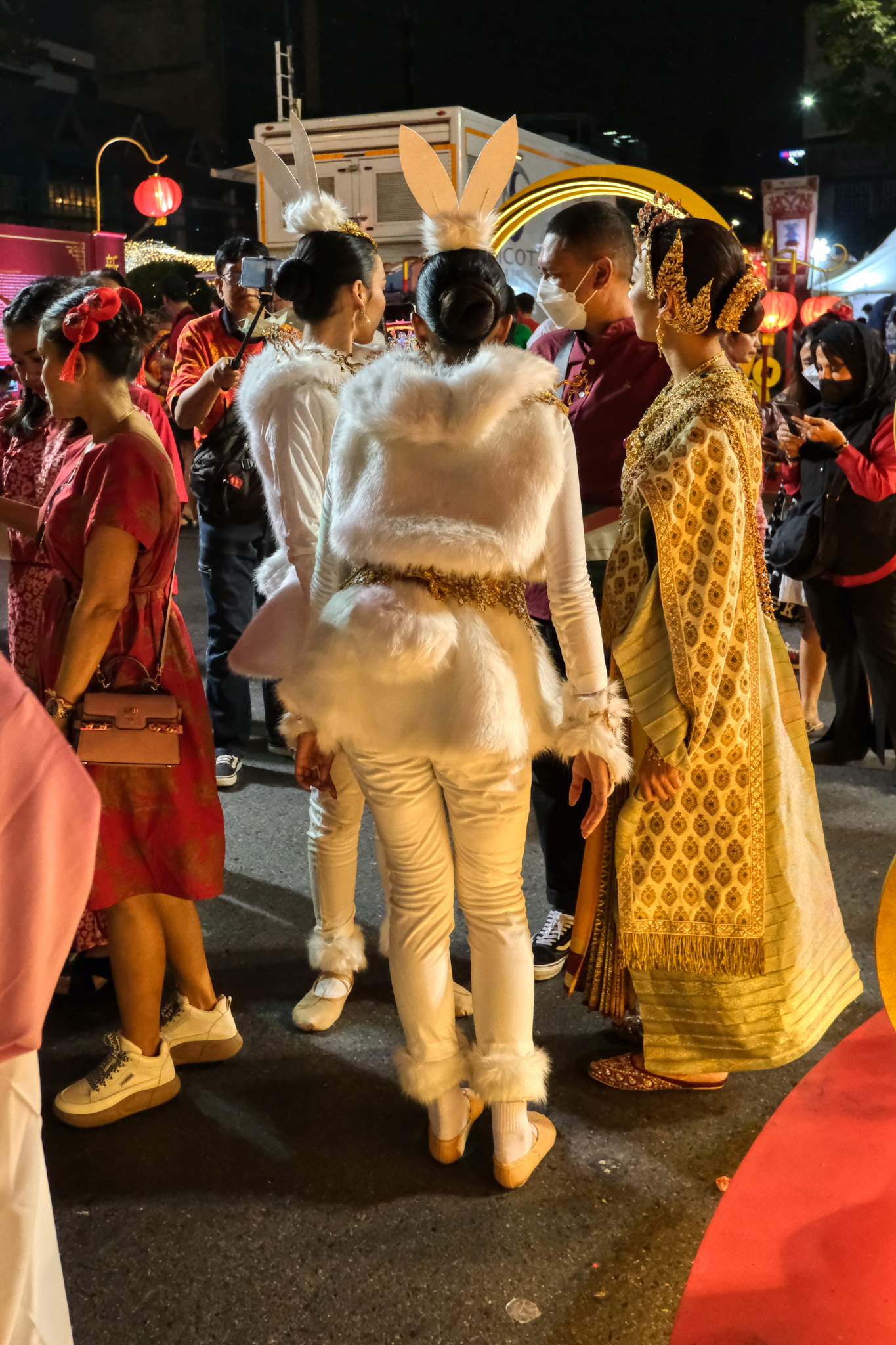 Fantastic costumes everywhere back stage. . . .
Fantastic costumes everywhere back stage. . . .
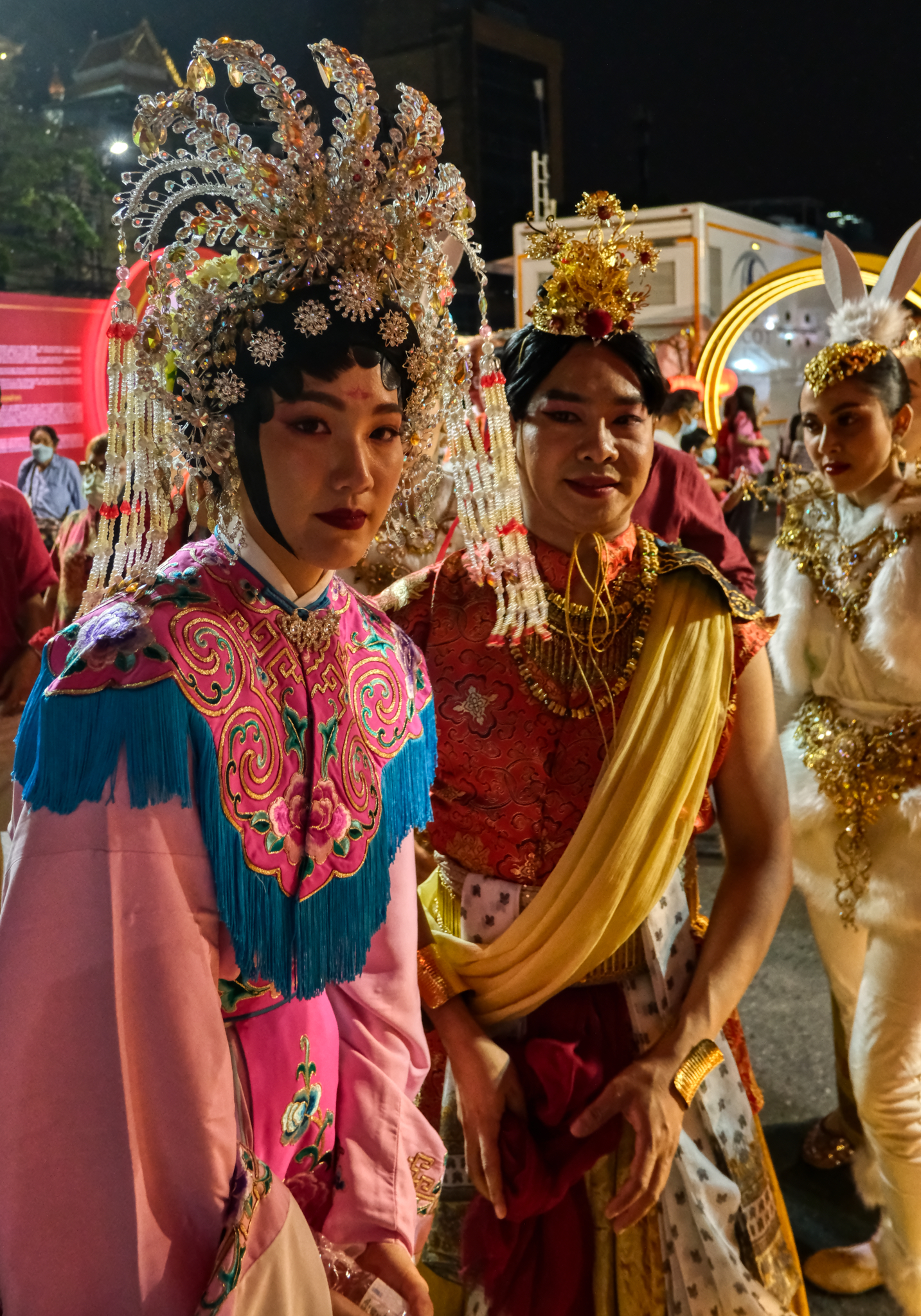 A photographer's dream!
A photographer's dream!
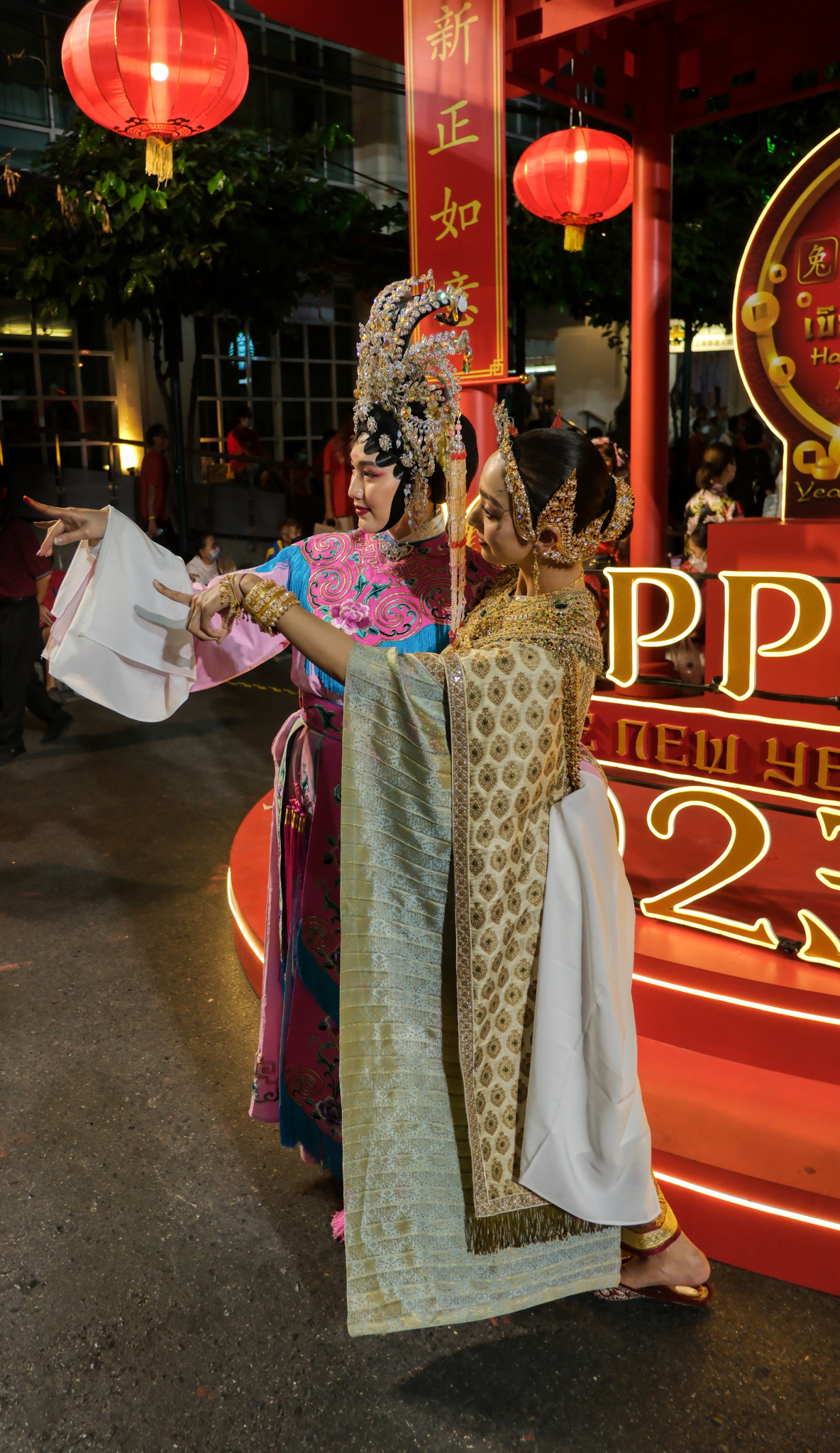 A wonderful array of traditional costumes.
A wonderful array of traditional costumes.
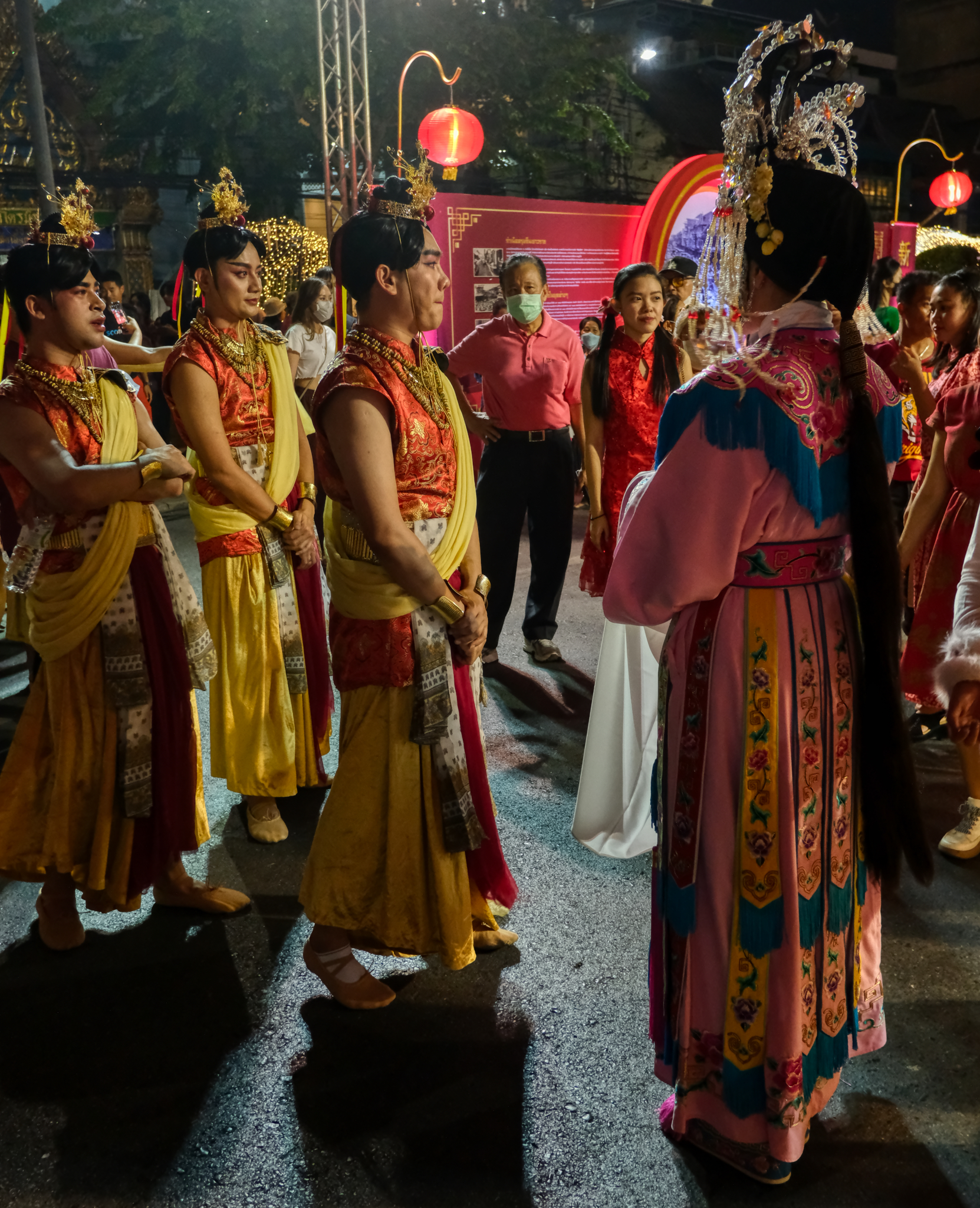 The backstage area almost warranted its own blog entry.
The backstage area almost warranted its own blog entry.
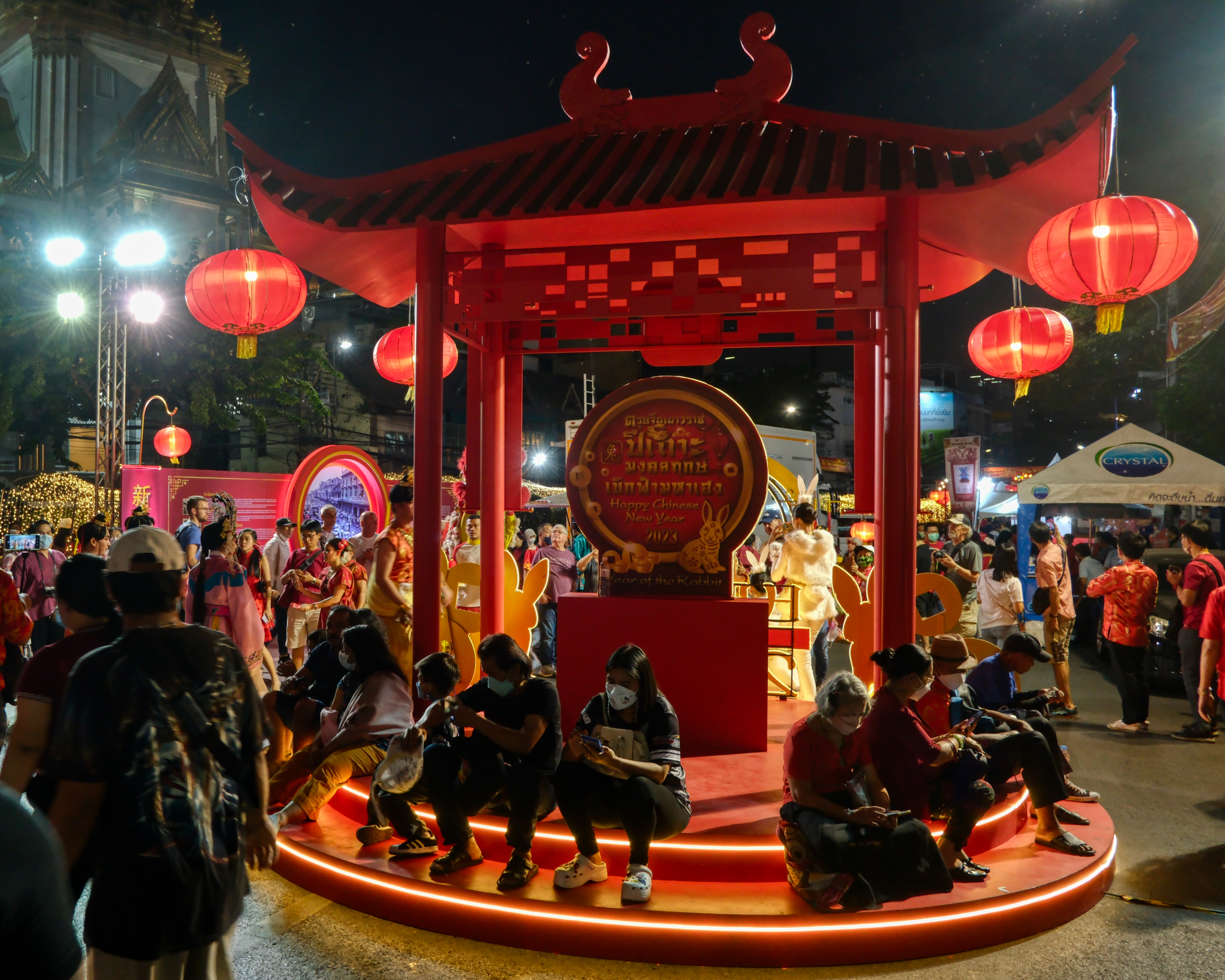 New Years' revellers taking a load off their tired feet . . . and checking their phones for vital communication.
New Years' revellers taking a load off their tired feet . . . and checking their phones for vital communication.
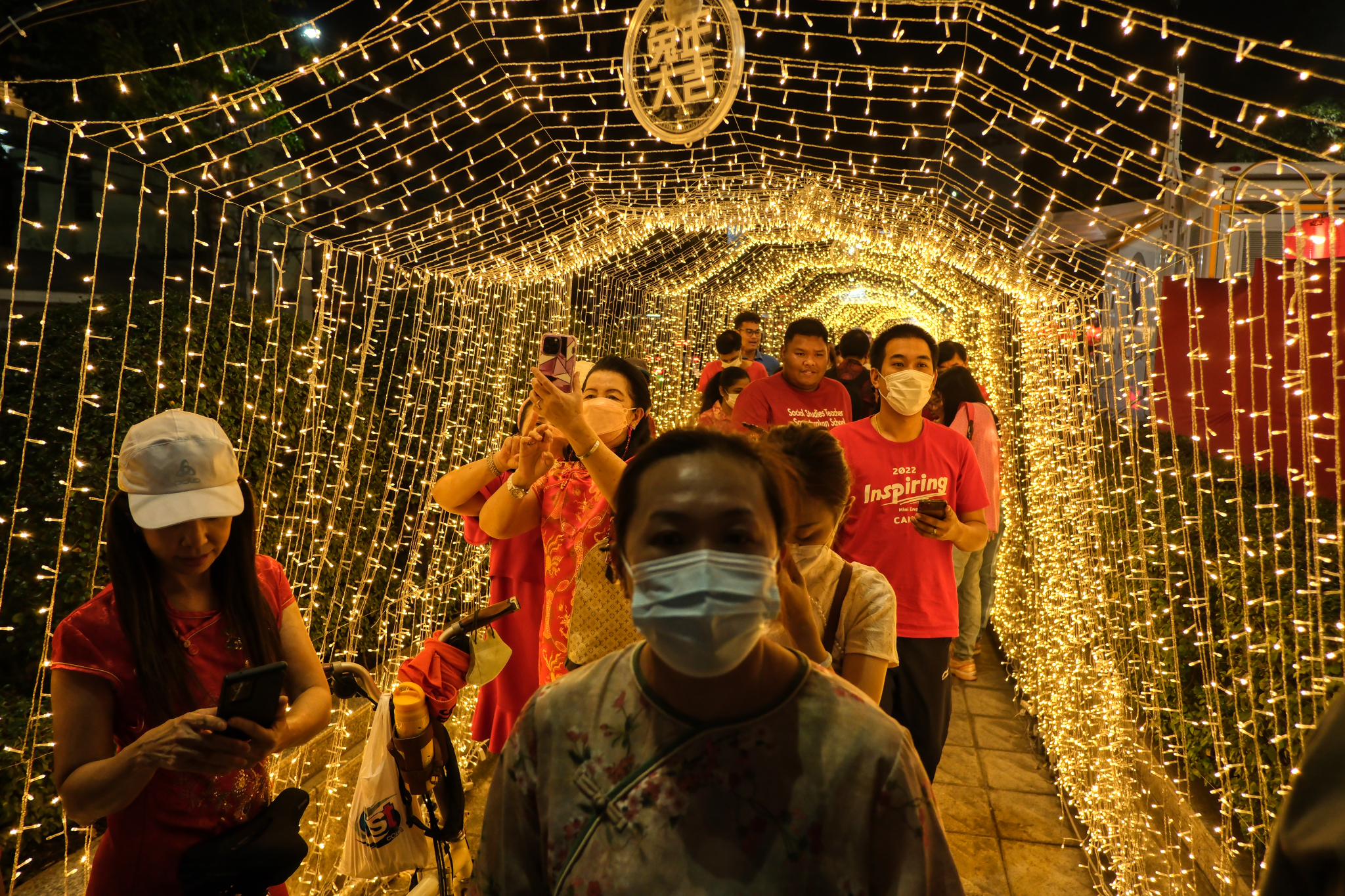 The backstage entrance light tunnel was popular.
The backstage entrance light tunnel was popular.
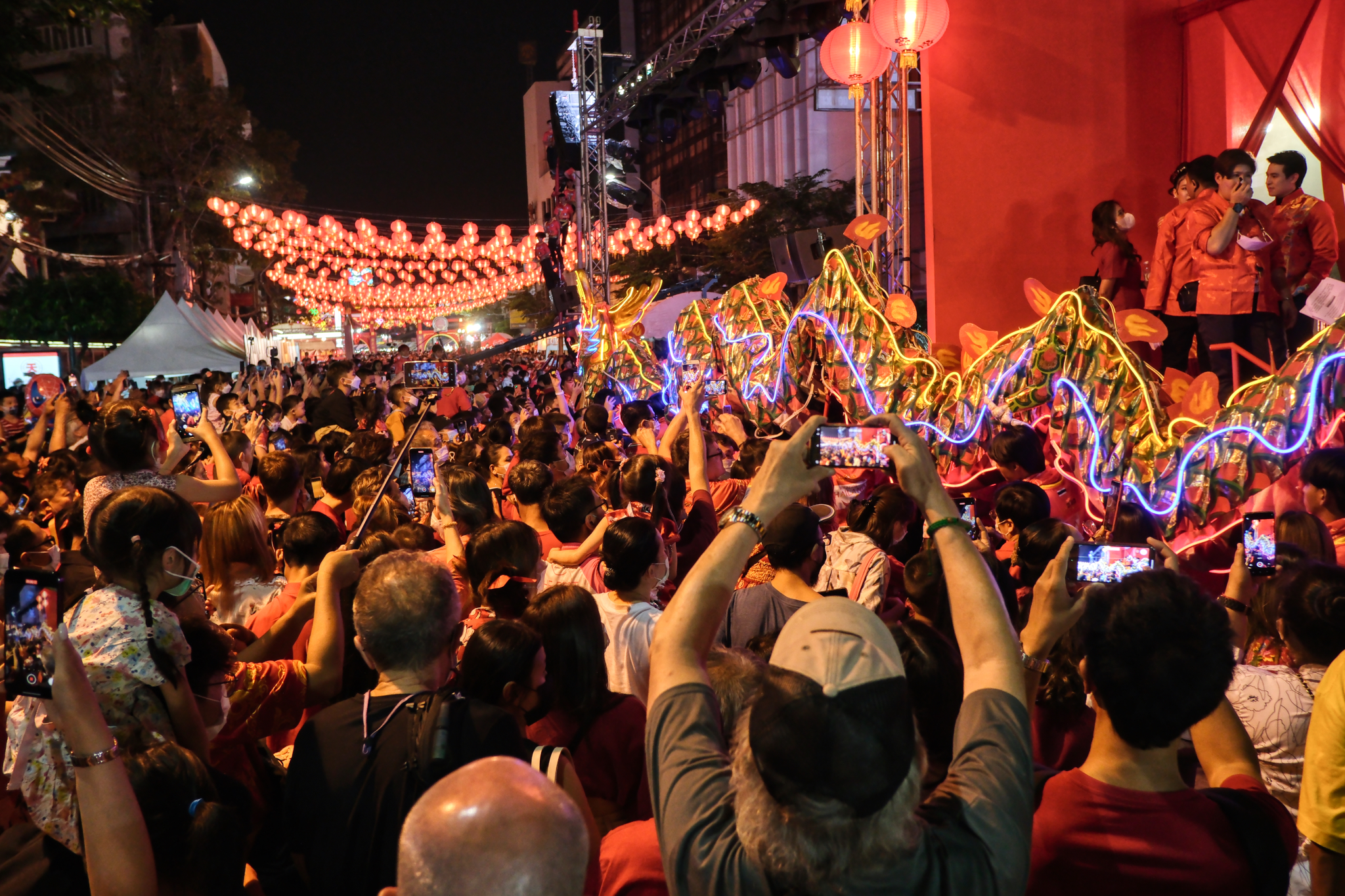 There was no way to get close to the Dragon when it made its way out into the crowd . . . too many iPhone photographers!!!
There was no way to get close to the Dragon when it made its way out into the crowd . . . too many iPhone photographers!!!
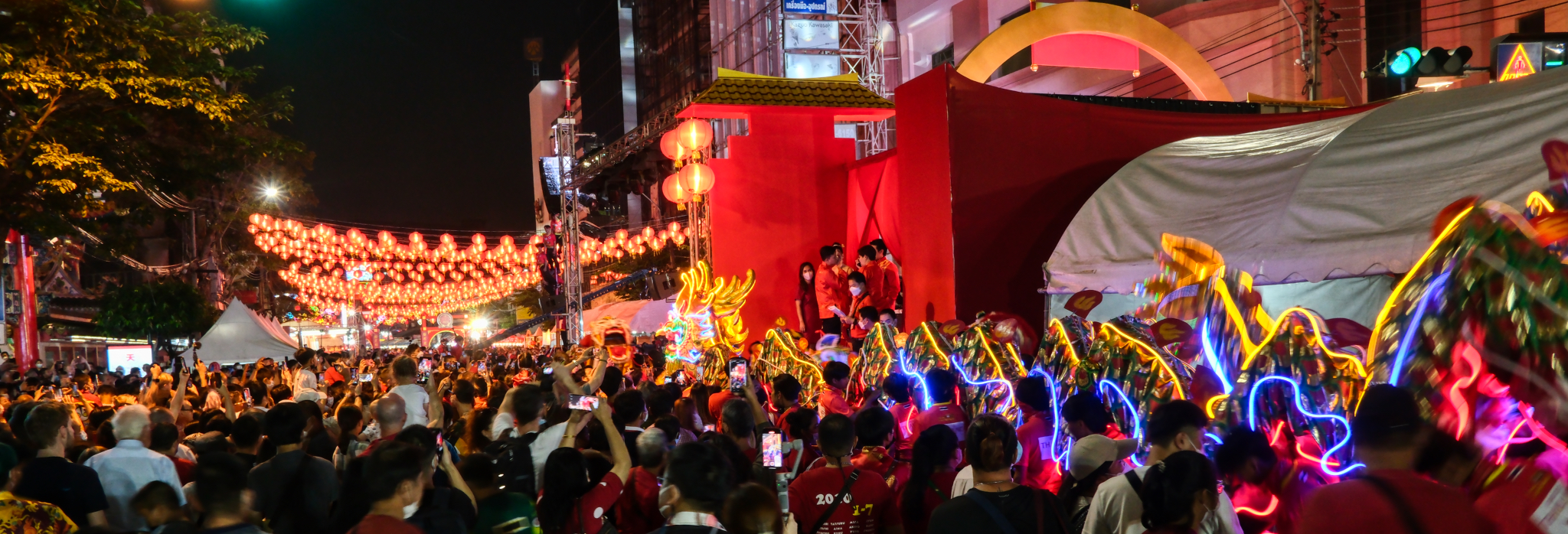 I did manage this shot of the departing Dragon by holding my camera over my head. Amazing.
I did manage this shot of the departing Dragon by holding my camera over my head. Amazing.
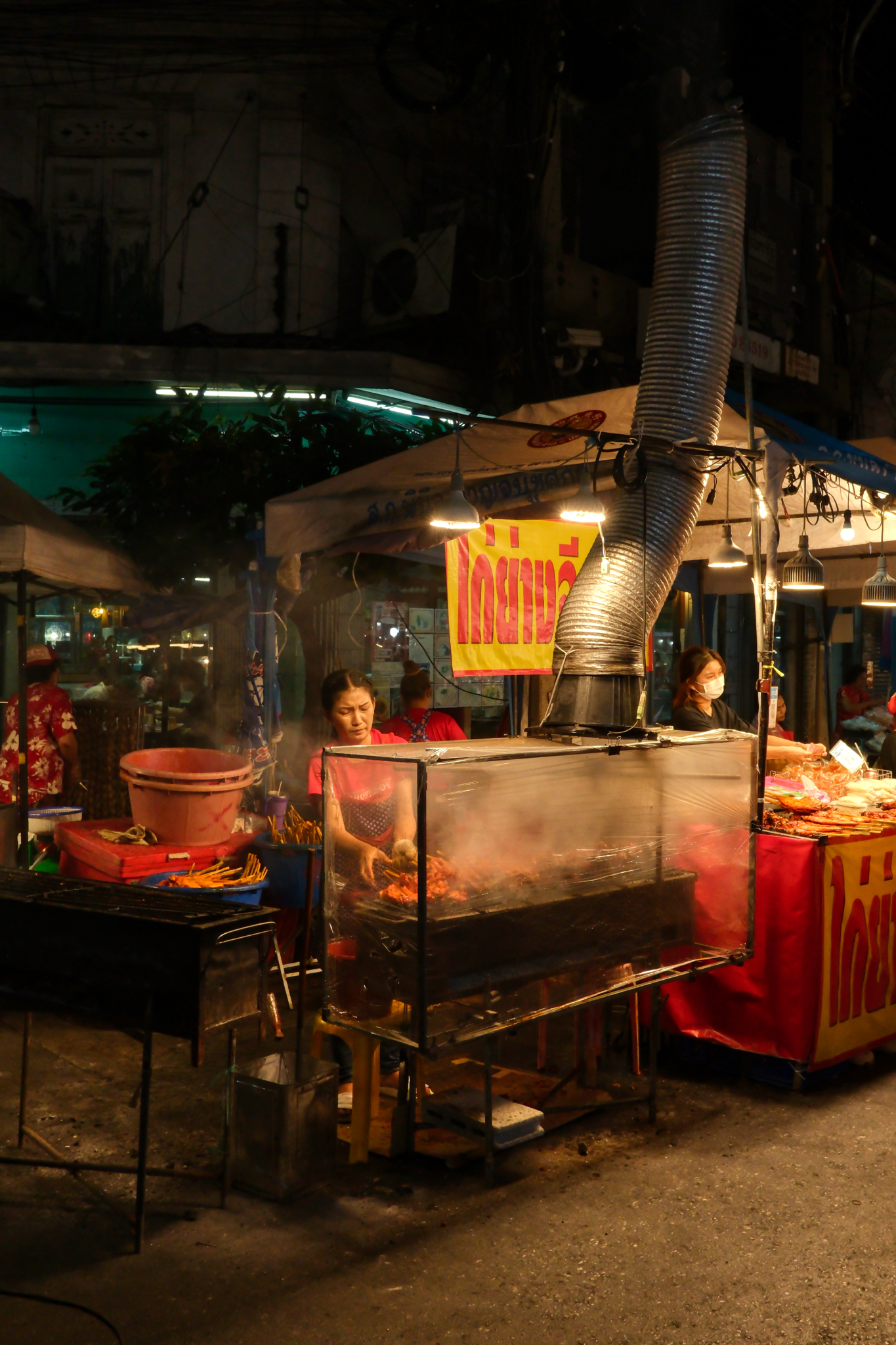 After the dragon departed we decided it was time to beat the crowds back to the underground station, and headed out . . . but still with camera in hand for the fantastic night images.
After the dragon departed we decided it was time to beat the crowds back to the underground station, and headed out . . . but still with camera in hand for the fantastic night images.
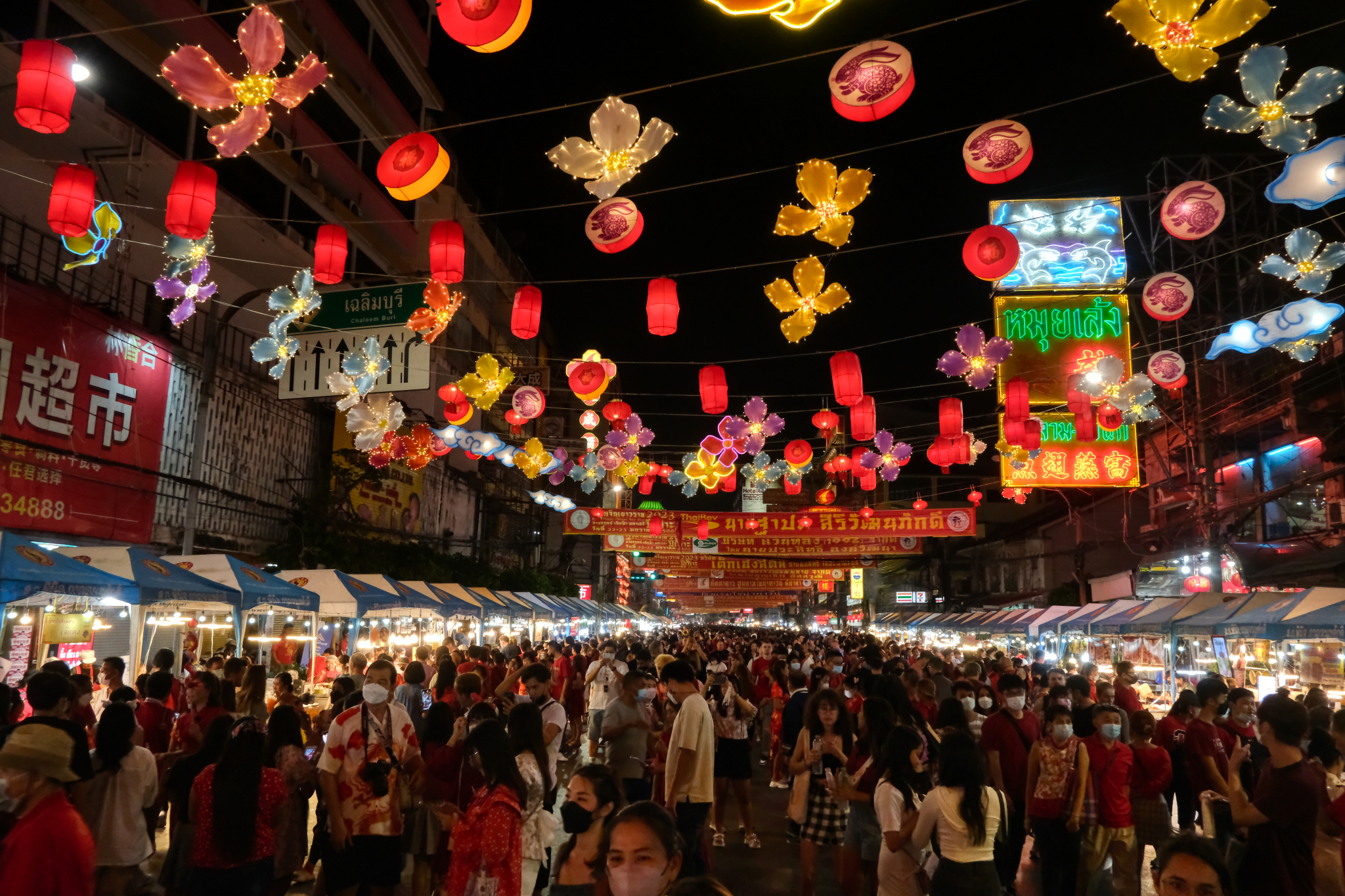 Yes, we "fought" our way back through this crowd . . . but people were good and generous with our passage.
Yes, we "fought" our way back through this crowd . . . but people were good and generous with our passage.
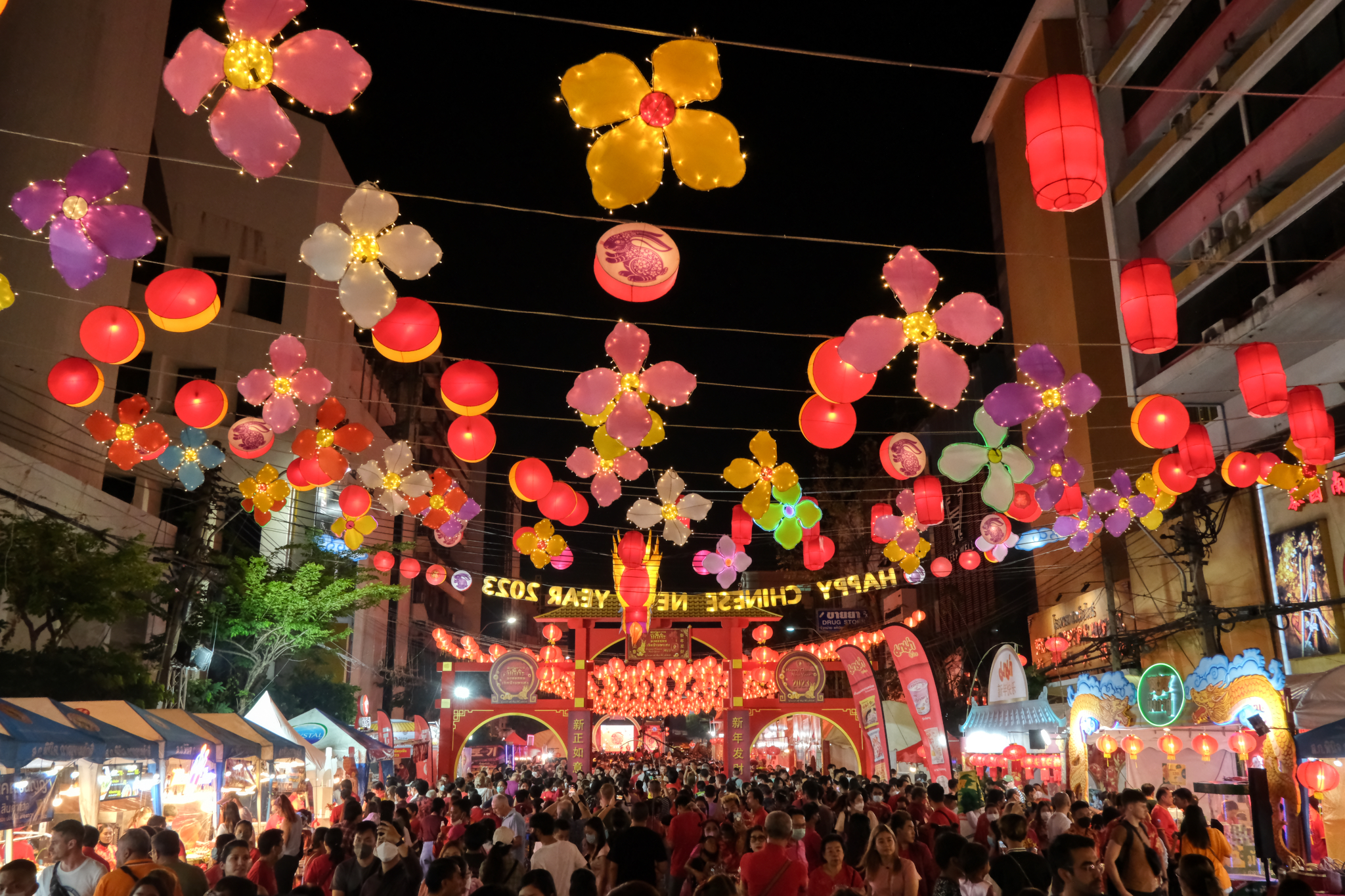 A beautiful array of lighting above . . .
A beautiful array of lighting above . . .
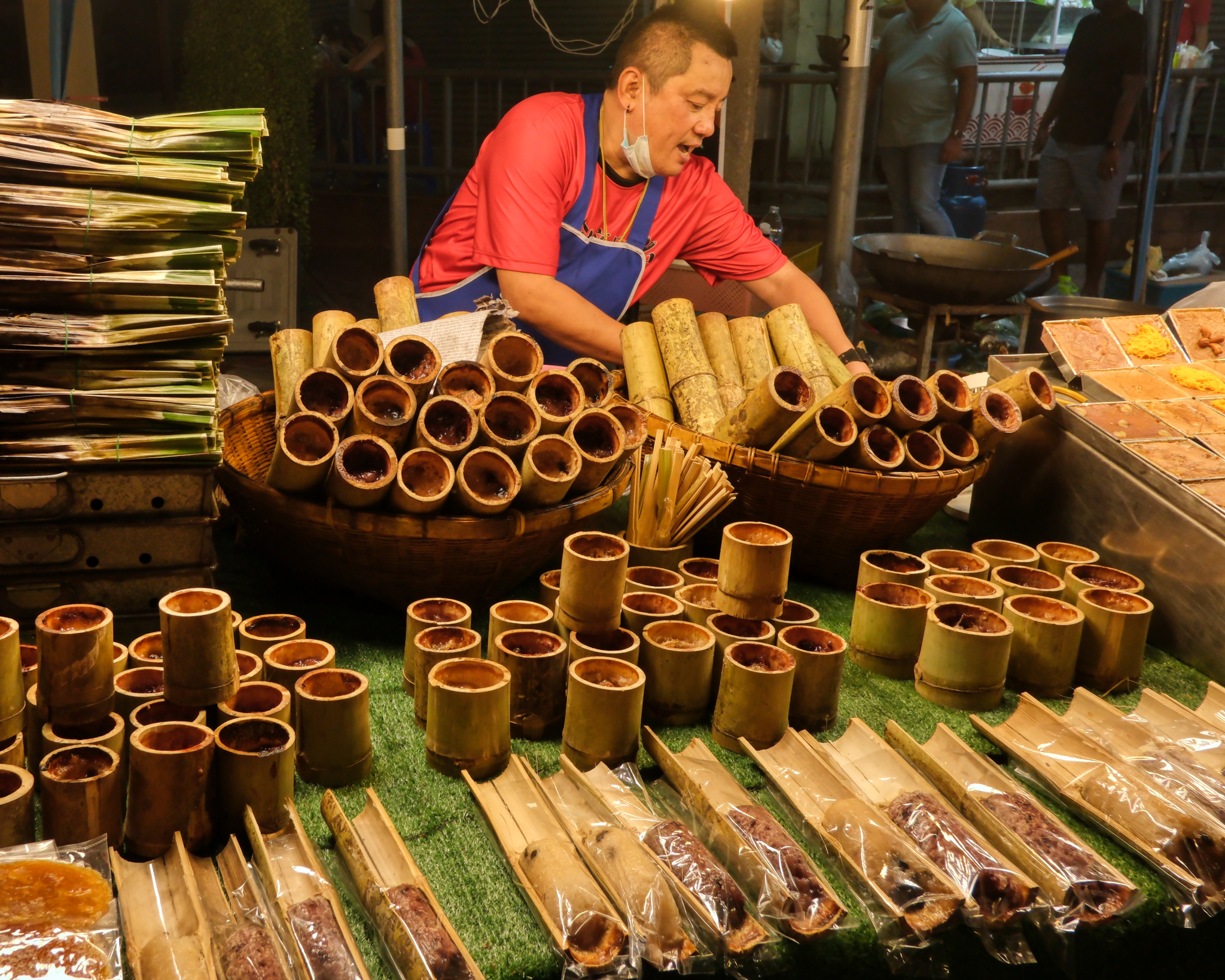 The street food vendors were doing a brisk business after dark. Here rice-cooked-in-bamboo . . . delicious!
The street food vendors were doing a brisk business after dark. Here rice-cooked-in-bamboo . . . delicious!
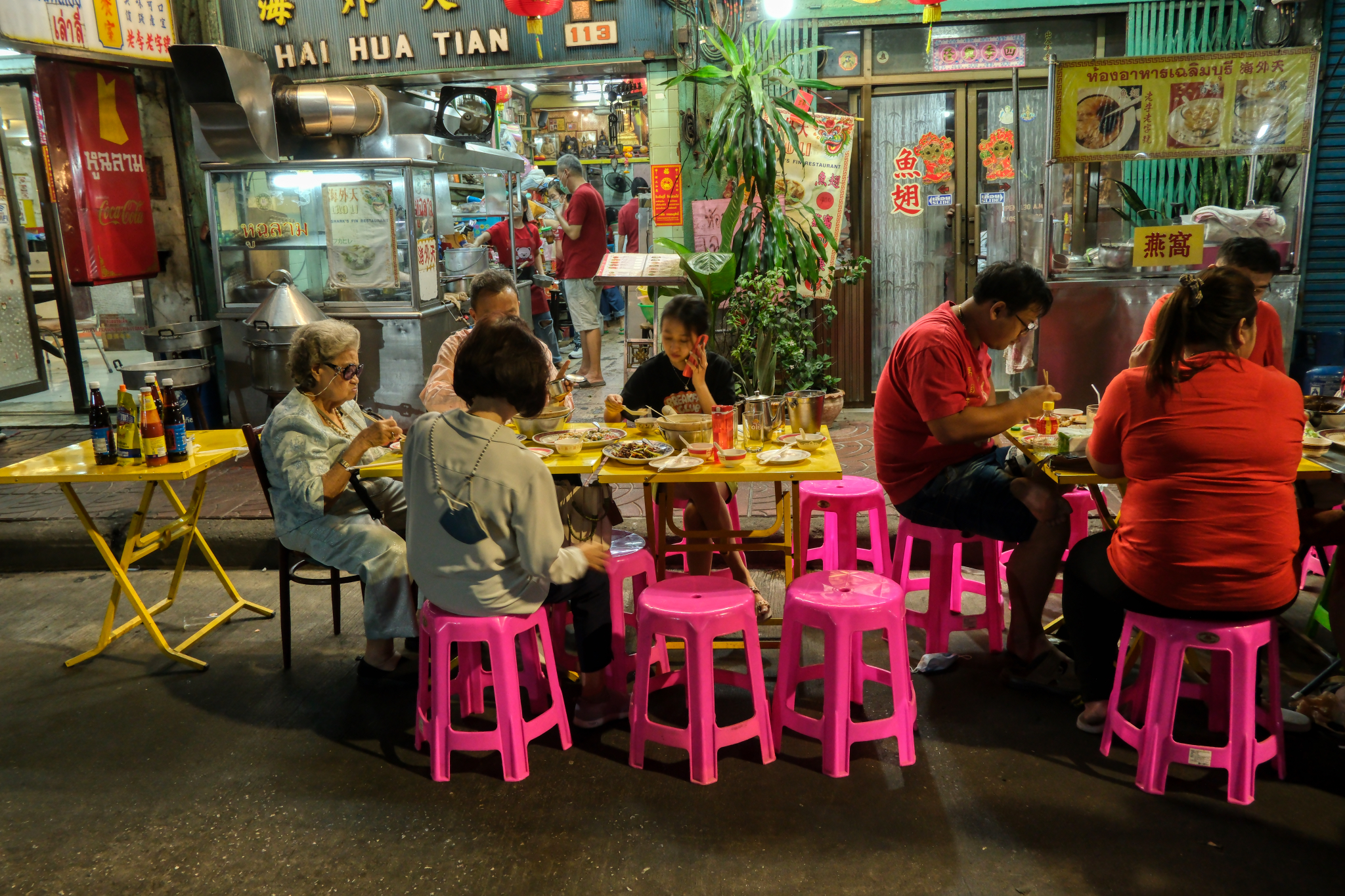 People were out for a nice meal on the Chinatown streets tonight.
People were out for a nice meal on the Chinatown streets tonight.
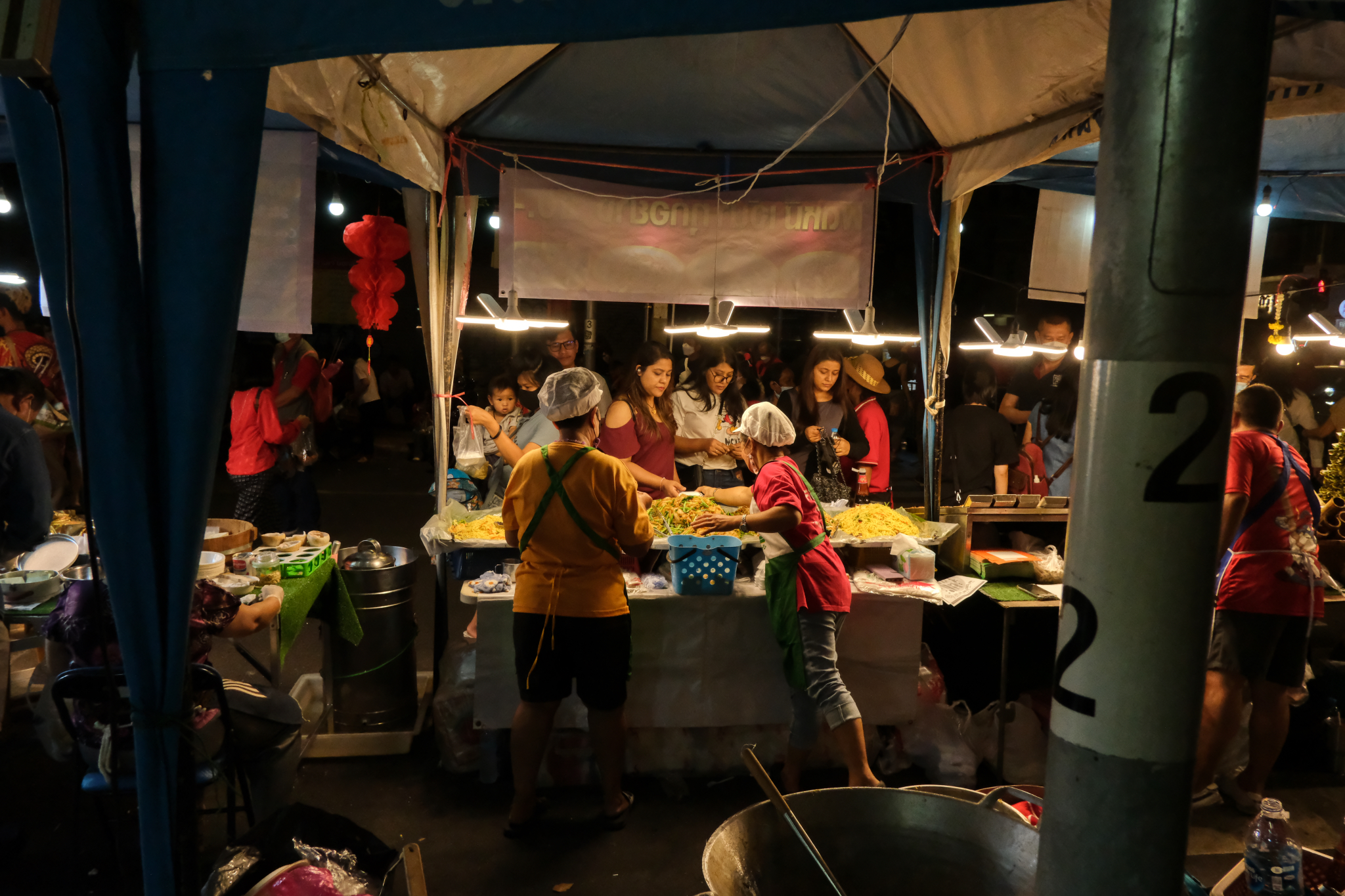 Long lines at this stall . . . it must have been good and tasty.
Long lines at this stall . . . it must have been good and tasty.
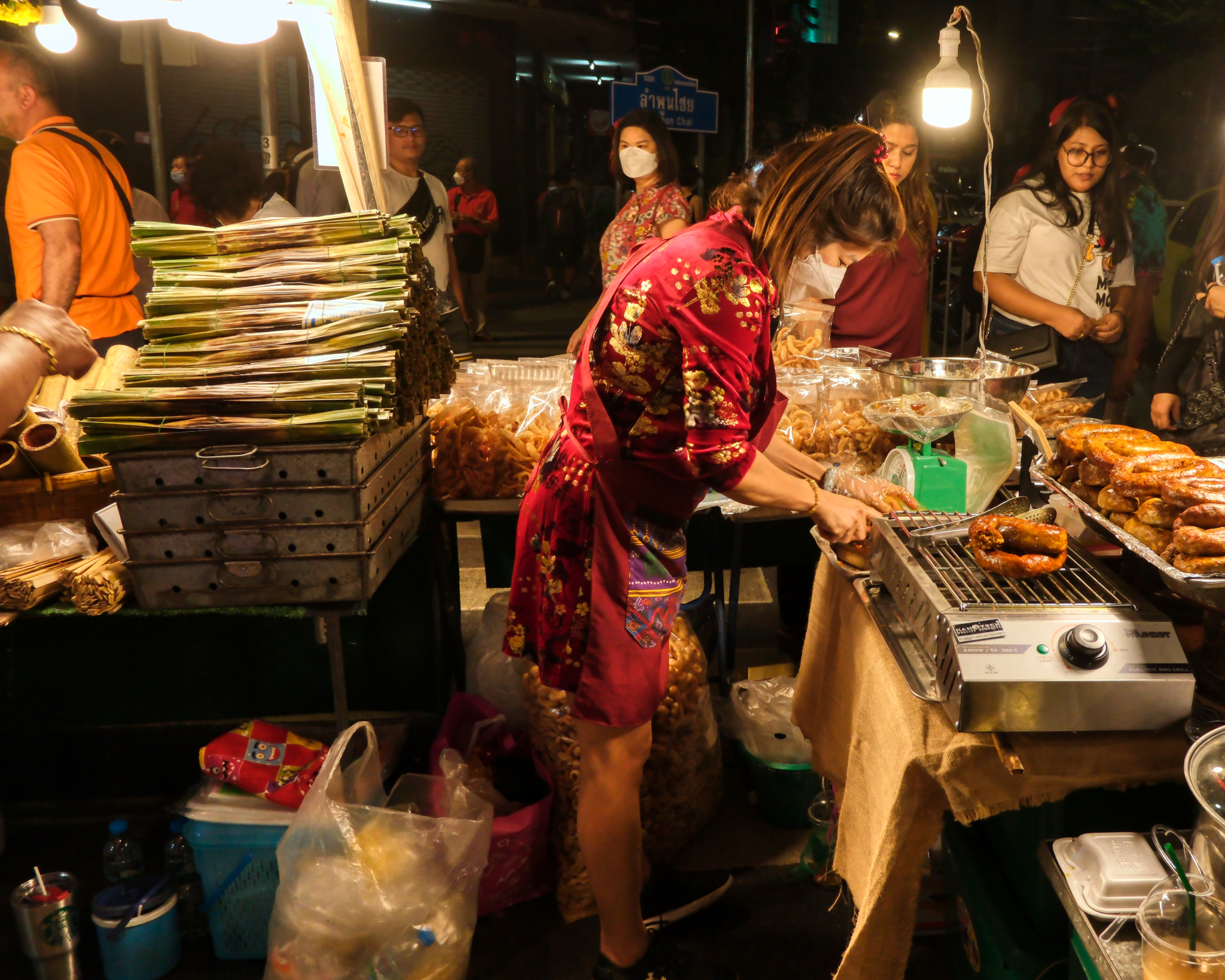 Preparing Northern Thailand spicy sausage . . . yum-yum!
Preparing Northern Thailand spicy sausage . . . yum-yum!
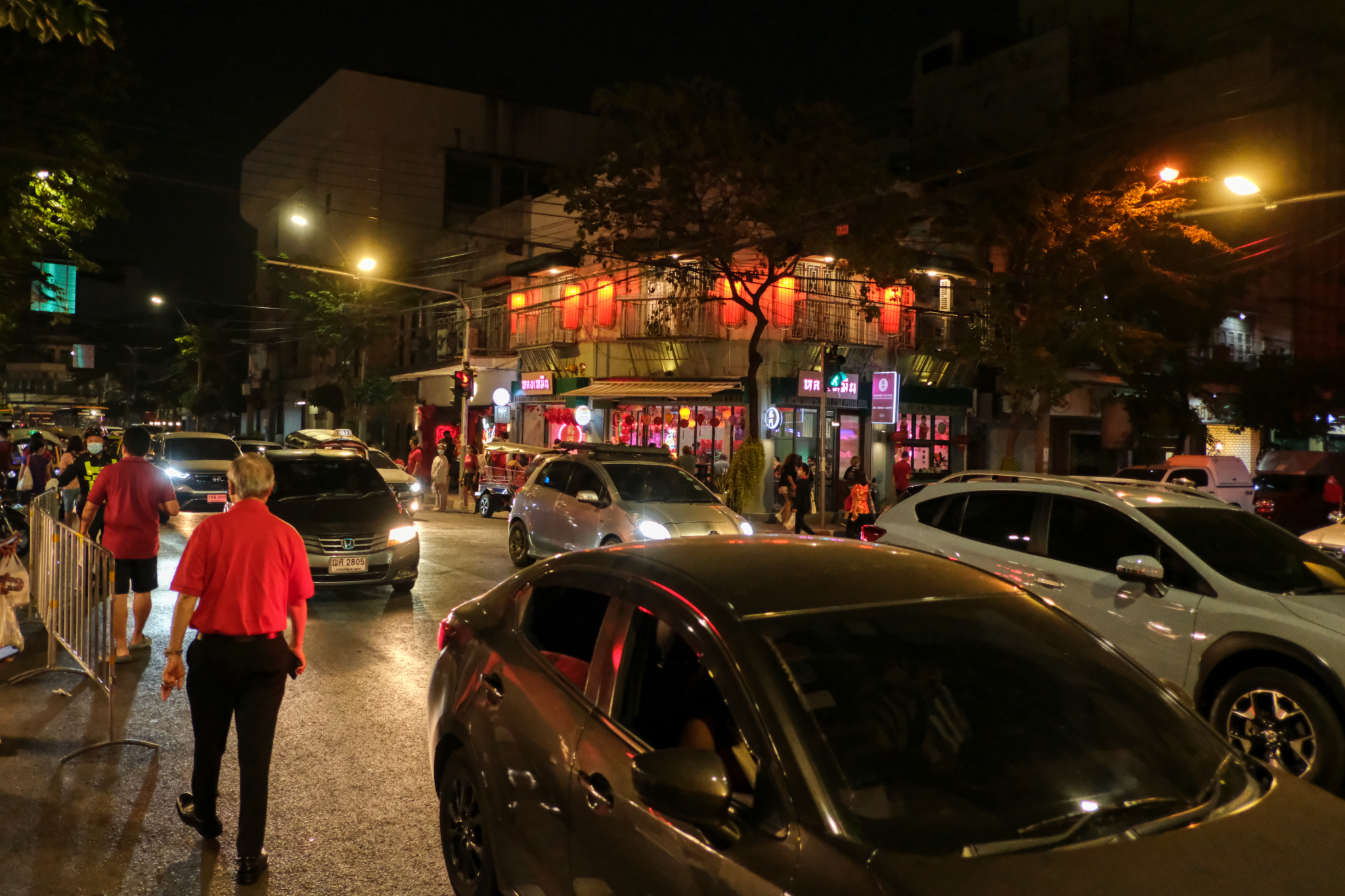 We left the crowded main celebration avenue and walked along a parallel street . . . there was no shortage of photographically interesting things along this route.
We left the crowded main celebration avenue and walked along a parallel street . . . there was no shortage of photographically interesting things along this route.
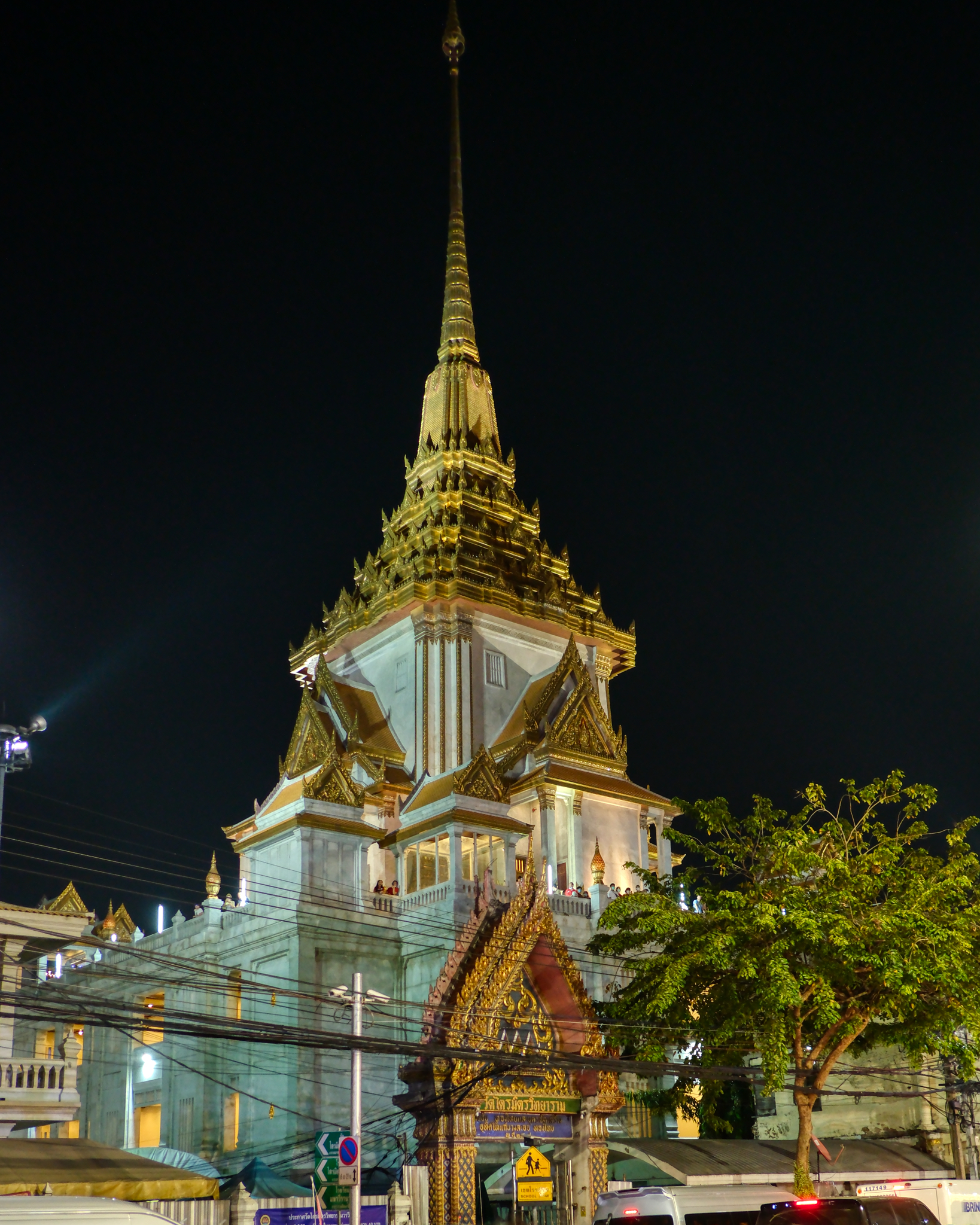 A Thai Buddhist temple (Wat) lit up.
A Thai Buddhist temple (Wat) lit up.
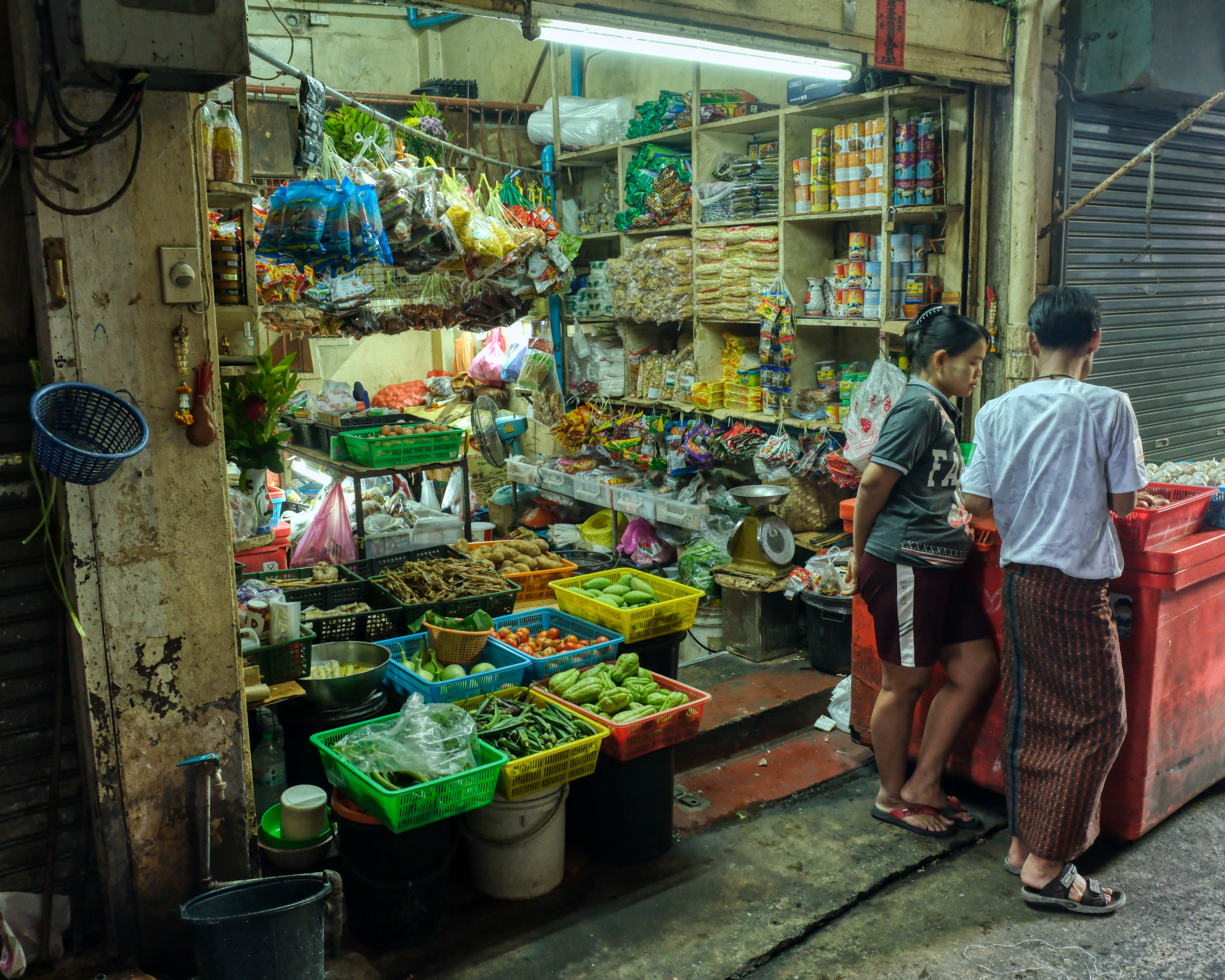 "Why not keep the shop open a little later tonight . . . maybe make some extra sales, what with the big crowds and all."
"Why not keep the shop open a little later tonight . . . maybe make some extra sales, what with the big crowds and all."
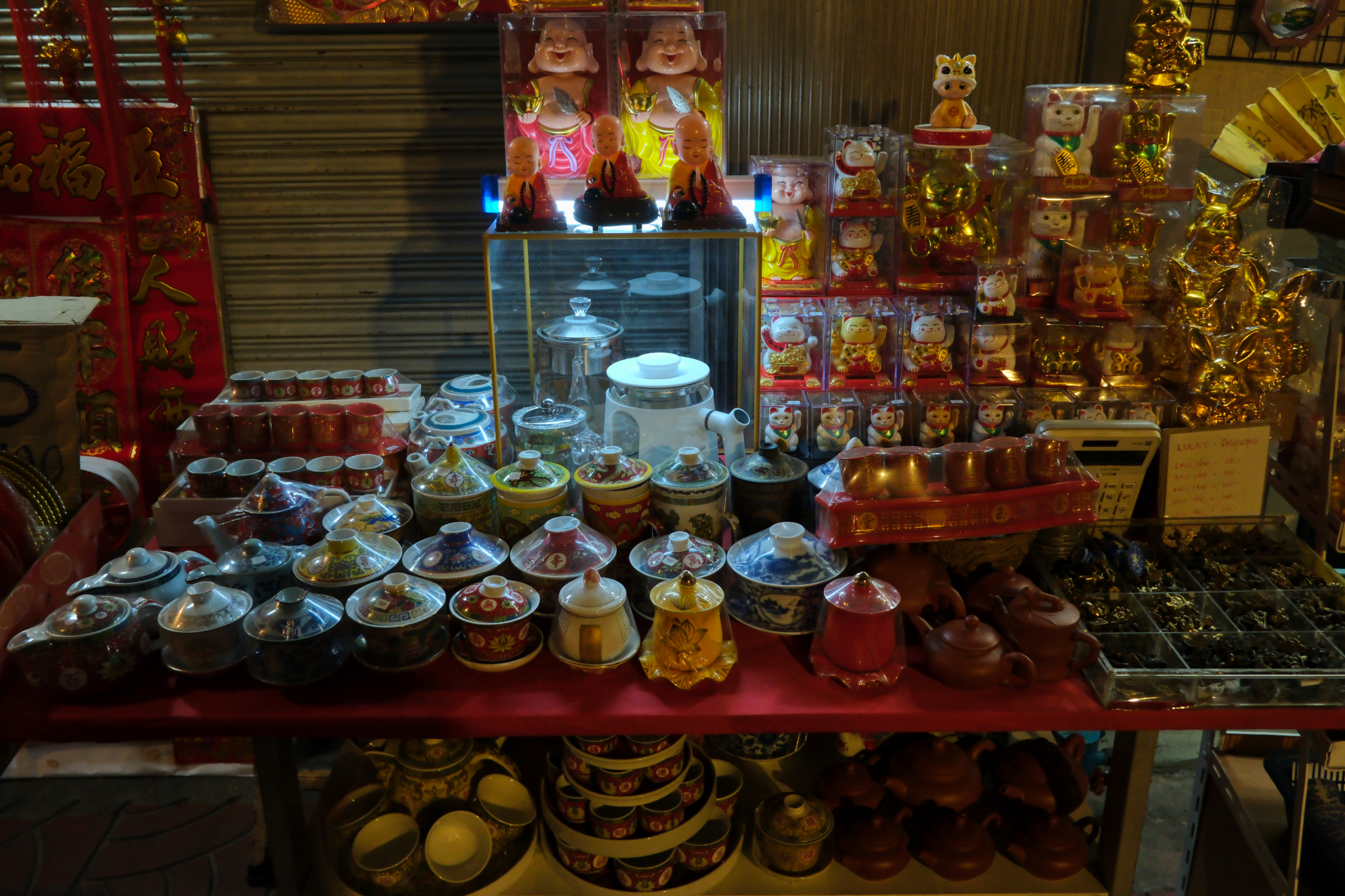 Why not set up a couple of card tables for those treasures you have for sale?
Why not set up a couple of card tables for those treasures you have for sale?
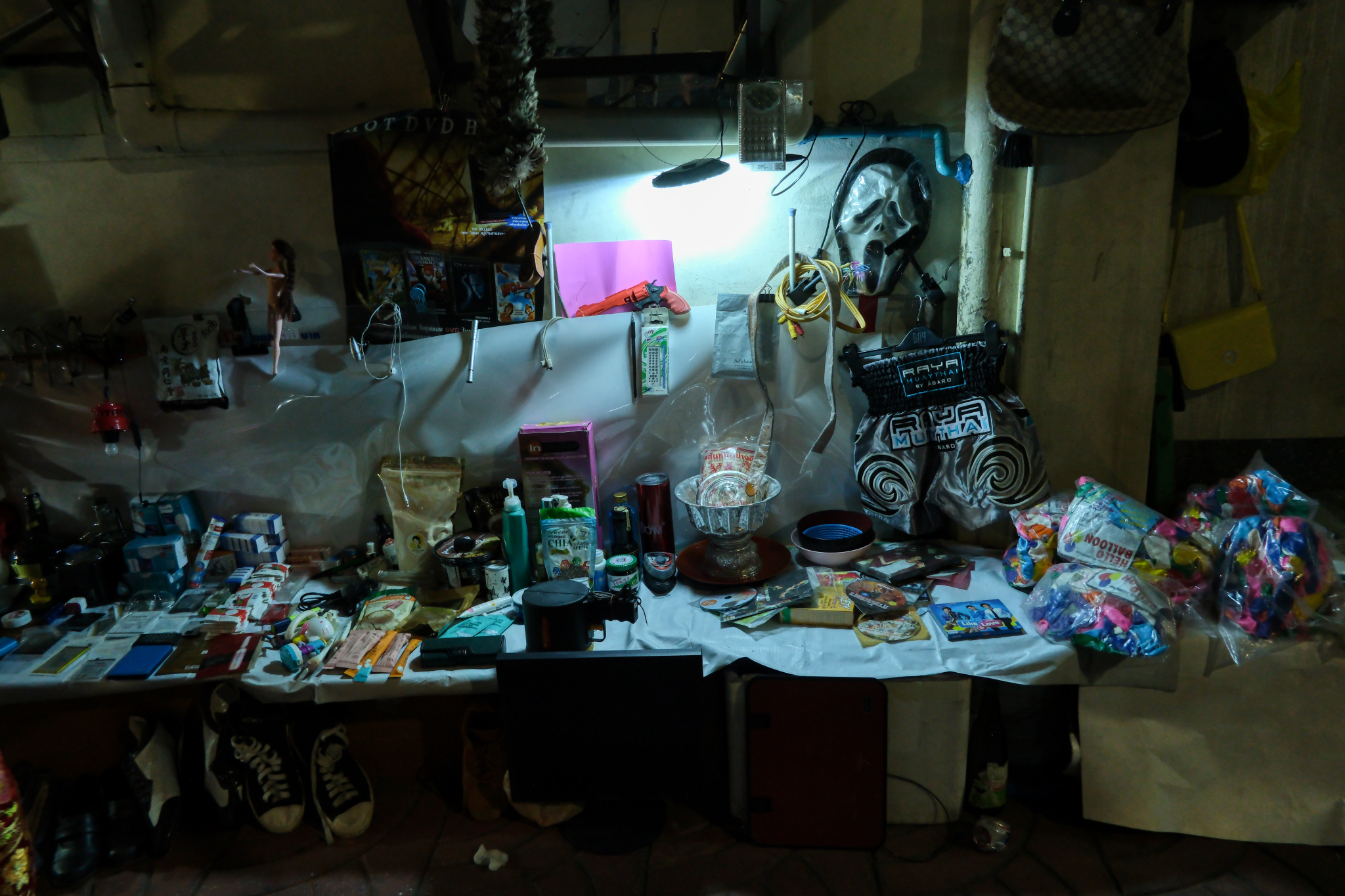 A real jumble sale. This one was very sad to see . . . someone was very poor. I looked for the seller, but could find nobody. I left 100 baht (US$3.oo) on the table as a donation.
A real jumble sale. This one was very sad to see . . . someone was very poor. I looked for the seller, but could find nobody. I left 100 baht (US$3.oo) on the table as a donation.
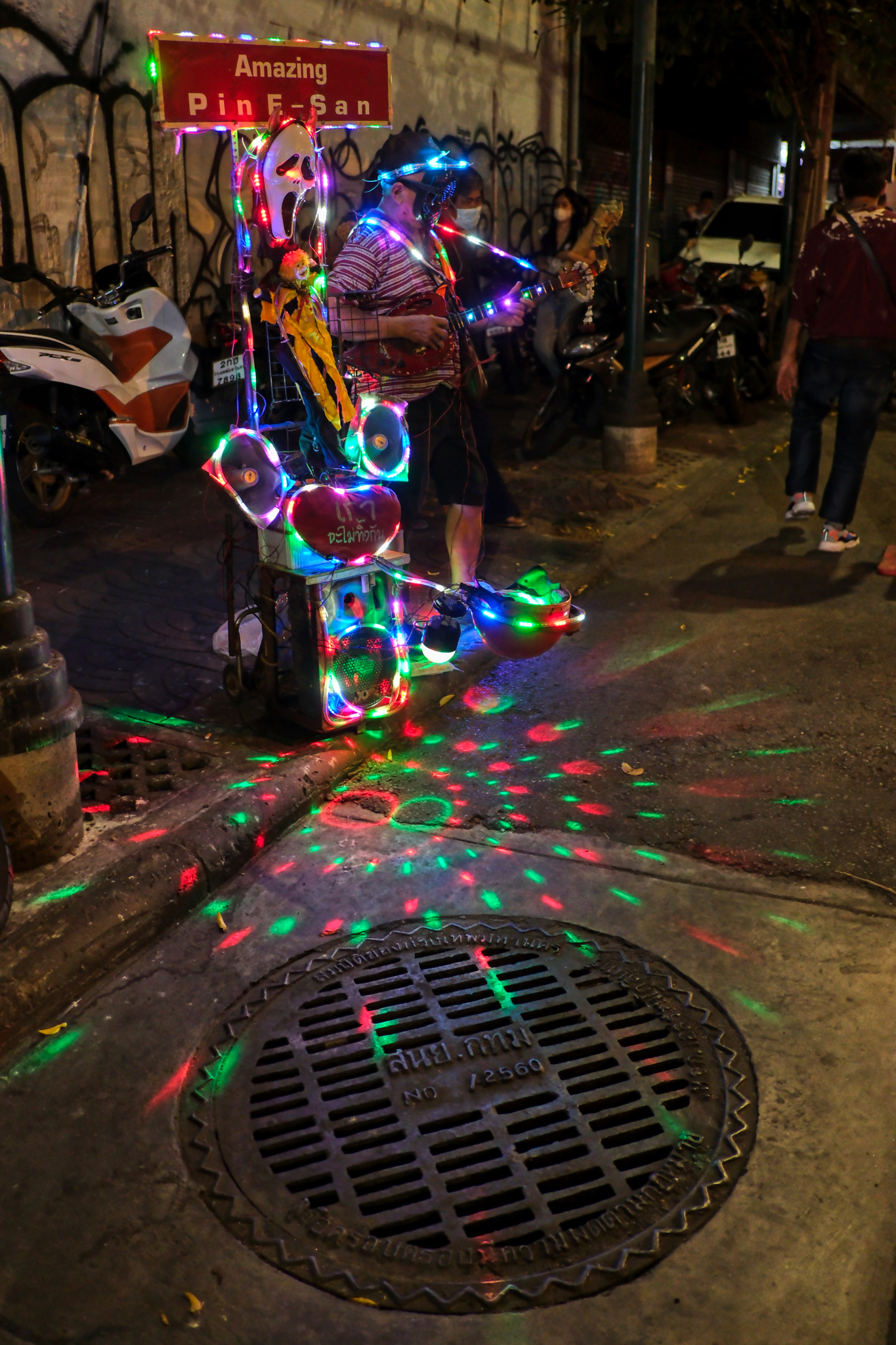 This night busker had it all . . . even his own light show!
This night busker had it all . . . even his own light show!
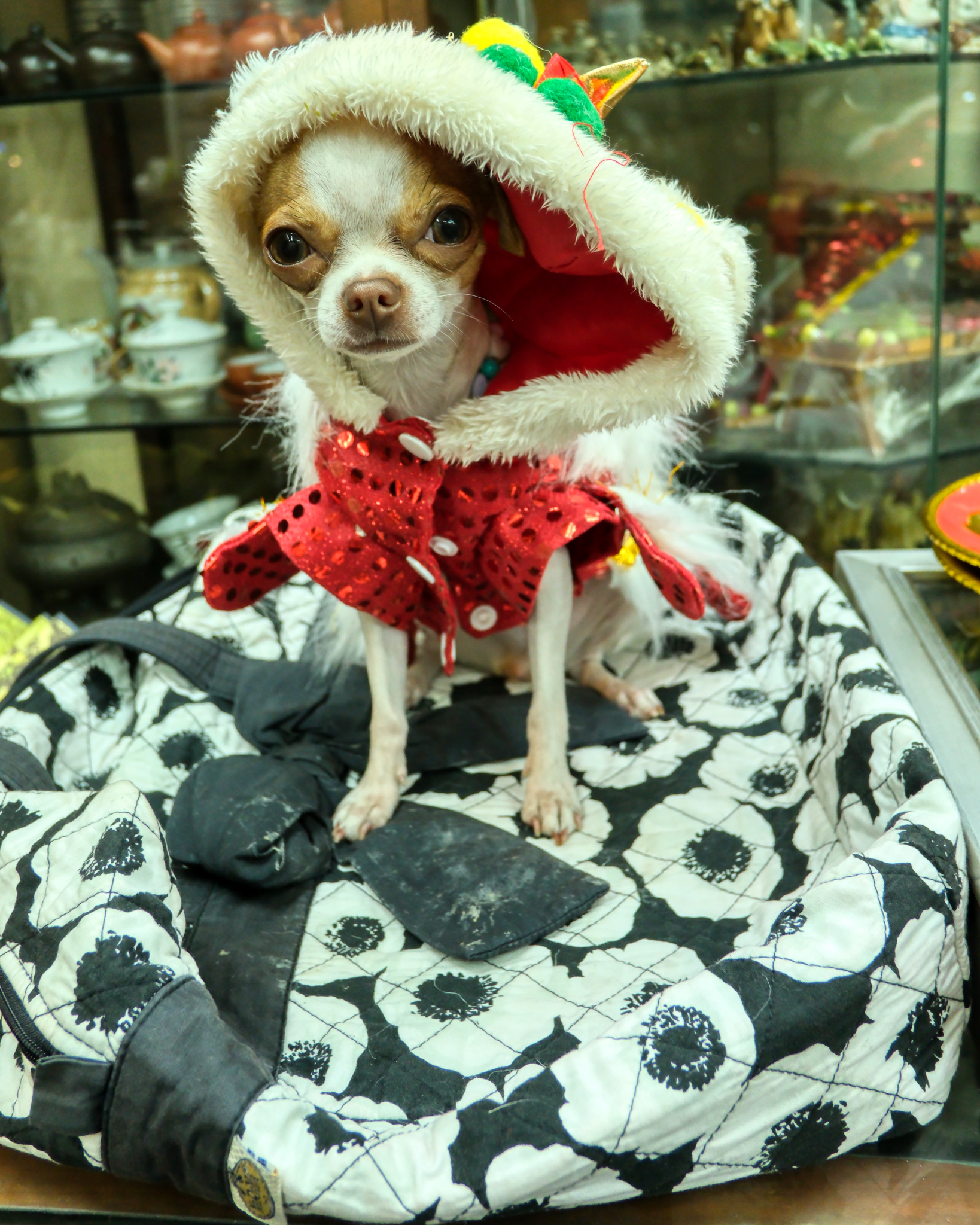 This Buddhist votive statuary shopkeeper had a brilliant way of lureing customers into their shop . . . and it worked:
This Buddhist votive statuary shopkeeper had a brilliant way of lureing customers into their shop . . . and it worked:
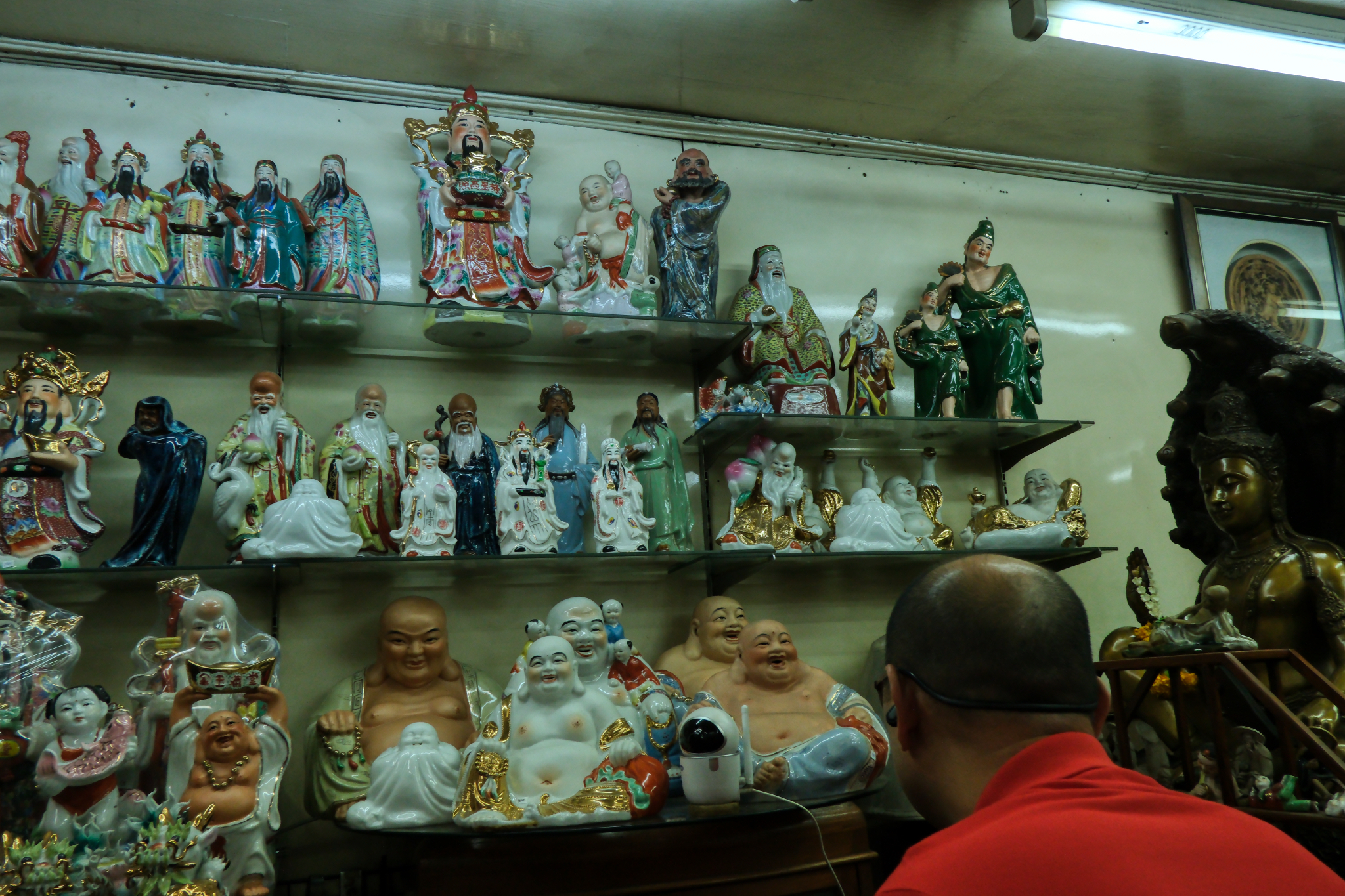 I bought the Ji Gong effigy (far right, top, third from right) for my collection.
I bought the Ji Gong effigy (far right, top, third from right) for my collection.
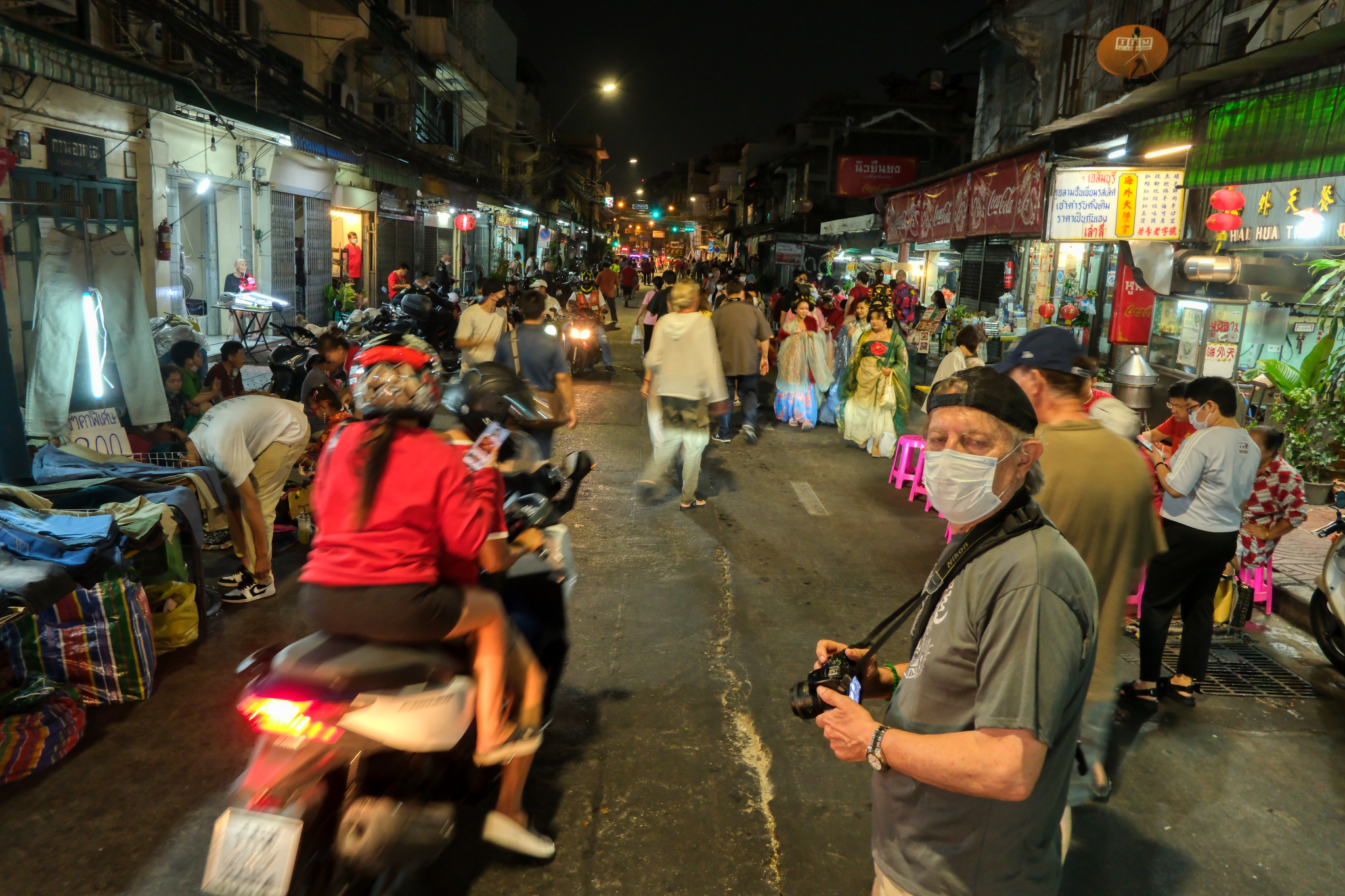 At last, a shortcut back to the MRT underground station.
At last, a shortcut back to the MRT underground station.
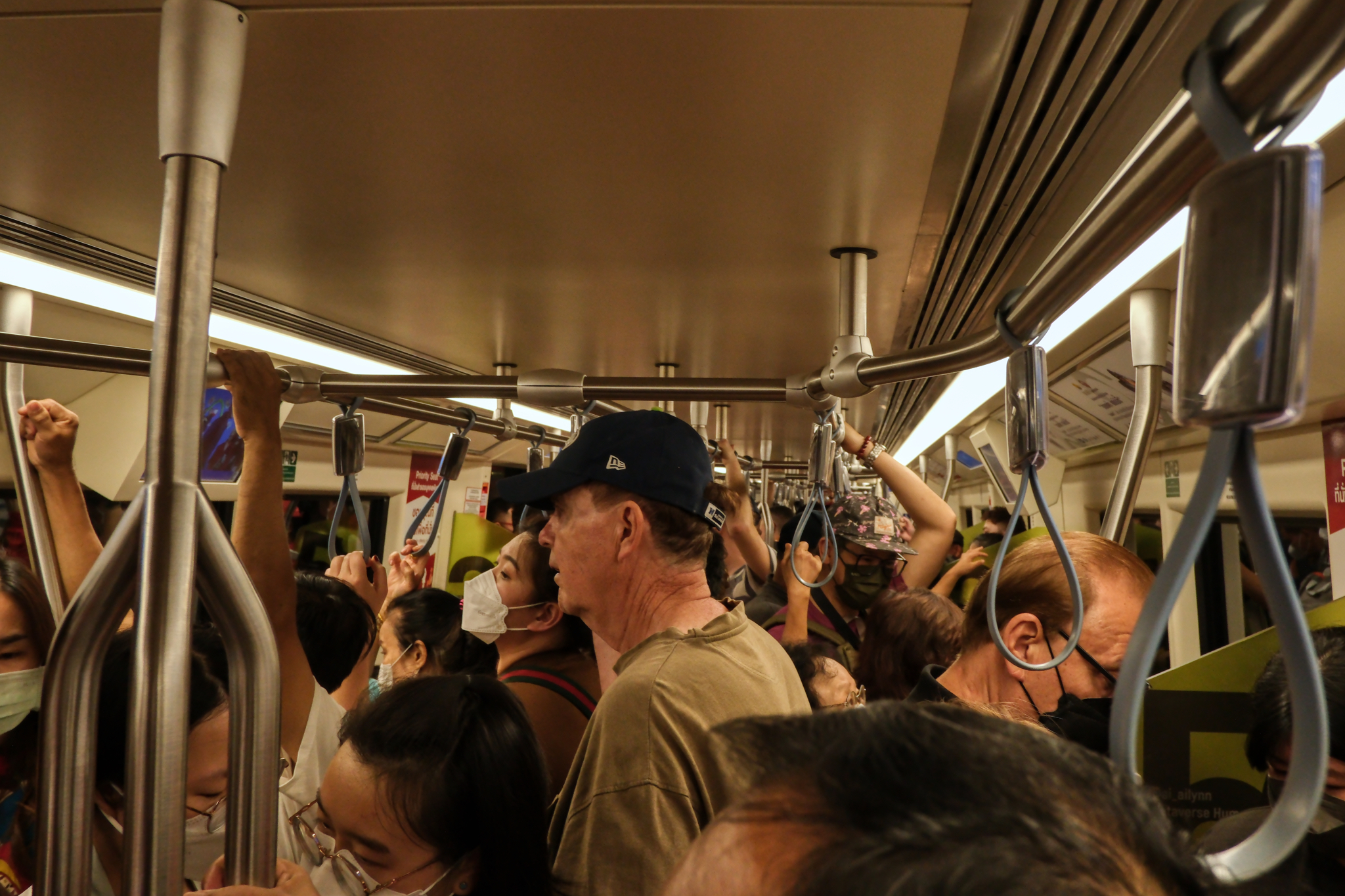 Then onto a crowded MRT underground train home. [This is the ONLY person on the train NOT wearing a mask . . . an American, of course!]
Then onto a crowded MRT underground train home. [This is the ONLY person on the train NOT wearing a mask . . . an American, of course!]
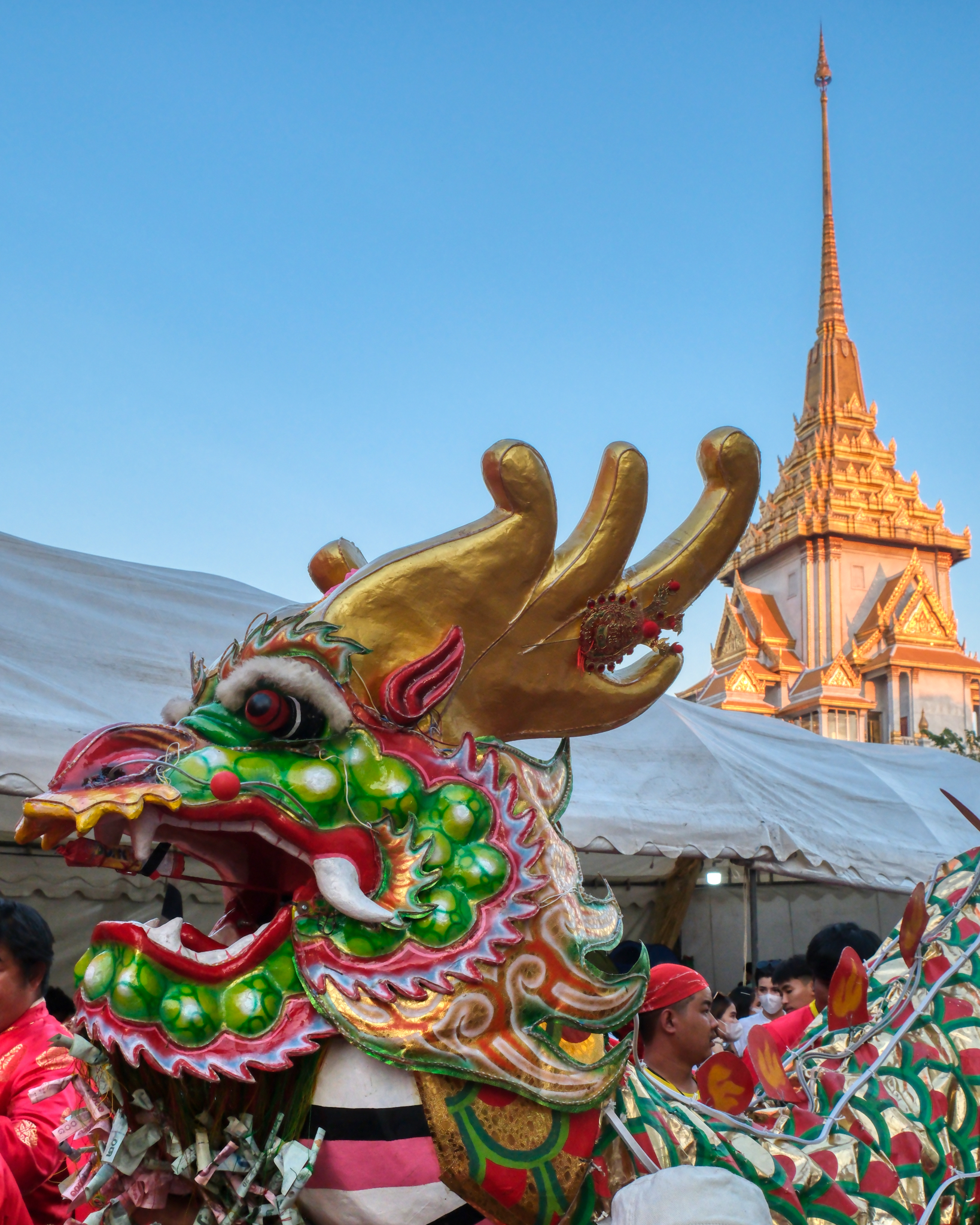 I have so many wonderful memories from that evening spent among the thousands celebrating Chinese New Year in Bangkok's Chinatown. It was a visual extravaganza . . . and a photographers dream!
I have so many wonderful memories from that evening spent among the thousands celebrating Chinese New Year in Bangkok's Chinatown. It was a visual extravaganza . . . and a photographers dream!

Loei, Chiang Khan, and the Mekong River
 Wednesday, October 26, 2022 at 12:57PM
Wednesday, October 26, 2022 at 12:57PM 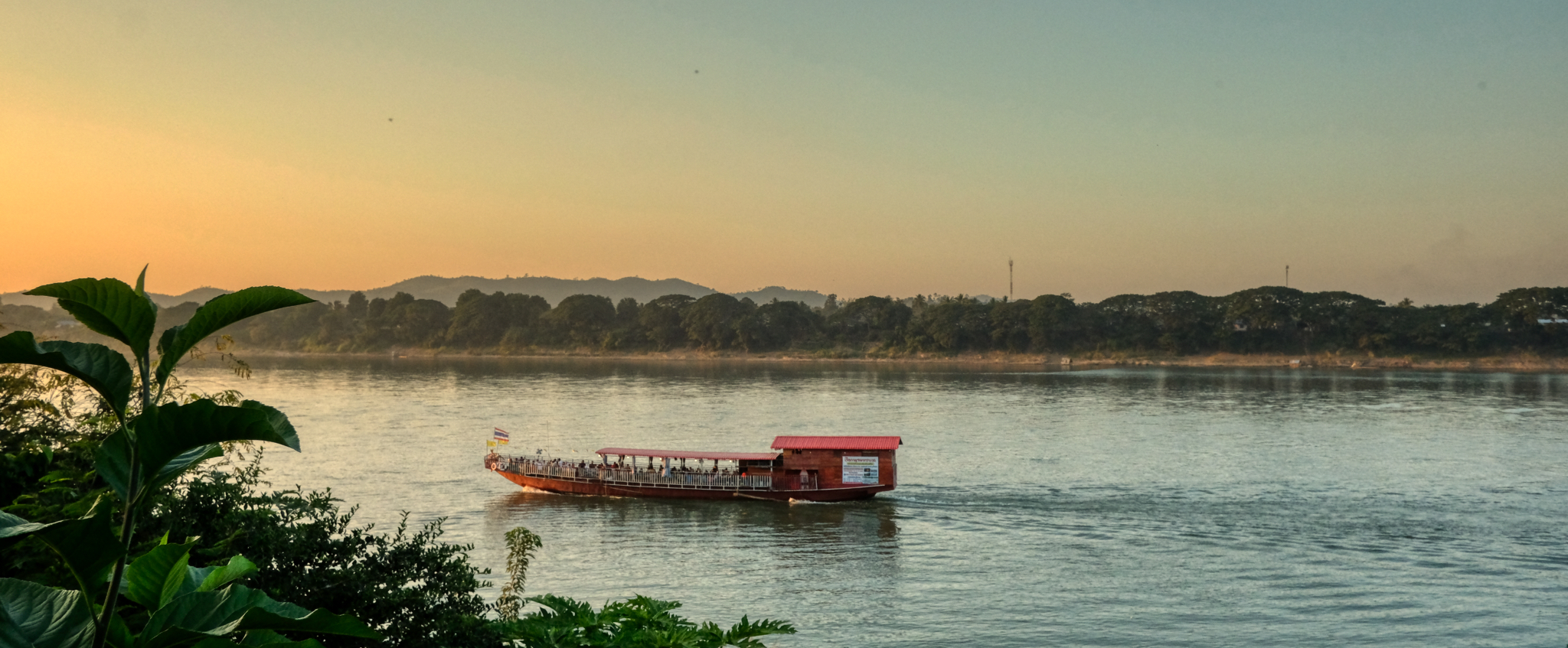
Back in December 2020, just as COVID 19 was bursting on the international scene and choking Thailand's tourist industry, the Thai government came up with a brilliant scheme to give vouchers to Thai residents for discounts at Thai resorts and restaurants in 'tourist areas' to spur more 'in country' tourism by Thais. It worked . . . we took a road trip north to Loei, Chiang Khan, and the Mekong River.
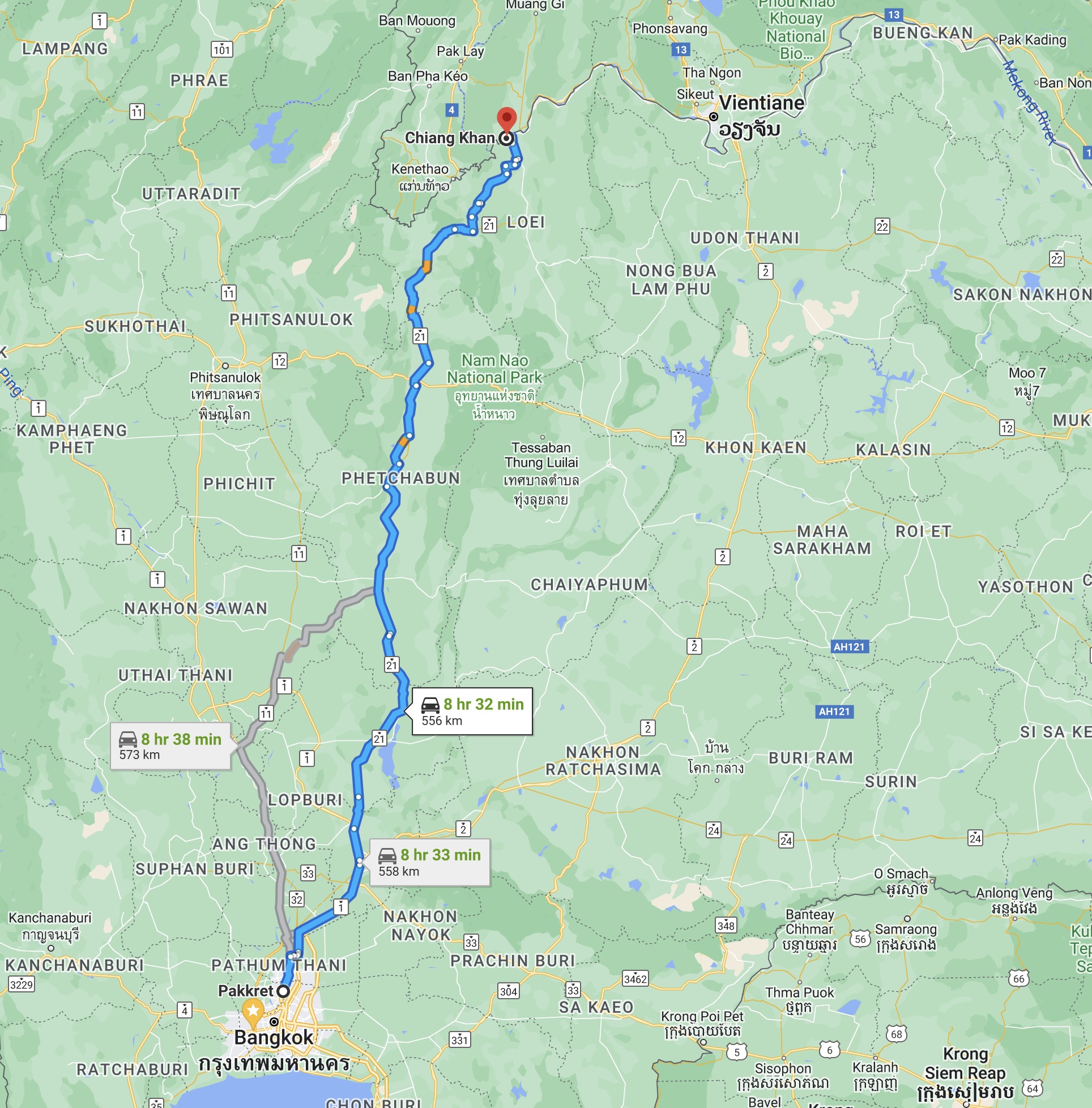 Our route had us drive straight through to Loei from our home in a northern suburb of Bangkok.
Our route had us drive straight through to Loei from our home in a northern suburb of Bangkok.
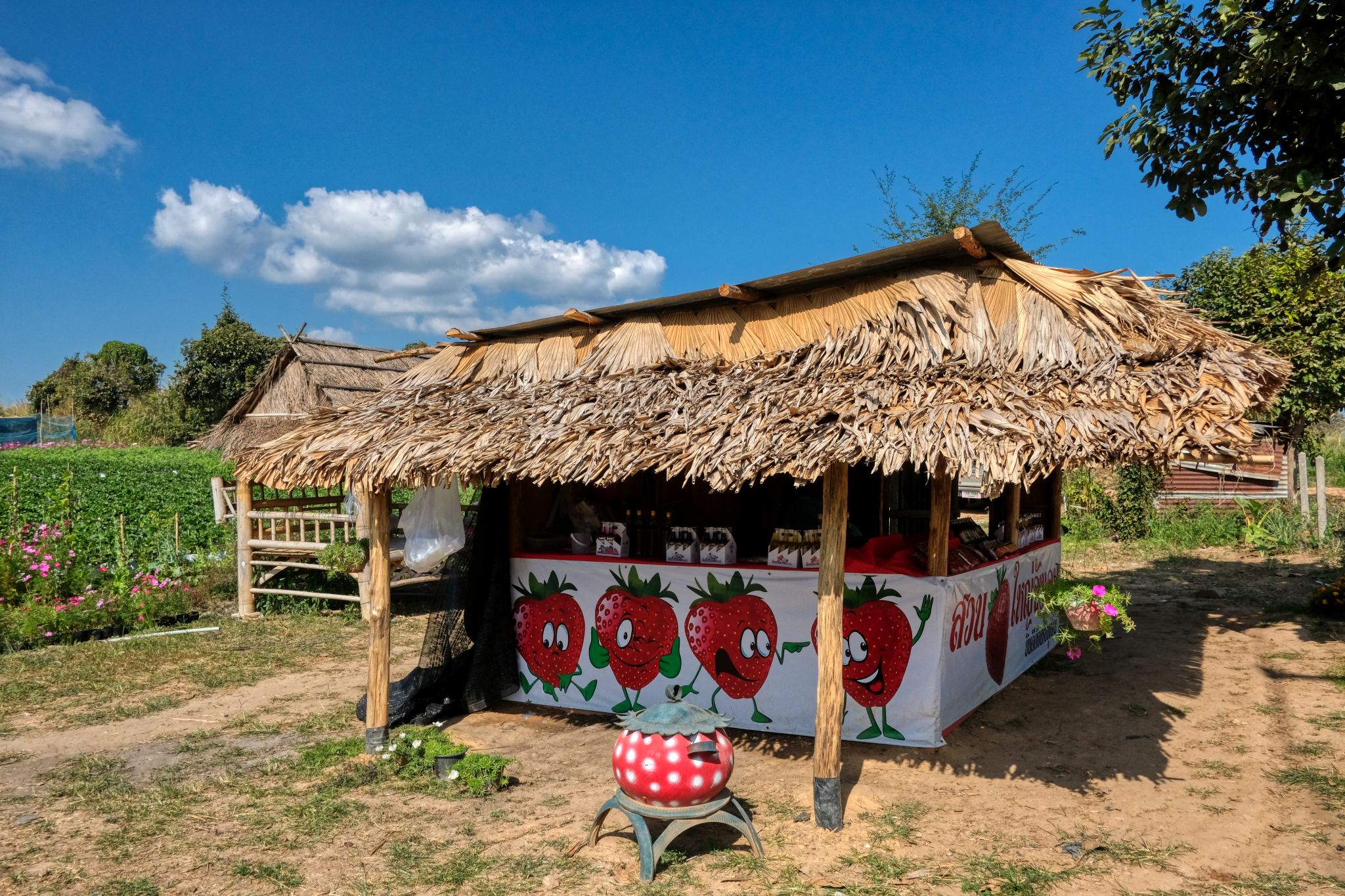 The majority of the drive north to Loei was on modern, divided expressway. However, as we neared Loei the road reverted to a 2-lane country road. We were lured into this strawberry stand with the promise of delicious fruit.
The majority of the drive north to Loei was on modern, divided expressway. However, as we neared Loei the road reverted to a 2-lane country road. We were lured into this strawberry stand with the promise of delicious fruit.
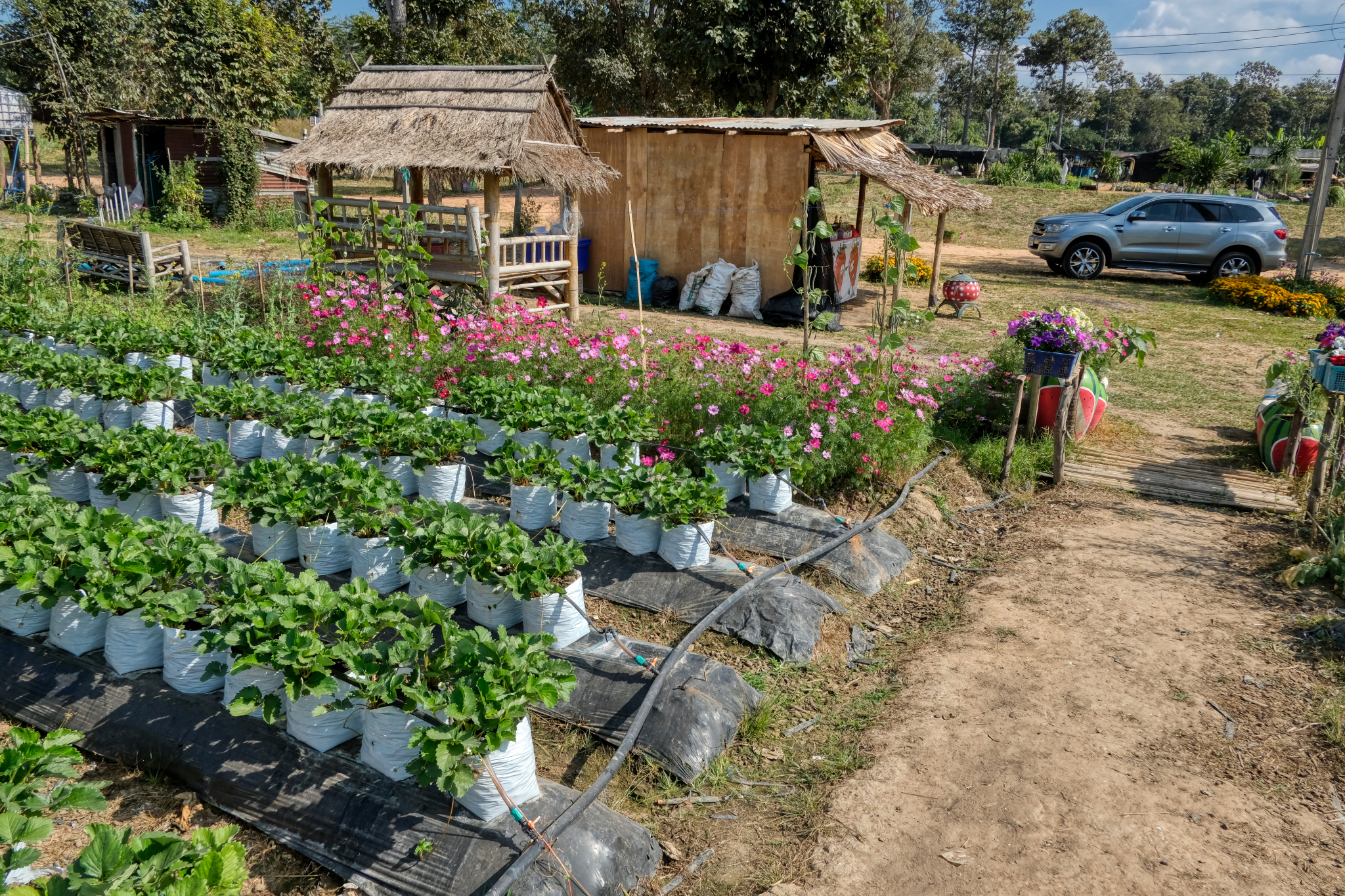 They were growing their own strawberries here . . . but they were asking a very high price for them. We declined to purchase any strawberries here.
They were growing their own strawberries here . . . but they were asking a very high price for them. We declined to purchase any strawberries here.
________________________________
LOEI
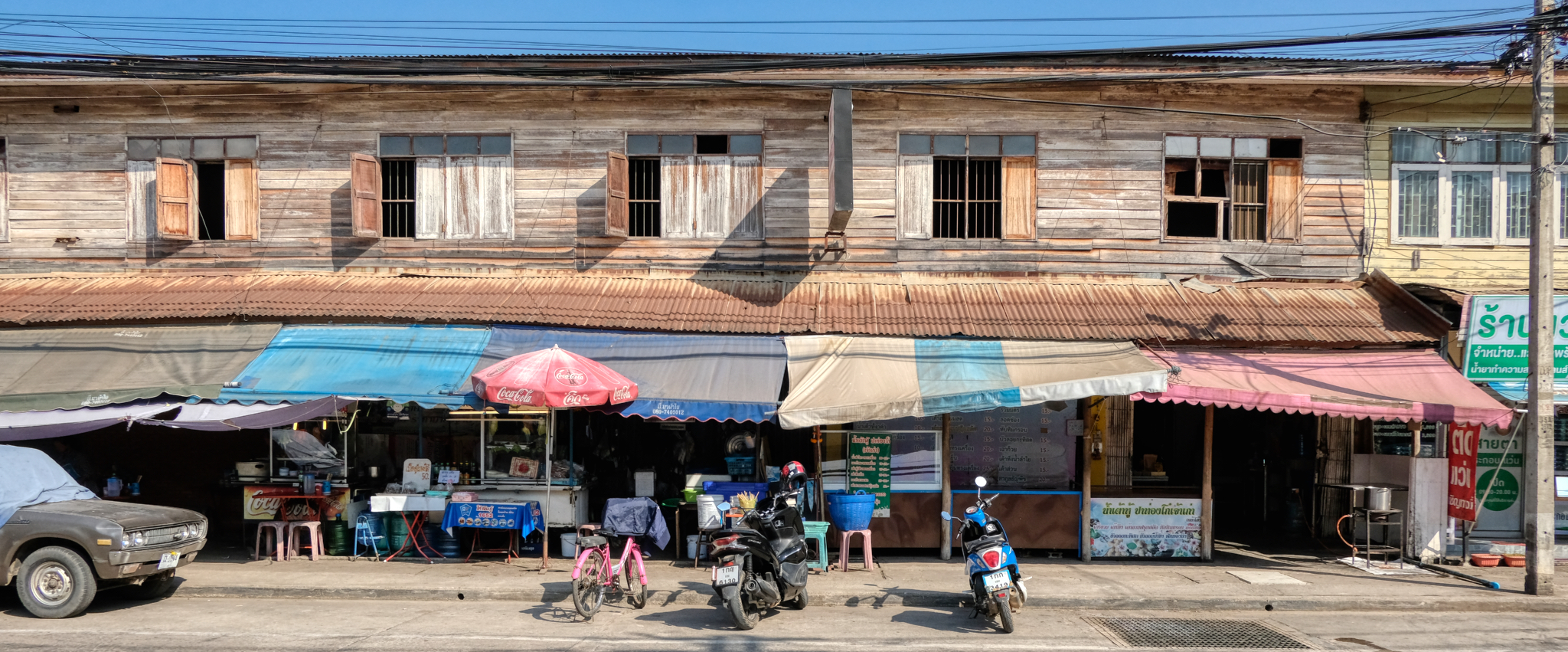 This is the old Loei I came to see . . .
This is the old Loei I came to see . . .
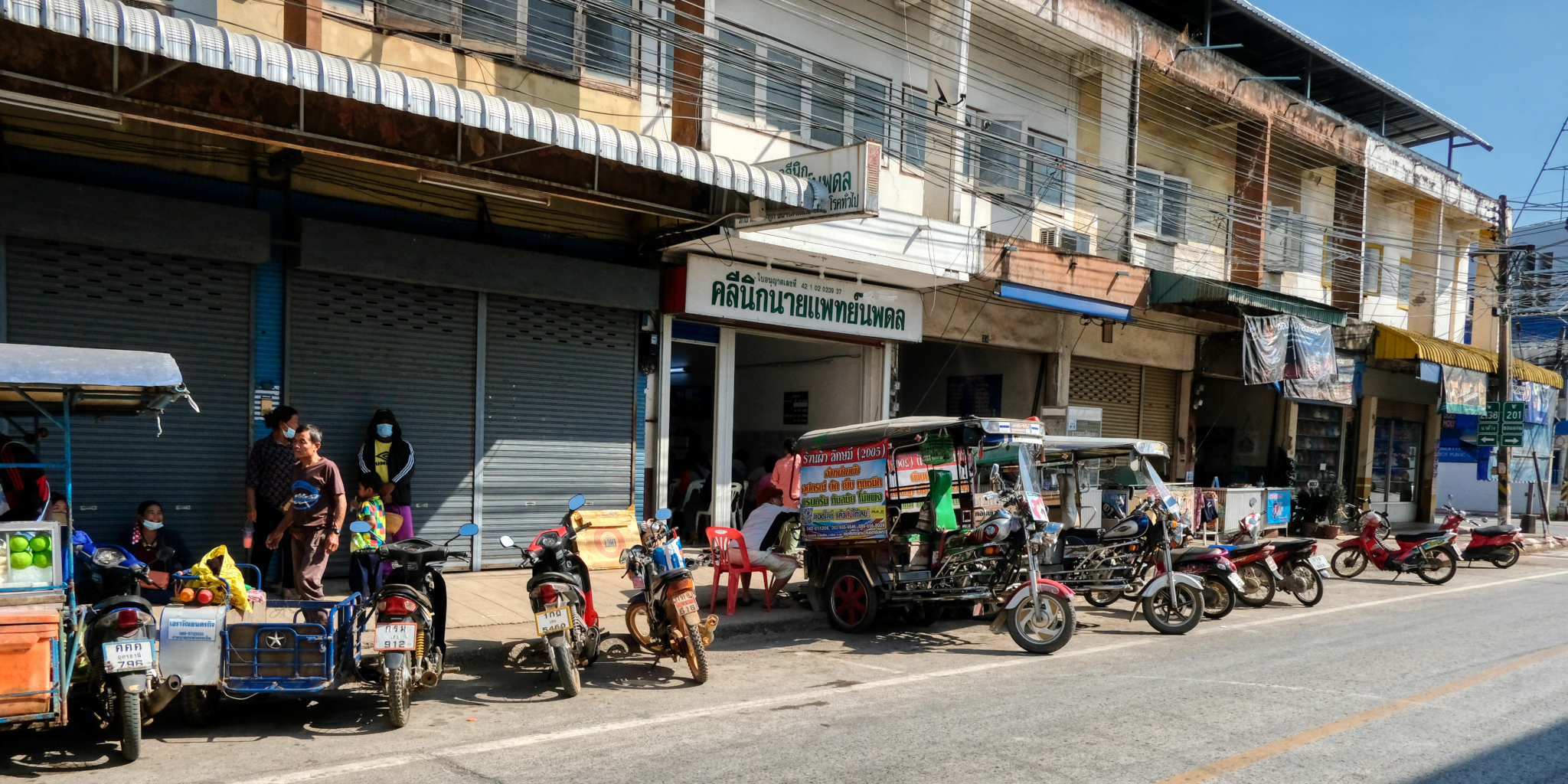 Loei is a provincial market town in the north of Thailand. It is still "old Thailand" in Loei. I last visited here about 20 years ago . . . and yes, it has changed a great deal.
Loei is a provincial market town in the north of Thailand. It is still "old Thailand" in Loei. I last visited here about 20 years ago . . . and yes, it has changed a great deal.
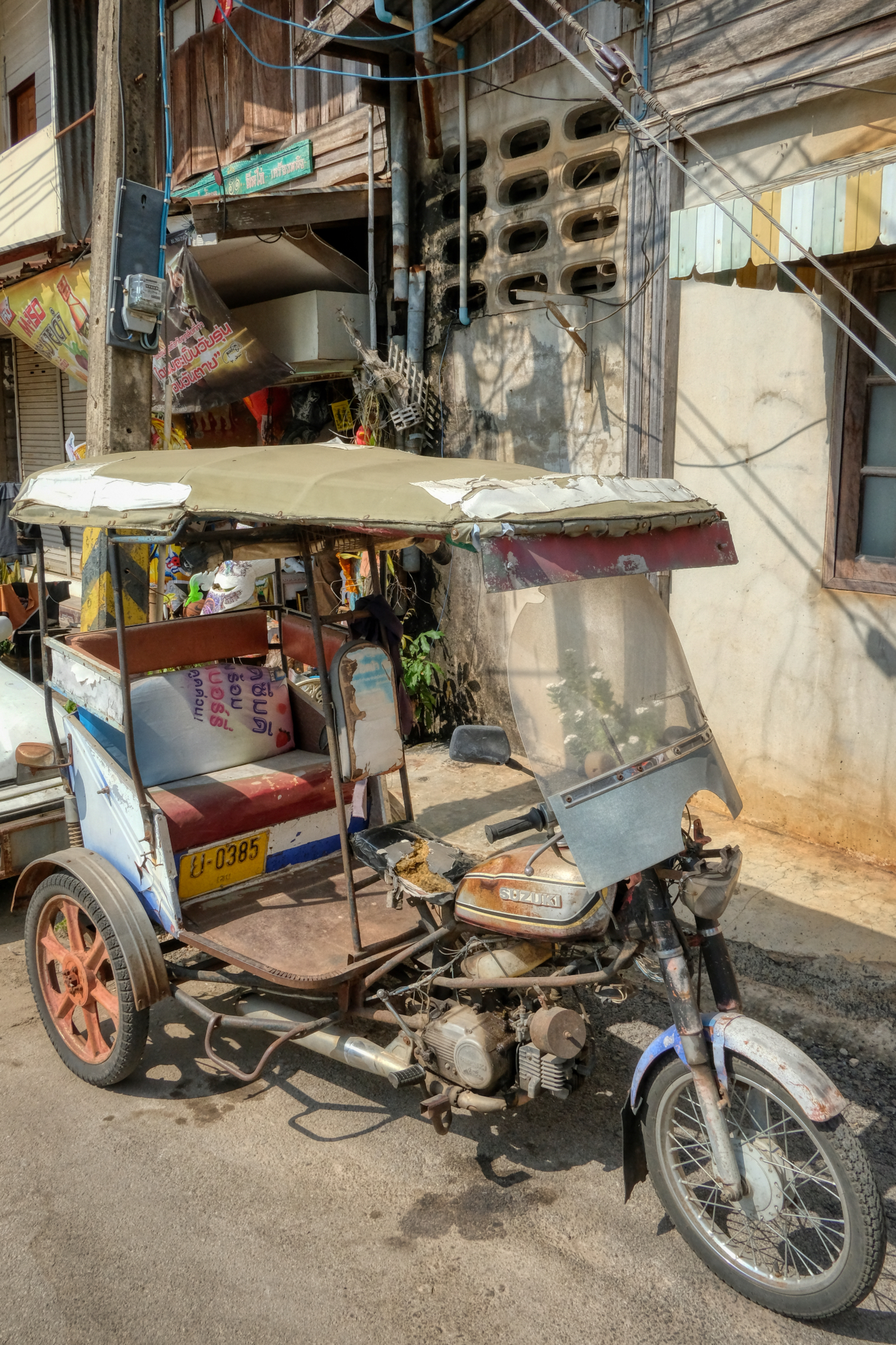 But there is still a lot of the old Thailand I know and love in Loei.
But there is still a lot of the old Thailand I know and love in Loei.
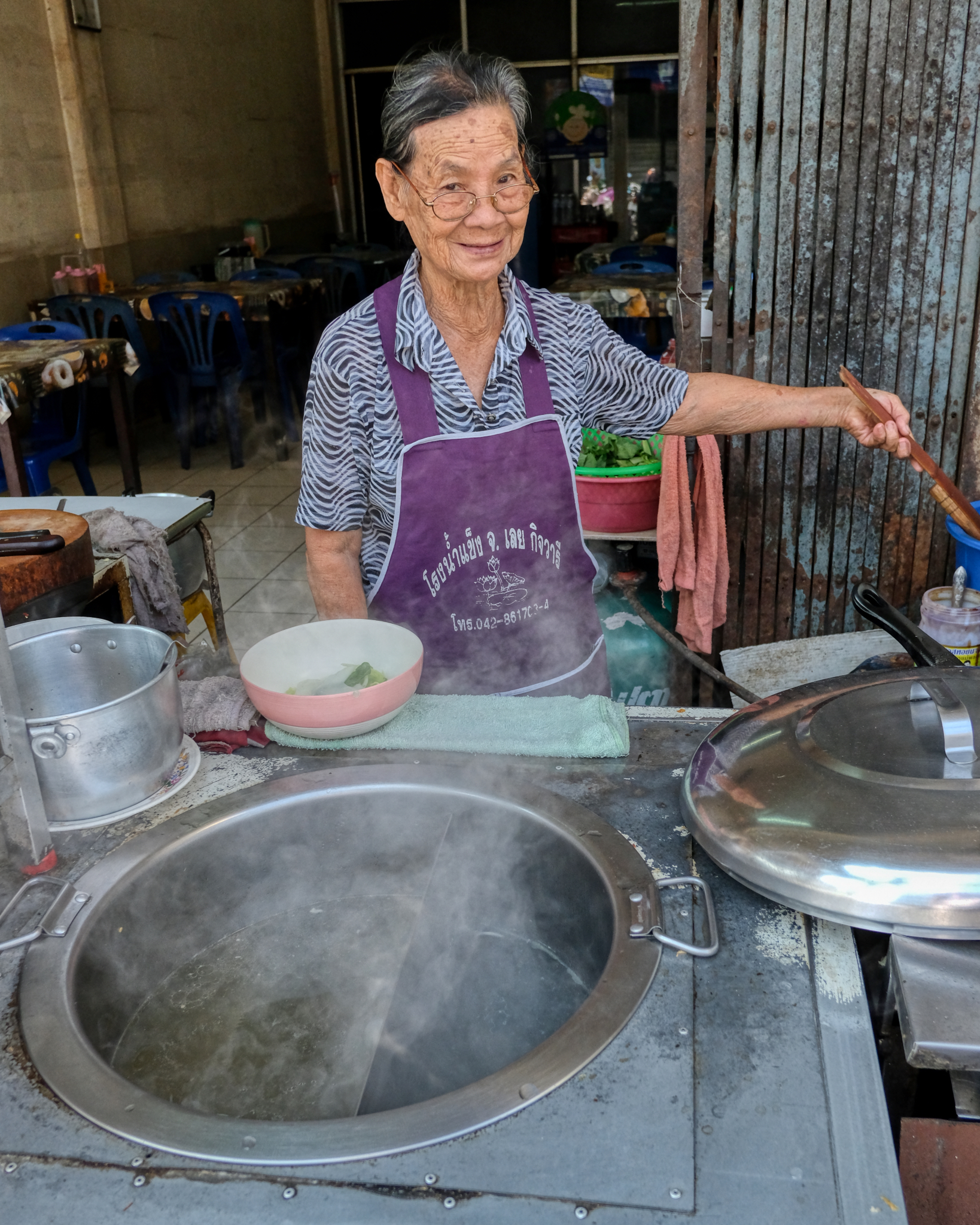 The street food in Loei is excellent . . . and the people friendly.
The street food in Loei is excellent . . . and the people friendly.
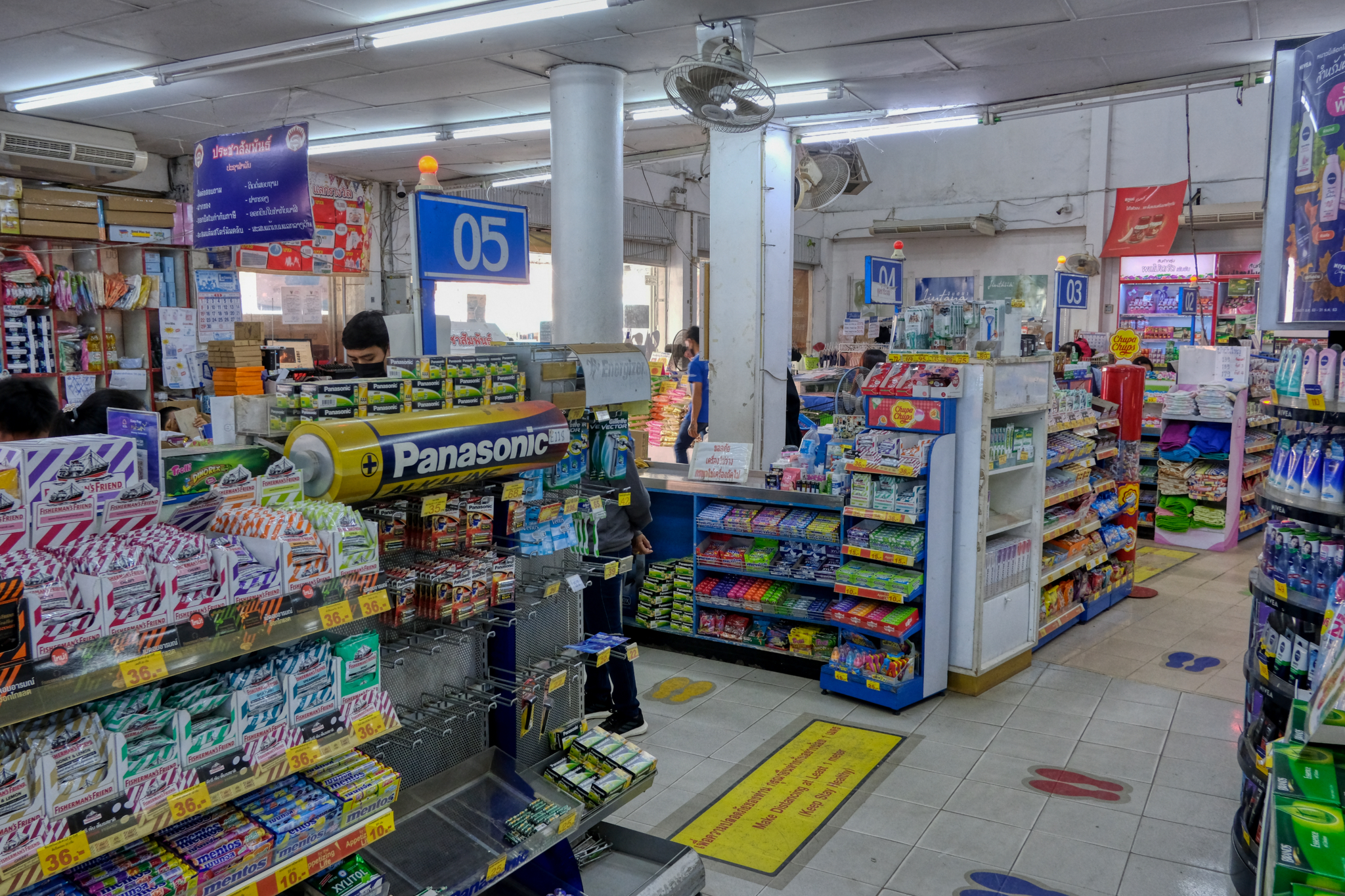 The old downtown of Loei still has locally-owned department stores and "supermarkets" like this one.
The old downtown of Loei still has locally-owned department stores and "supermarkets" like this one.
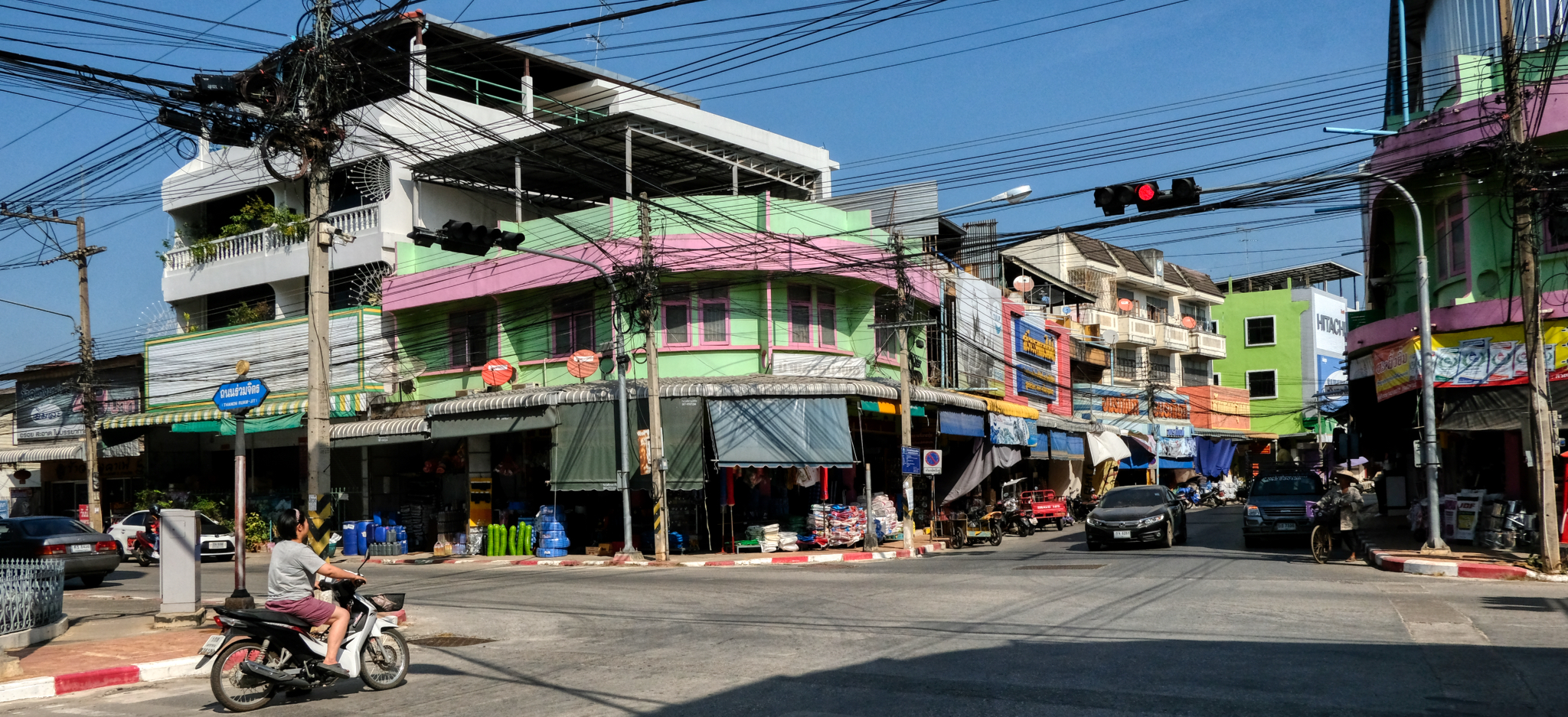 A street corner in downtown Loei. I love snooping around in these old Thai market towns.
A street corner in downtown Loei. I love snooping around in these old Thai market towns.
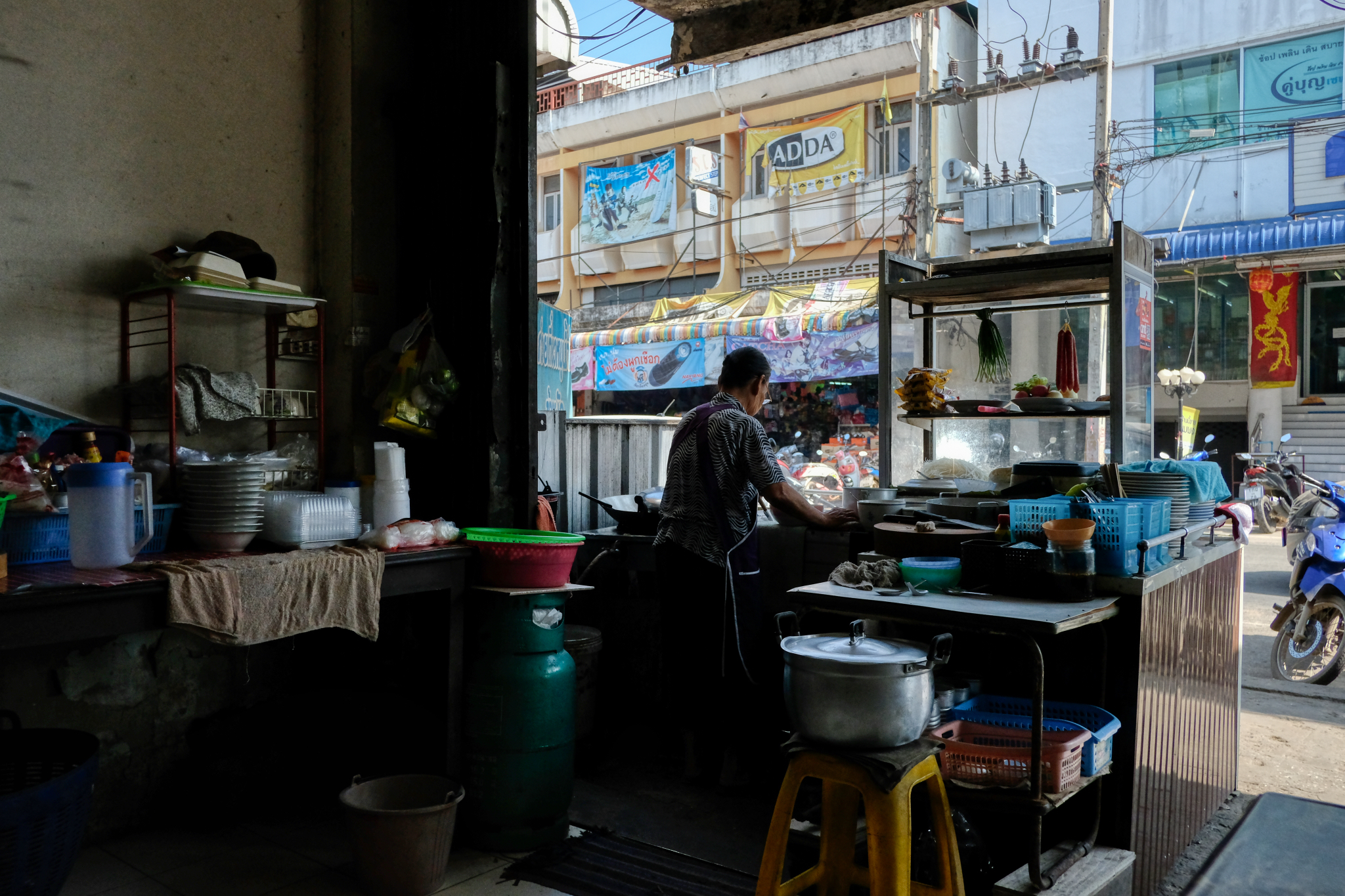 We stopped in this hole-in-the-wall restaurant for delicious noodle soup.
We stopped in this hole-in-the-wall restaurant for delicious noodle soup.
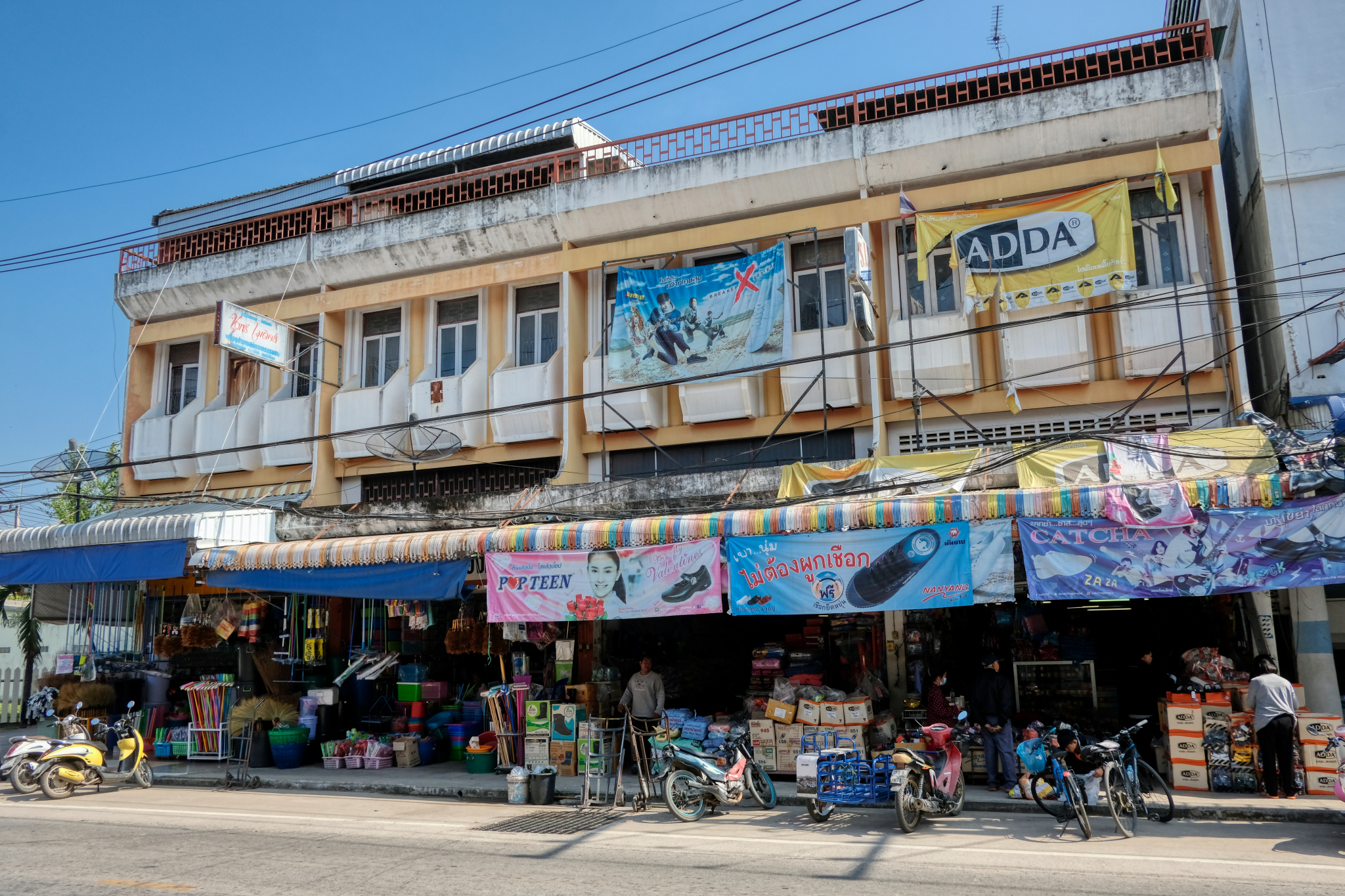 A busy market town serving a large agricultural community.
A busy market town serving a large agricultural community.
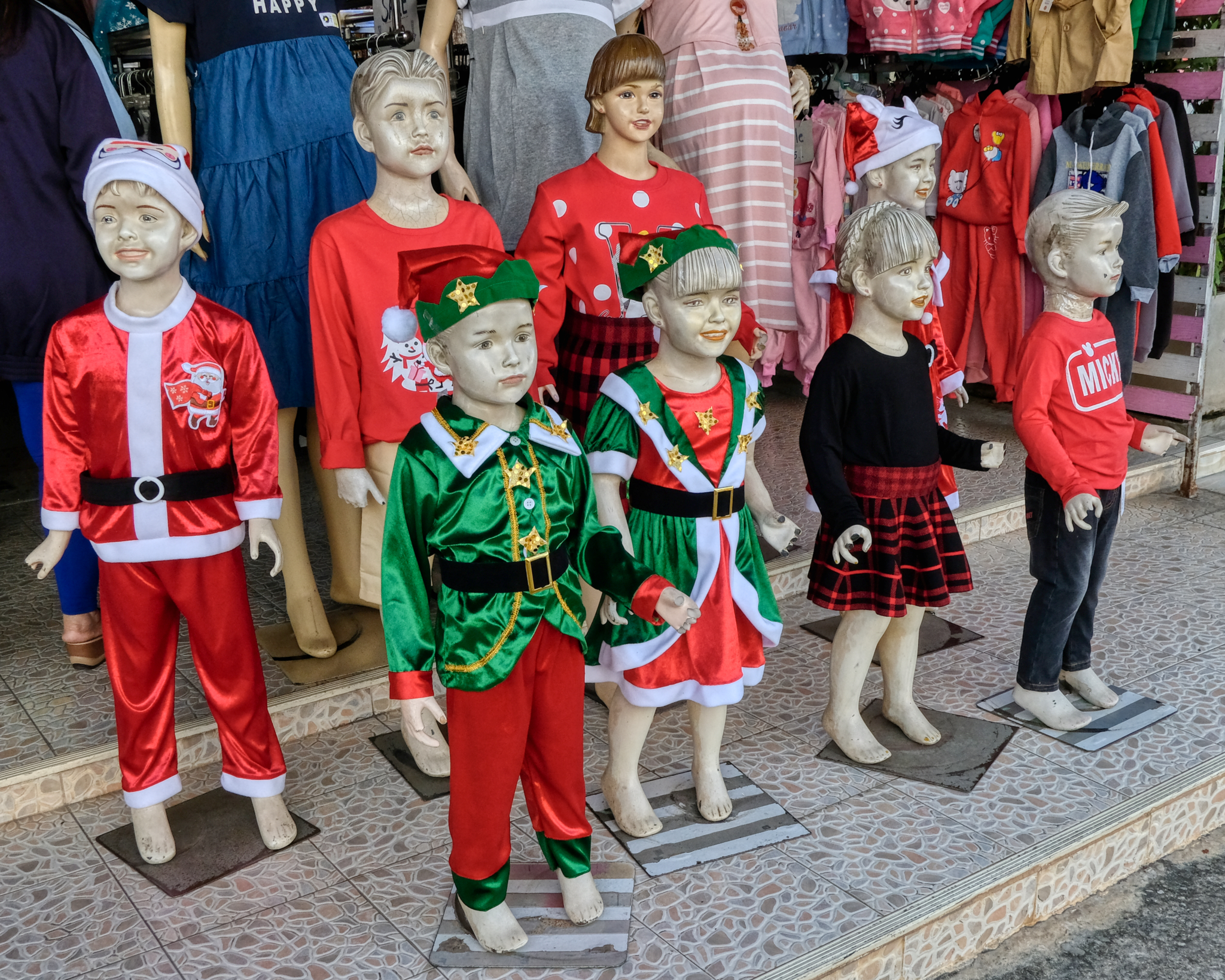 The things you see in Thailand! Yes, it was Christmas season even in Loei, Thailand. They celebrate everything here!
The things you see in Thailand! Yes, it was Christmas season even in Loei, Thailand. They celebrate everything here!
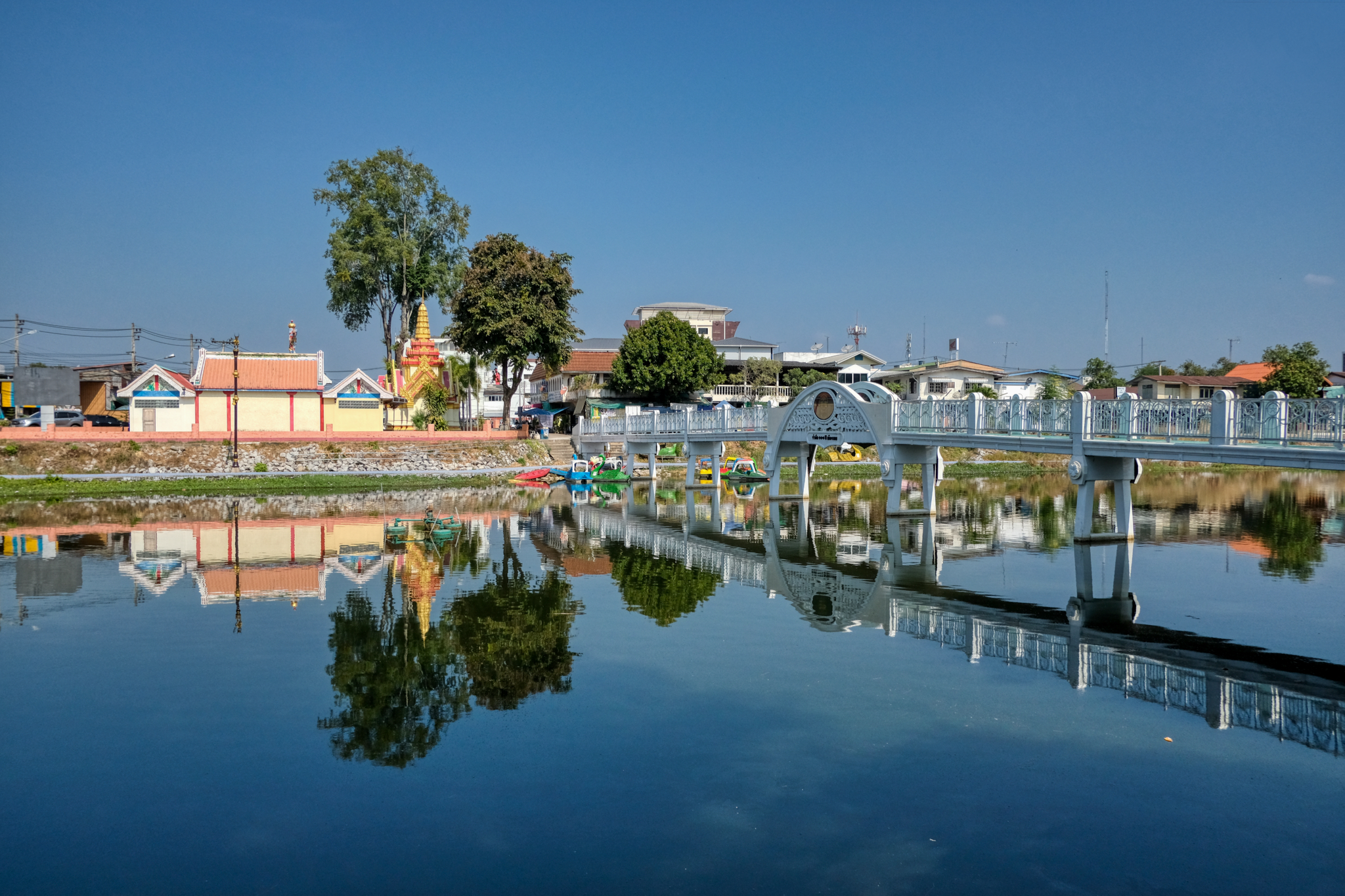 We walked through the downtown and found the banks of the Loei River. The bridge led to a beautiful city park.
We walked through the downtown and found the banks of the Loei River. The bridge led to a beautiful city park.
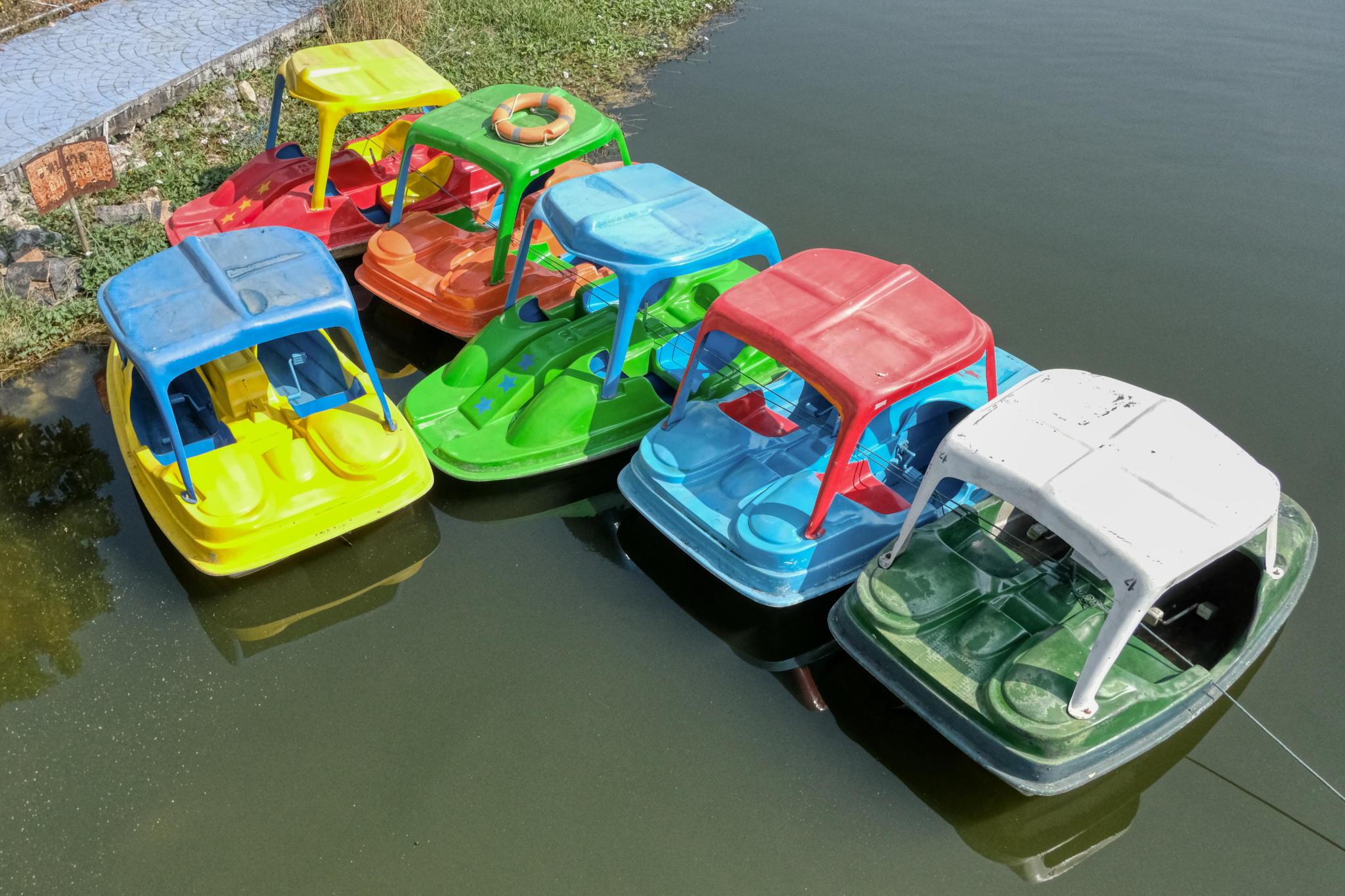 There was fun to be had in Loei.
There was fun to be had in Loei.
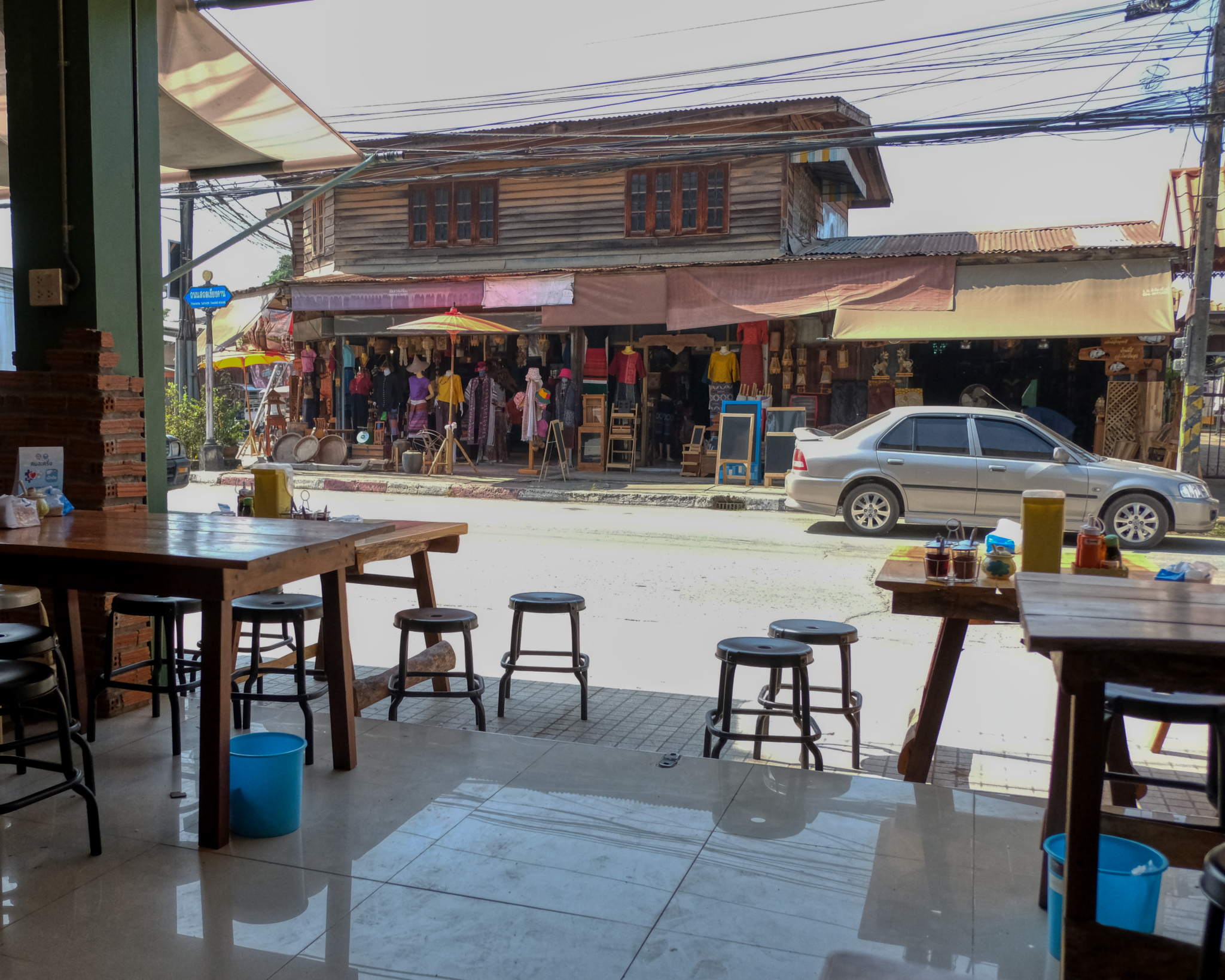 I sat across the street in a hipster coffee shop while my wife shopped in a fine traditional Thai textile shop across the street.
I sat across the street in a hipster coffee shop while my wife shopped in a fine traditional Thai textile shop across the street.
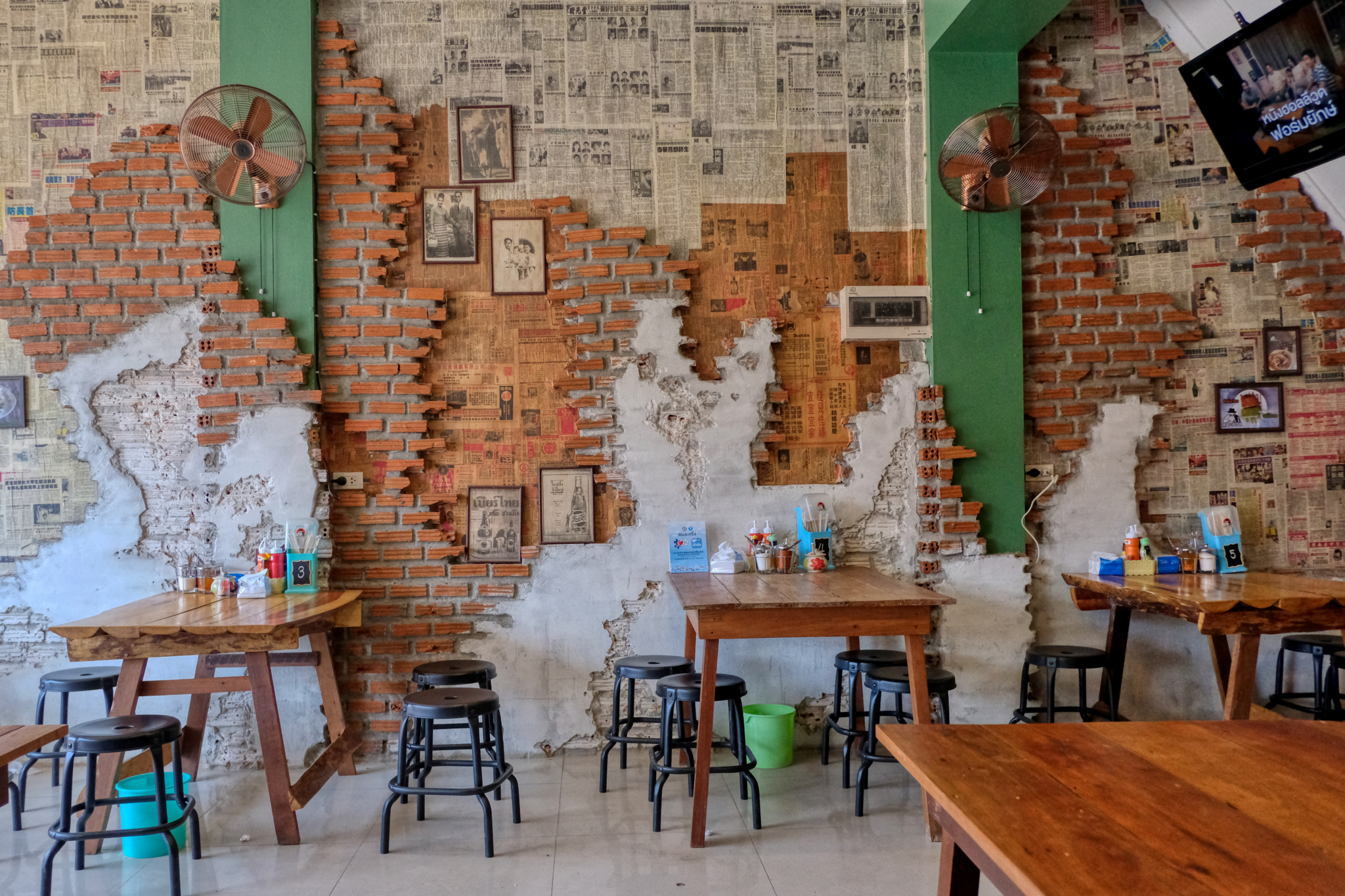 Yes, the hipster cool coffee shop can be found throughout the entire planet . . . even in the remote old market town of Loei.
Yes, the hipster cool coffee shop can be found throughout the entire planet . . . even in the remote old market town of Loei.
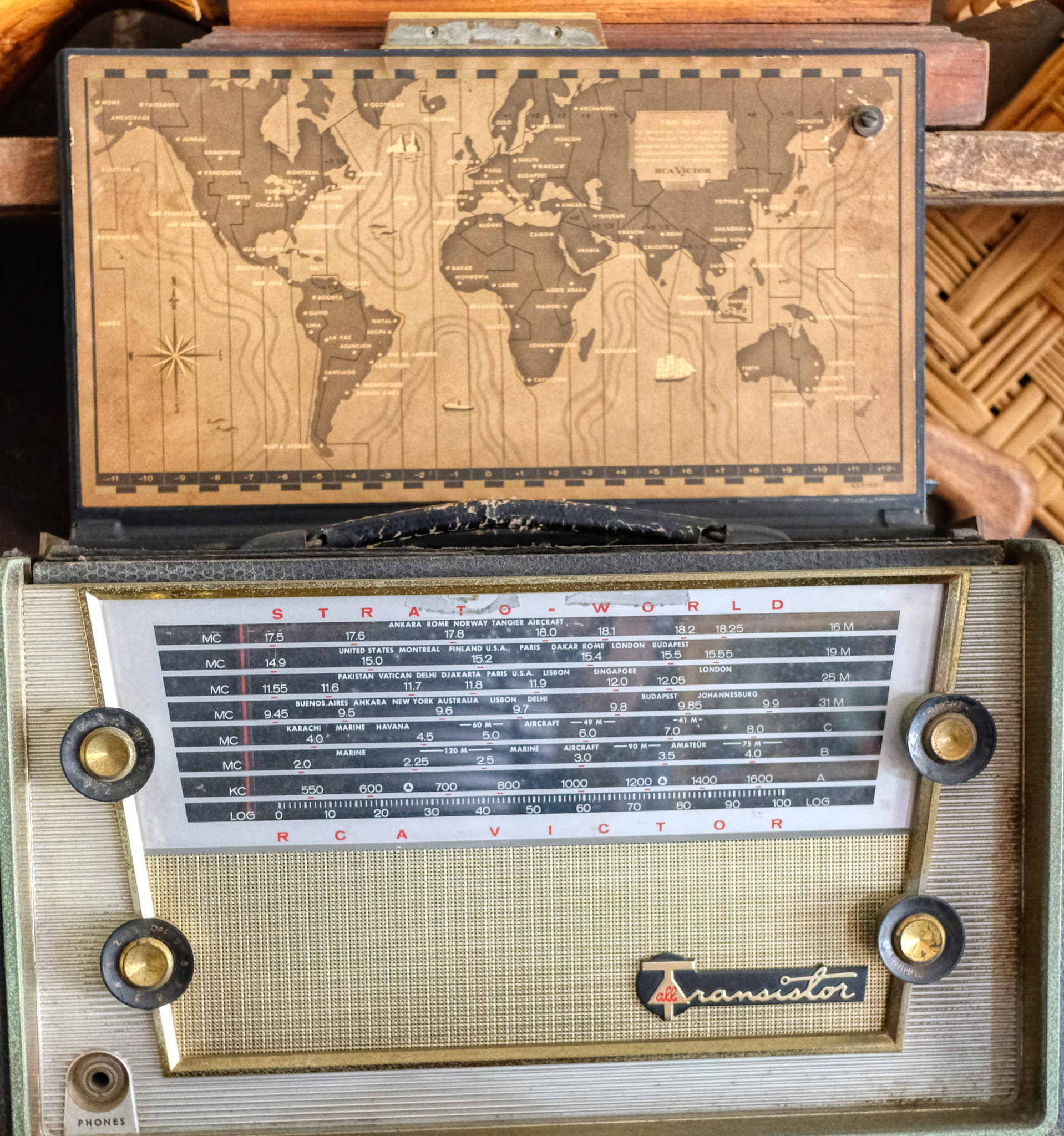 Always interesting old stuff to be found in old Thai village stores.
Always interesting old stuff to be found in old Thai village stores.
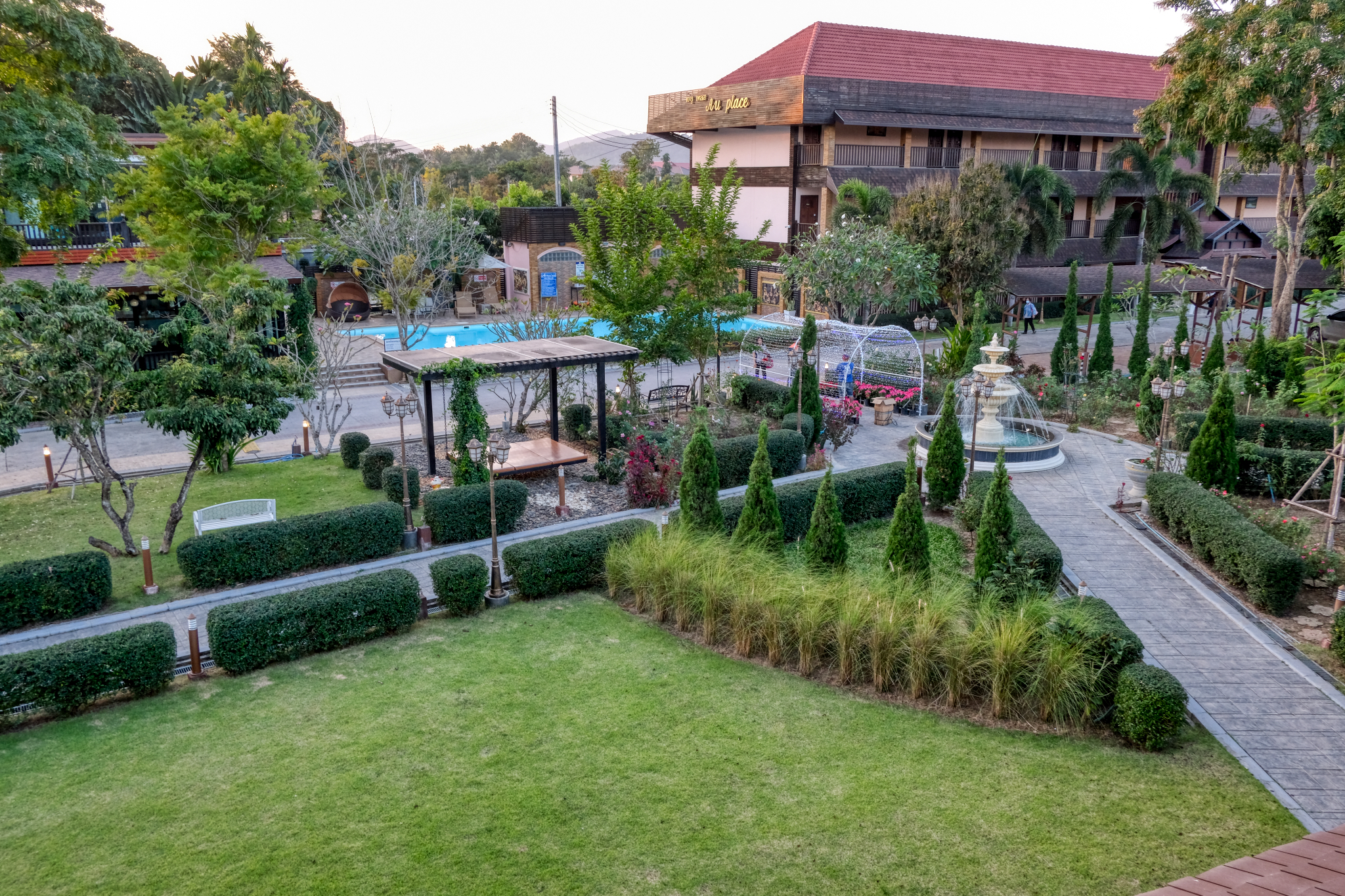 Our very good, and very cheap Au Place Hotel in Loei.
Our very good, and very cheap Au Place Hotel in Loei.
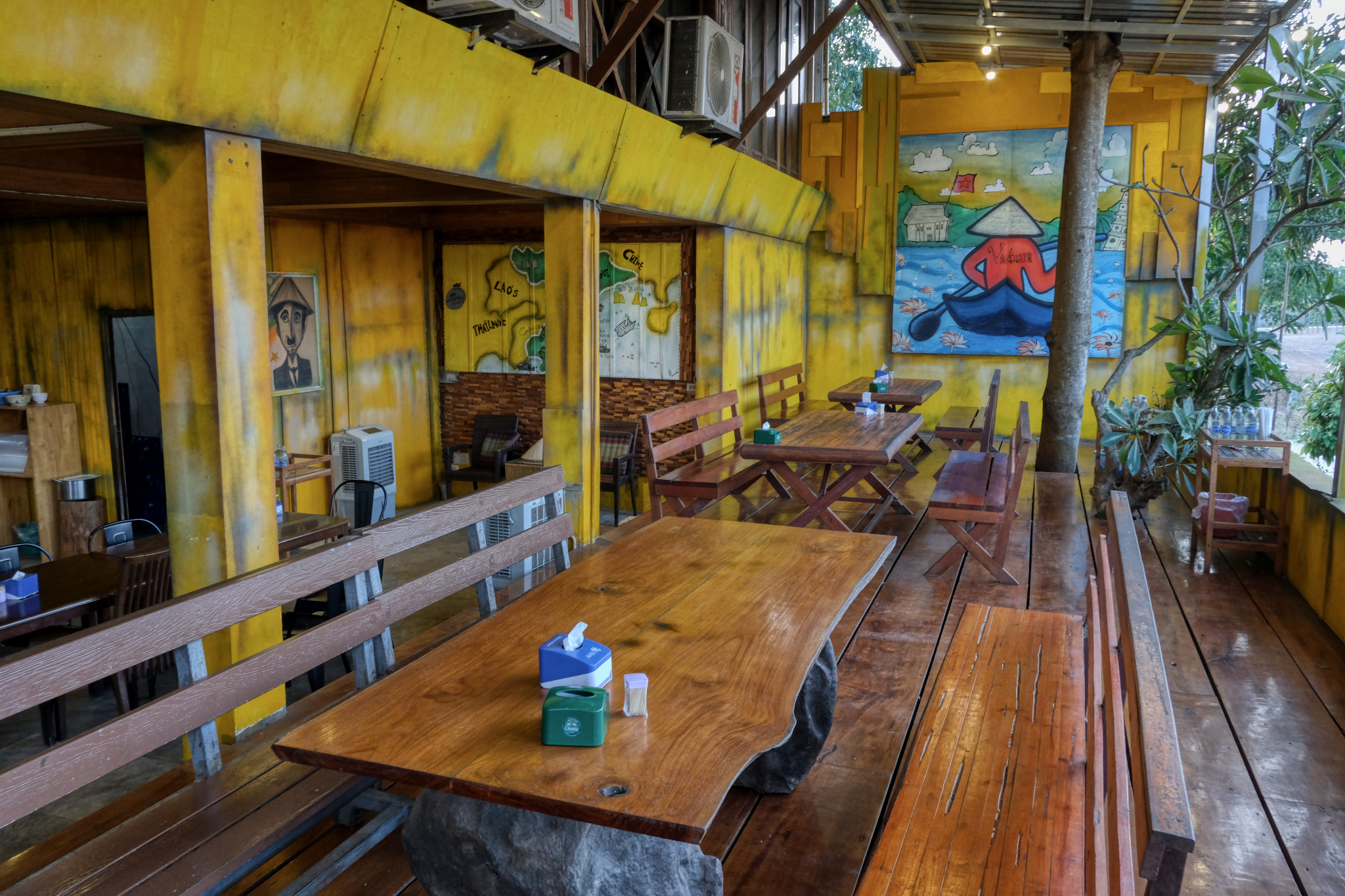 Just a half block away from the hotel on a rural street we found this stylish Vietnamese restaurant.
Just a half block away from the hotel on a rural street we found this stylish Vietnamese restaurant.
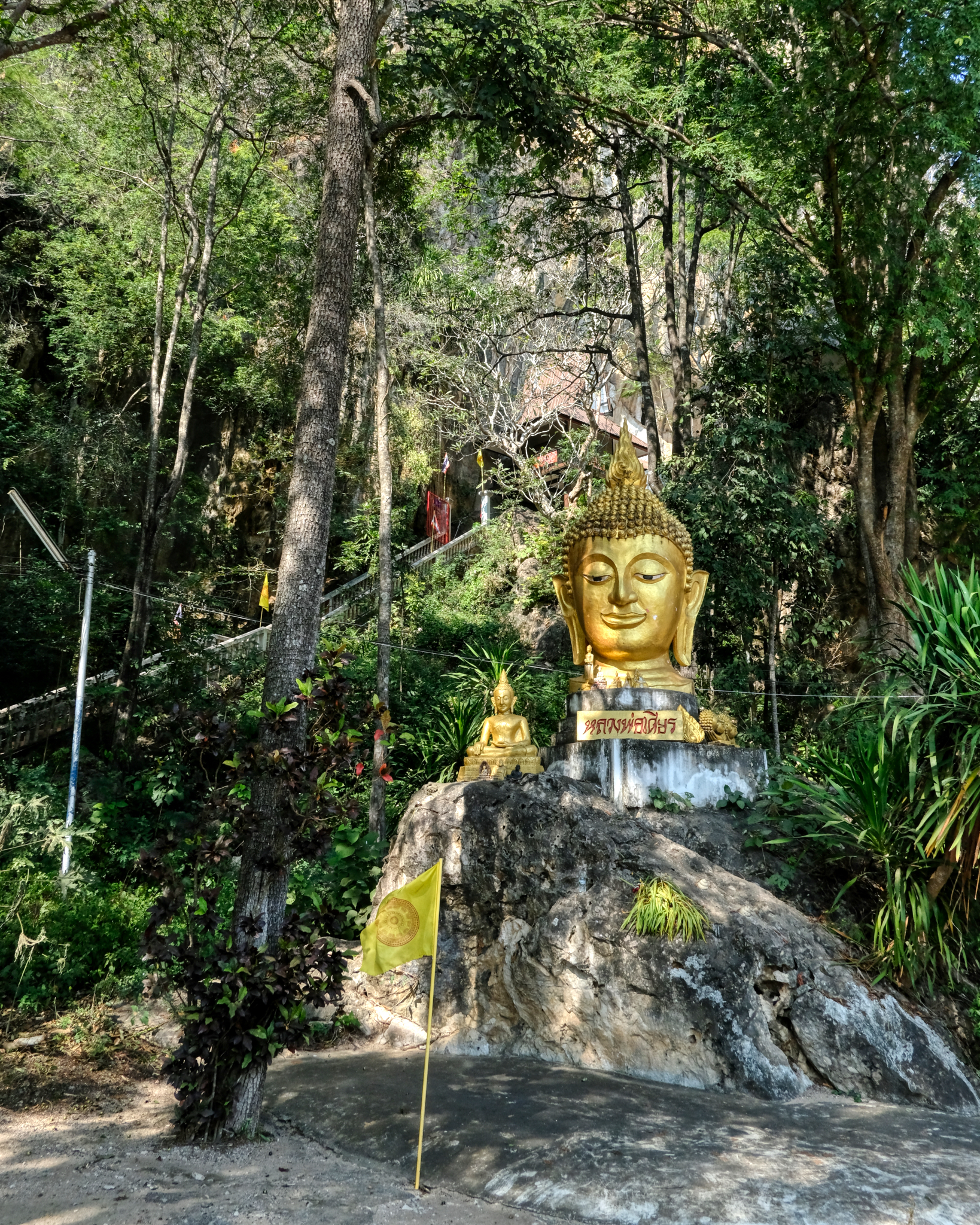 We spent a couple nights in Loei and would venture out into the countryside in search of interesting things to see. We found this amazing Buddhist Temple (Wat).
We spent a couple nights in Loei and would venture out into the countryside in search of interesting things to see. We found this amazing Buddhist Temple (Wat).
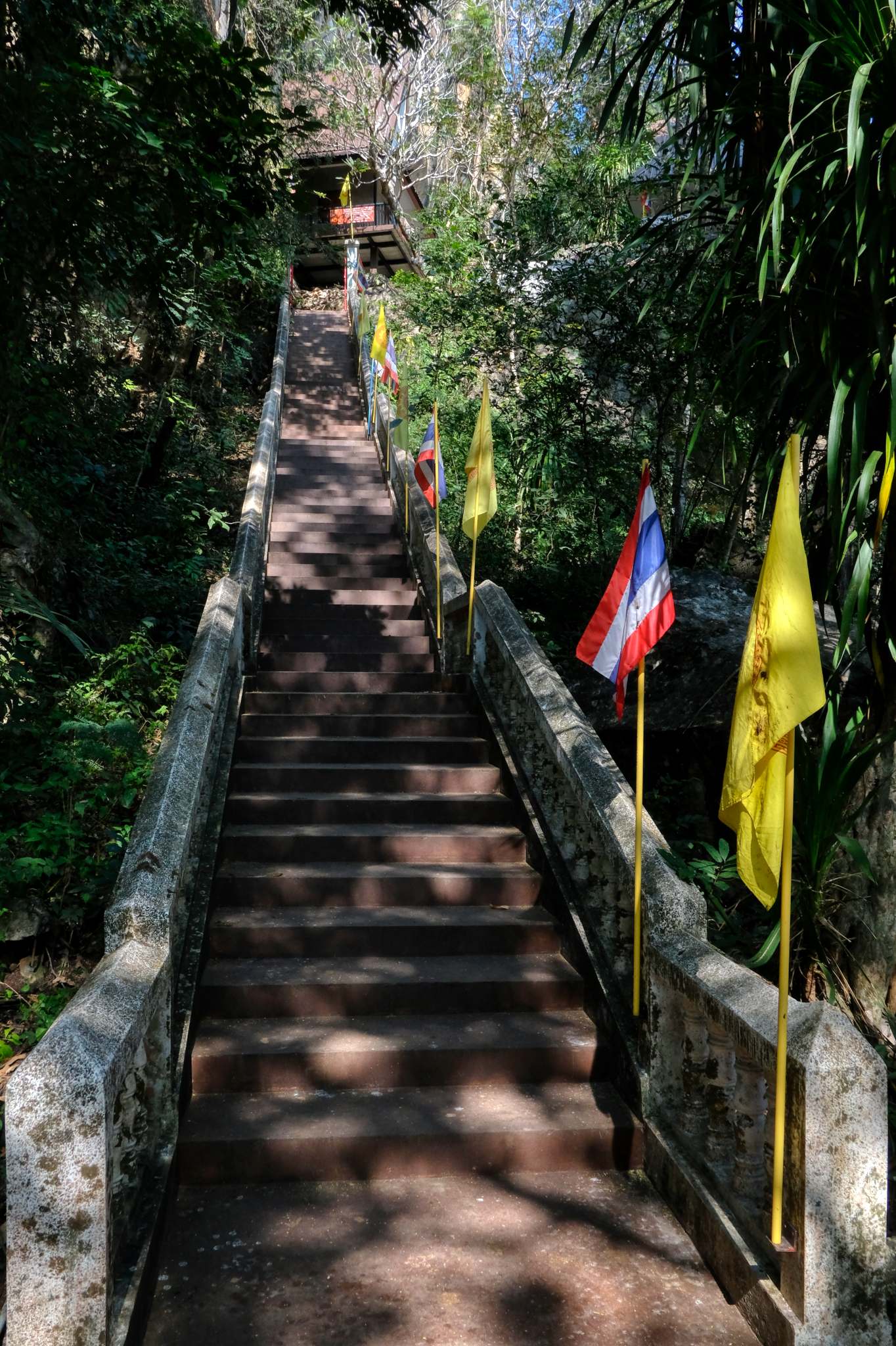 There were caves with Buddhas to explore at this wat.
There were caves with Buddhas to explore at this wat.
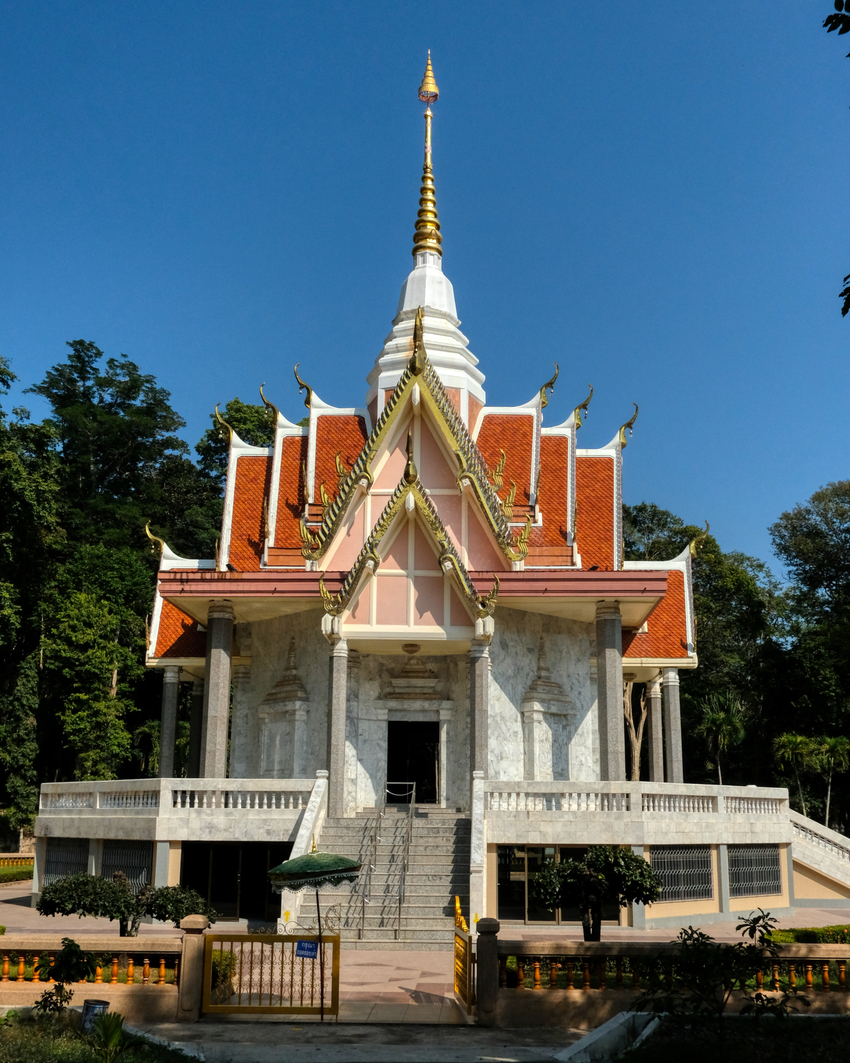 There was this very beautiful marble temple on the wat grounds.
There was this very beautiful marble temple on the wat grounds.
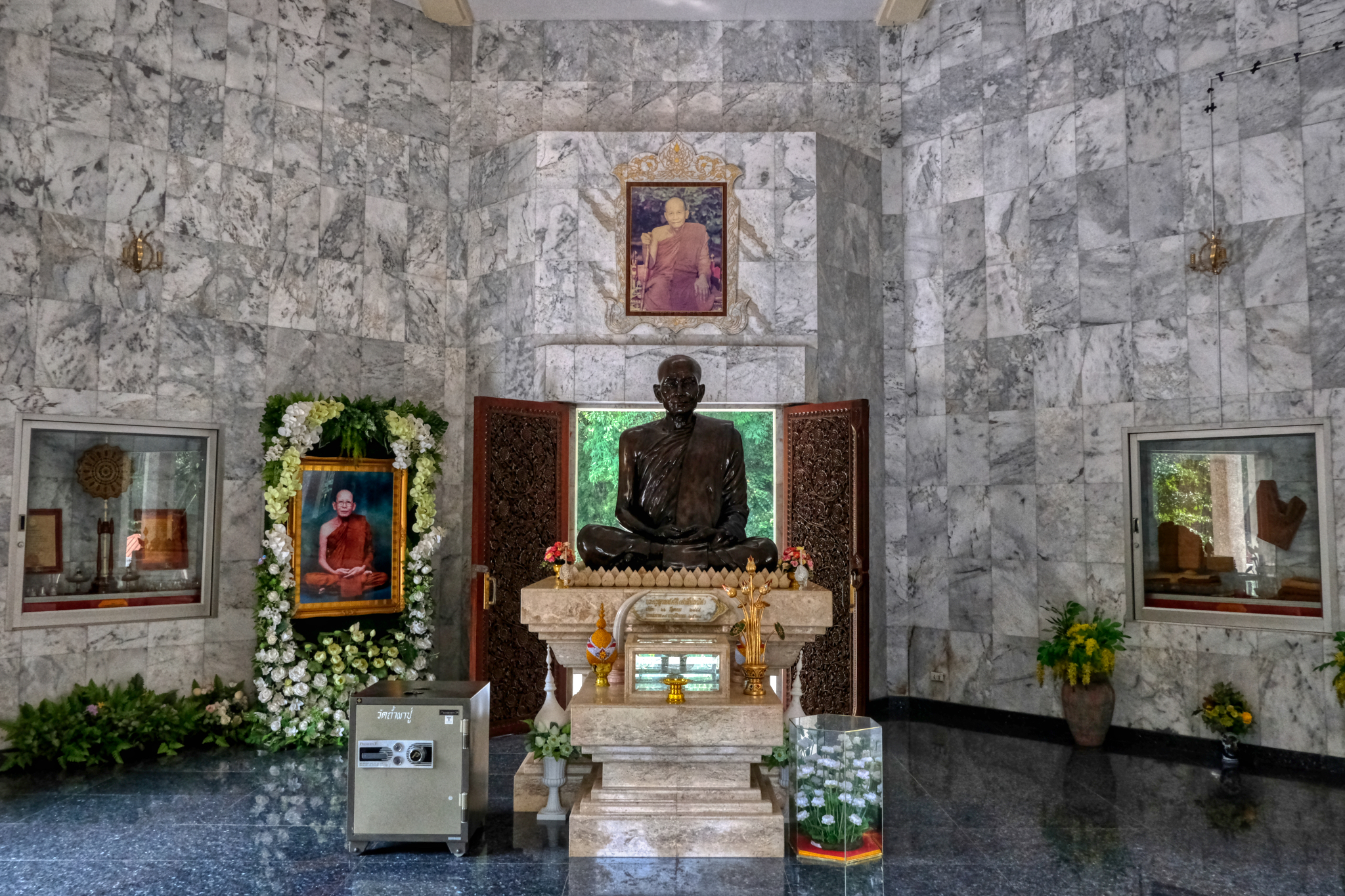 The marble temple was very interesting inside.
The marble temple was very interesting inside.
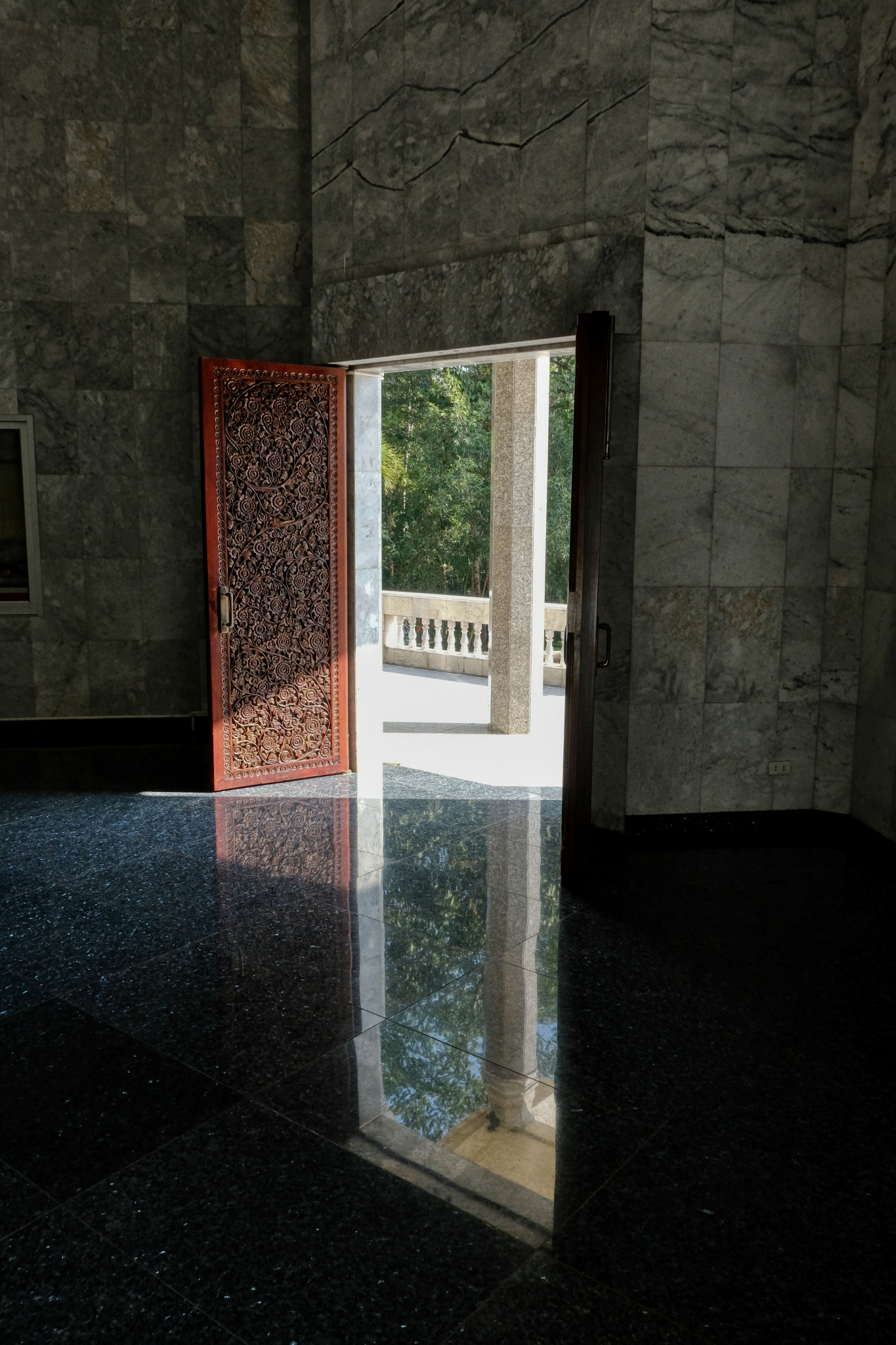 Marvelous light and reflection inside the marble wat.
Marvelous light and reflection inside the marble wat.
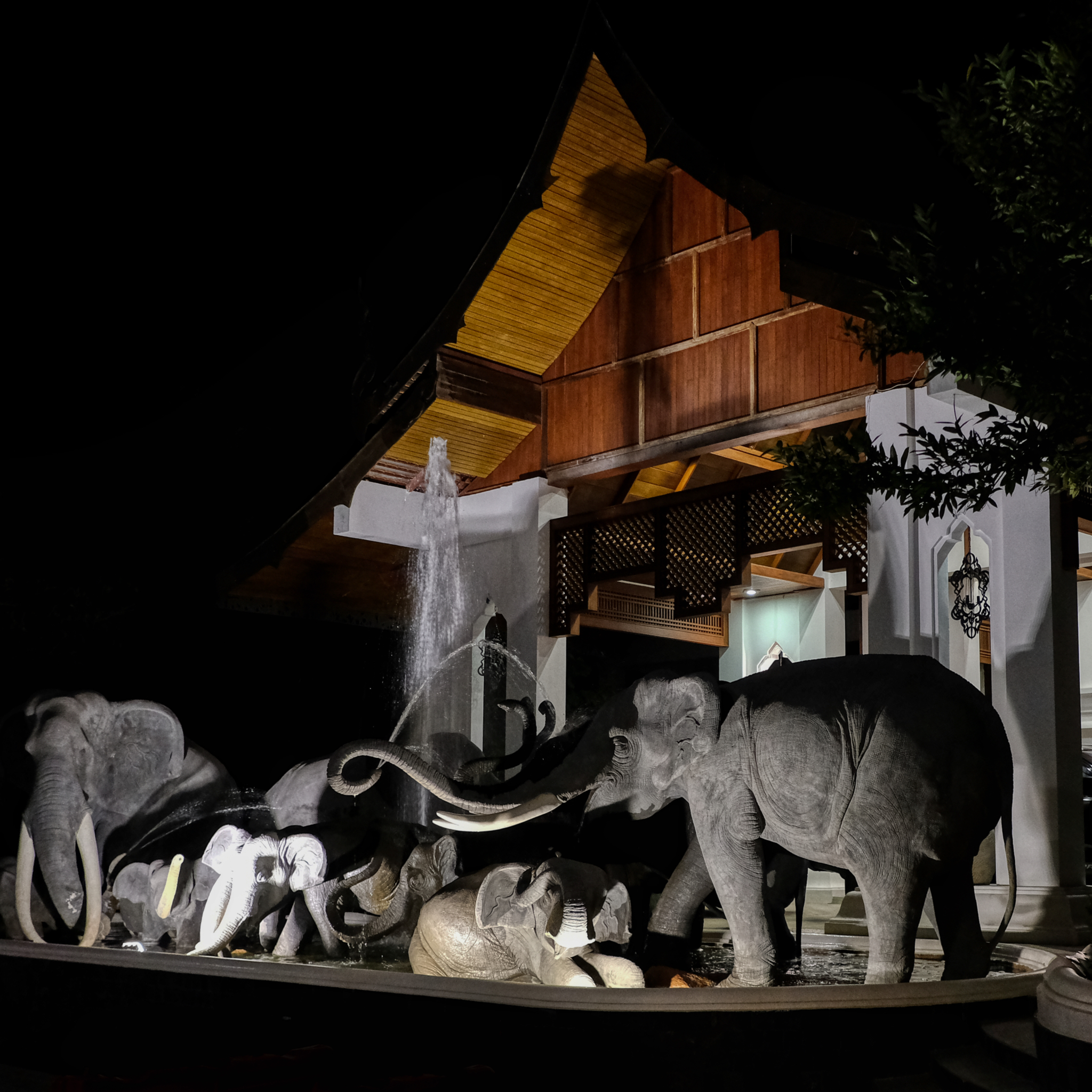 We found this marvelous restaurant for our dinner on the second night in Loei.
We found this marvelous restaurant for our dinner on the second night in Loei.
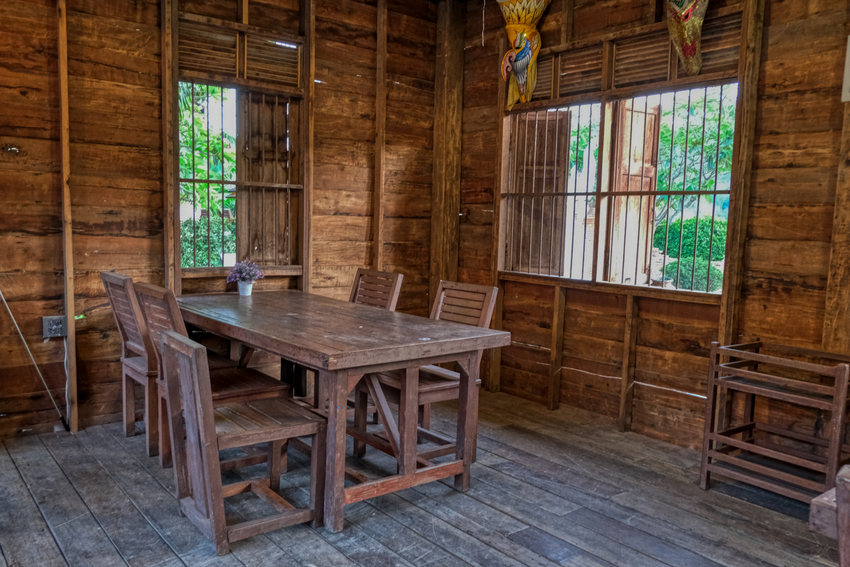 The "elephant restaurant' interior dining area.
The "elephant restaurant' interior dining area.
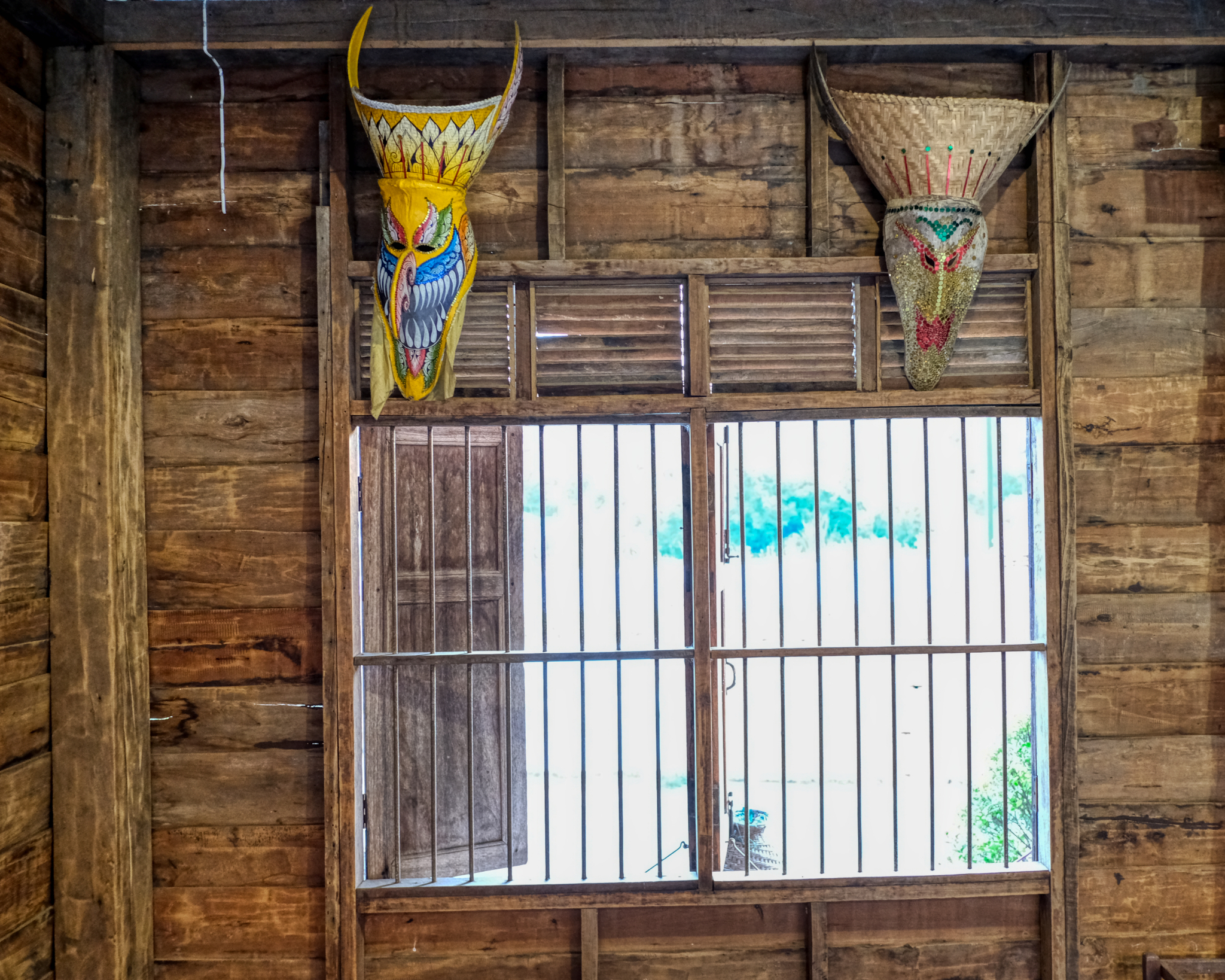 We had a fine meal in this old wooden room with traditional spirit masks hanging around.
We had a fine meal in this old wooden room with traditional spirit masks hanging around.
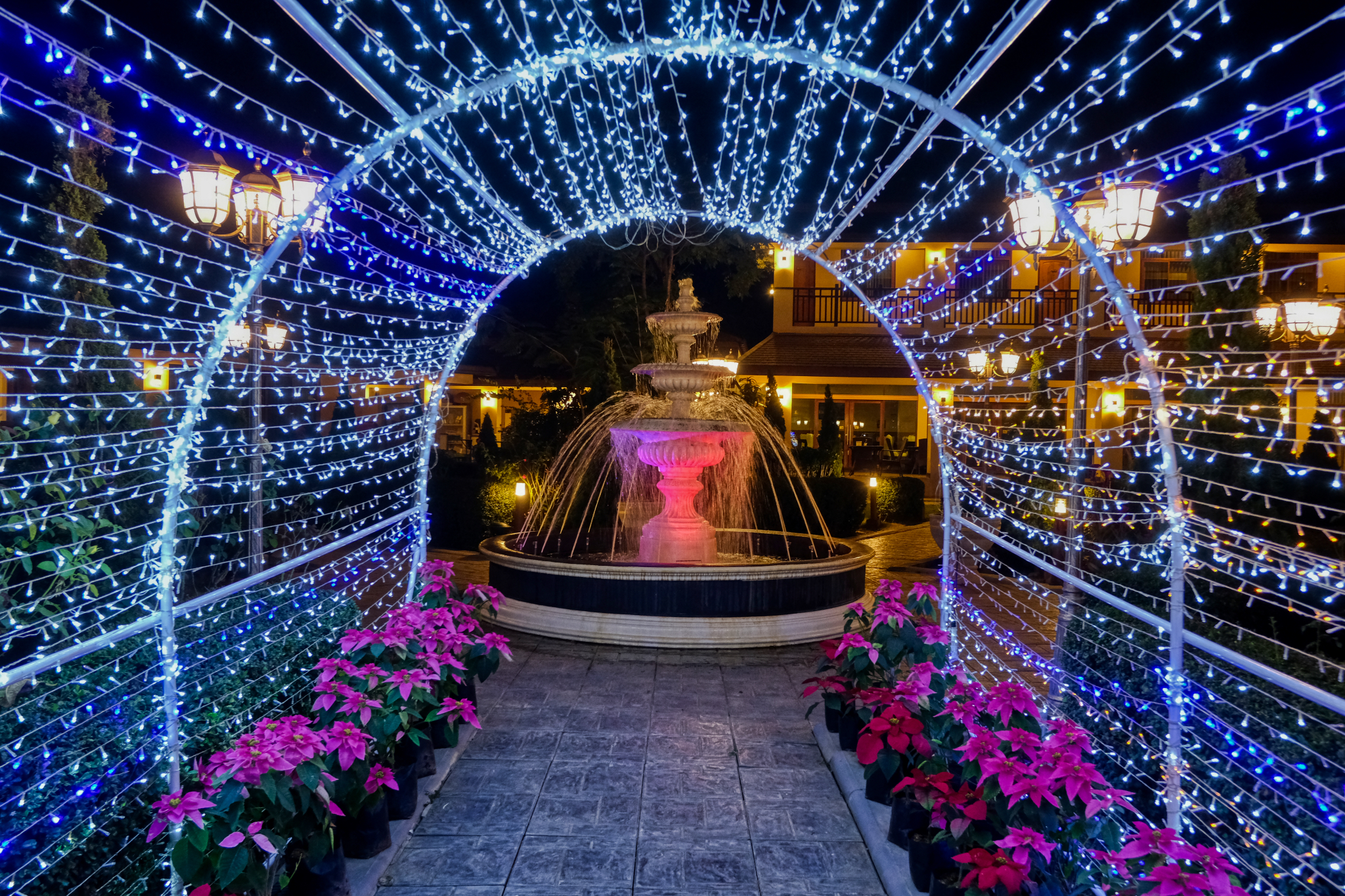 Back at our hotel . . . they had the grounds lit up like a carnival!!!
Back at our hotel . . . they had the grounds lit up like a carnival!!!
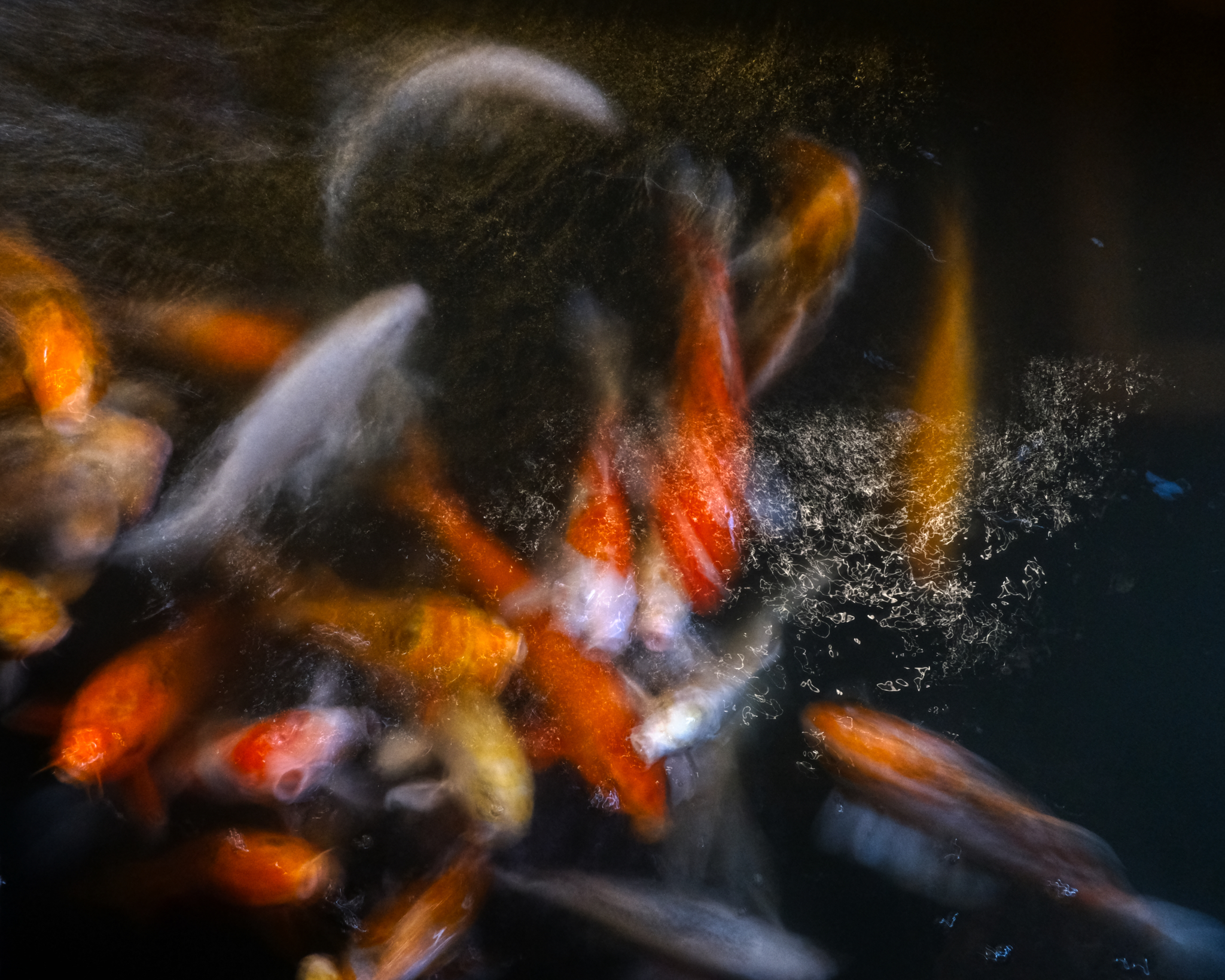 The next morning we said good-bye to Loei and hit the road for then short drive north to the town of Chiang Khan along the Mekong River.
The next morning we said good-bye to Loei and hit the road for then short drive north to the town of Chiang Khan along the Mekong River.
--------------------------------------------
CHIANG KHAN
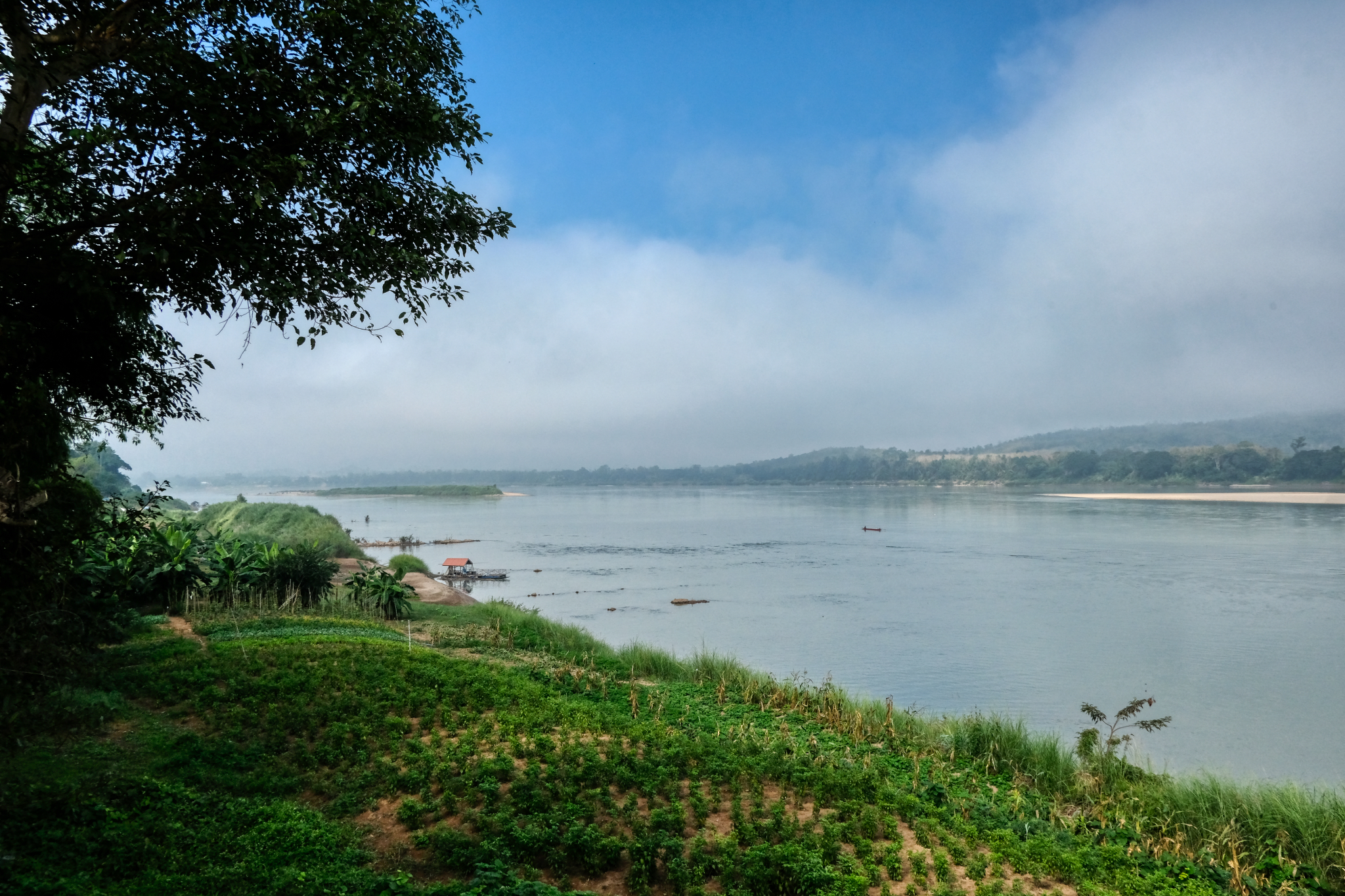 We stopped at a riverside resort as soon as we arrived at the river . . . and this was out first view of the mighty Mekong River.
We stopped at a riverside resort as soon as we arrived at the river . . . and this was out first view of the mighty Mekong River.
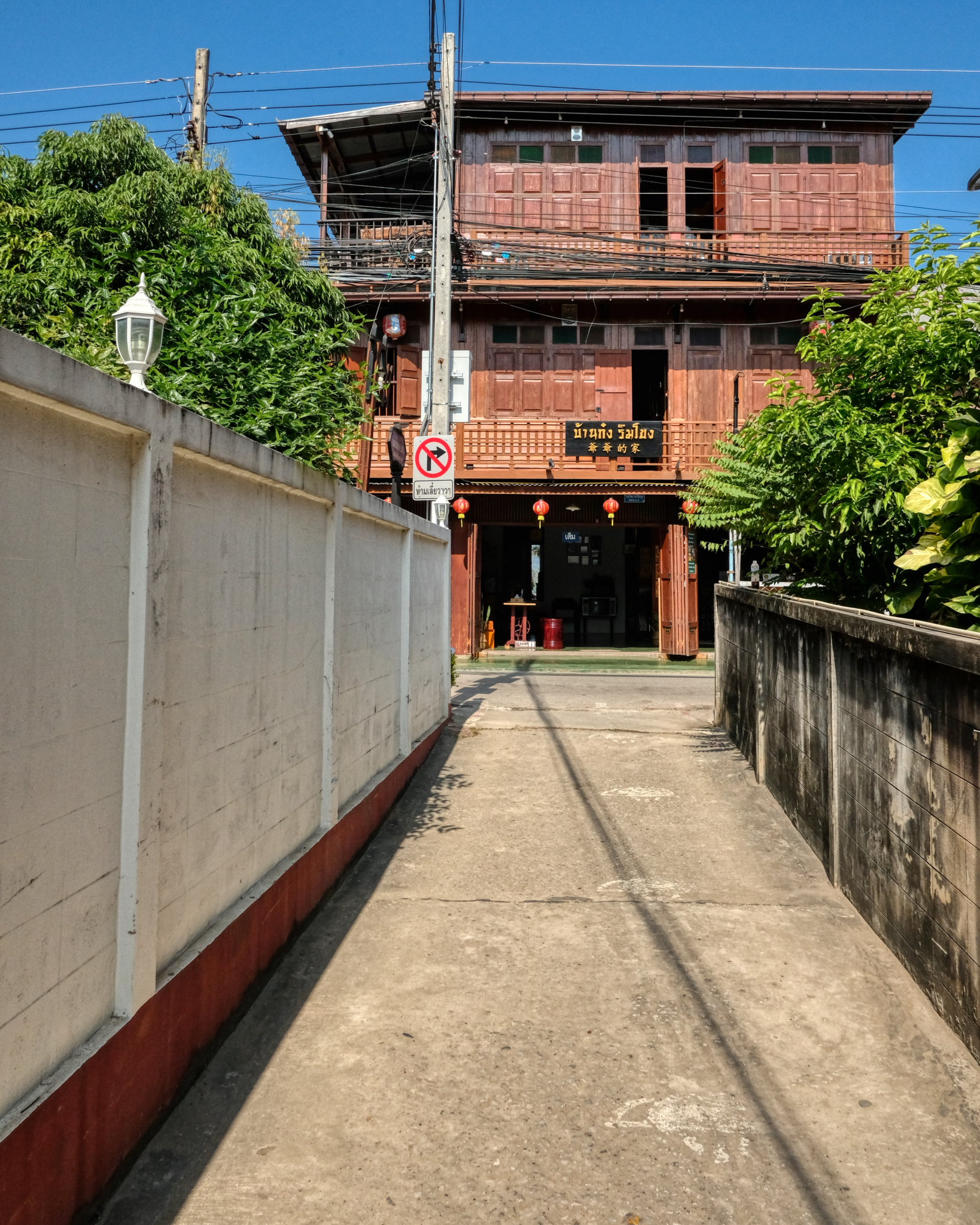 We quickly found our charming old wooden guest house.
We quickly found our charming old wooden guest house.
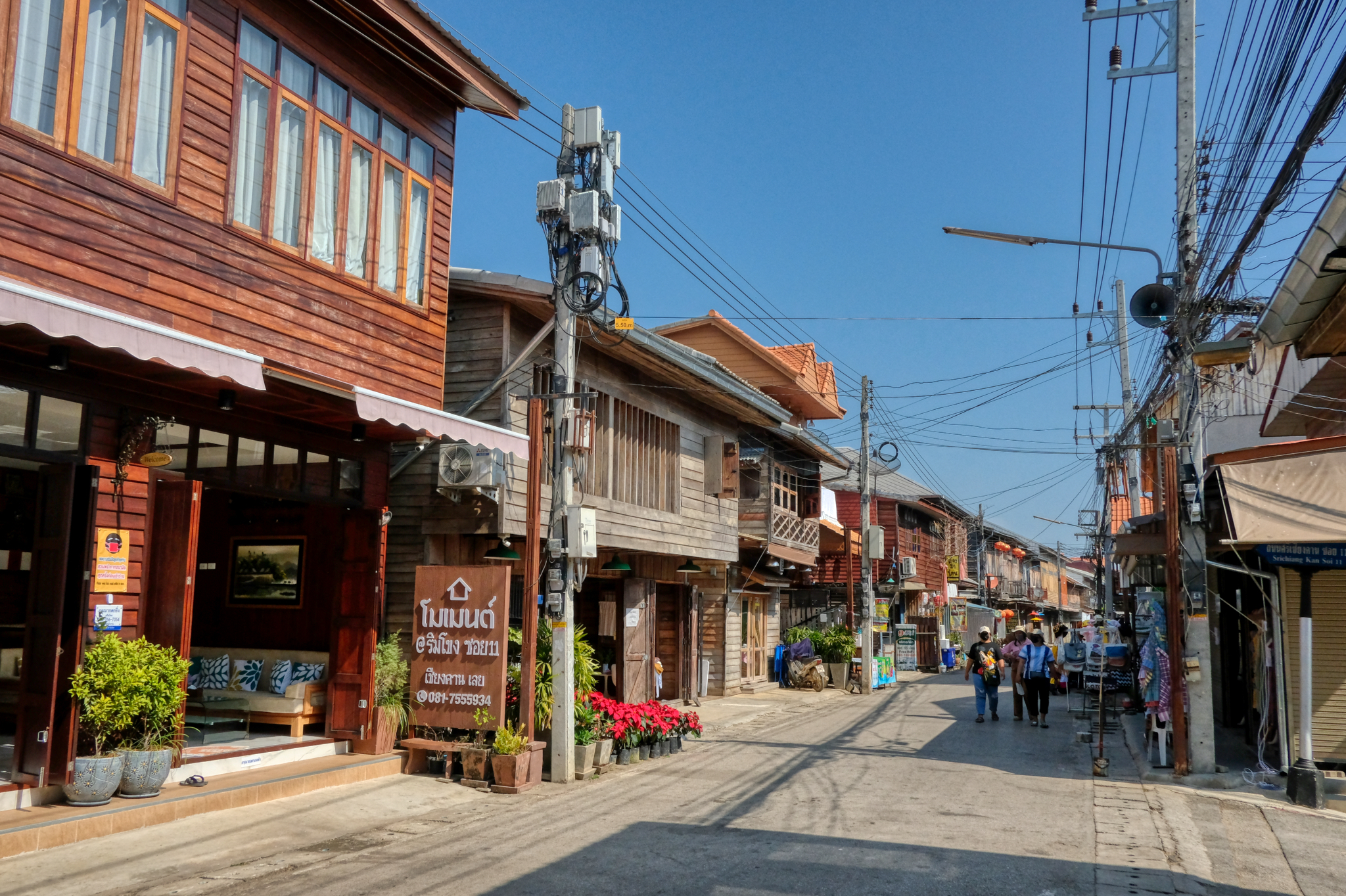 Our guest house was right on a kind of 'walking street' through the riverside village. The Mekong River is directly behind the row of houses and shops to the left.
Our guest house was right on a kind of 'walking street' through the riverside village. The Mekong River is directly behind the row of houses and shops to the left.
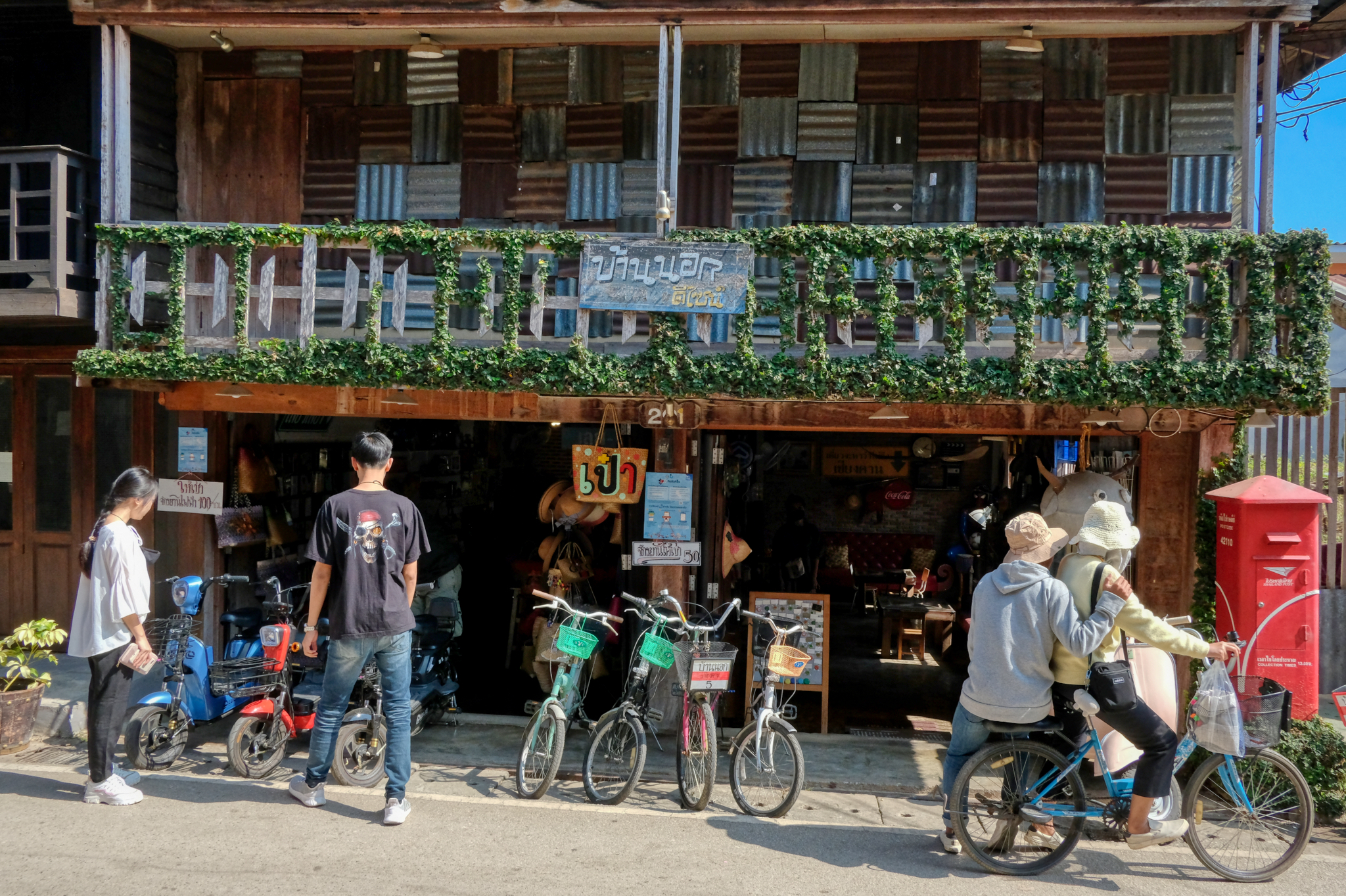 Chiang Khan is a lovely and funky old Thai town with interesting shops and bike rentals.
Chiang Khan is a lovely and funky old Thai town with interesting shops and bike rentals.
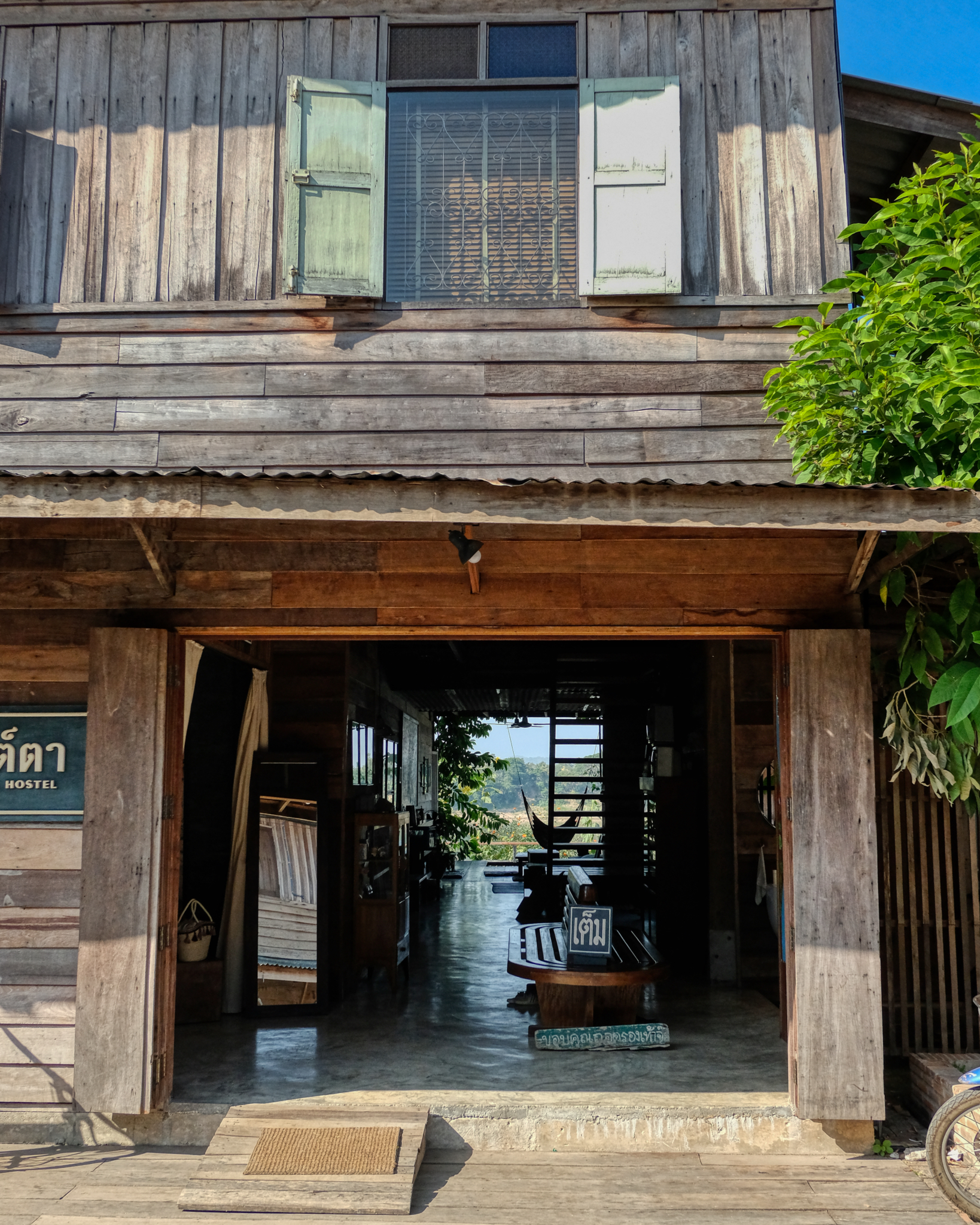 With both front and rear doors open, you can look right through this hostel to the river behind it.
With both front and rear doors open, you can look right through this hostel to the river behind it.
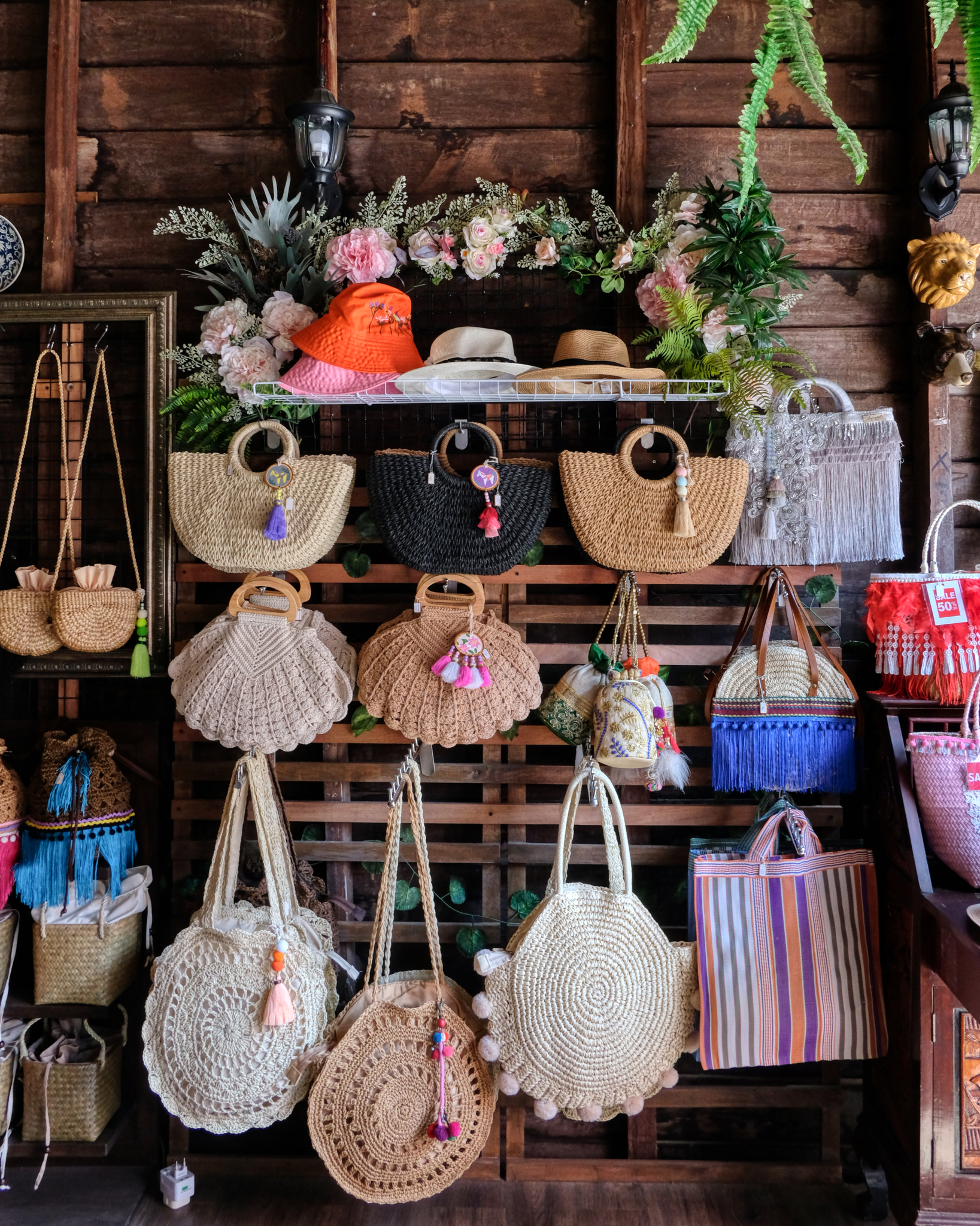 The many shops lining the walking street had ample supplies of local handicrafts to meet the tourist demand.
The many shops lining the walking street had ample supplies of local handicrafts to meet the tourist demand.
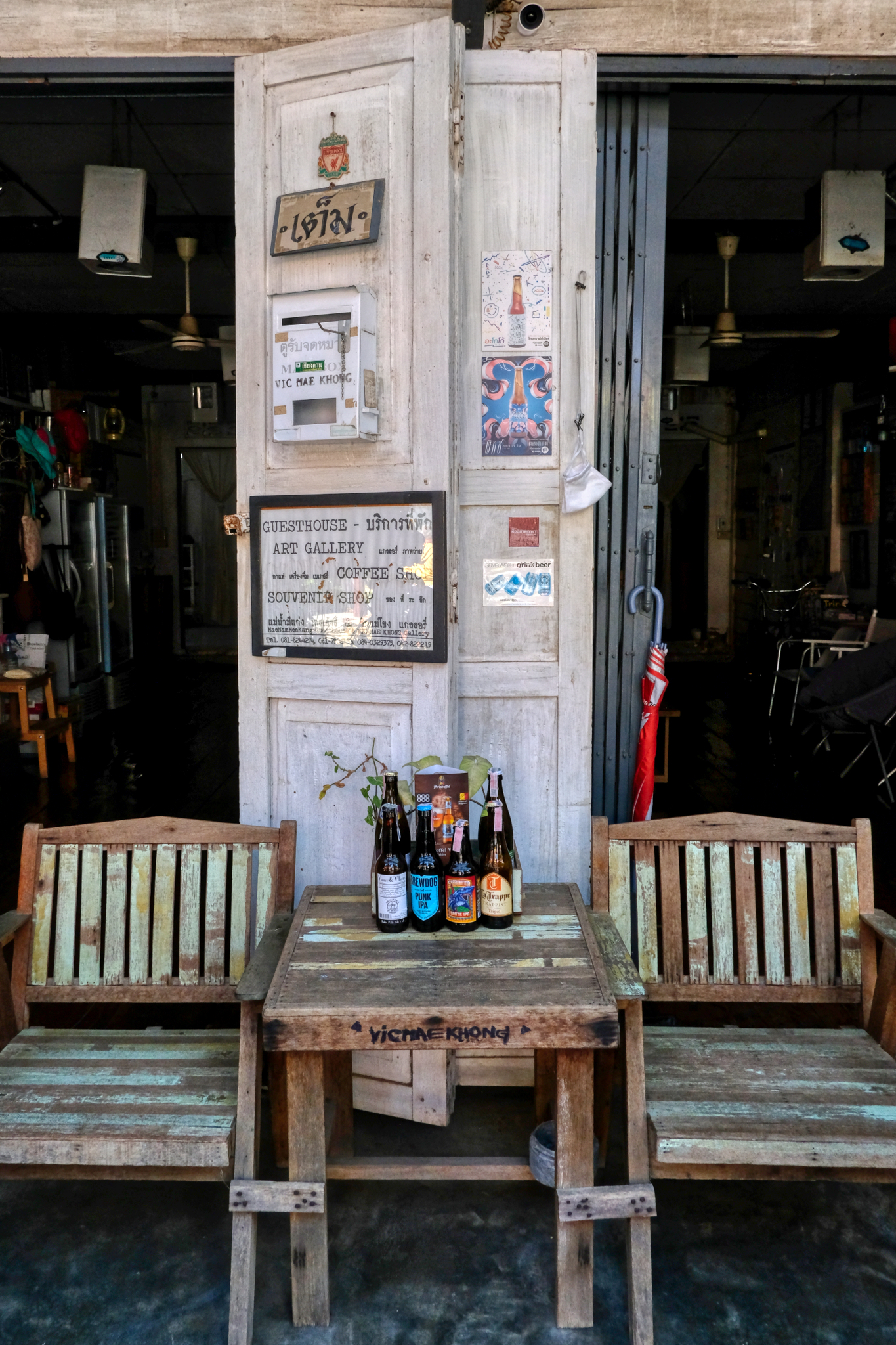 A guest house with street side 'beer chairs' . . . perfect for people watching. I couldn't help but notice the Brew Dog Punk IPA bottle . . . from Aberdeen, Scotland, my former residence.
A guest house with street side 'beer chairs' . . . perfect for people watching. I couldn't help but notice the Brew Dog Punk IPA bottle . . . from Aberdeen, Scotland, my former residence.
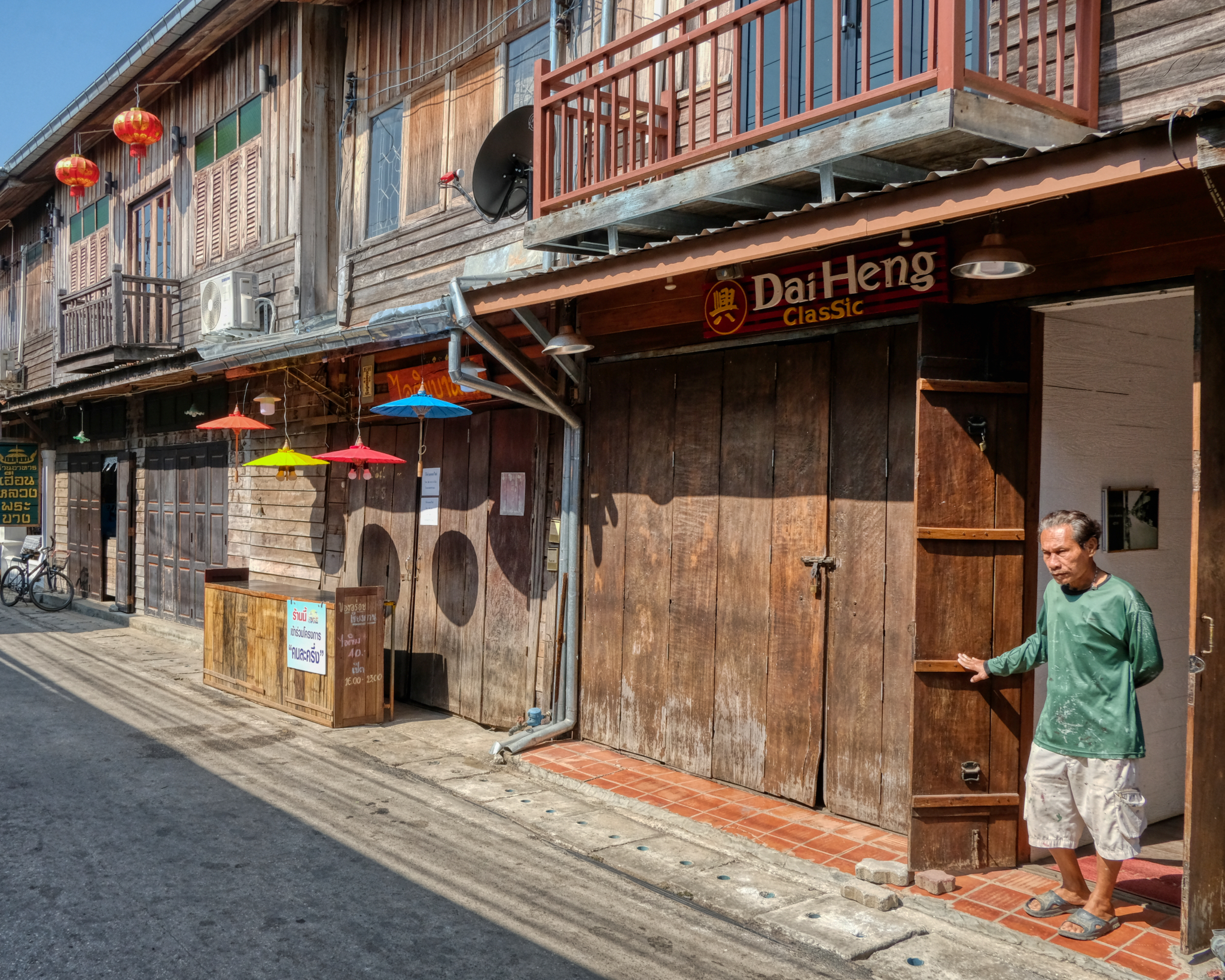 Such an interesting and photogenic little town.
Such an interesting and photogenic little town.
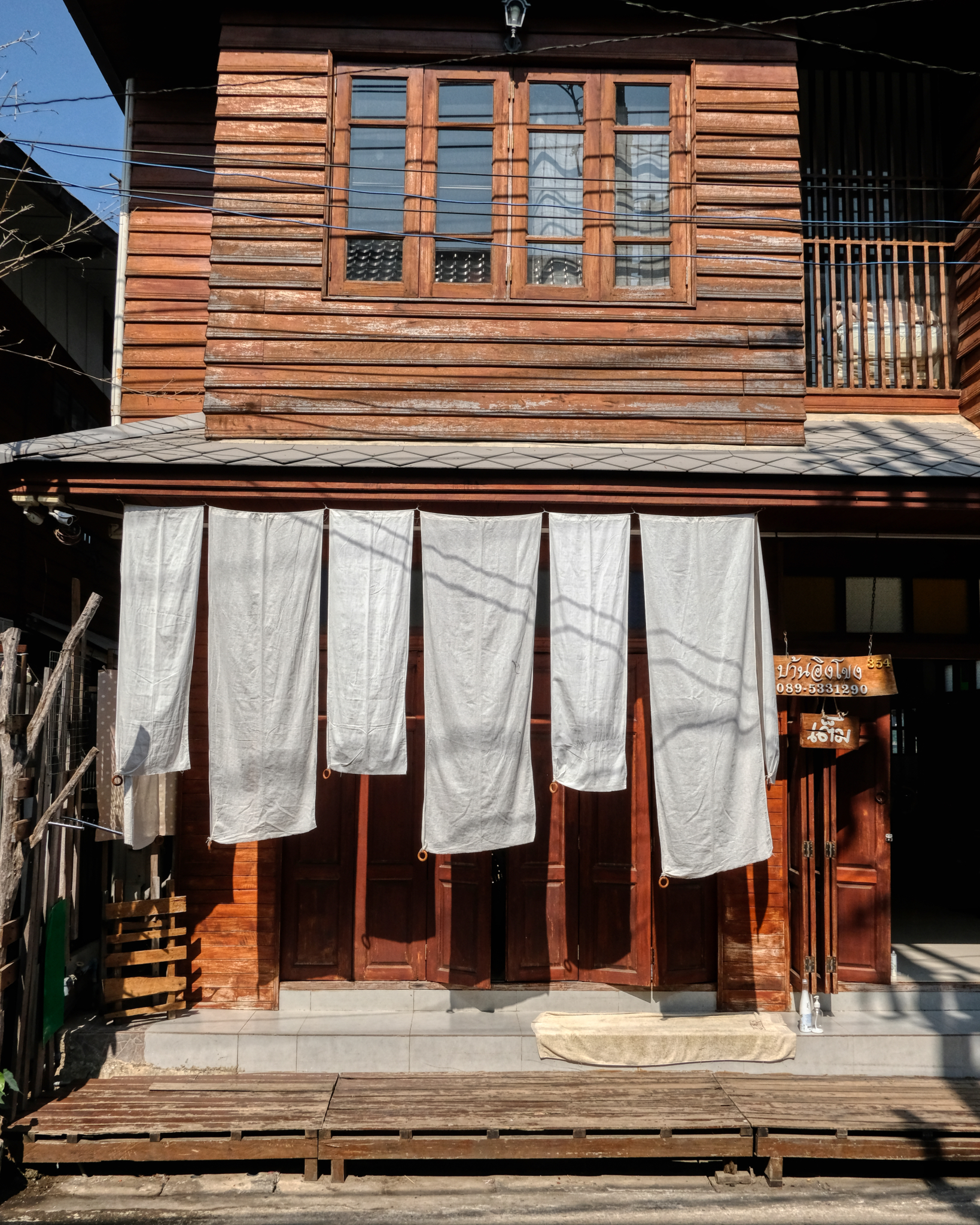 Some shops hung fabric against the harsh afternoon sun.
Some shops hung fabric against the harsh afternoon sun.
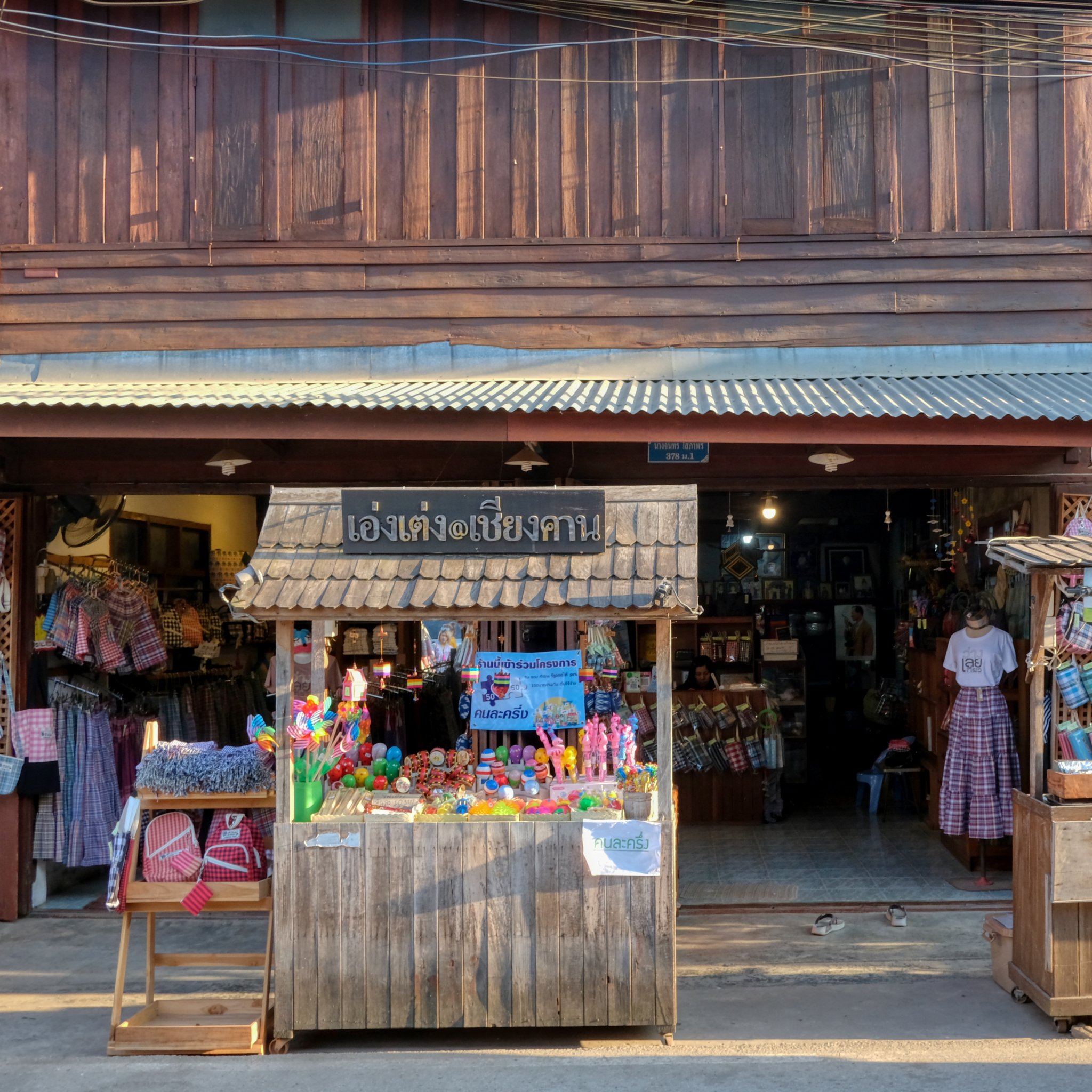 Each shop-front seems to have its own personality, and the photographs are like portraits.
Each shop-front seems to have its own personality, and the photographs are like portraits.
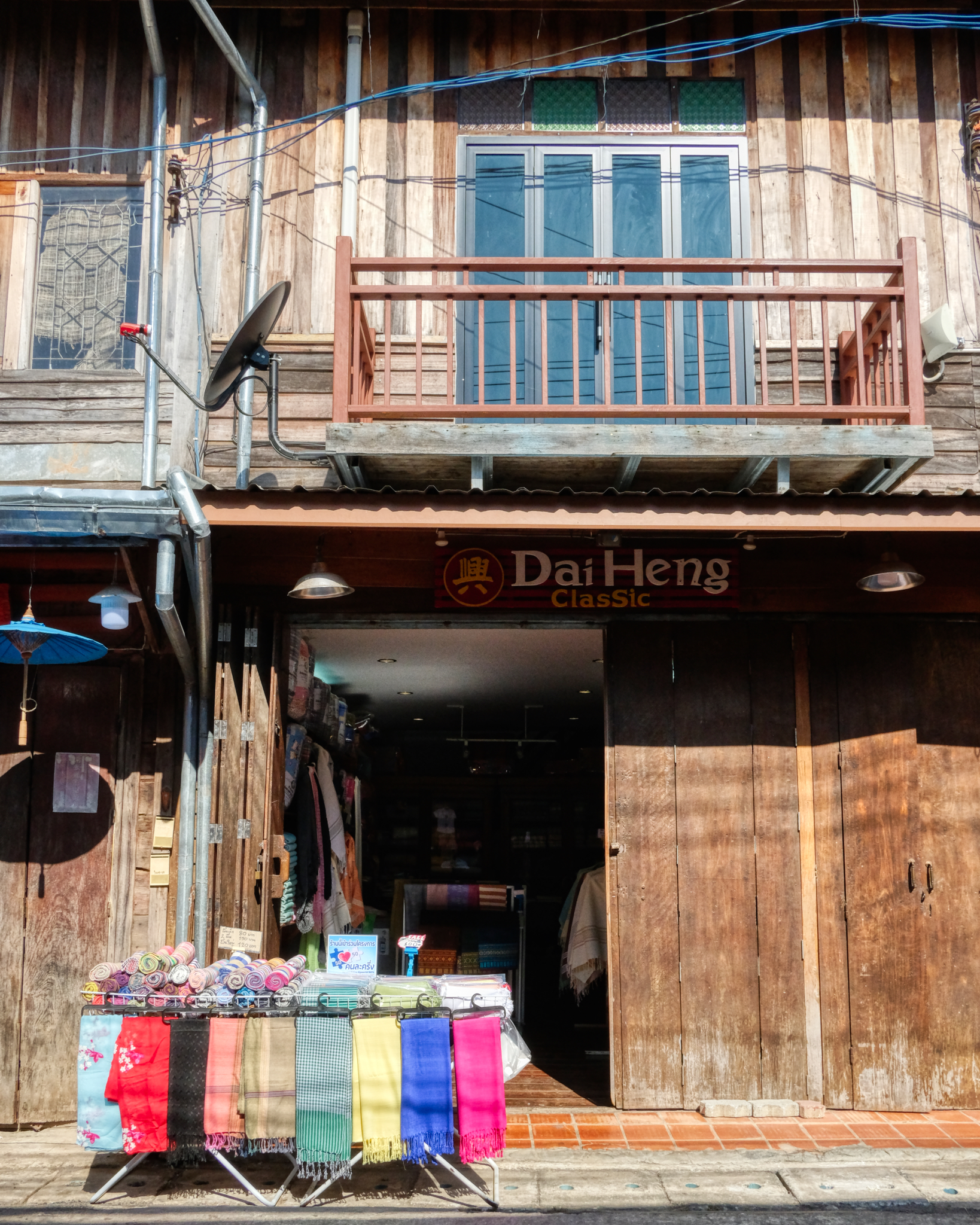 Beautiful local, high quality traditional textiles.
Beautiful local, high quality traditional textiles.
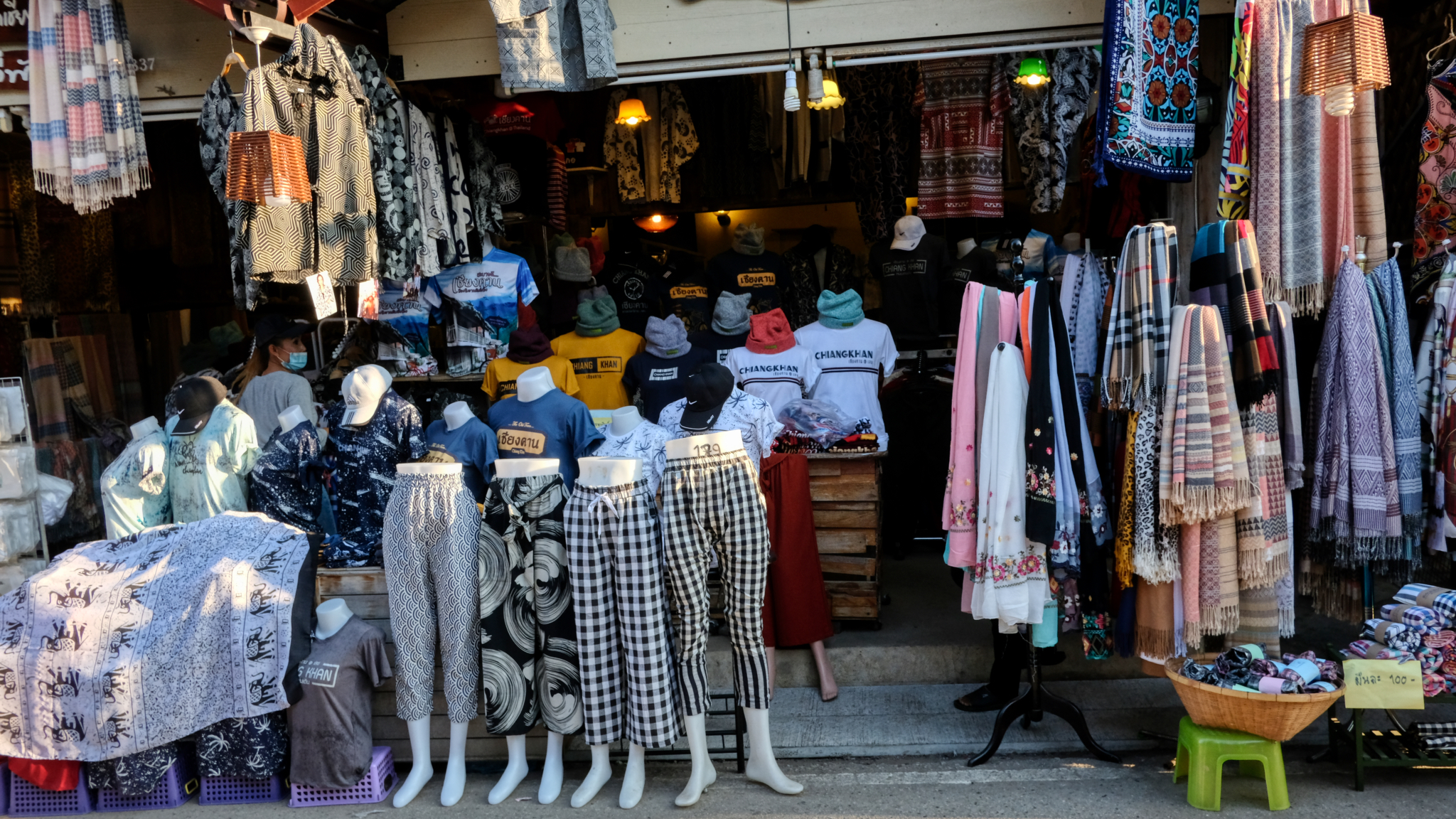 There were also many shops selling the usual array of souvenir 'touristwear.'
There were also many shops selling the usual array of souvenir 'touristwear.'
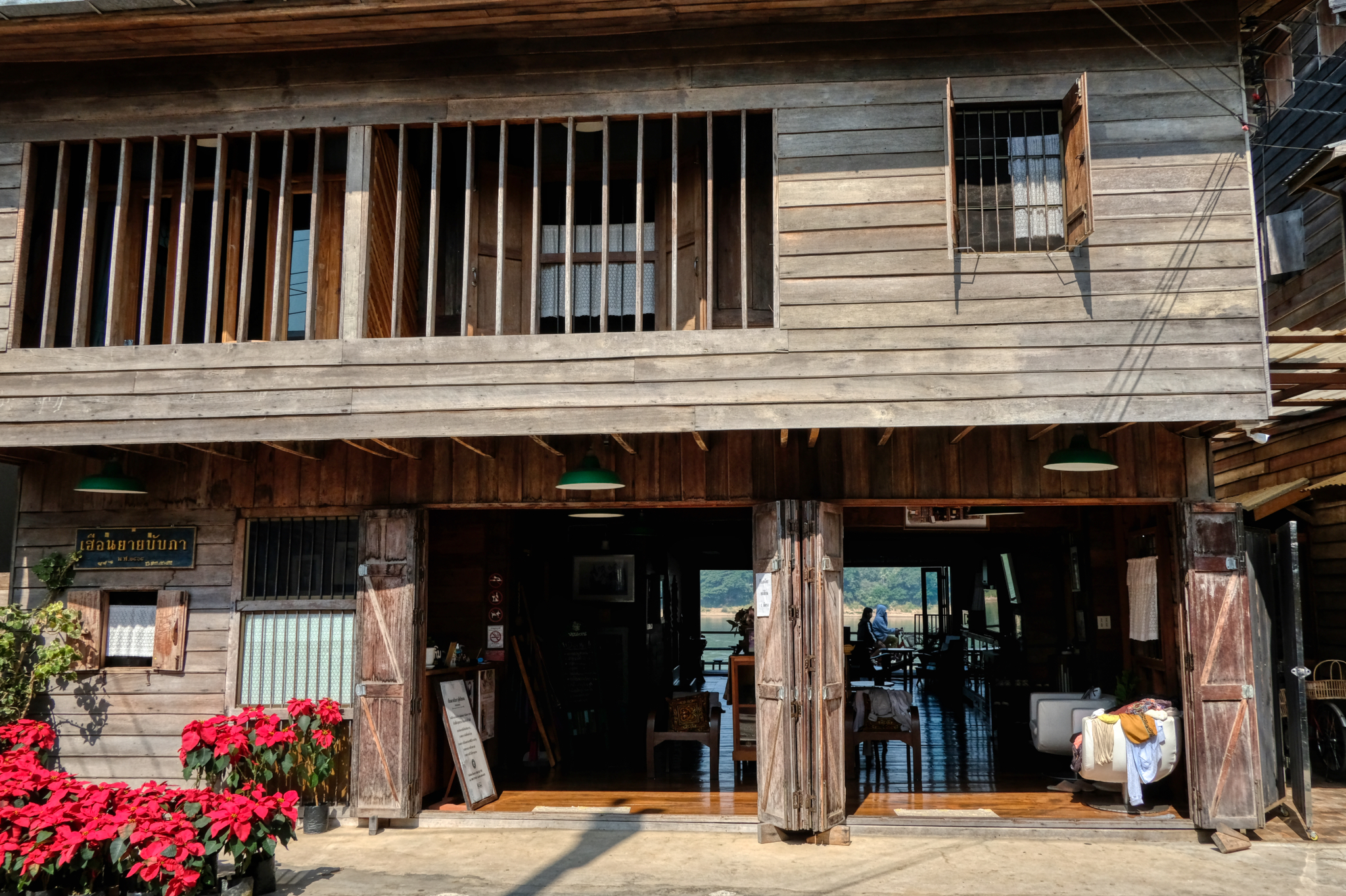 There is no shortage of restaurants and places to buy good, expensive coffee.
There is no shortage of restaurants and places to buy good, expensive coffee.
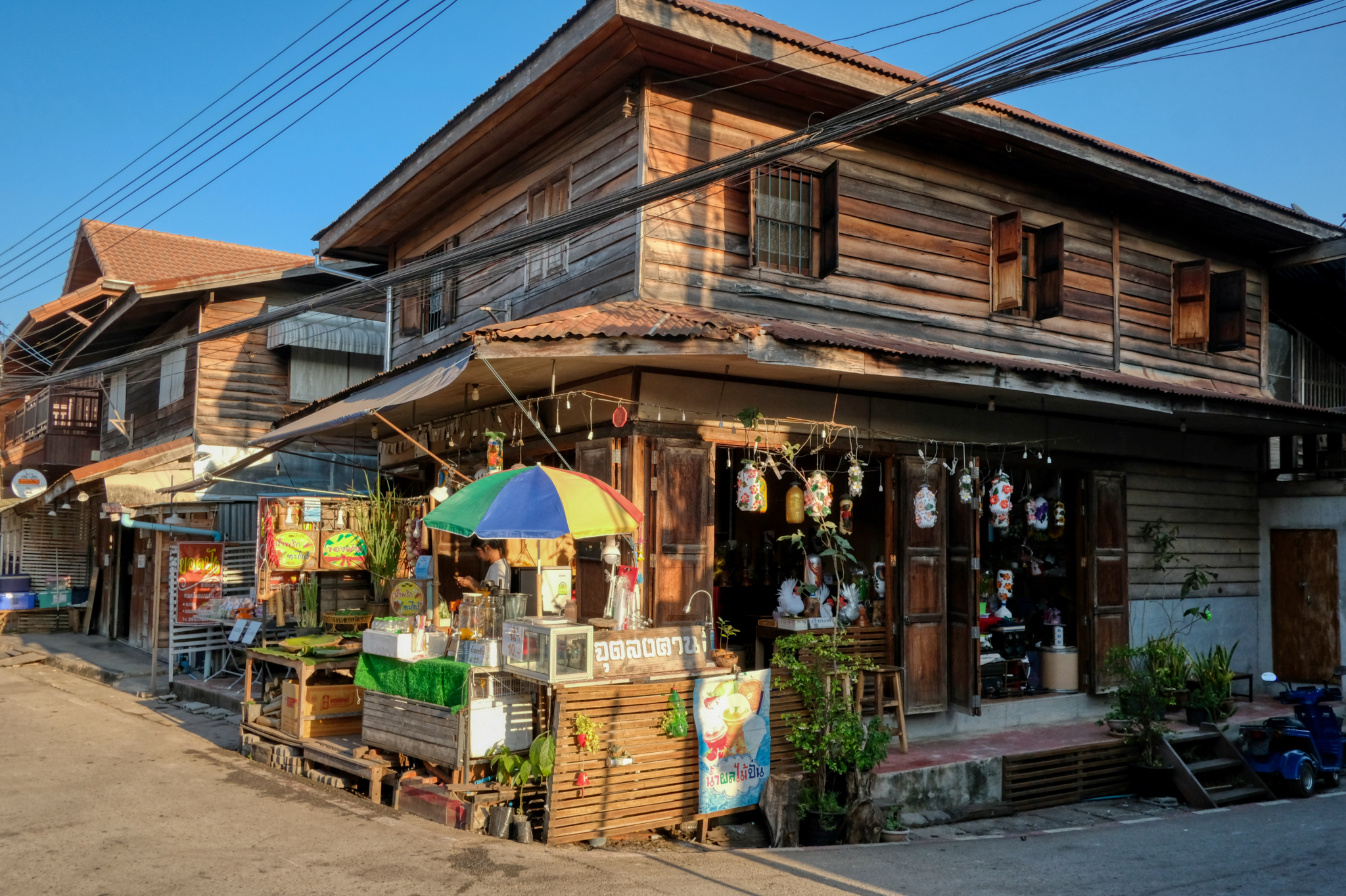 I love photographing these old wooden shops . . . anywhere in the world . . . but Chiang Khan had hundreds of them, and all with amazing shapes, features, colors, and textures.
I love photographing these old wooden shops . . . anywhere in the world . . . but Chiang Khan had hundreds of them, and all with amazing shapes, features, colors, and textures.
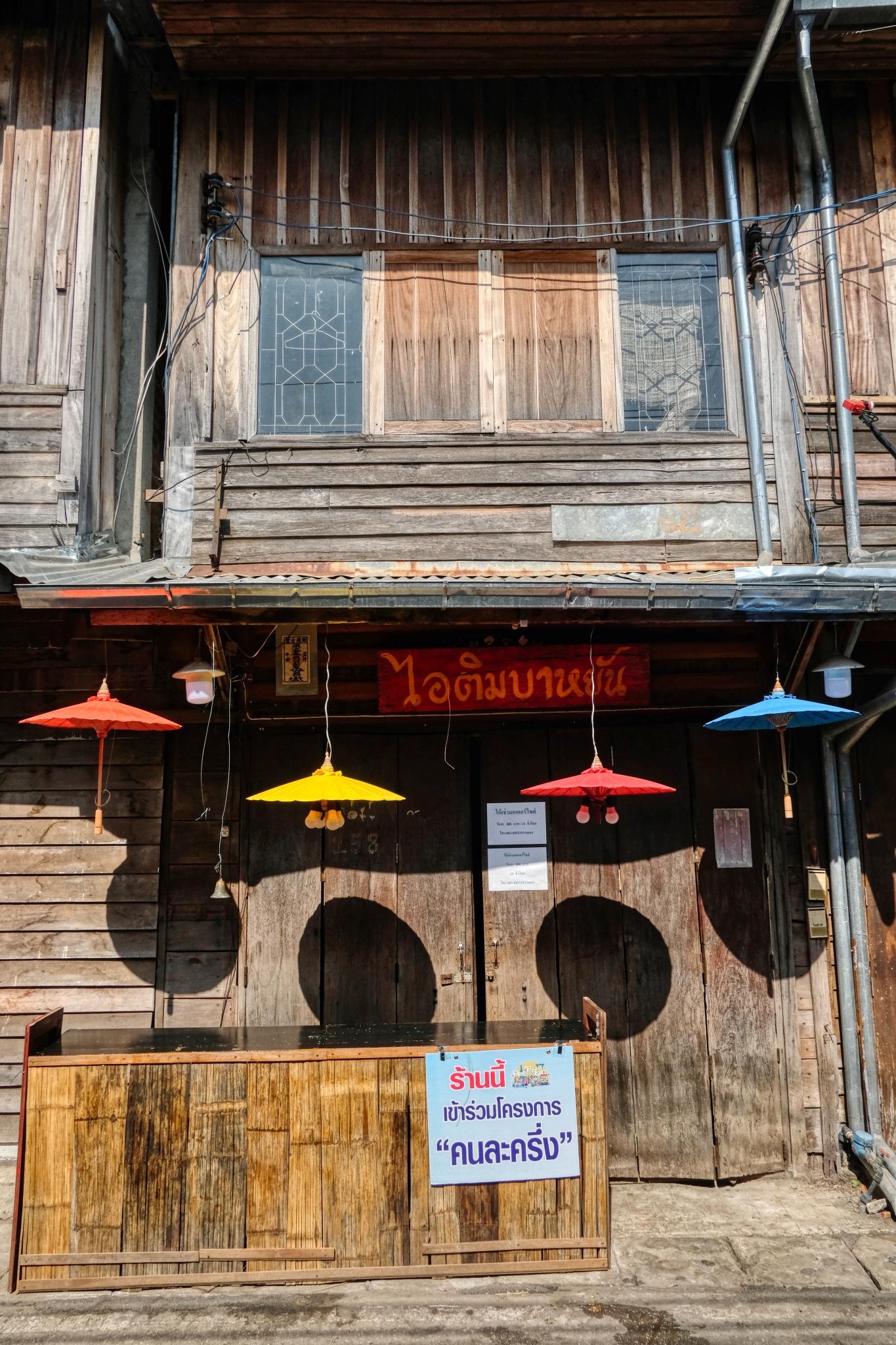 A beautiful shop-front portrait. The harsh afternoon sunlight actually enhances this photo by accentuating the wood grain and colors.
A beautiful shop-front portrait. The harsh afternoon sunlight actually enhances this photo by accentuating the wood grain and colors.
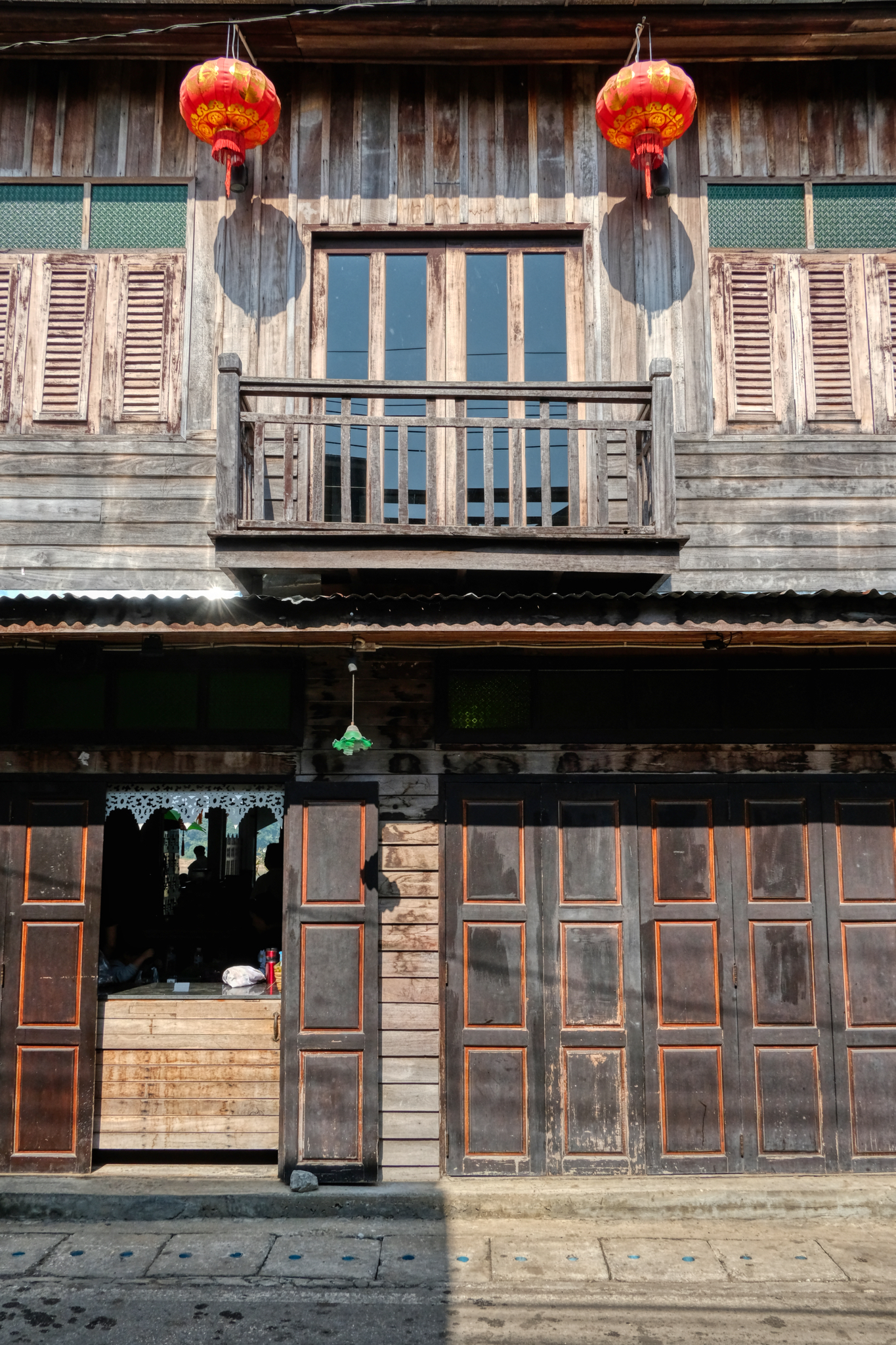 Another fabulous paneled storefront with Chinese lanterns. Lovely.
Another fabulous paneled storefront with Chinese lanterns. Lovely.
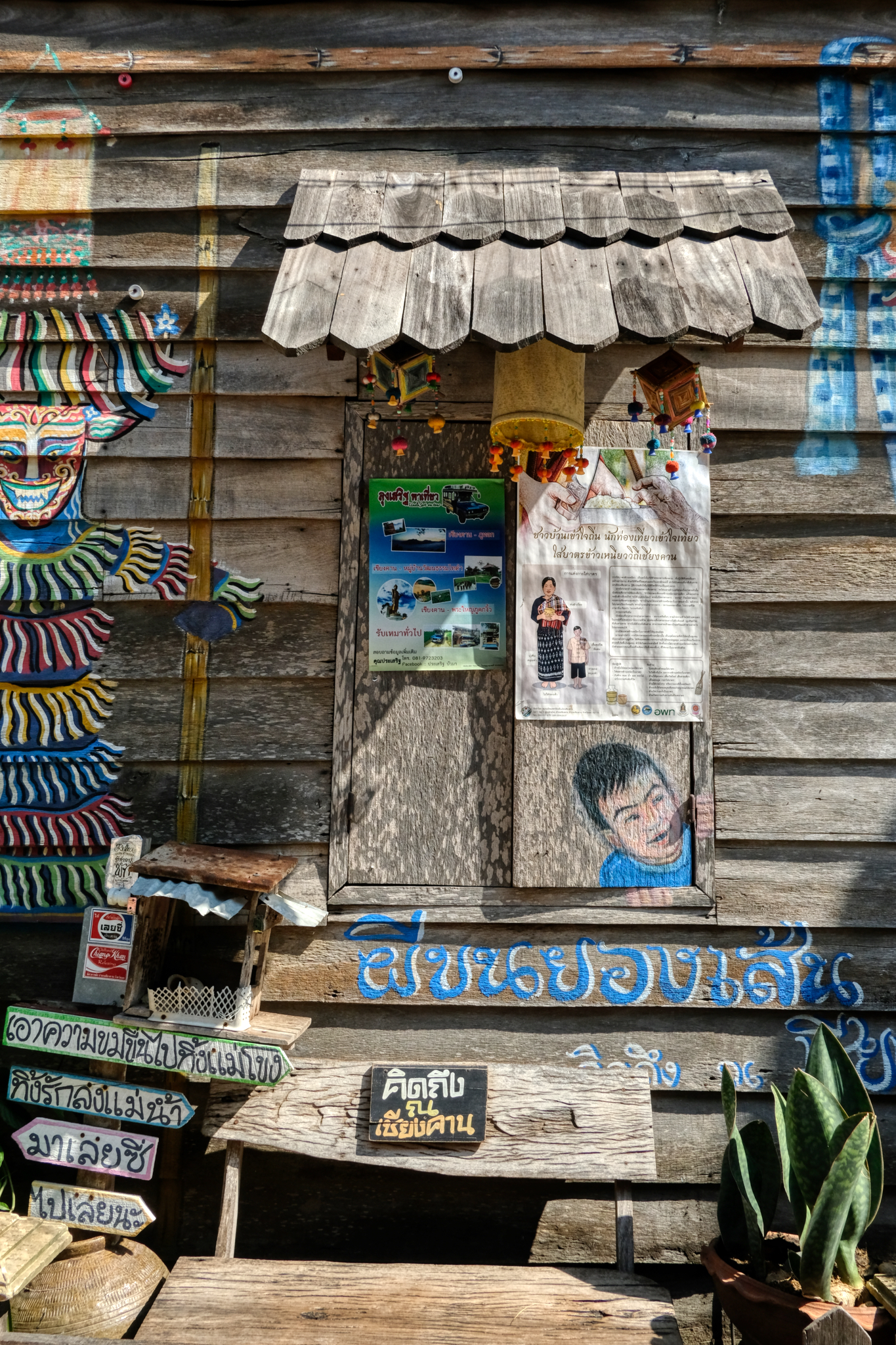 Just so much to see, notice, and photograph in this sweet little riverside town.
Just so much to see, notice, and photograph in this sweet little riverside town.
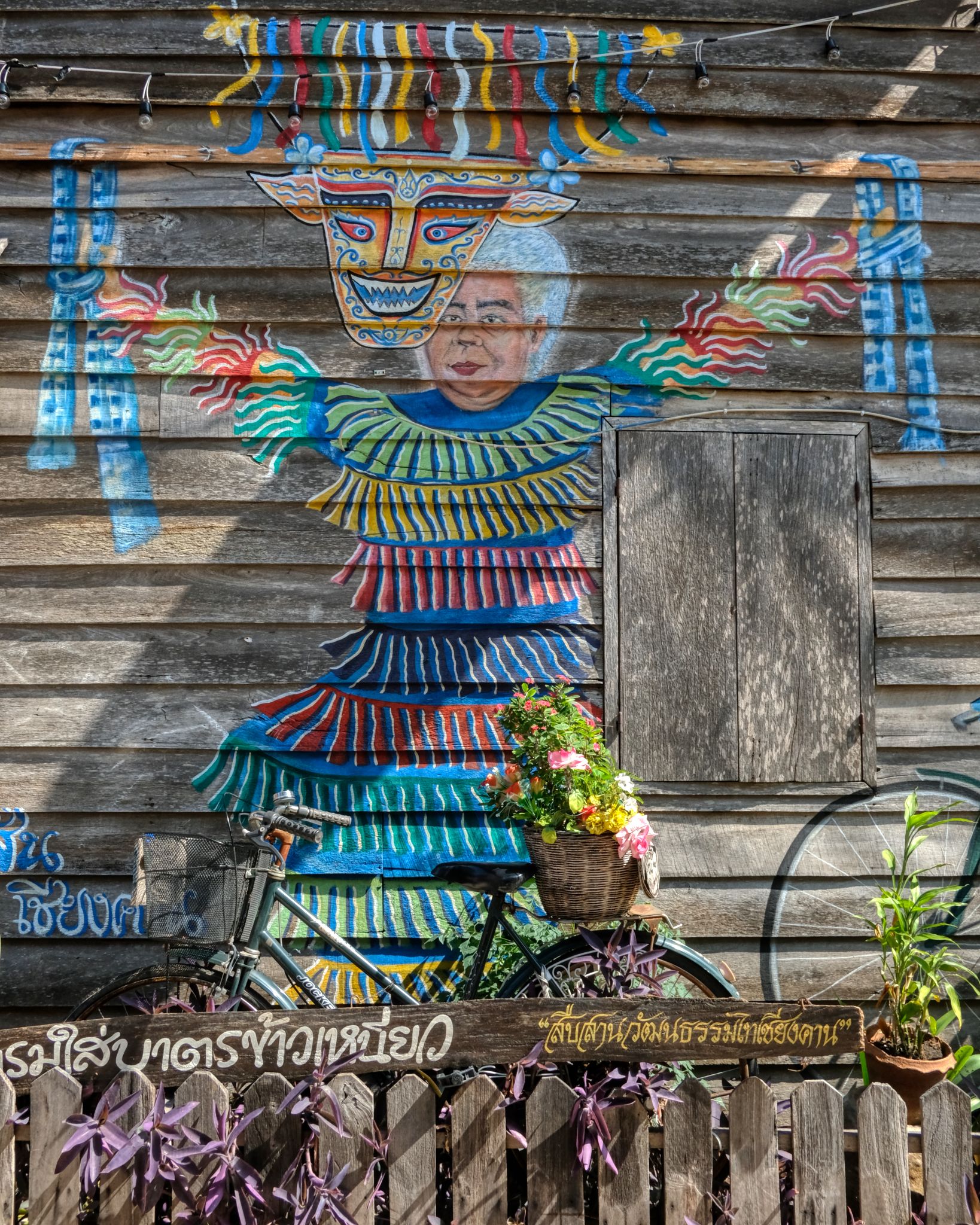 There was also some very nice chalk public art here and there.
There was also some very nice chalk public art here and there.
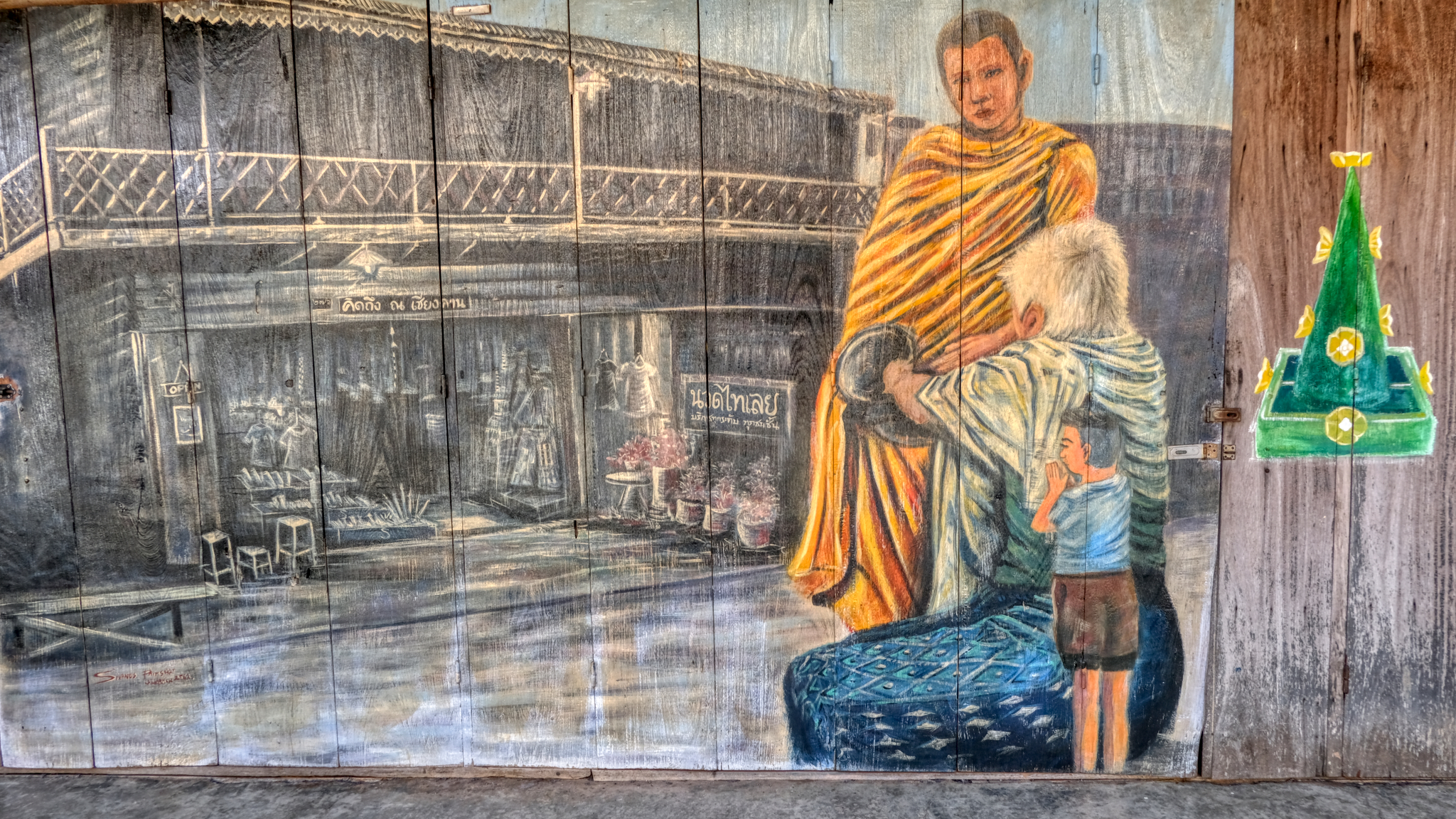 Sweet chalk street art.
Sweet chalk street art.
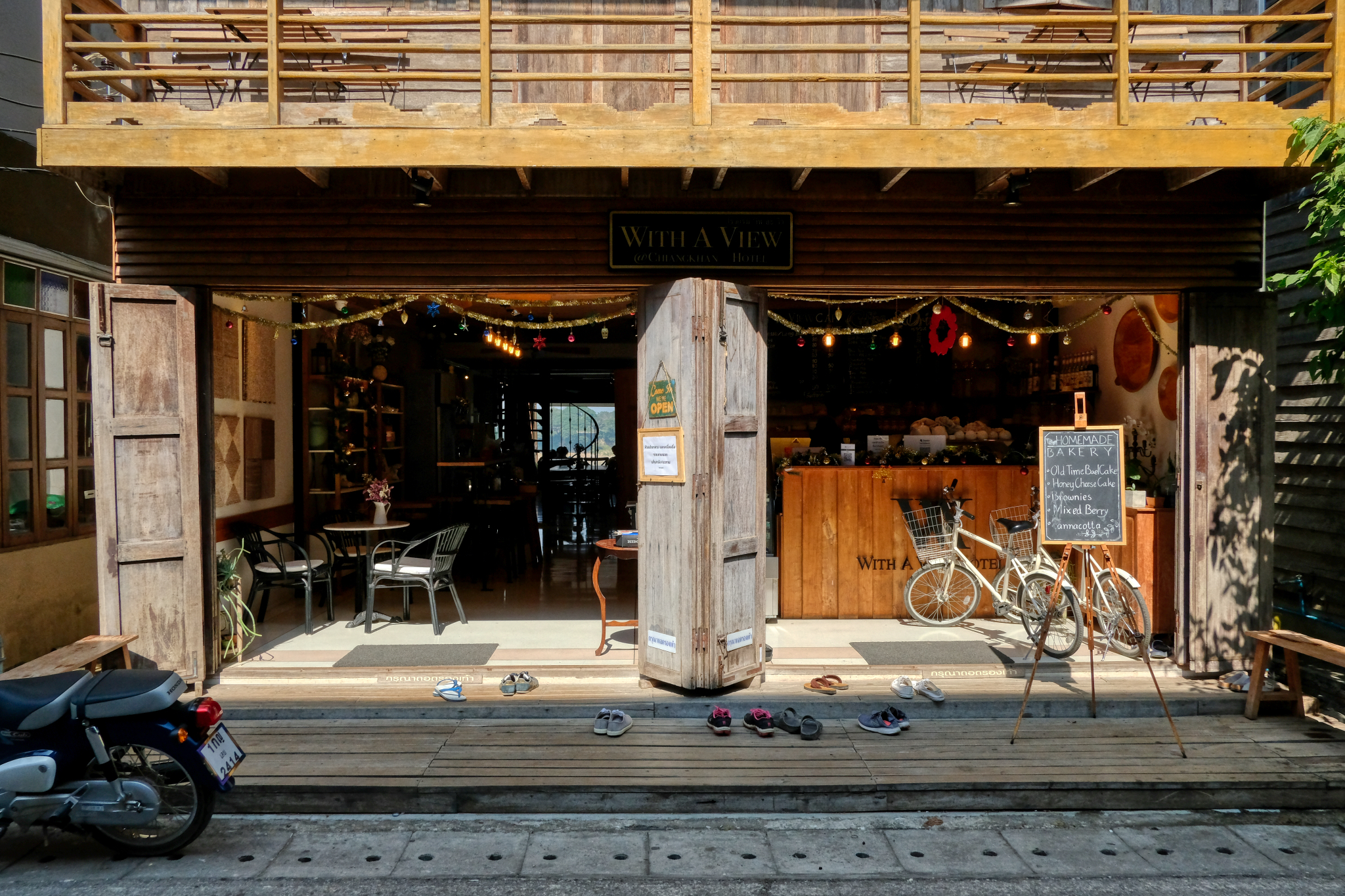 A very inviting bakery . . . delicious too!
A very inviting bakery . . . delicious too!
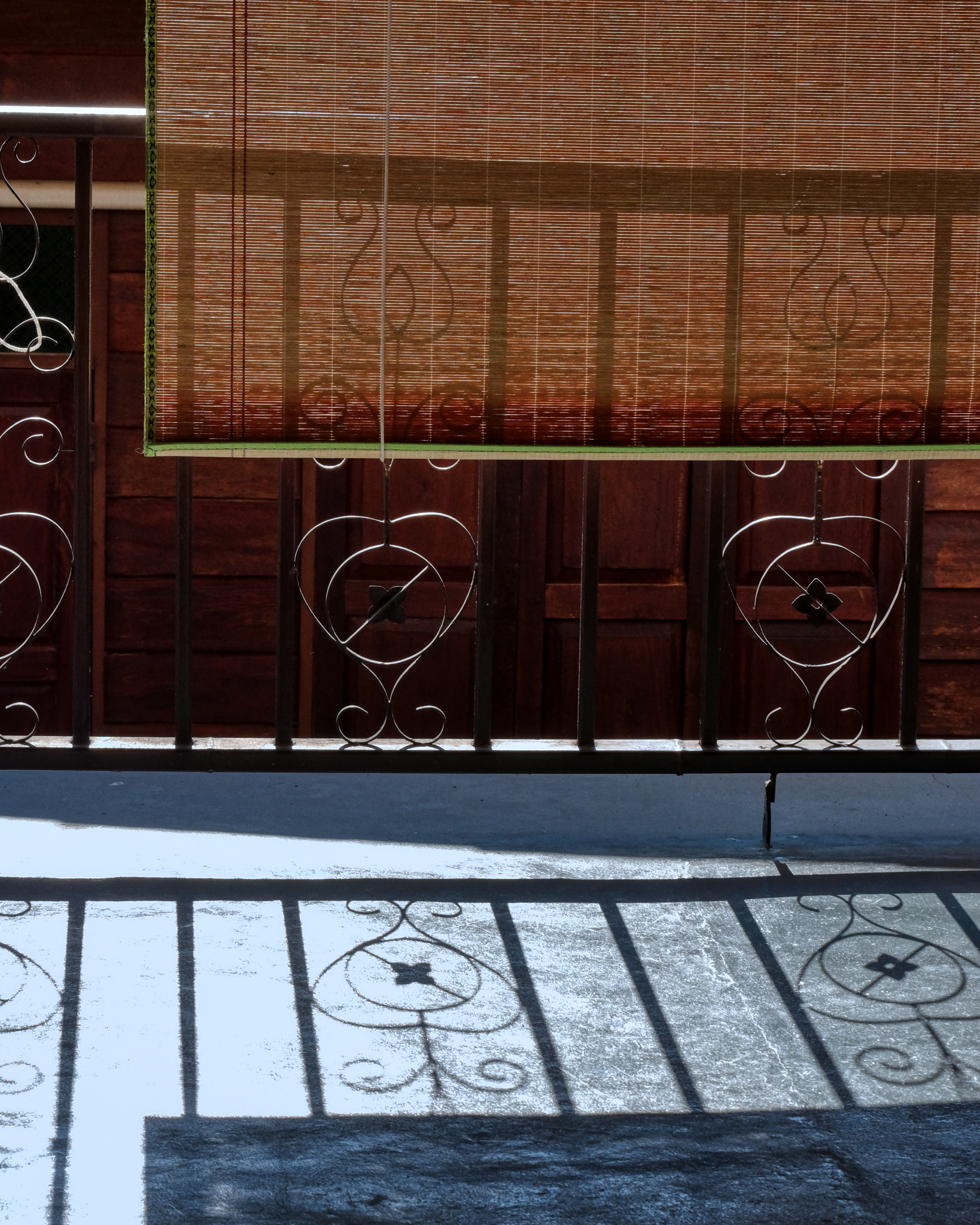 Thai aesthetics are always fascinating and gorgeous. It's all in the details. Here, a detail of the interior of our guesthouse.
Thai aesthetics are always fascinating and gorgeous. It's all in the details. Here, a detail of the interior of our guesthouse.
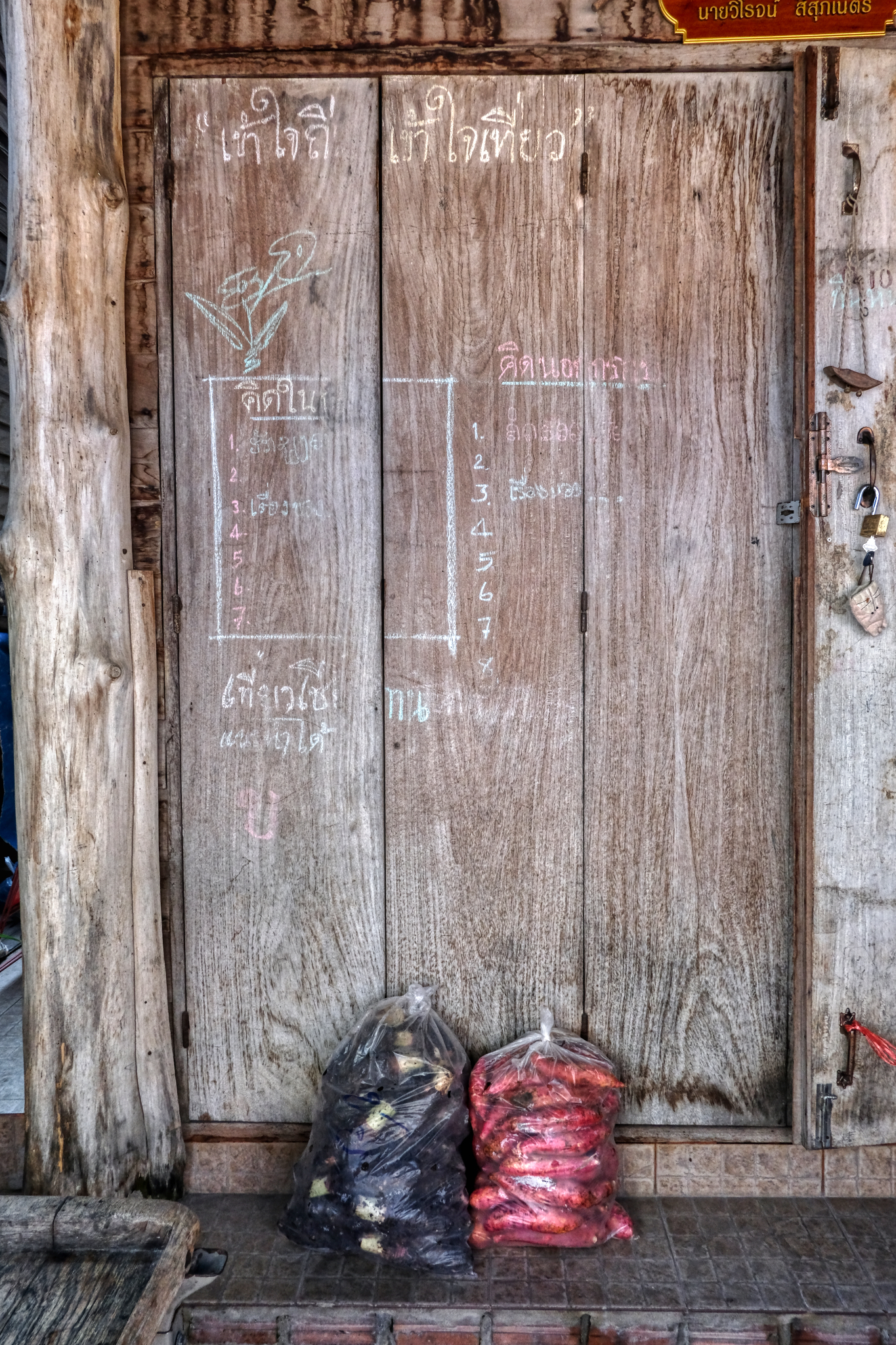 When walking around such these richly aesthetic places with a camera in hand, I am prone to take these kinds of "still life" photographs: pleasing arrangements of objects in fascinating light.
When walking around such these richly aesthetic places with a camera in hand, I am prone to take these kinds of "still life" photographs: pleasing arrangements of objects in fascinating light.
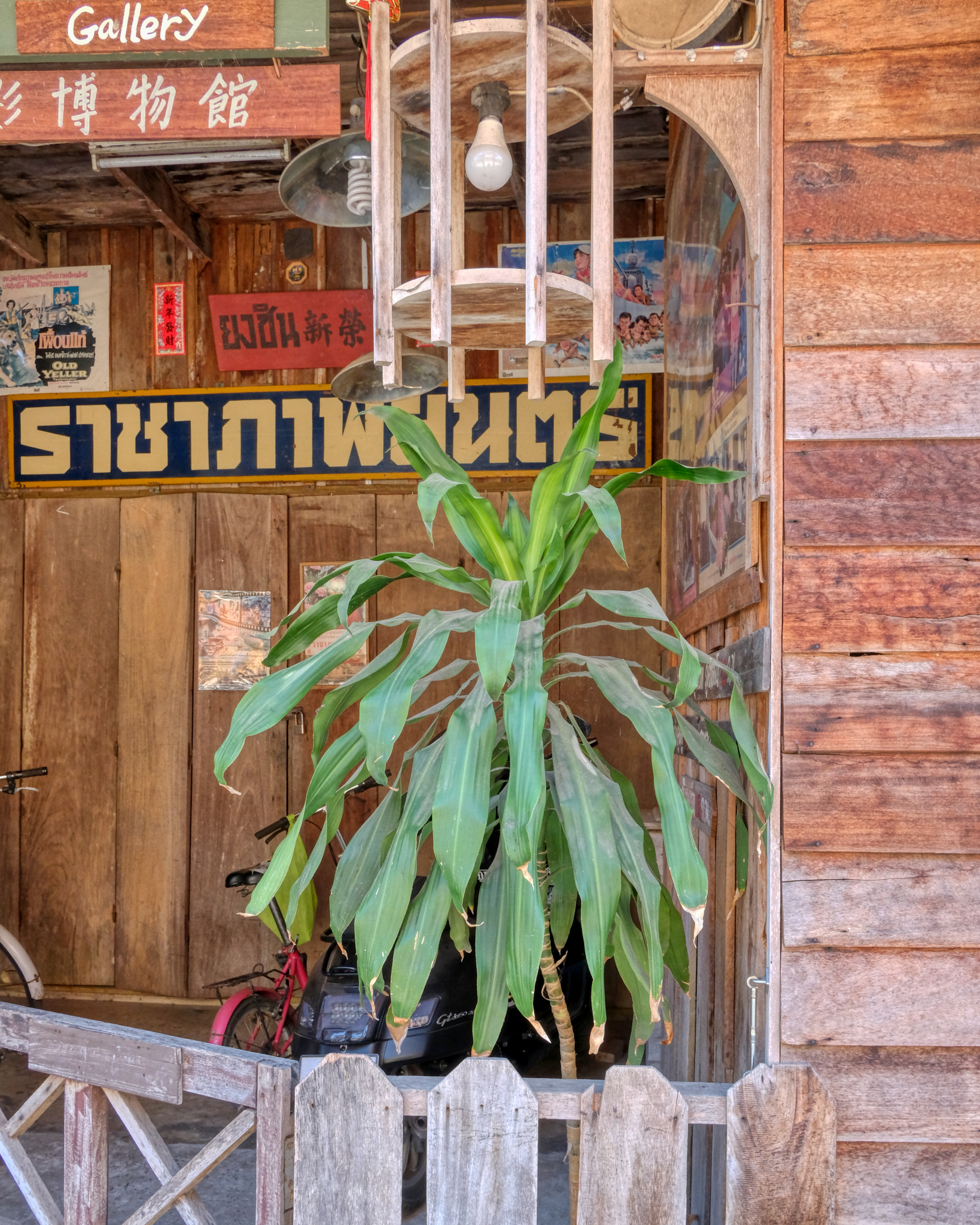 Another "still life" of an old art gallery.
Another "still life" of an old art gallery.
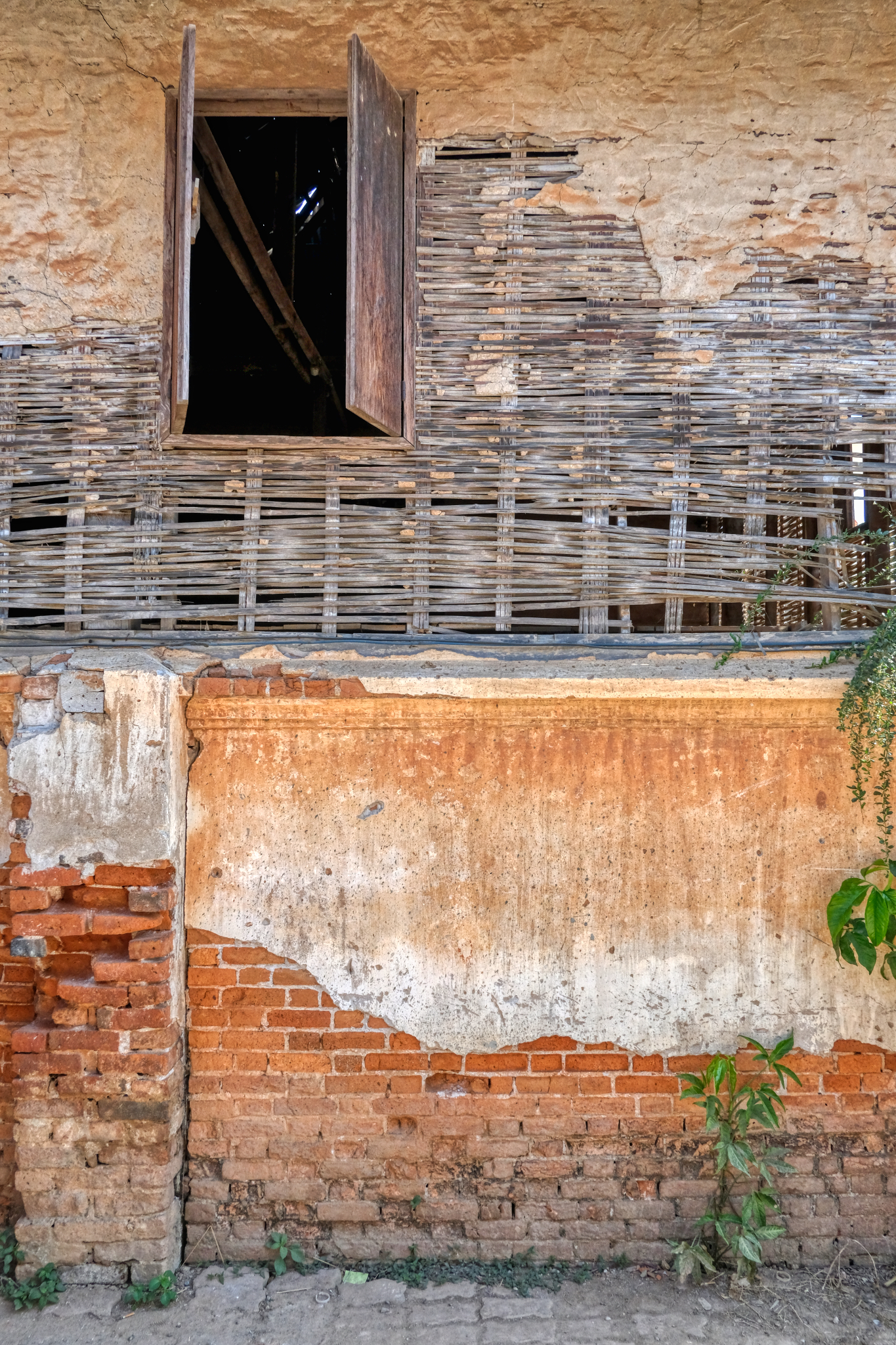 A very old wall revealing ancient building techniques.
A very old wall revealing ancient building techniques.
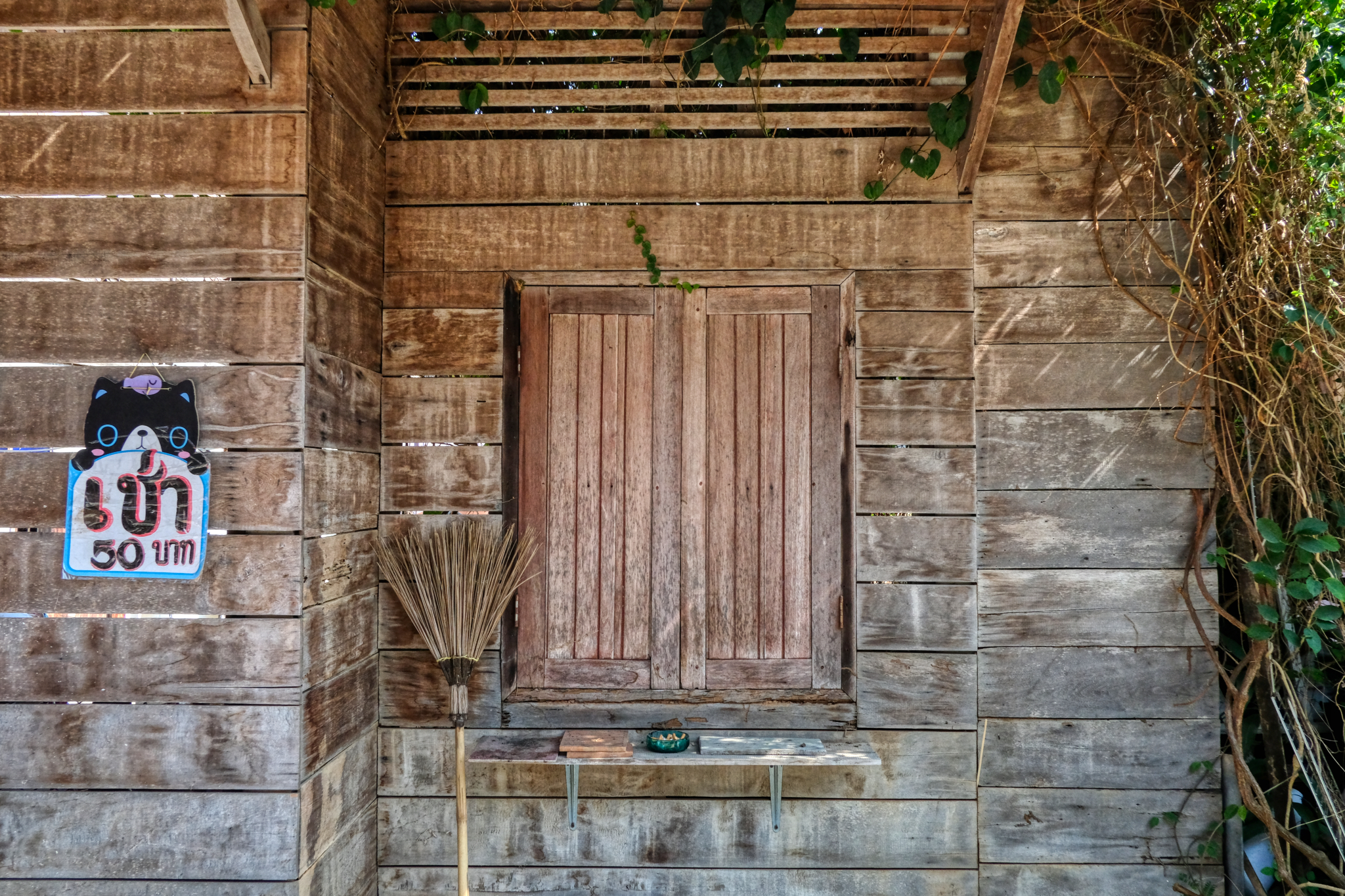 Wooden wall with broom and ash tray.
Wooden wall with broom and ash tray.
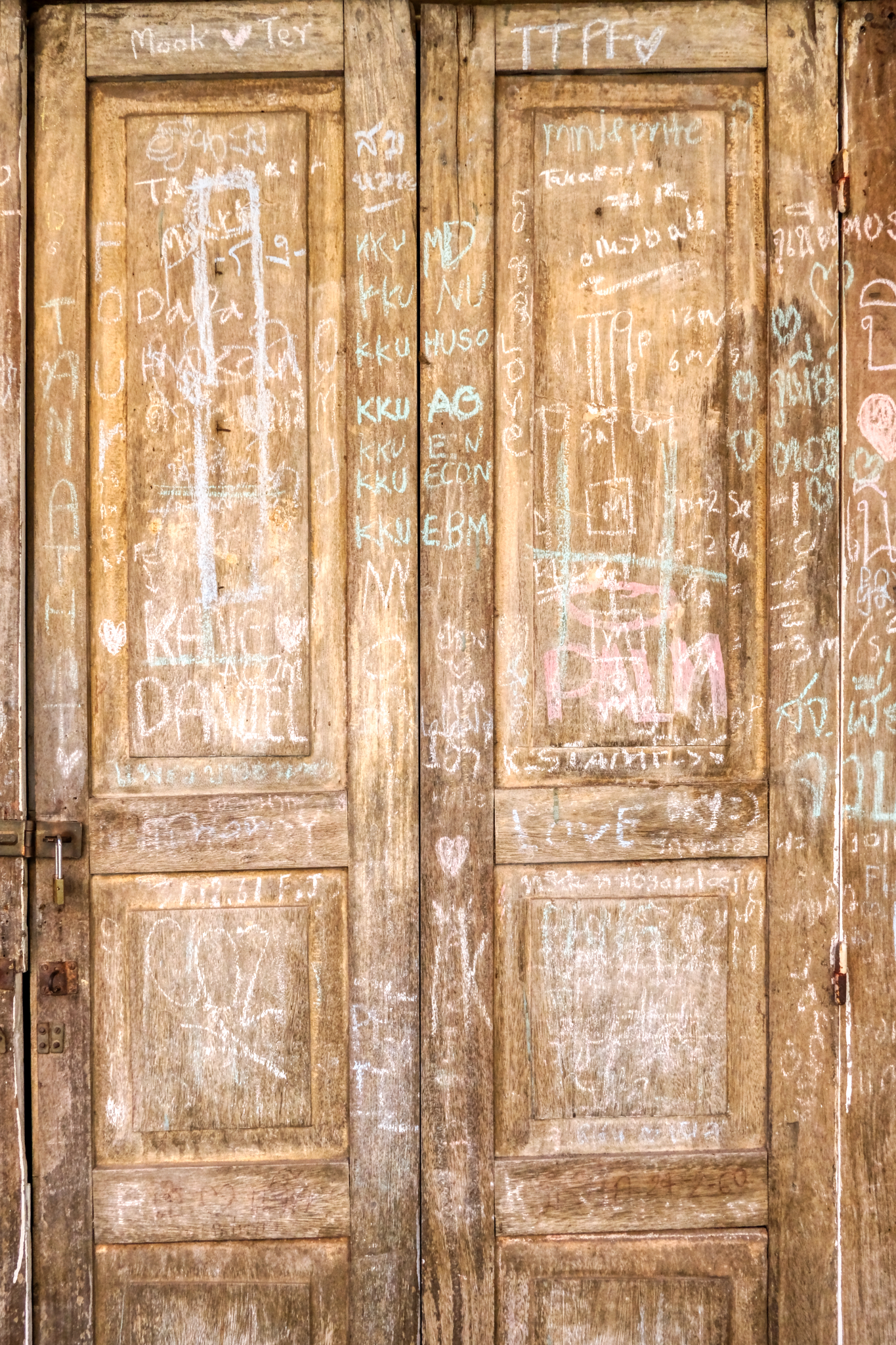 Chalk graffiti on old panel shop doors . . . there is a story here.
Chalk graffiti on old panel shop doors . . . there is a story here.
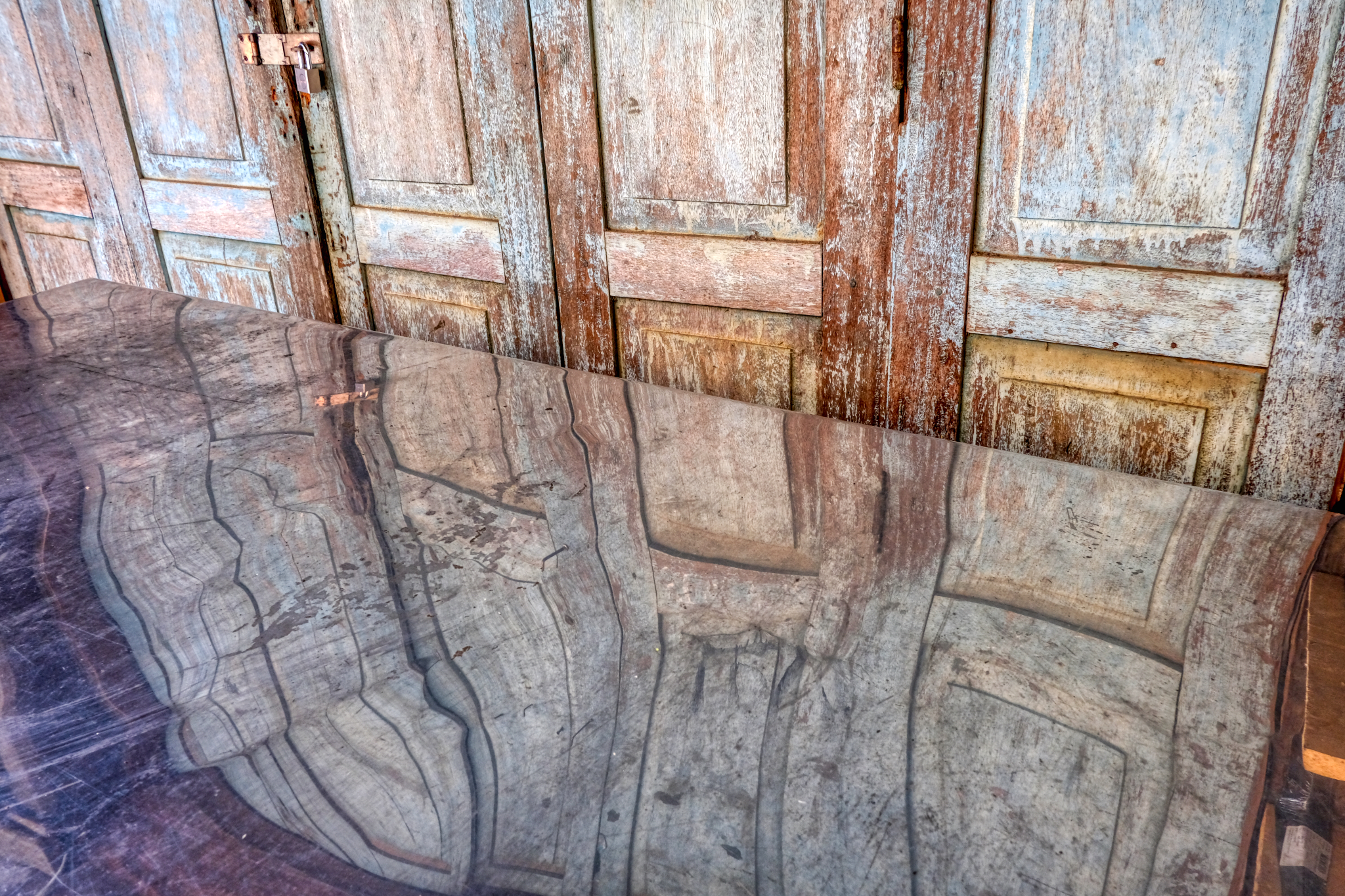 Old panel shop doors reflected in a stainless steel table. Nice. These "still life" photo opportunities were endless in Chiang Khan.
Old panel shop doors reflected in a stainless steel table. Nice. These "still life" photo opportunities were endless in Chiang Khan.
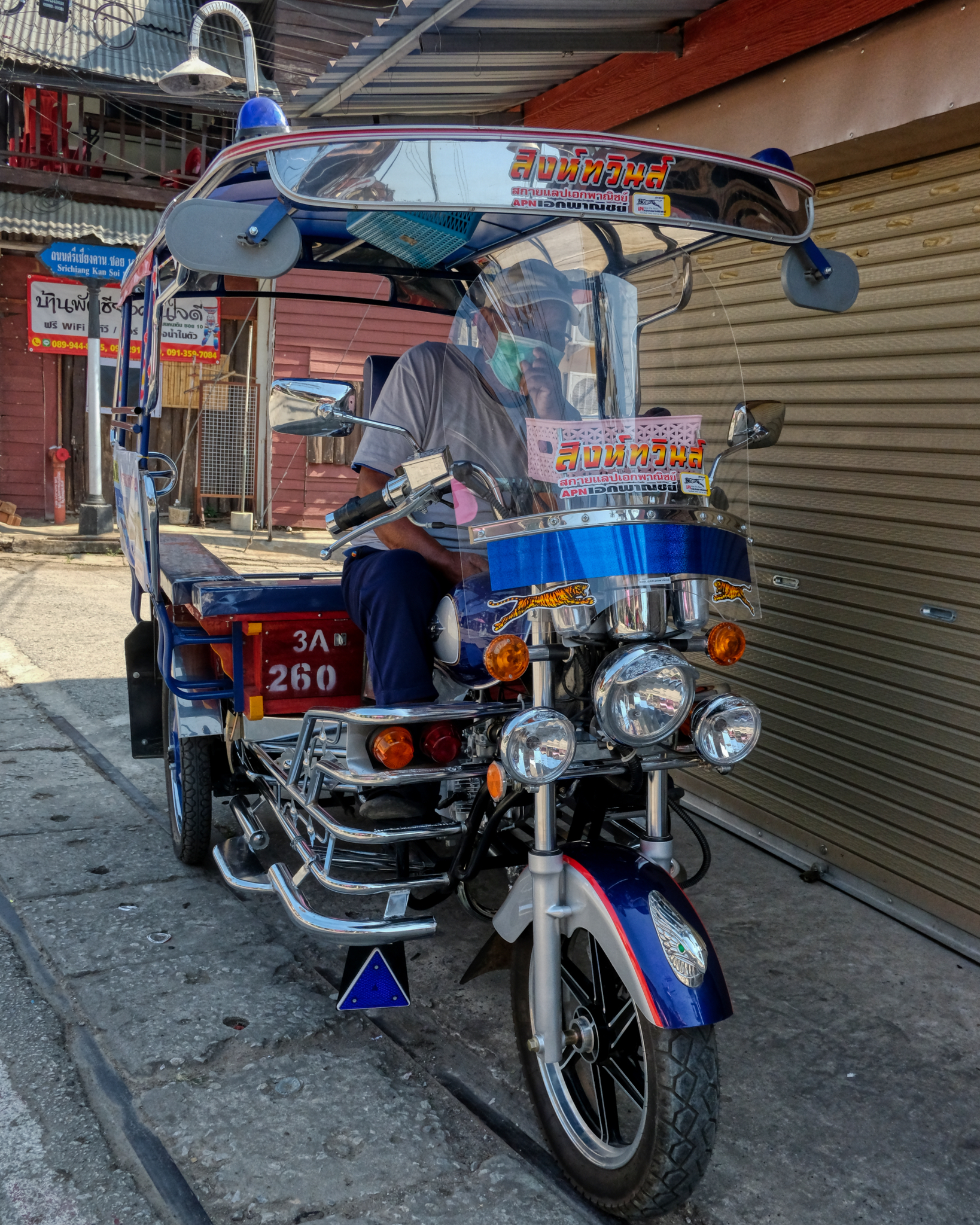 A very nice tuk-tuk, although I never saw anybody riding in one . . . everybody walked around the little town.
A very nice tuk-tuk, although I never saw anybody riding in one . . . everybody walked around the little town.
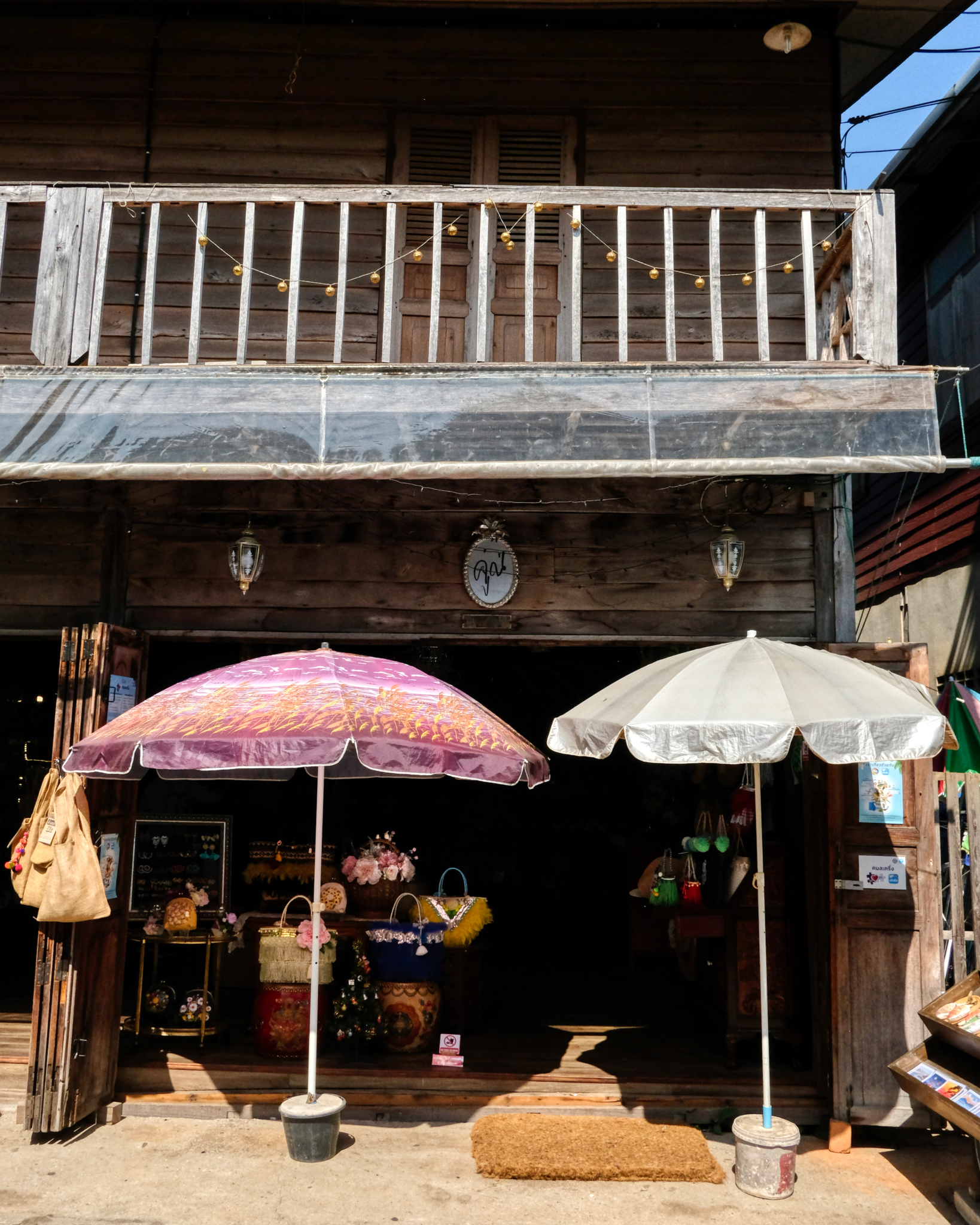 We were getting tired and sore walking around the sweet town . . . deciding what to do next . . .
We were getting tired and sore walking around the sweet town . . . deciding what to do next . . .
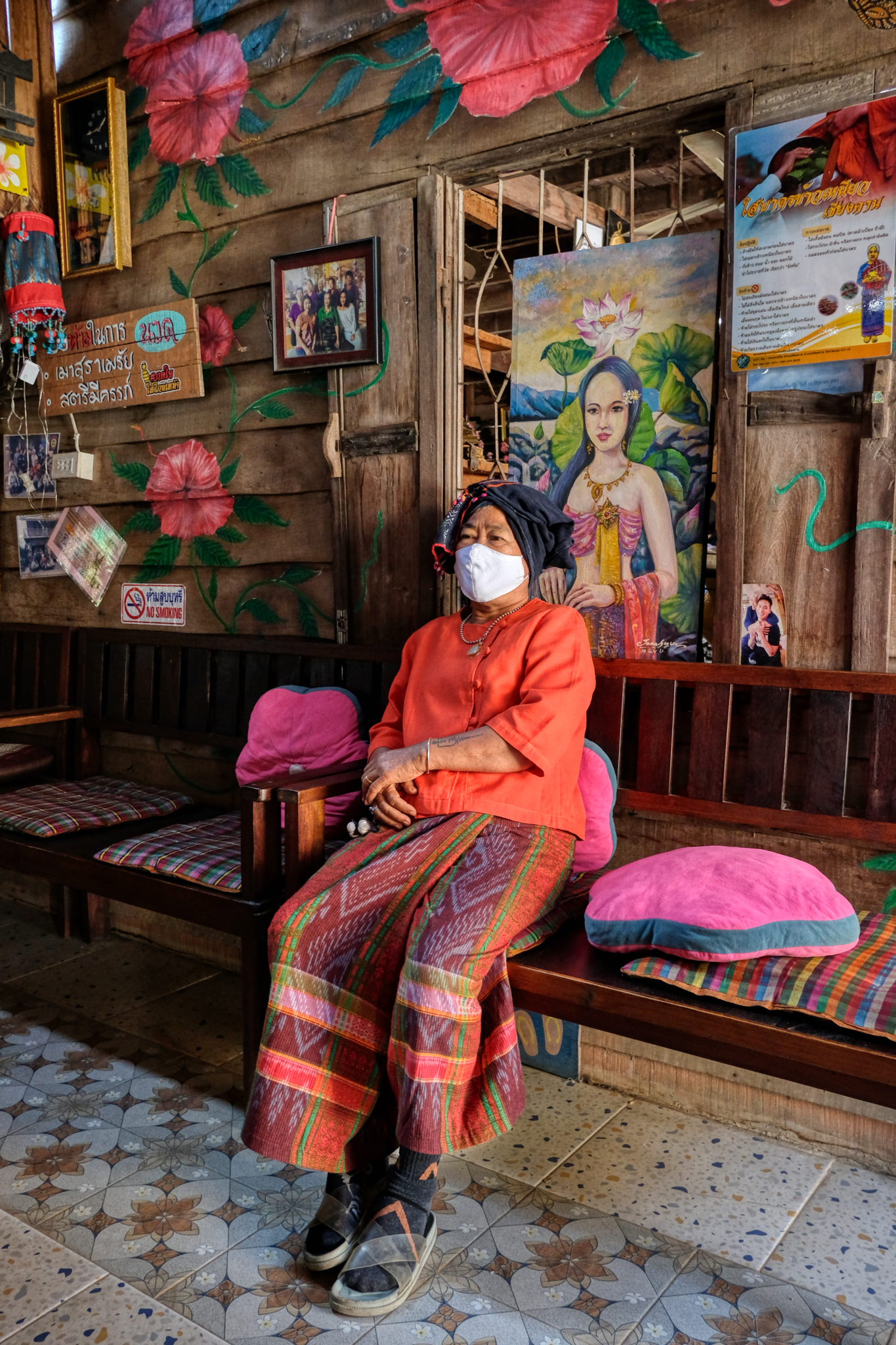 Massage! That's what's next!! The massage shop owner was very kind.
Massage! That's what's next!! The massage shop owner was very kind.
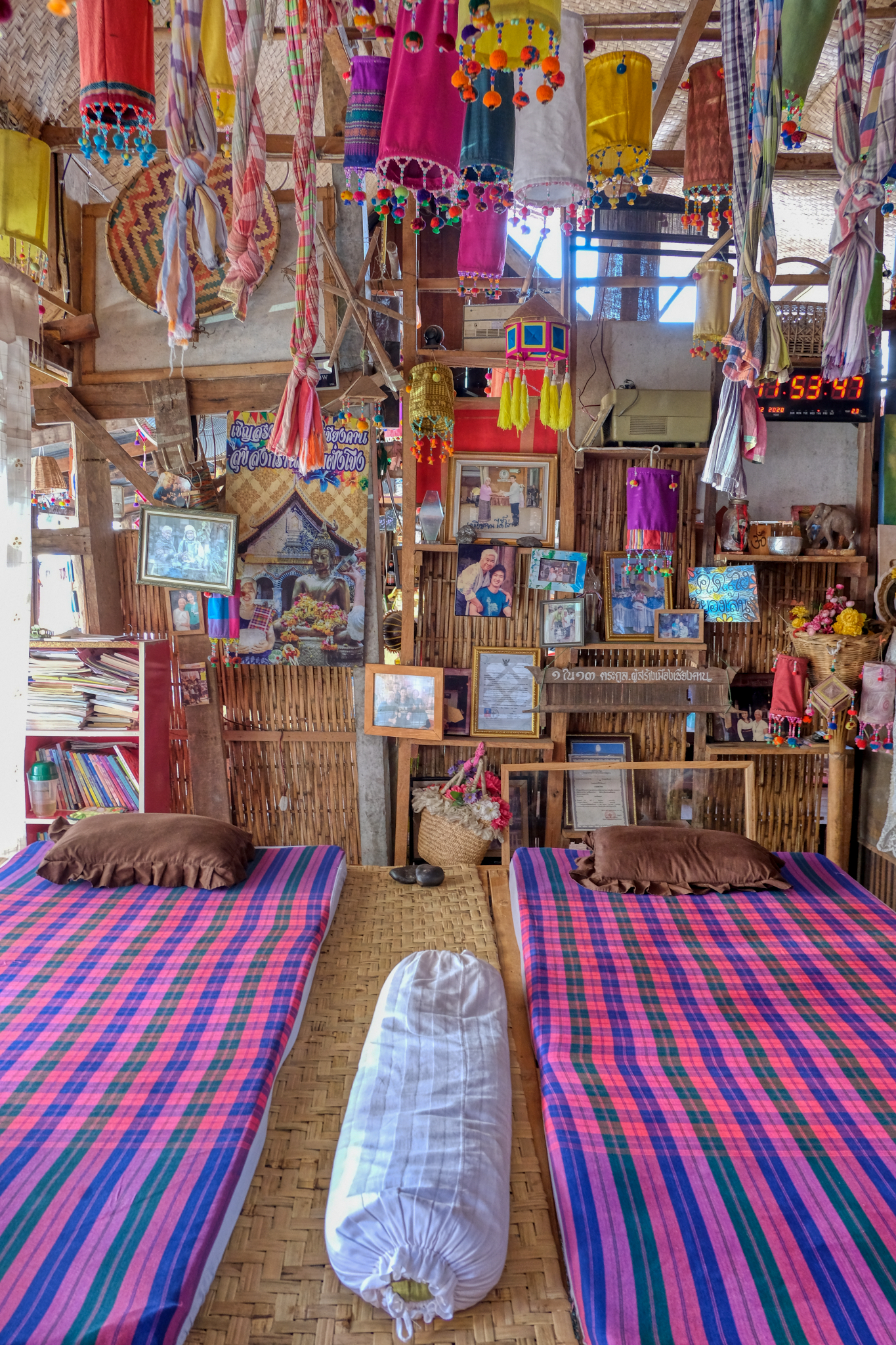 a 2 1/2 hour Thai massage will cure whatever ails you, that's for sure! This street side massage room was so beautiful. Just breathtaking!
a 2 1/2 hour Thai massage will cure whatever ails you, that's for sure! This street side massage room was so beautiful. Just breathtaking!
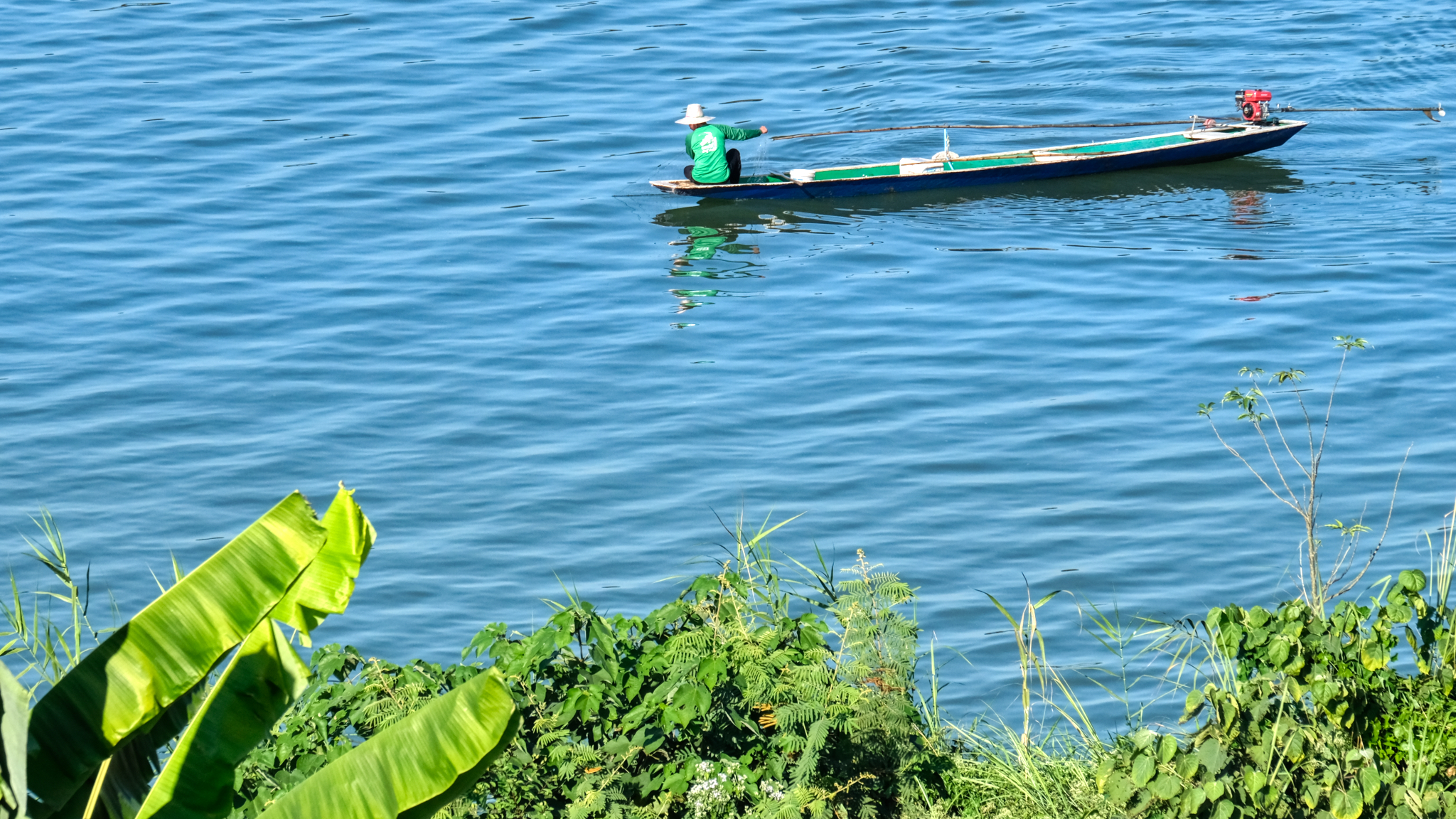 We spent part of our days walking along a path next to the Mekong River.
We spent part of our days walking along a path next to the Mekong River.
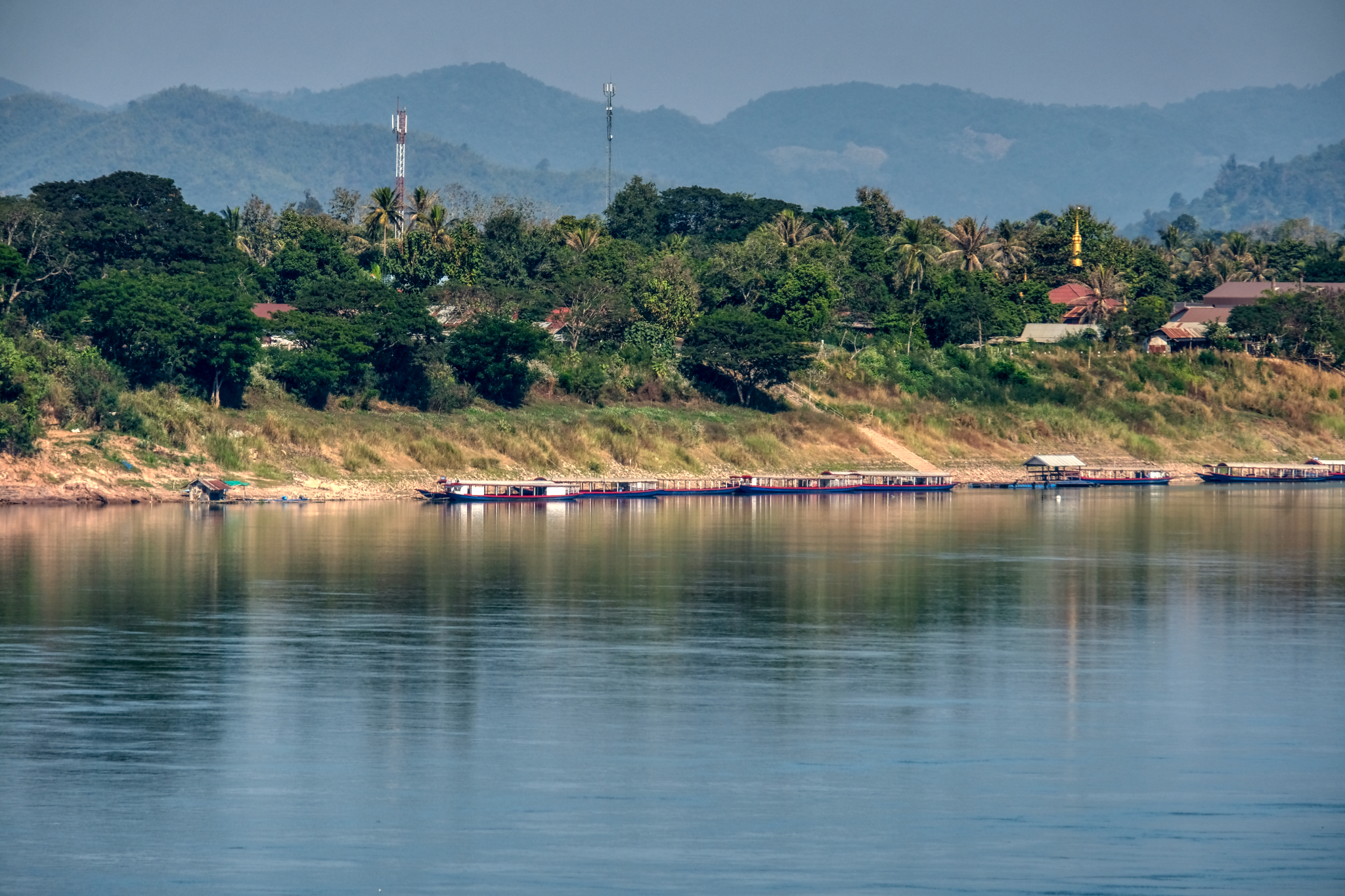 Looking across the Mekong toward the 'wild side' of Laos.
Looking across the Mekong toward the 'wild side' of Laos.
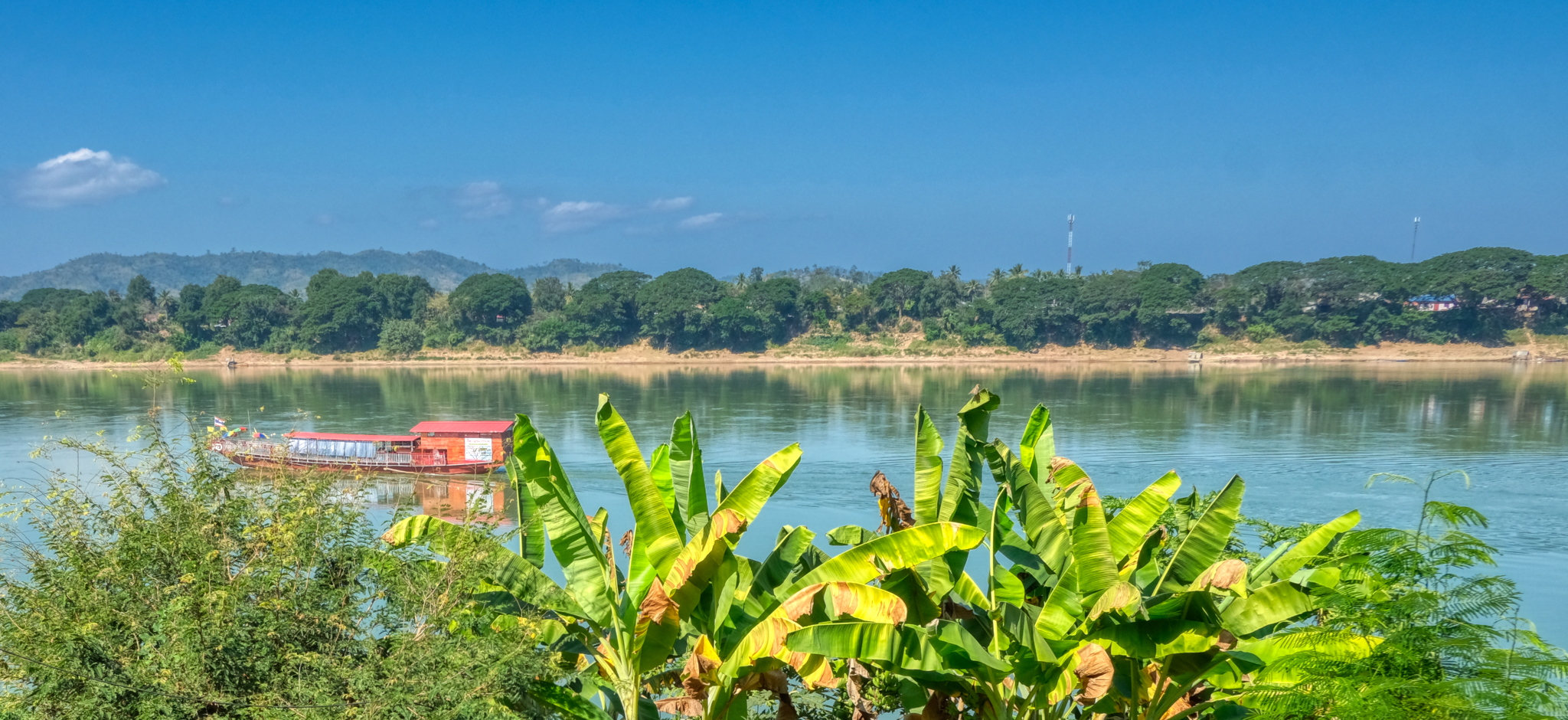 Riverboat ferry both local people and tourists up and down the river.
Riverboat ferry both local people and tourists up and down the river.
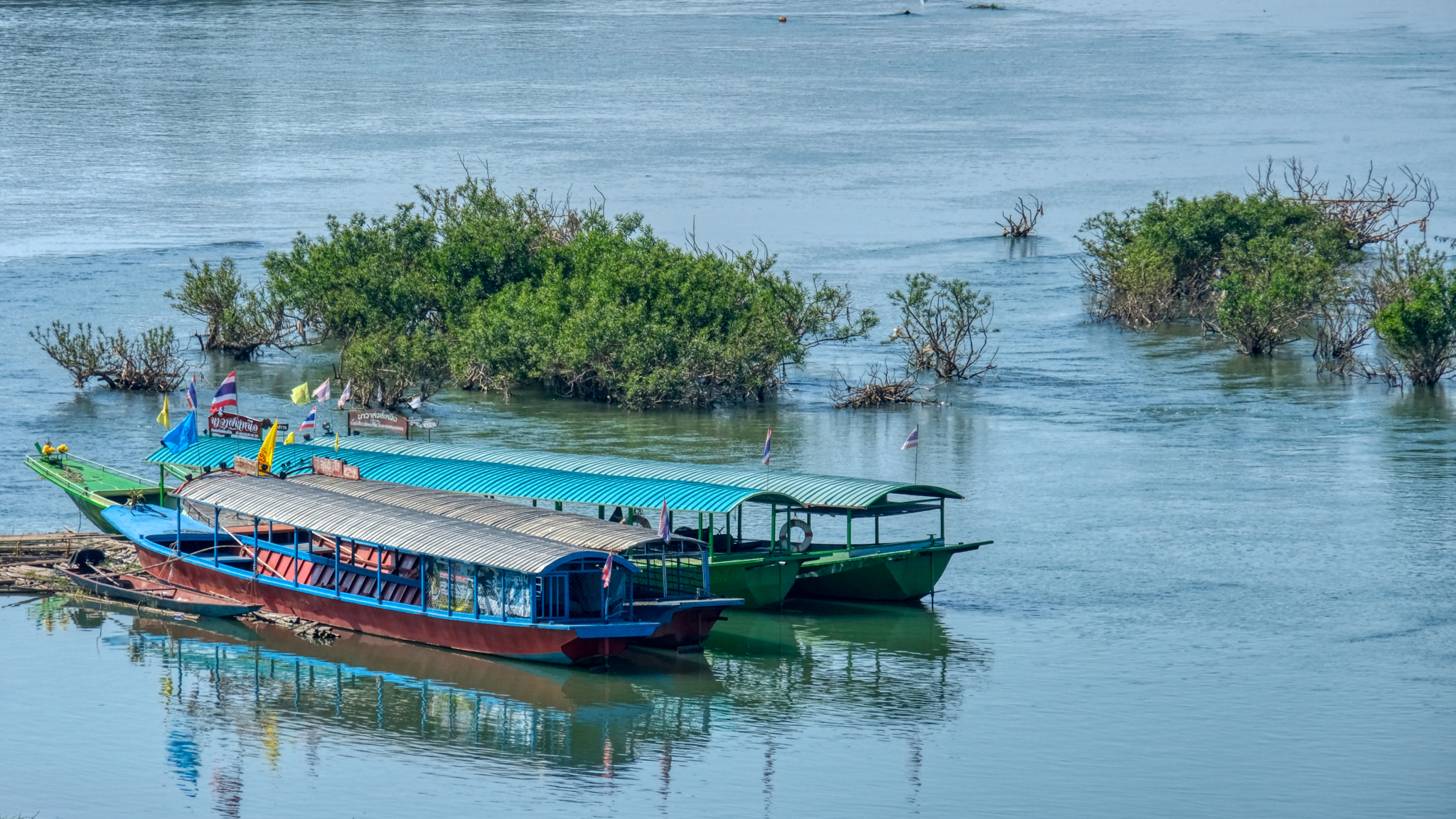 Mekong River boats at the ready.
Mekong River boats at the ready.
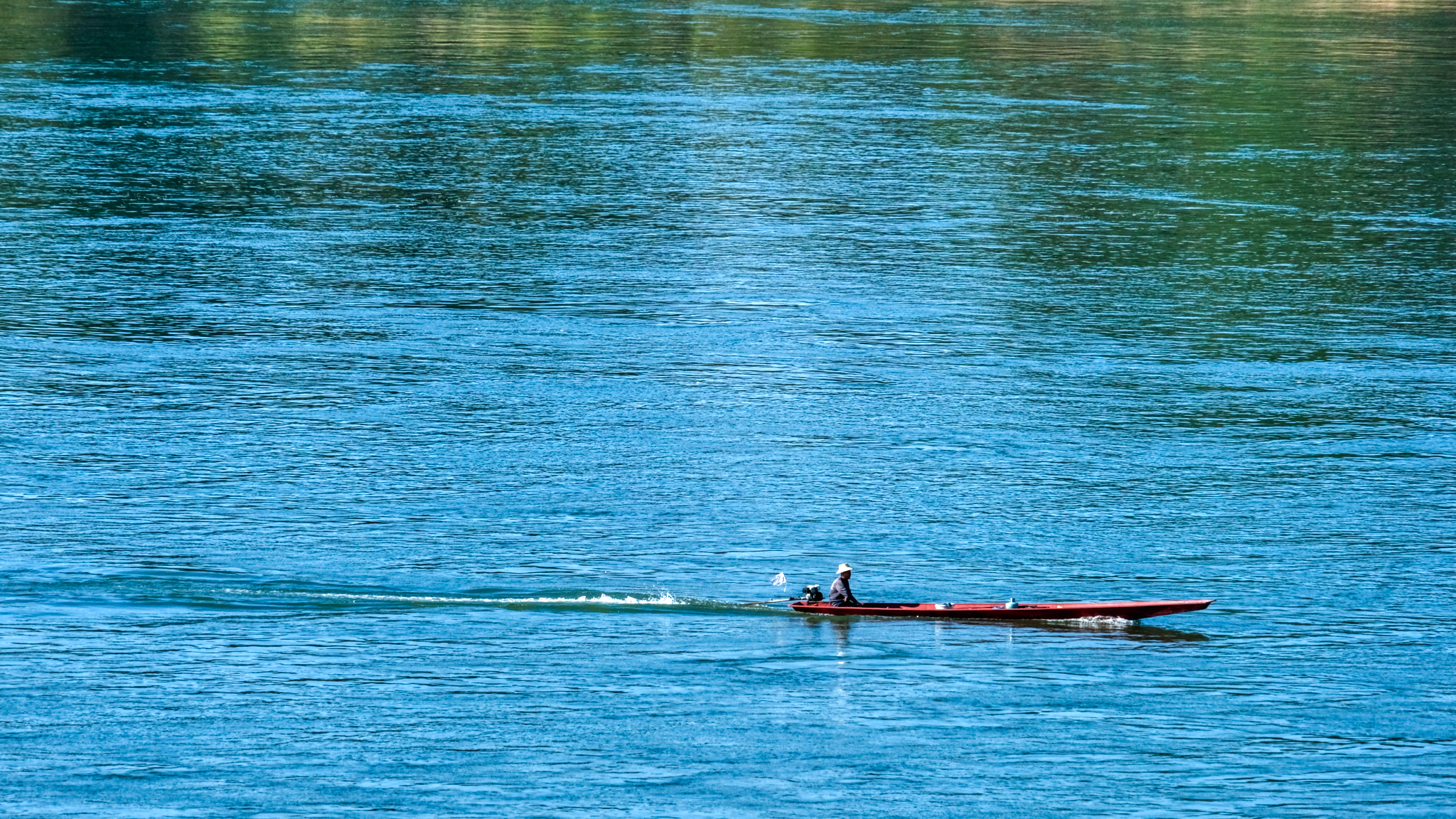 A fisherman going home. Surprisingly, I did not see very many fishermen out on the river.
A fisherman going home. Surprisingly, I did not see very many fishermen out on the river.
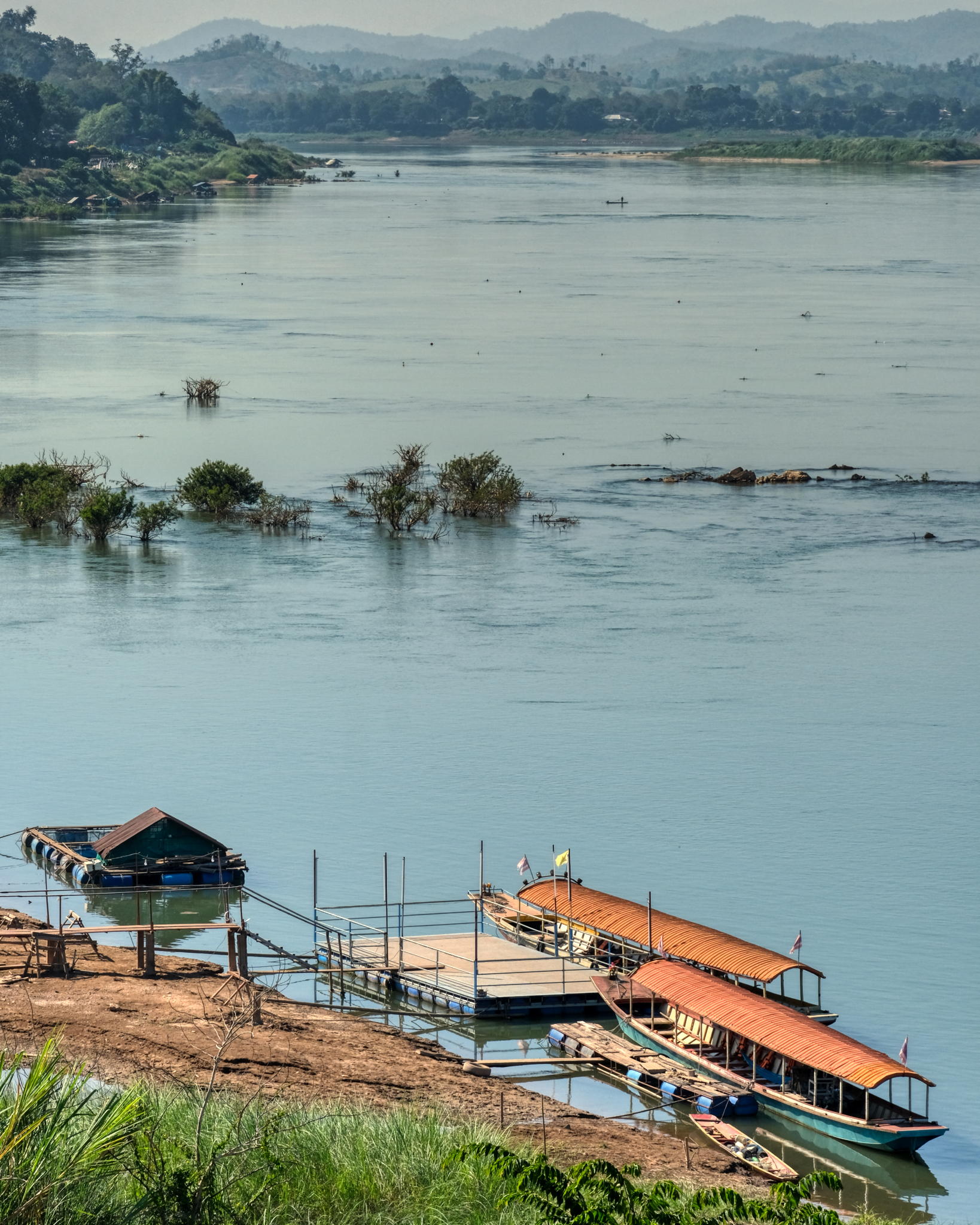 The fiew upriver toward the smoky Lao hills from Chiang Khan.
The fiew upriver toward the smoky Lao hills from Chiang Khan.
 When the sun set we headed to the night market street.
When the sun set we headed to the night market street.
CHIANG KHAN by NIGHT
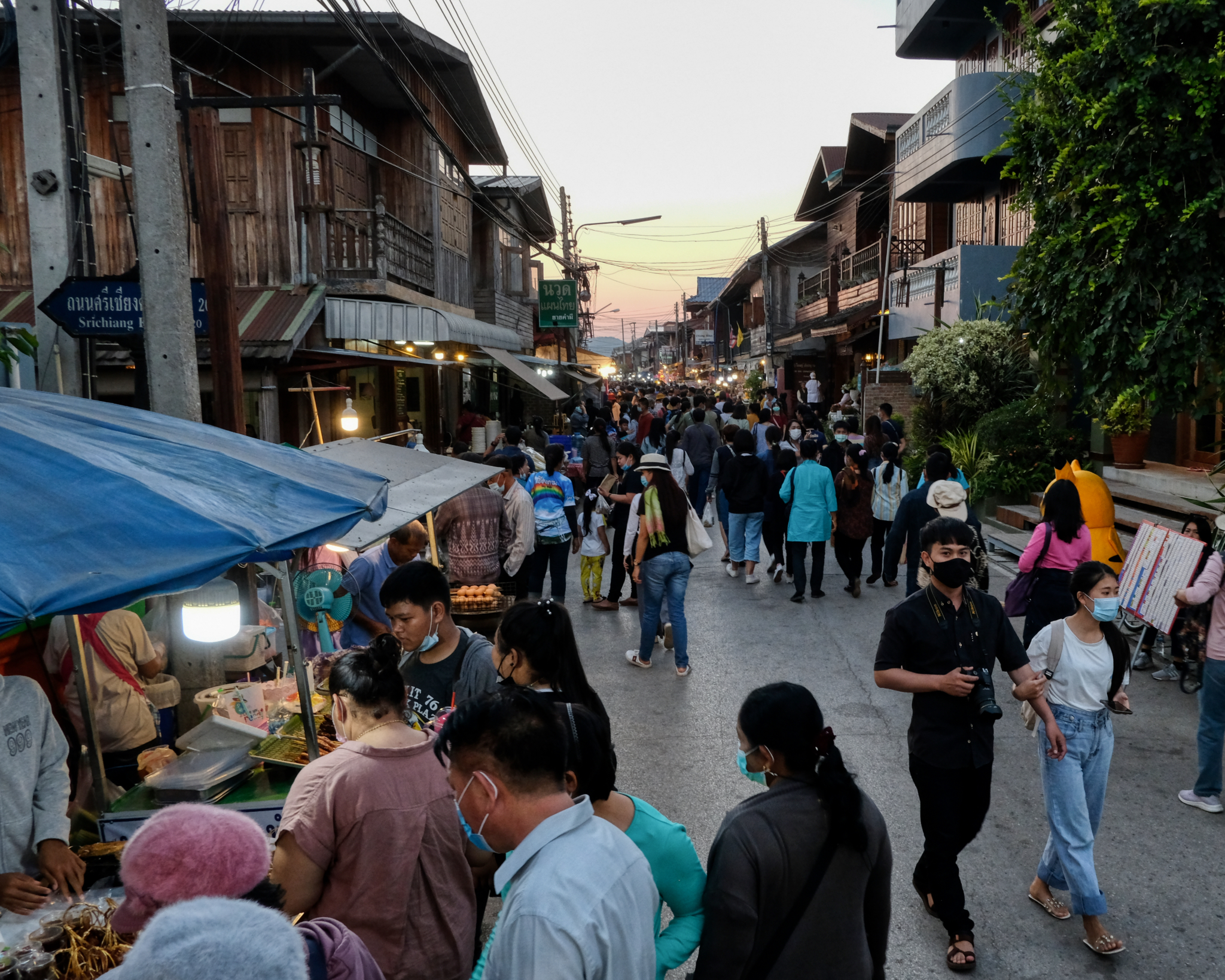 As the light faded, and the heat dissipated, it seemed that every Thai tourist in town left their guesthouse and headed to the main walking street.
As the light faded, and the heat dissipated, it seemed that every Thai tourist in town left their guesthouse and headed to the main walking street.
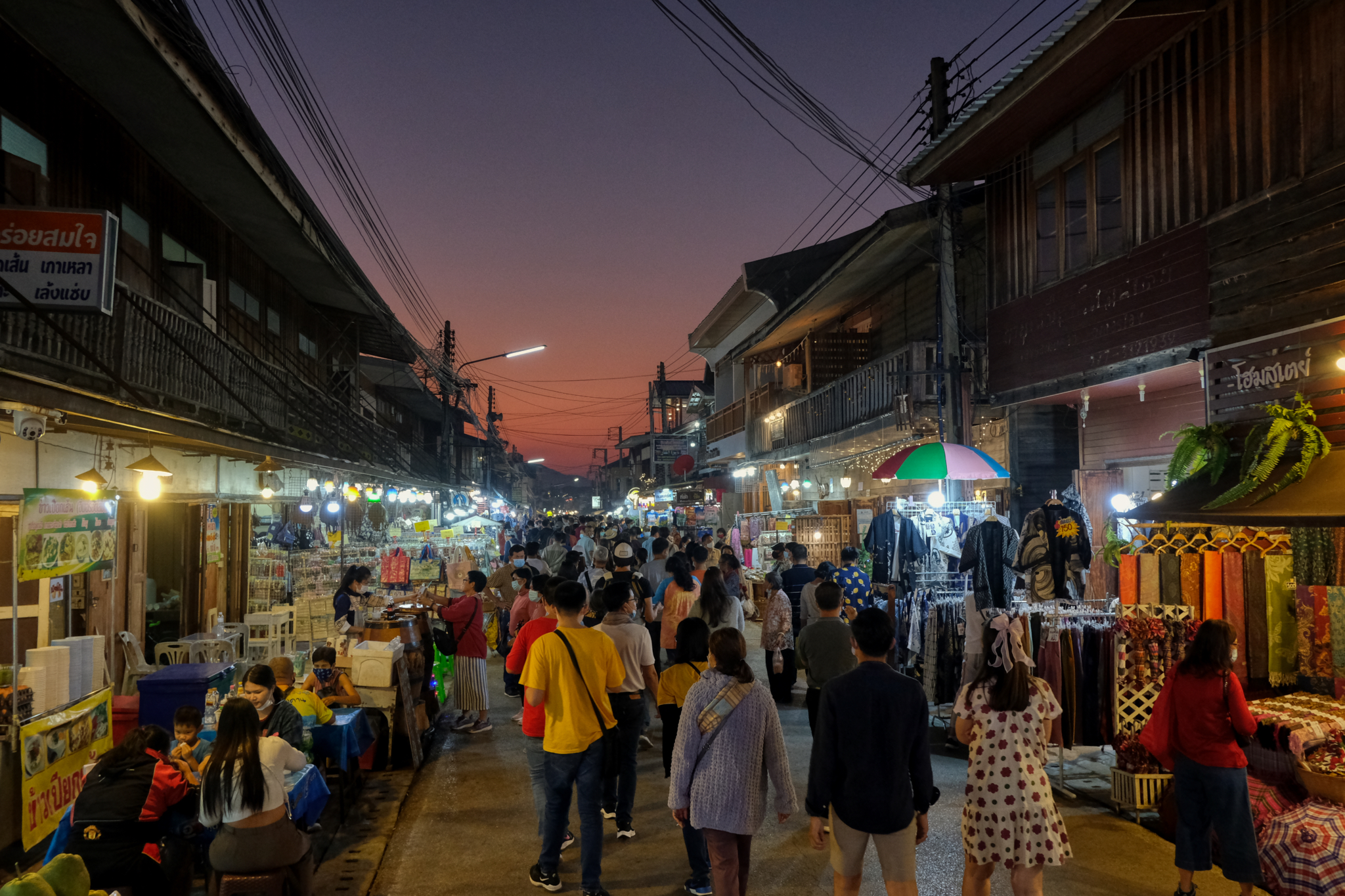 The darker it got, the bigger the crowd under the colorful, and fading sky.
The darker it got, the bigger the crowd under the colorful, and fading sky.
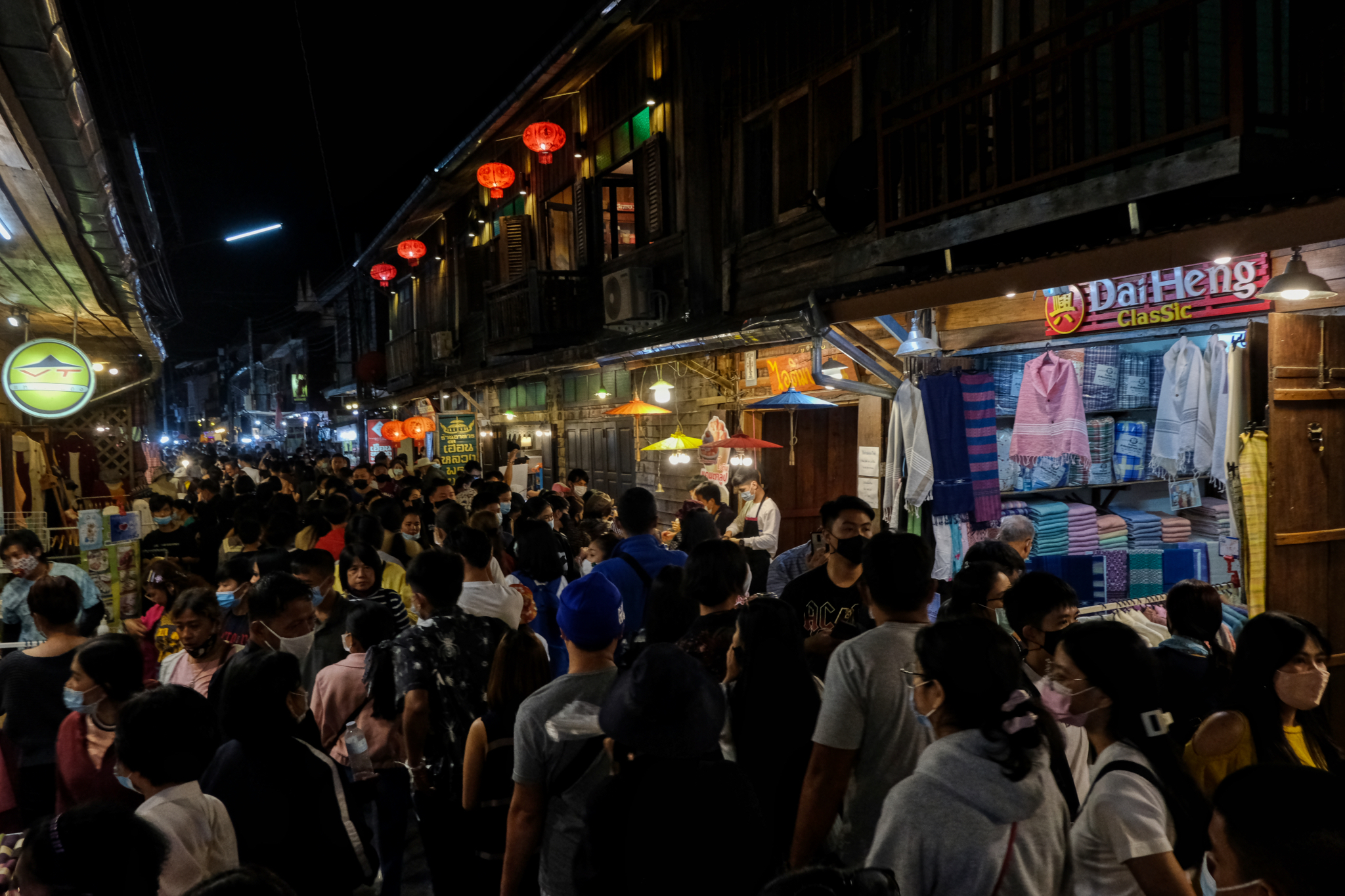 At last the sun had fully set.
At last the sun had fully set.
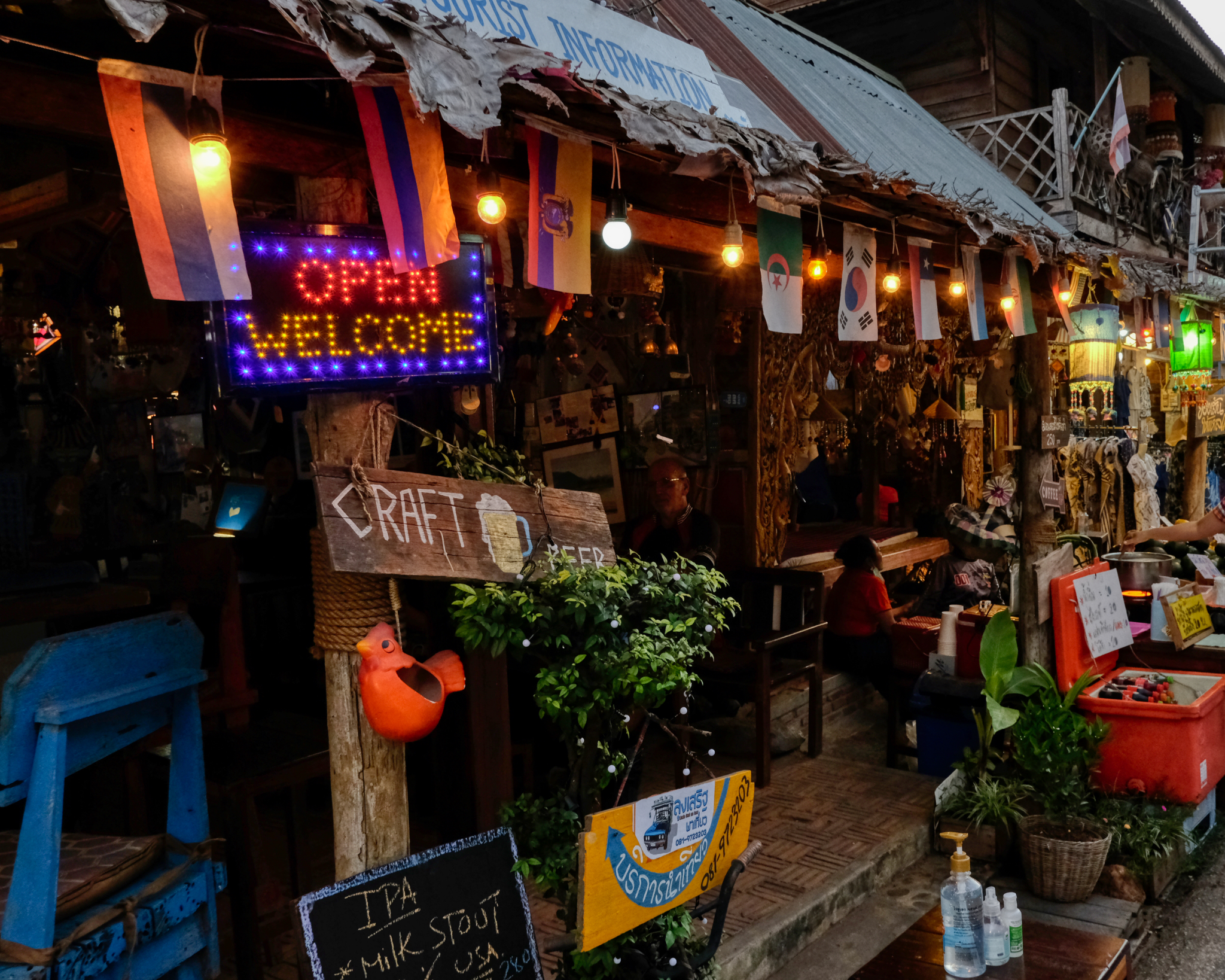 Many of the shops, restaurants, and bars that were closed in the afternoon opened for the throngs that came out at night. This craft beer joint was a welcome stop for me.
Many of the shops, restaurants, and bars that were closed in the afternoon opened for the throngs that came out at night. This craft beer joint was a welcome stop for me.
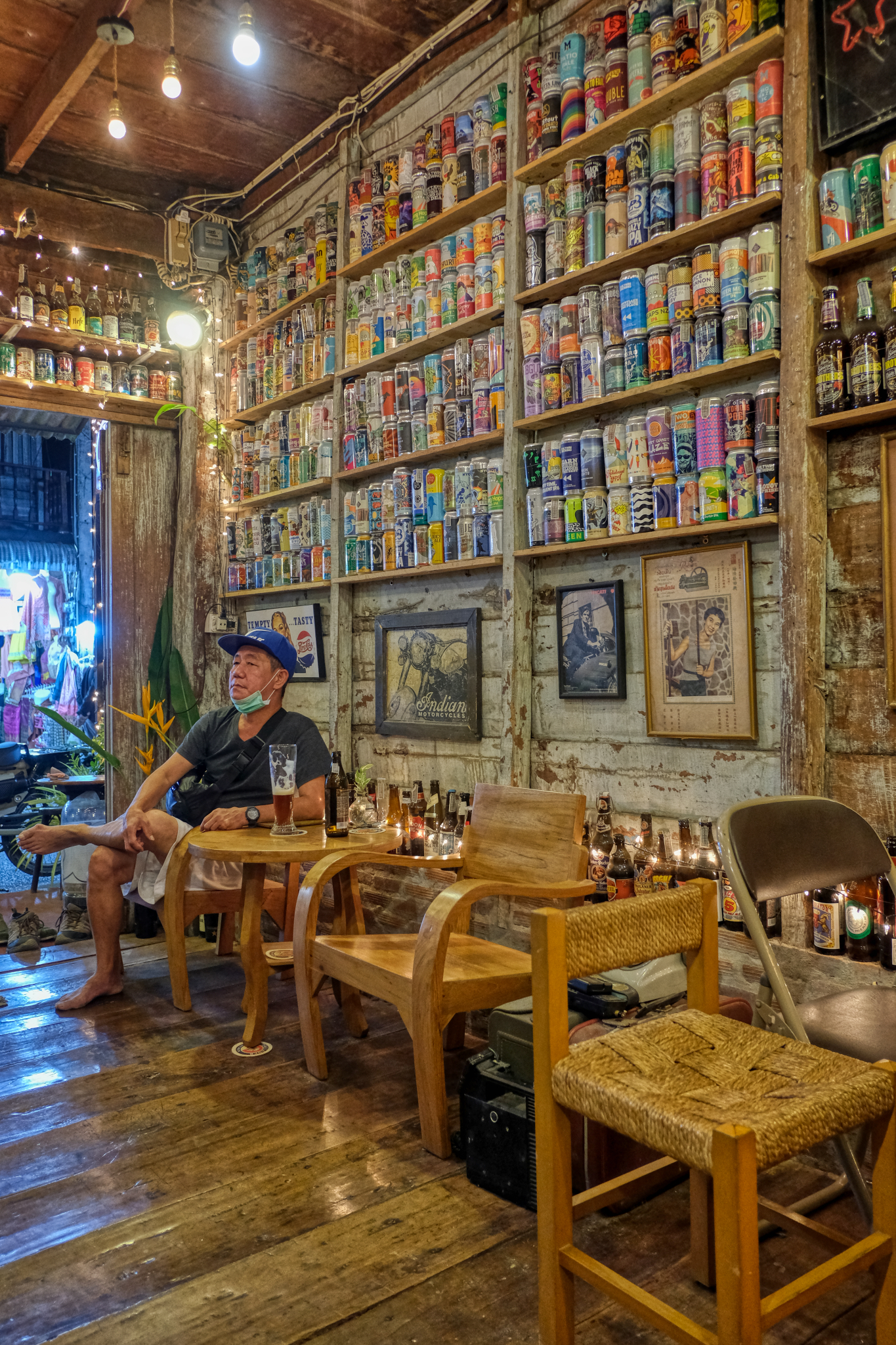 The interior of the craft beer hall.
The interior of the craft beer hall.
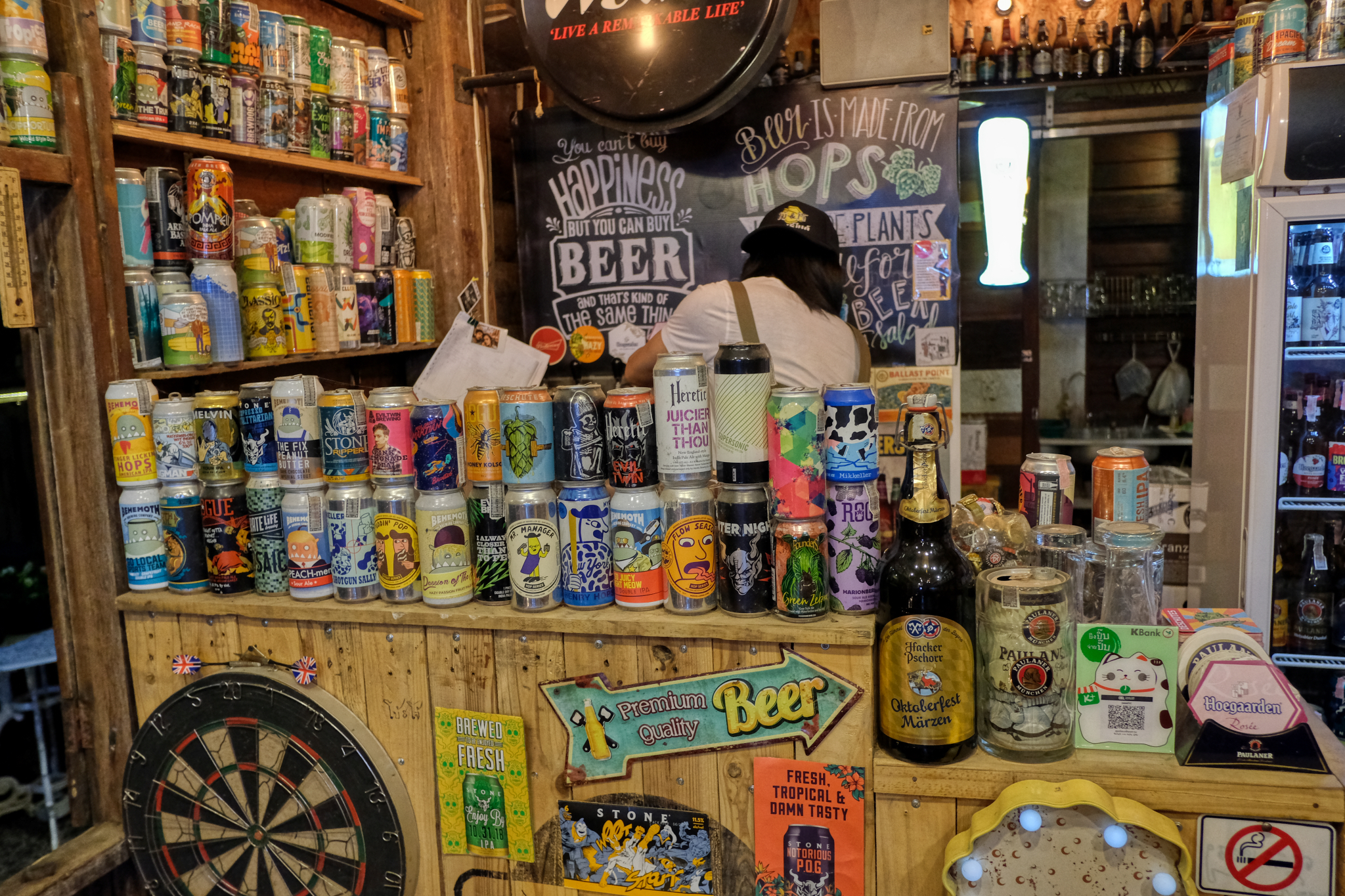 The Thai hippies who ran the craft beer hall had a fantastic collection of beers and ales to choose from.
The Thai hippies who ran the craft beer hall had a fantastic collection of beers and ales to choose from.
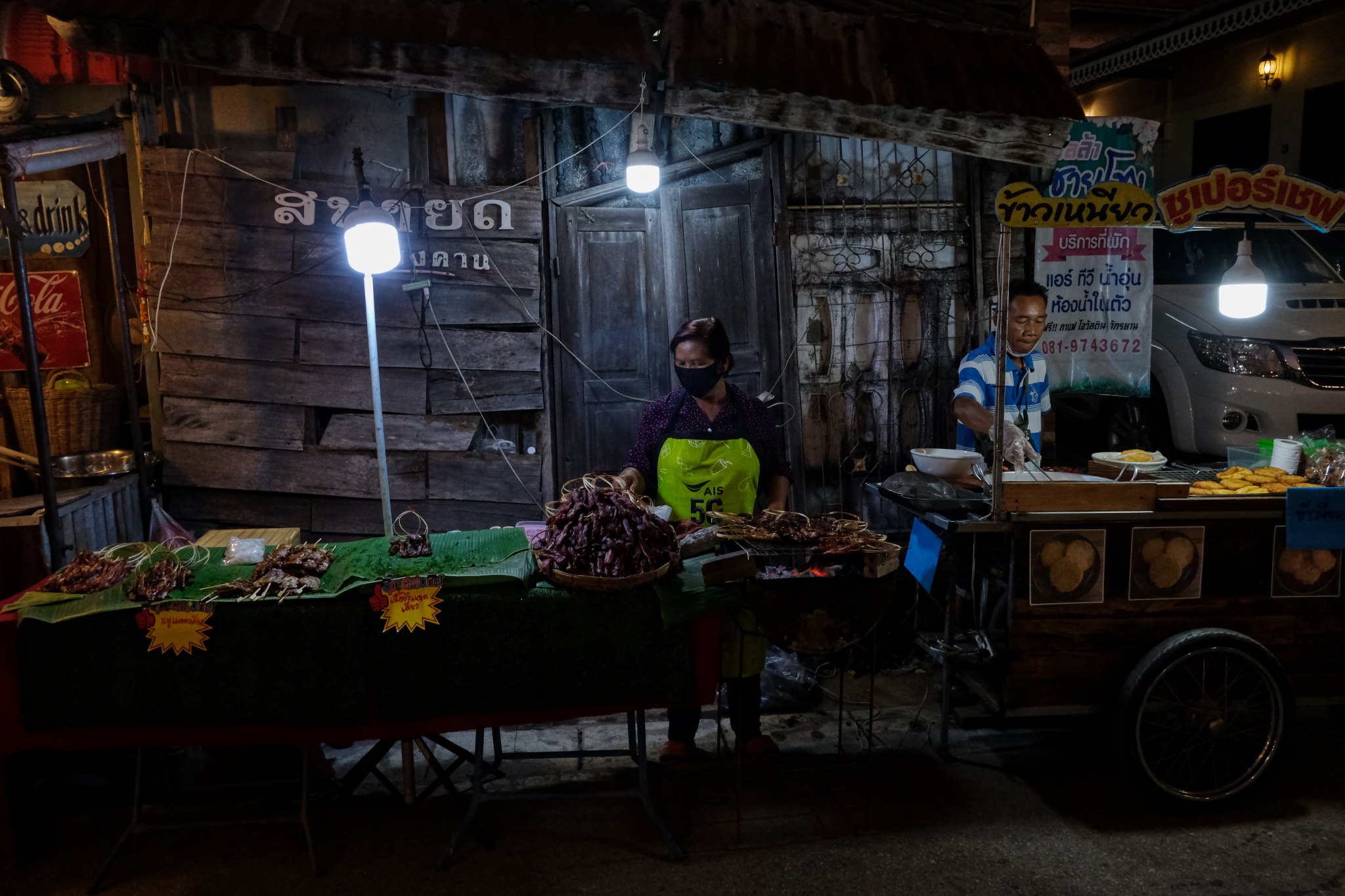 The town became even more photogenic at night. BBQ beef street hawkers.
The town became even more photogenic at night. BBQ beef street hawkers.
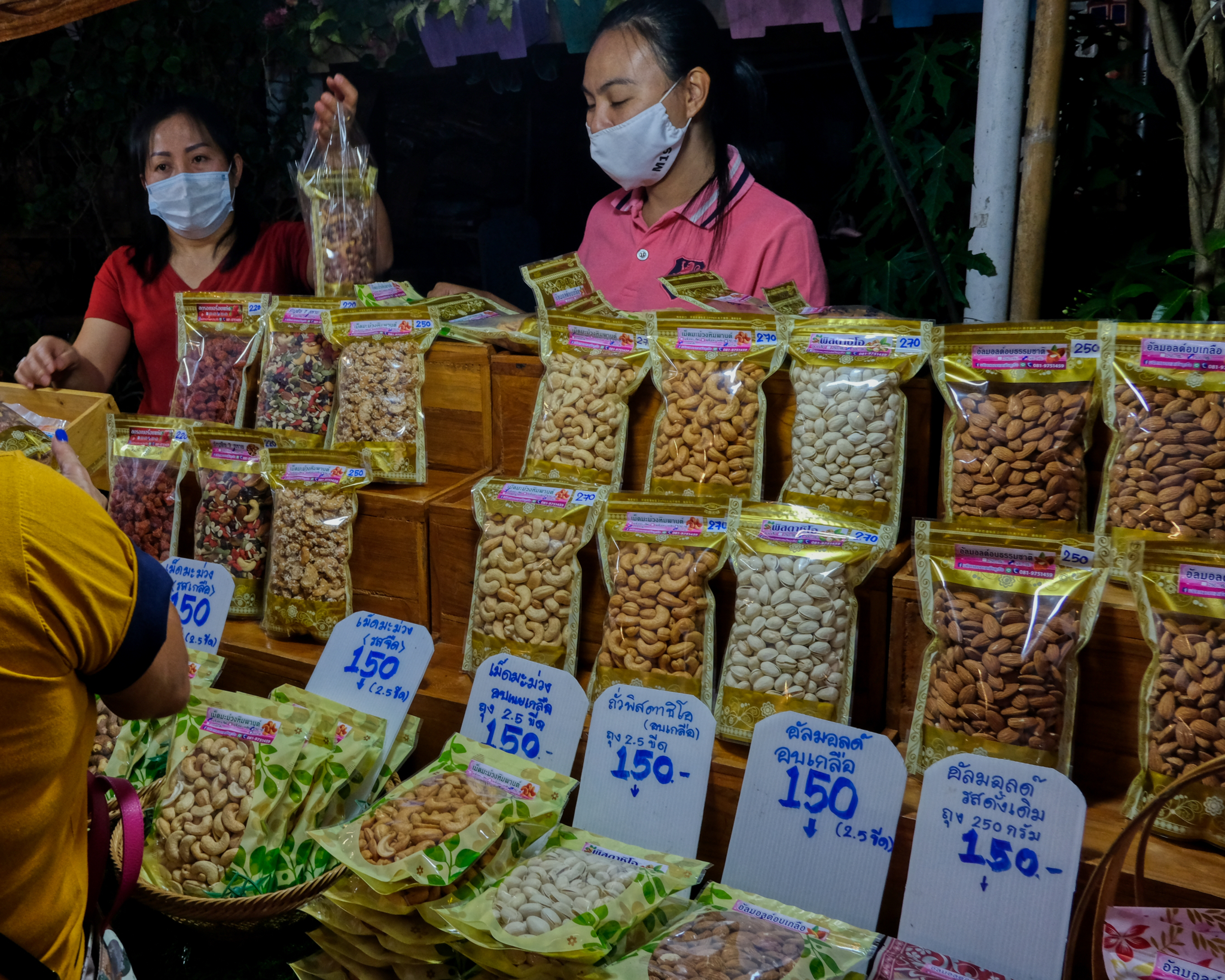 The many stalls set up along the night street became a 'night market' - a favorite of Thai people and visitors to Thailand. There was a wide variety of things for sale. Nuts! I love nuts!
The many stalls set up along the night street became a 'night market' - a favorite of Thai people and visitors to Thailand. There was a wide variety of things for sale. Nuts! I love nuts!
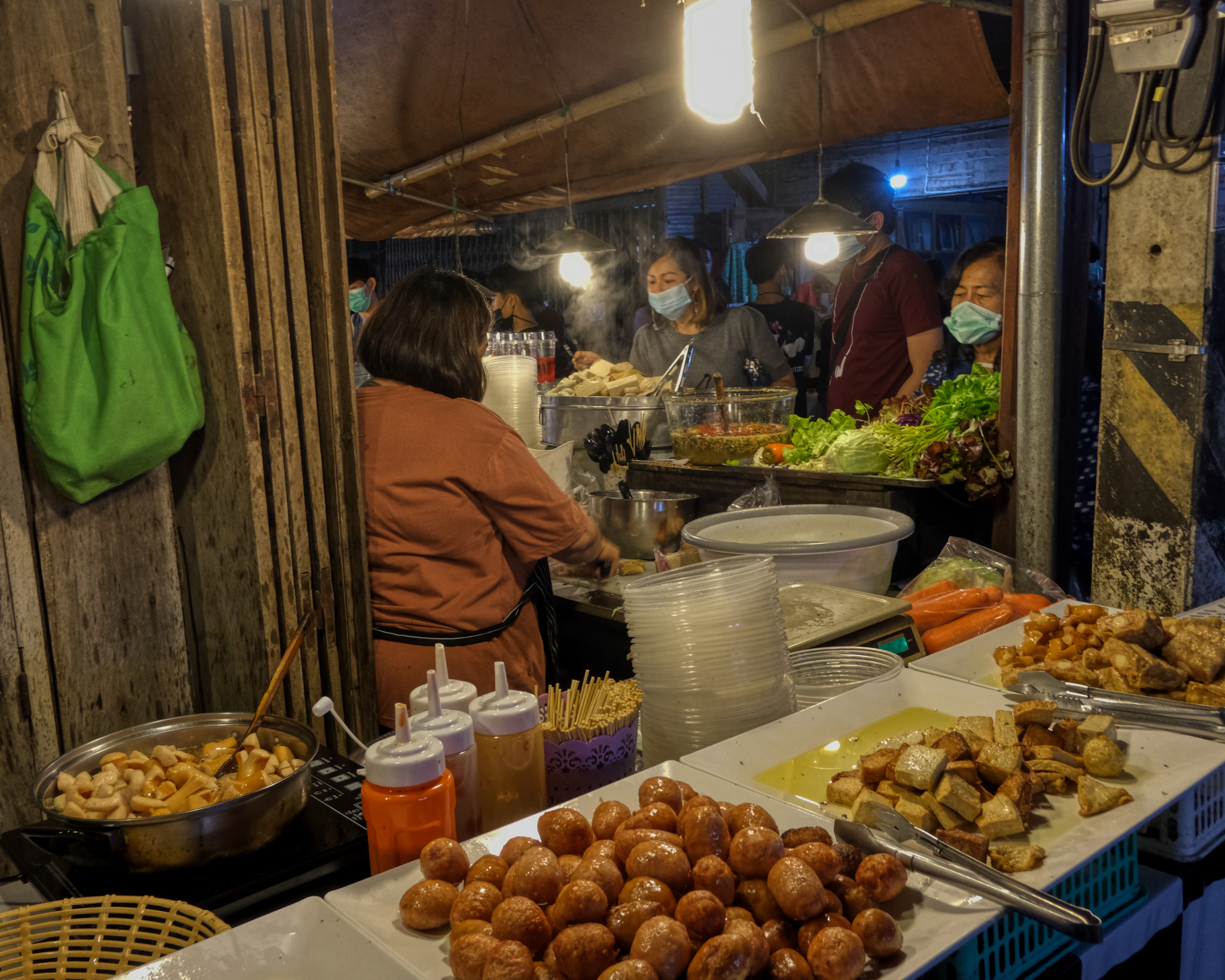 All the night market visitors brought their appetites . . . and were rewarded with a wide variety of delicious Thai specialties to eat.
All the night market visitors brought their appetites . . . and were rewarded with a wide variety of delicious Thai specialties to eat.
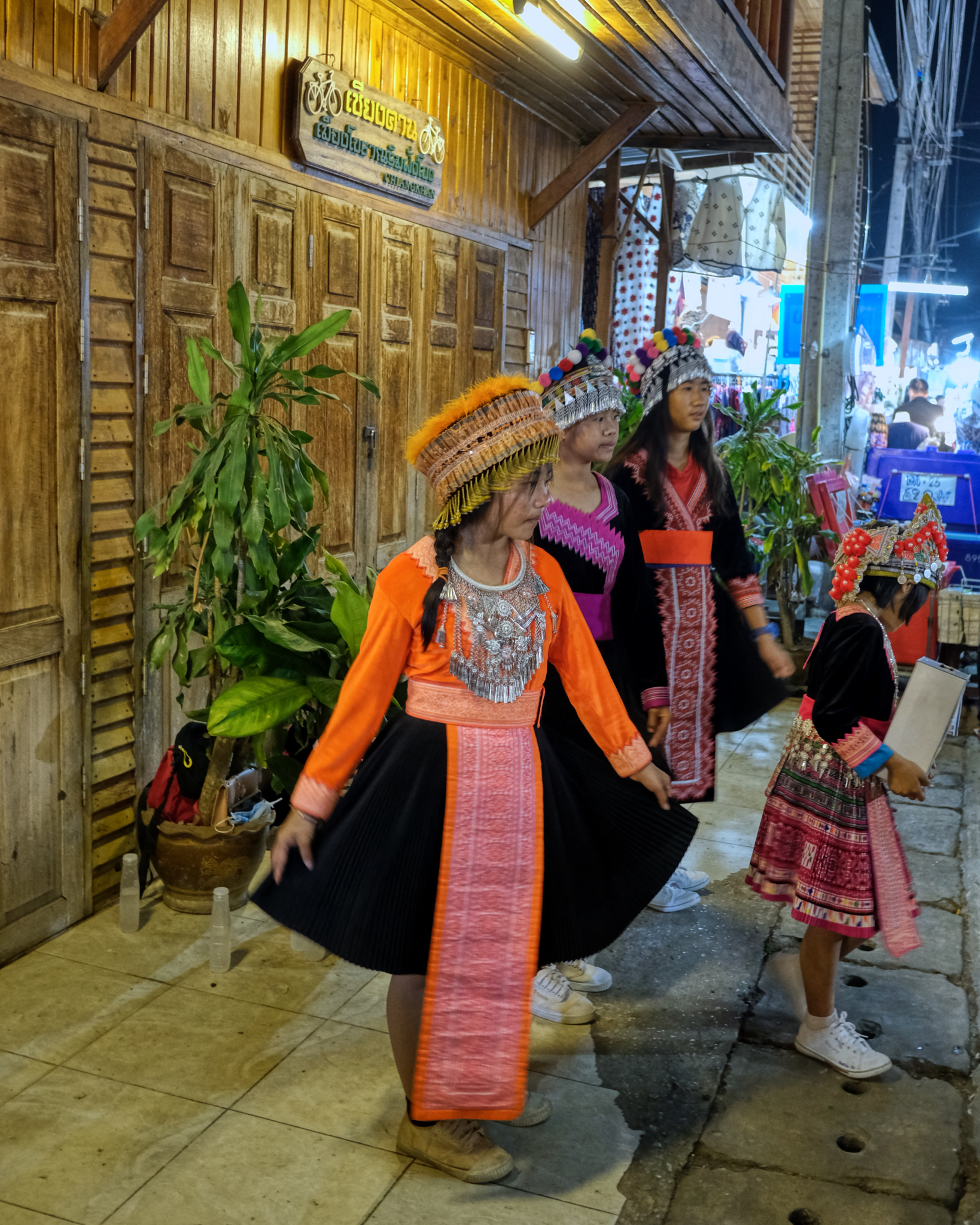 Street performers in their traditional 'hill tribe' costumes entertained the gathered crowds.
Street performers in their traditional 'hill tribe' costumes entertained the gathered crowds.
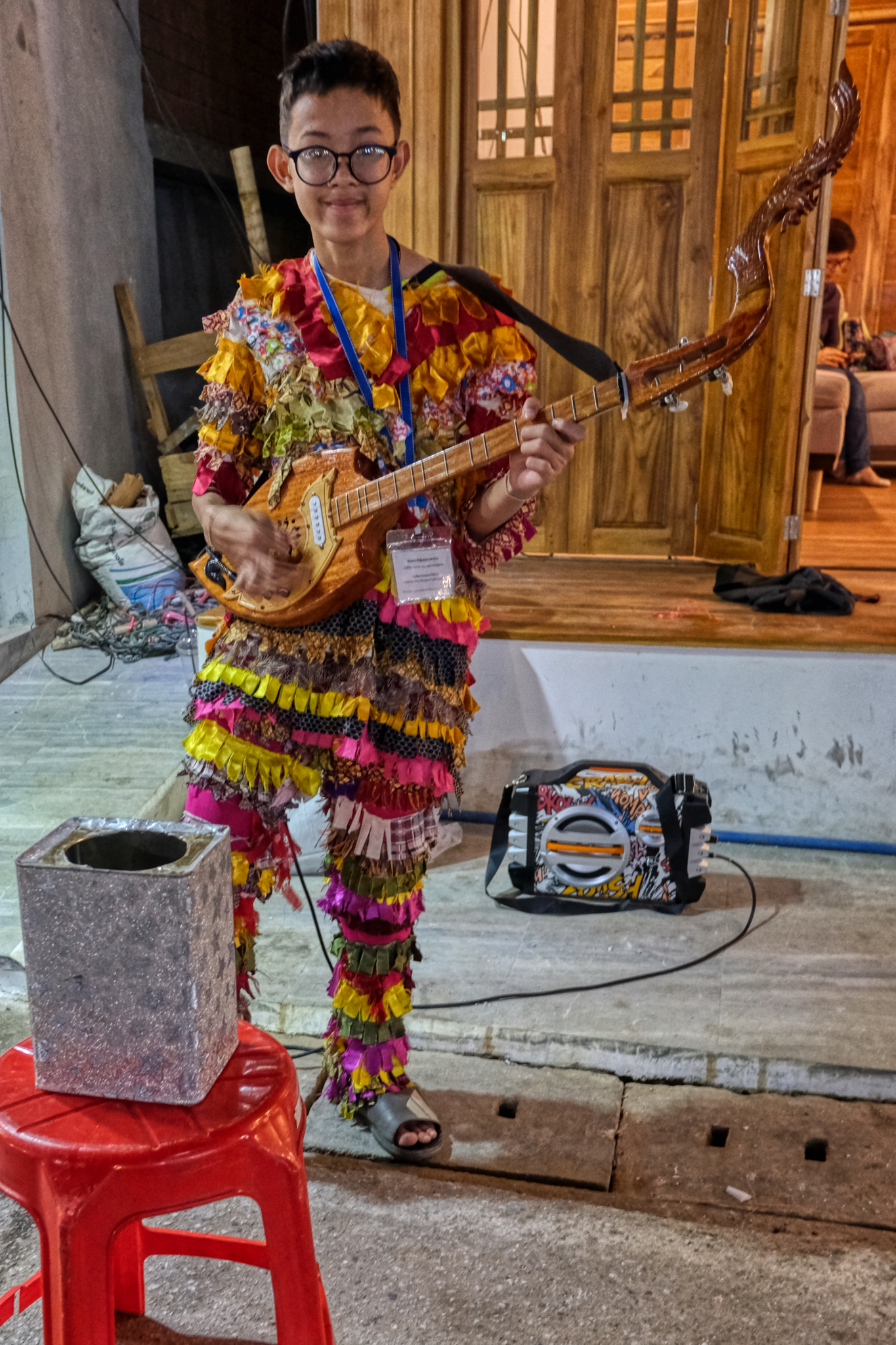 My favorite street performer was this young busker playing electrified traditional old Thai music in a homemade outfit. Cool.
My favorite street performer was this young busker playing electrified traditional old Thai music in a homemade outfit. Cool.
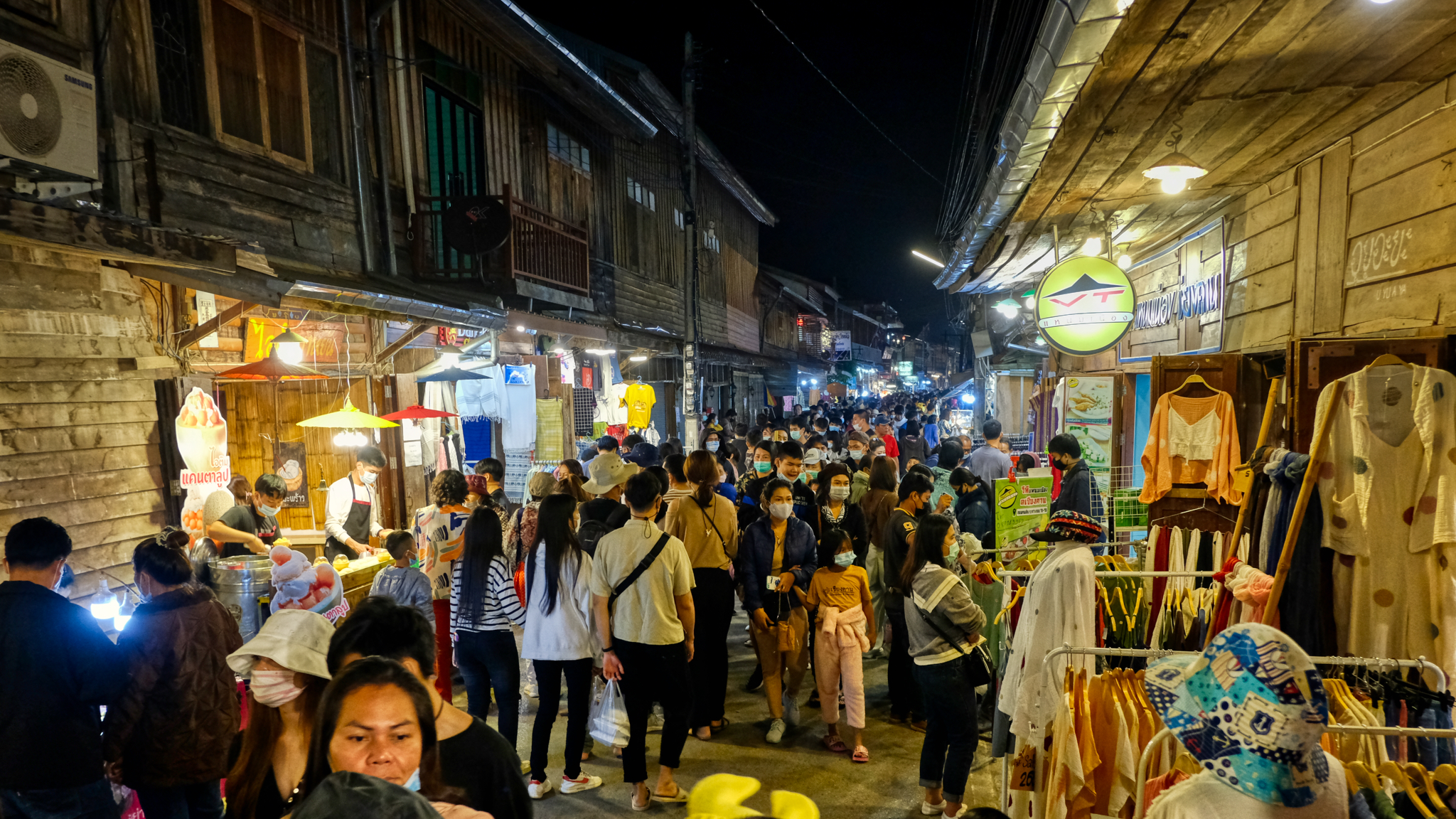 We enjoyed out nights walking along the Chiang Khan night market street.
We enjoyed out nights walking along the Chiang Khan night market street.
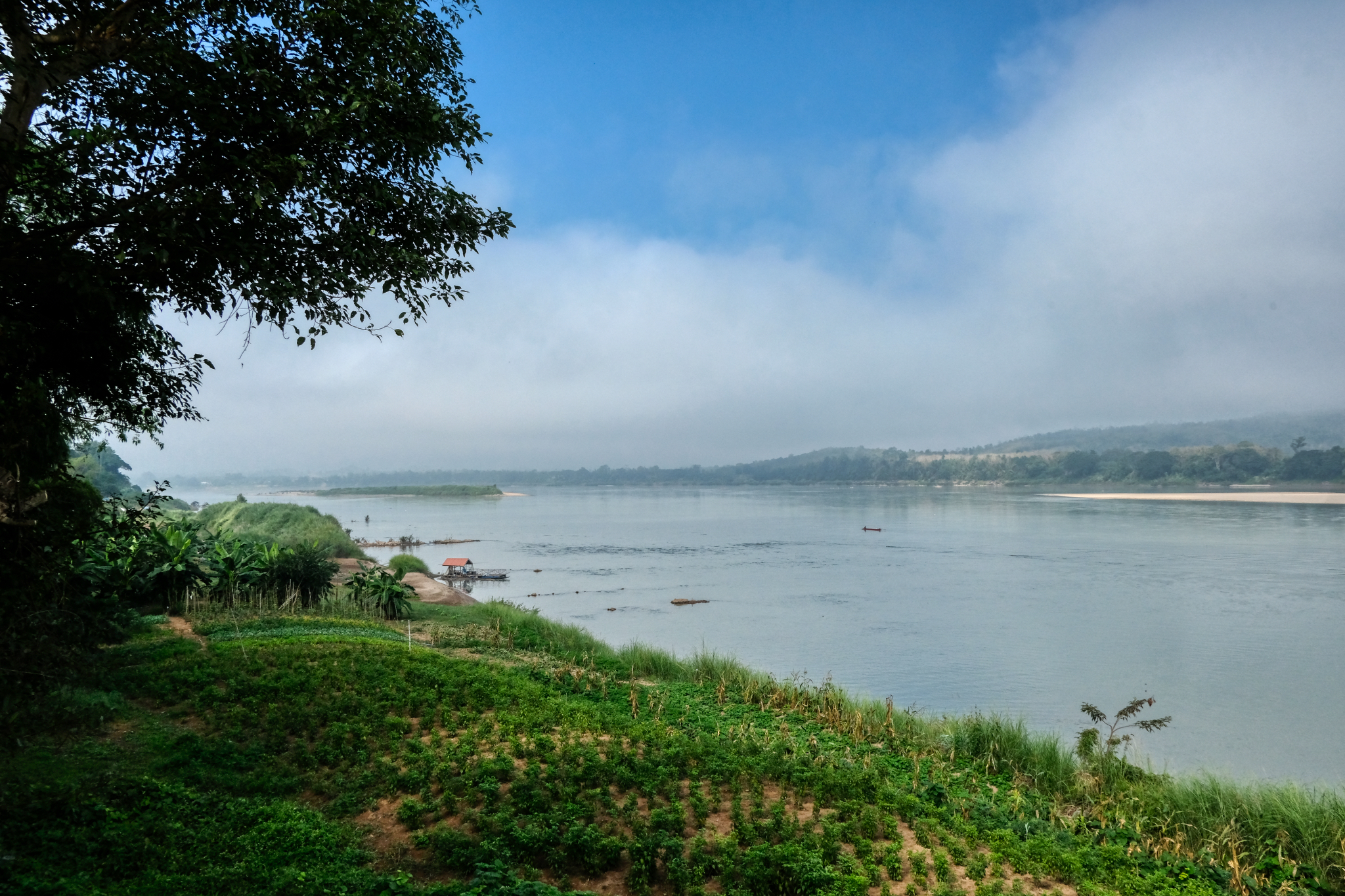 After two nights in Chiang Khan we woke up early and said good-bye to the river and headed south.
After two nights in Chiang Khan we woke up early and said good-bye to the river and headed south.
Khon Kaen
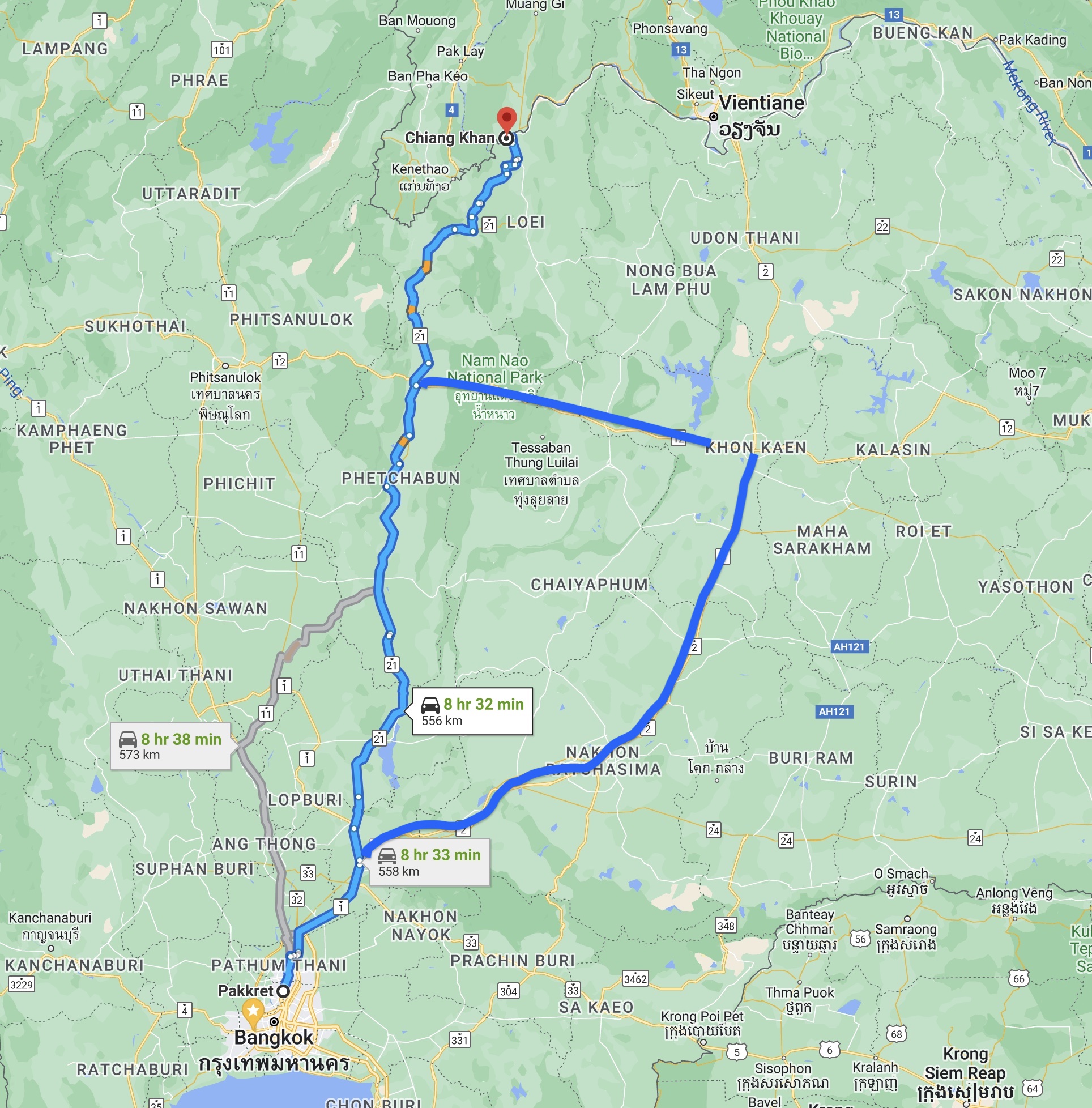 We were about 30 minutes out of Chiang Khan and decided to take a different route home to Bangkok. Neither of us had ever been to Khon Kaen . . . so why not?
We were about 30 minutes out of Chiang Khan and decided to take a different route home to Bangkok. Neither of us had ever been to Khon Kaen . . . so why not?
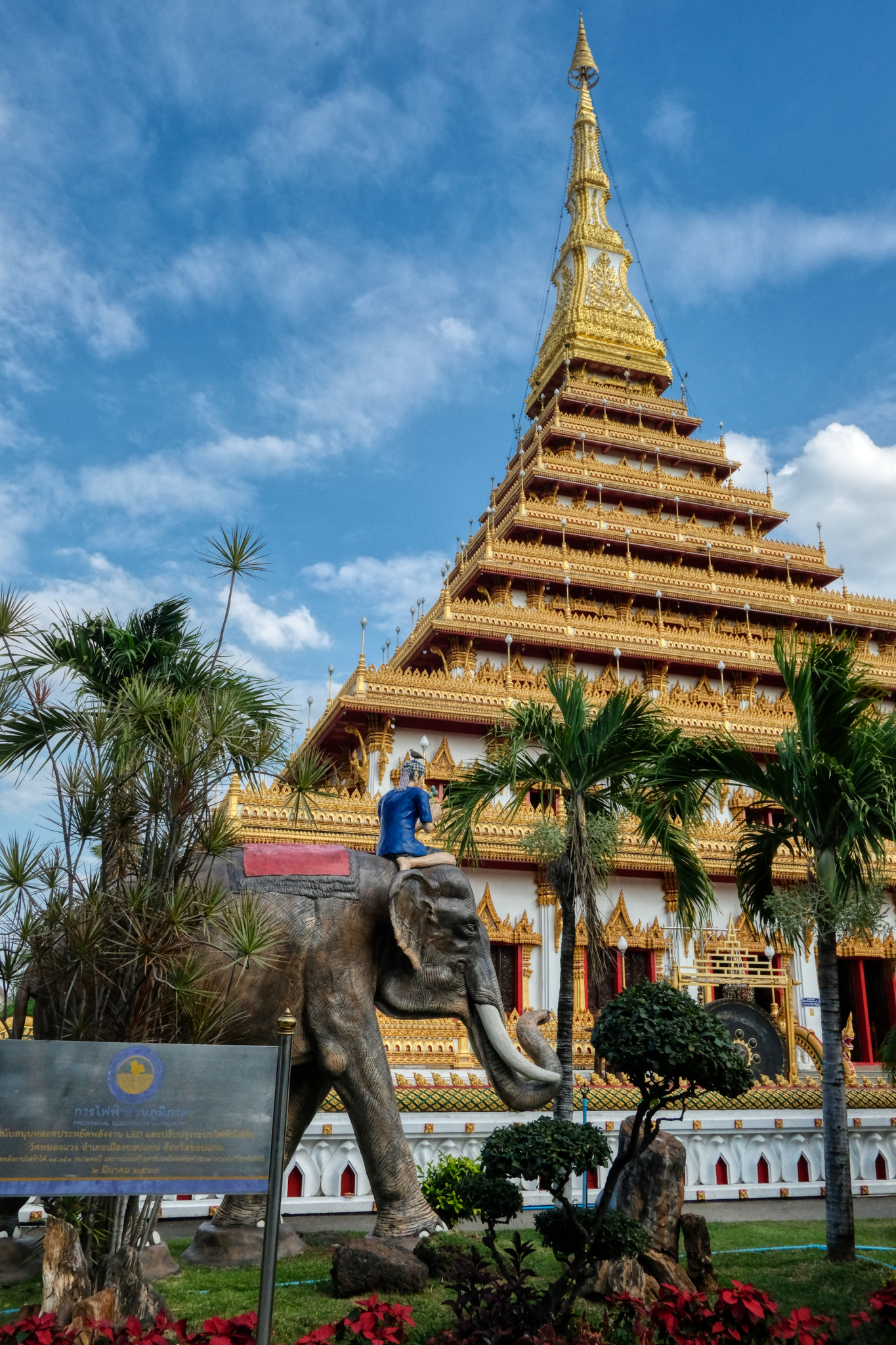 We didn't do too much sightseeing . . . just drove around town . . . found a great restaurant on Google . . . and found this magnificent wat to go in . . .
We didn't do too much sightseeing . . . just drove around town . . . found a great restaurant on Google . . . and found this magnificent wat to go in . . .
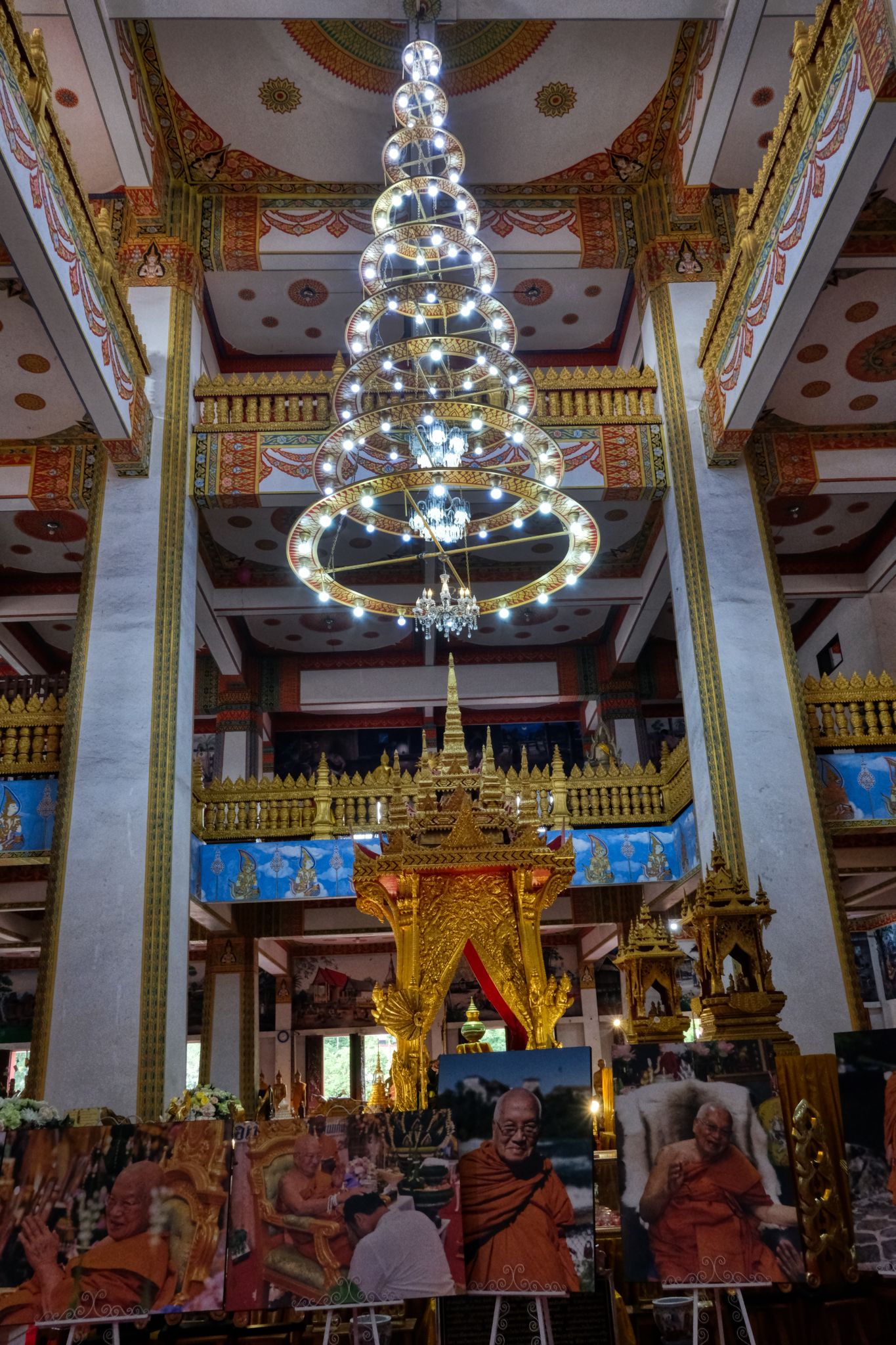 We were very glad we went inside.
We were very glad we went inside.
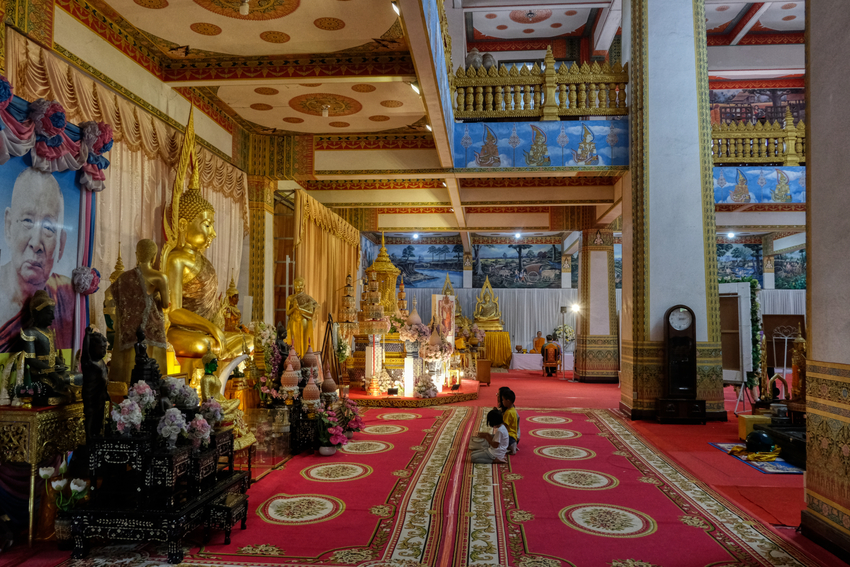 There are many different altars in the large inner space . . . each with a group of people paying respects.
There are many different altars in the large inner space . . . each with a group of people paying respects.
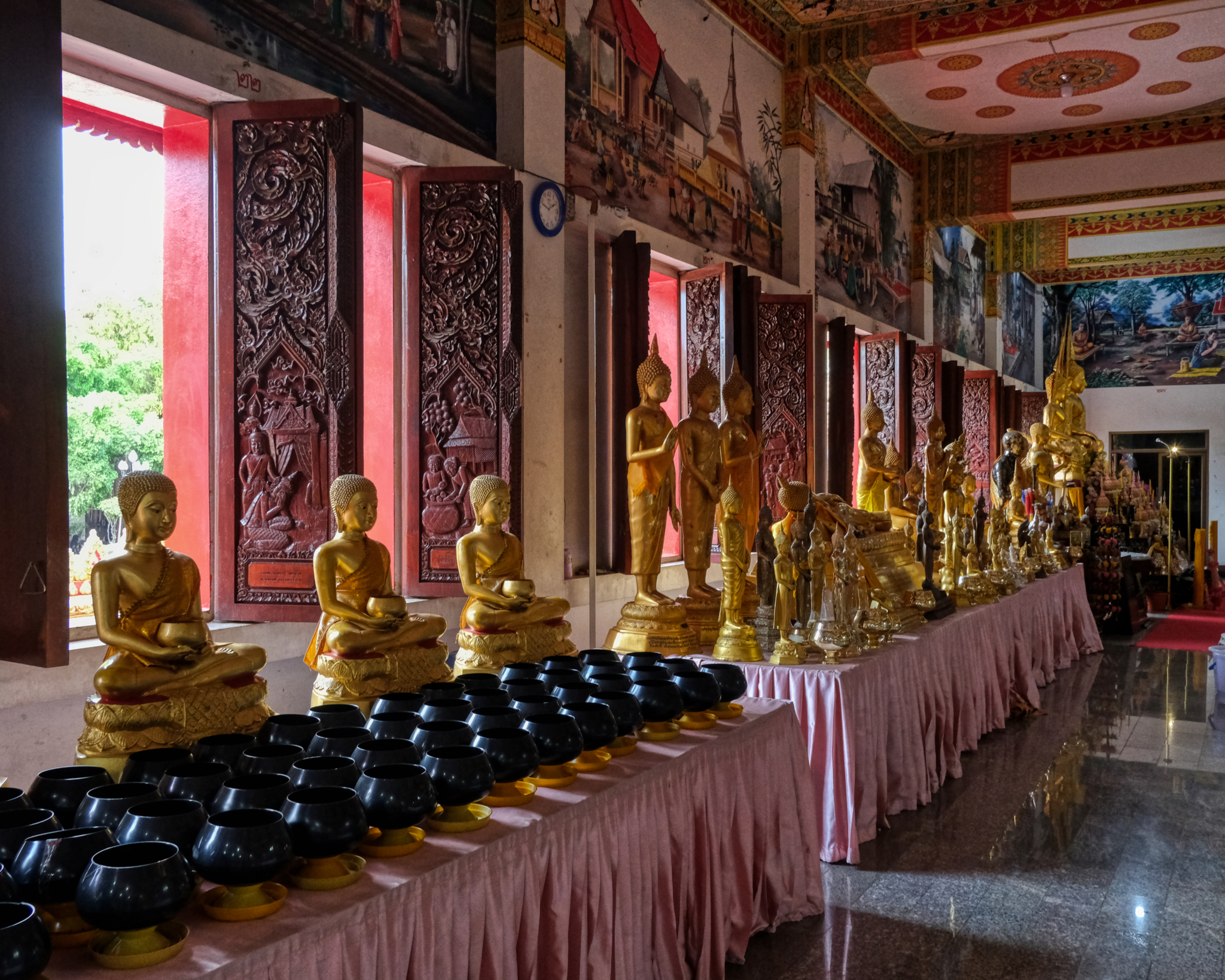 Very special light falling on the various Buddha images.
Very special light falling on the various Buddha images.
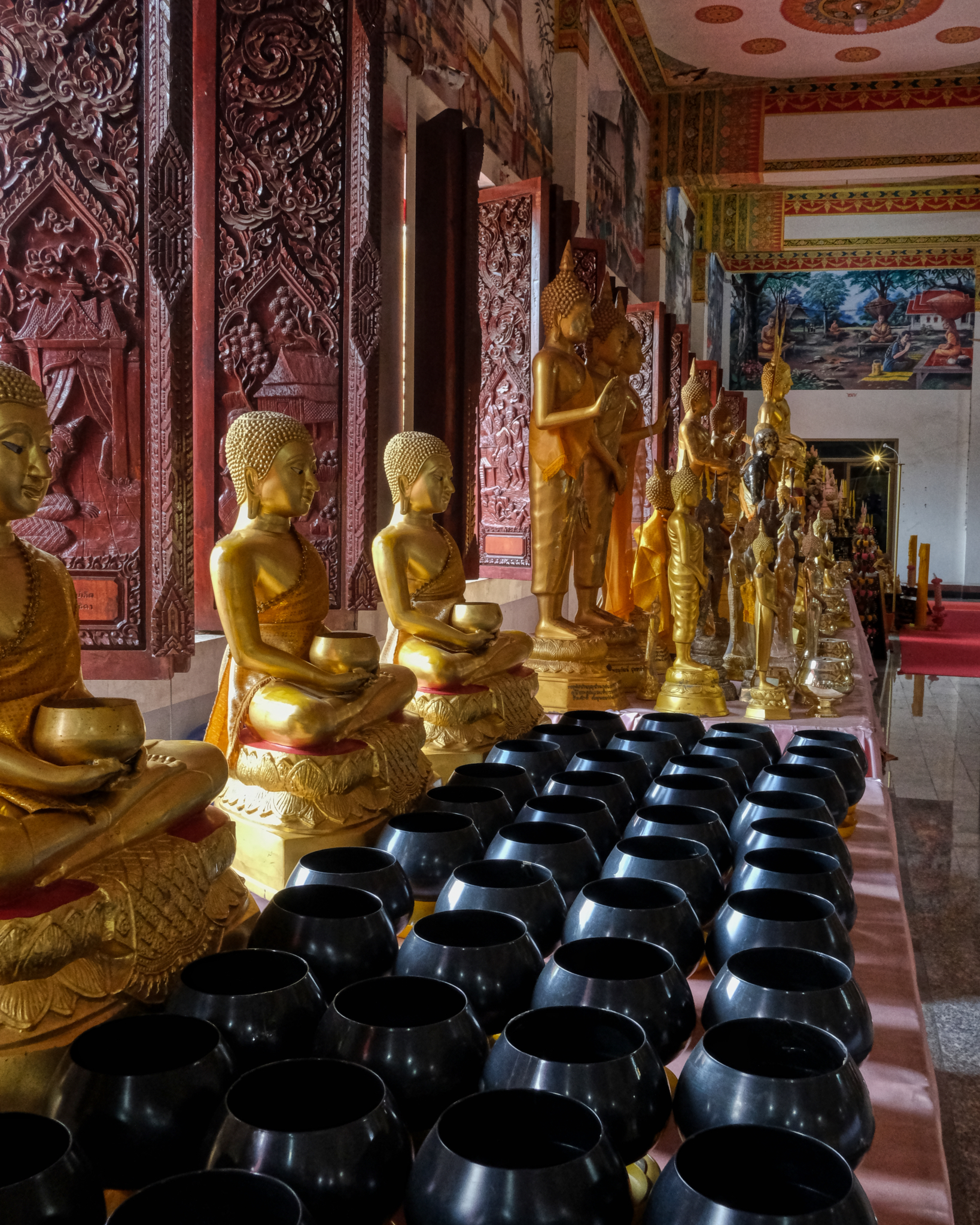 Pots for making donations and making wishes.
Pots for making donations and making wishes.
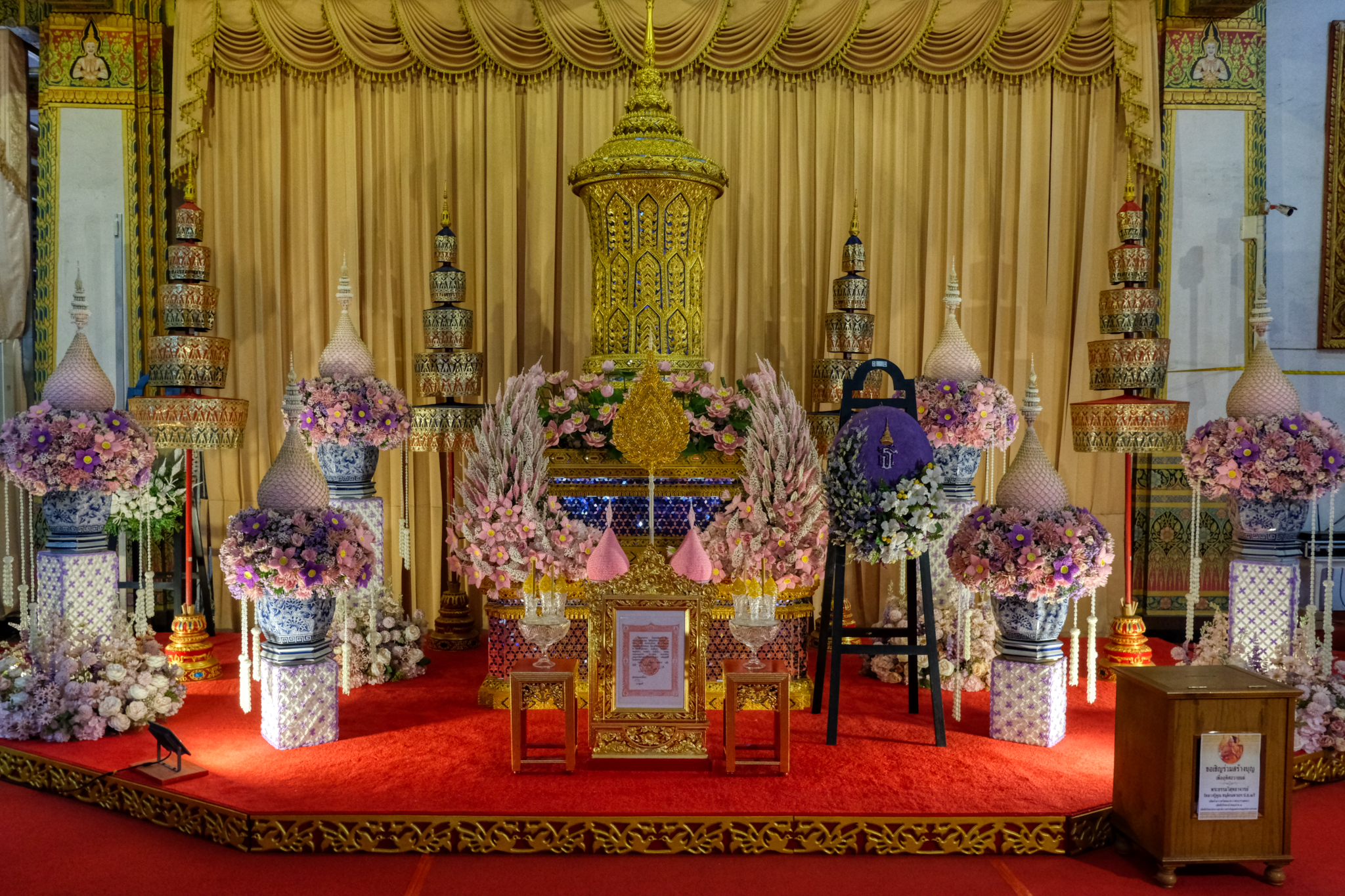 Such a pretty flower memorial altar.
Such a pretty flower memorial altar.
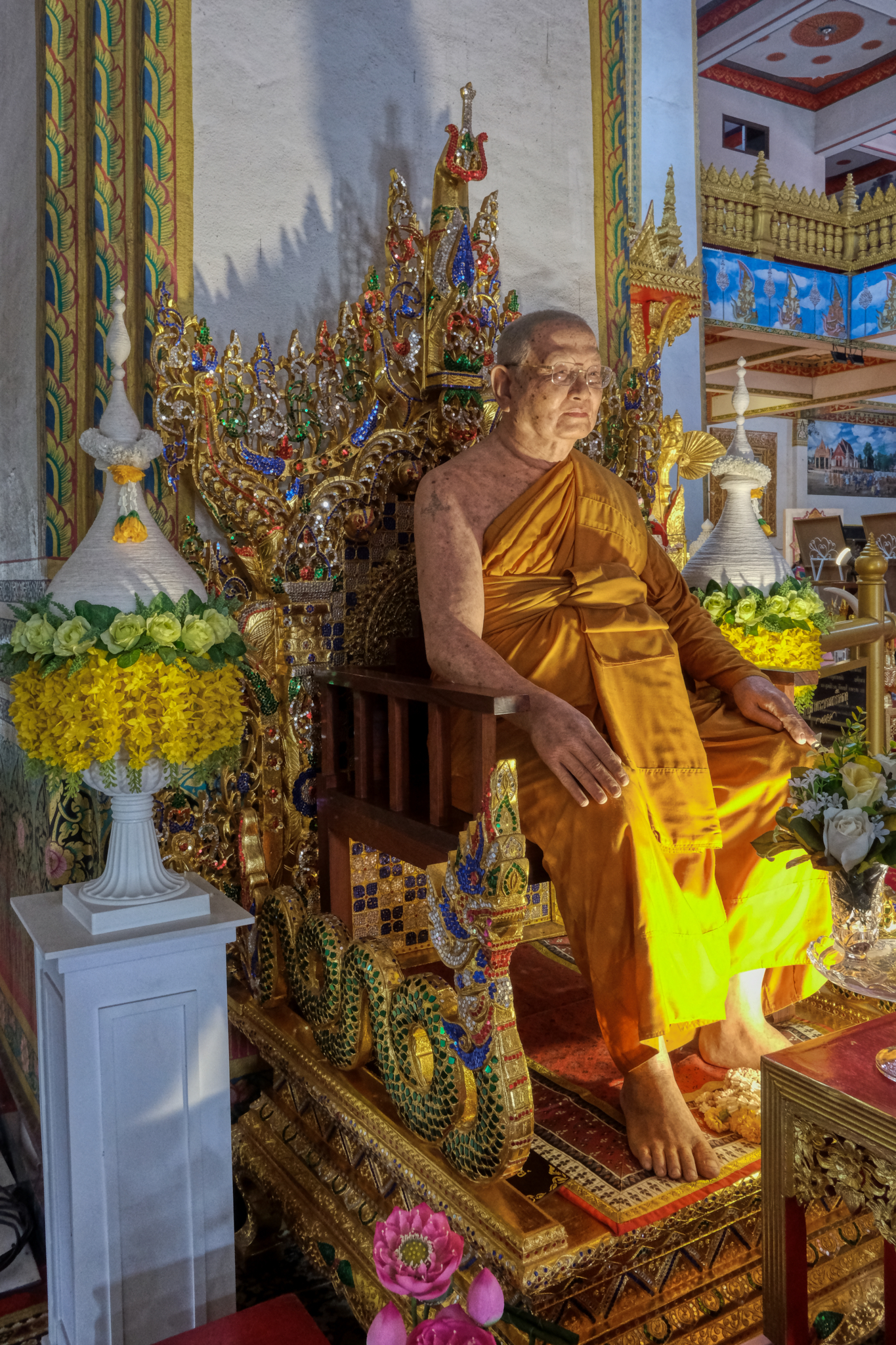 This hyper-realistic wax monk was too realistic . . . and creepy.
This hyper-realistic wax monk was too realistic . . . and creepy.
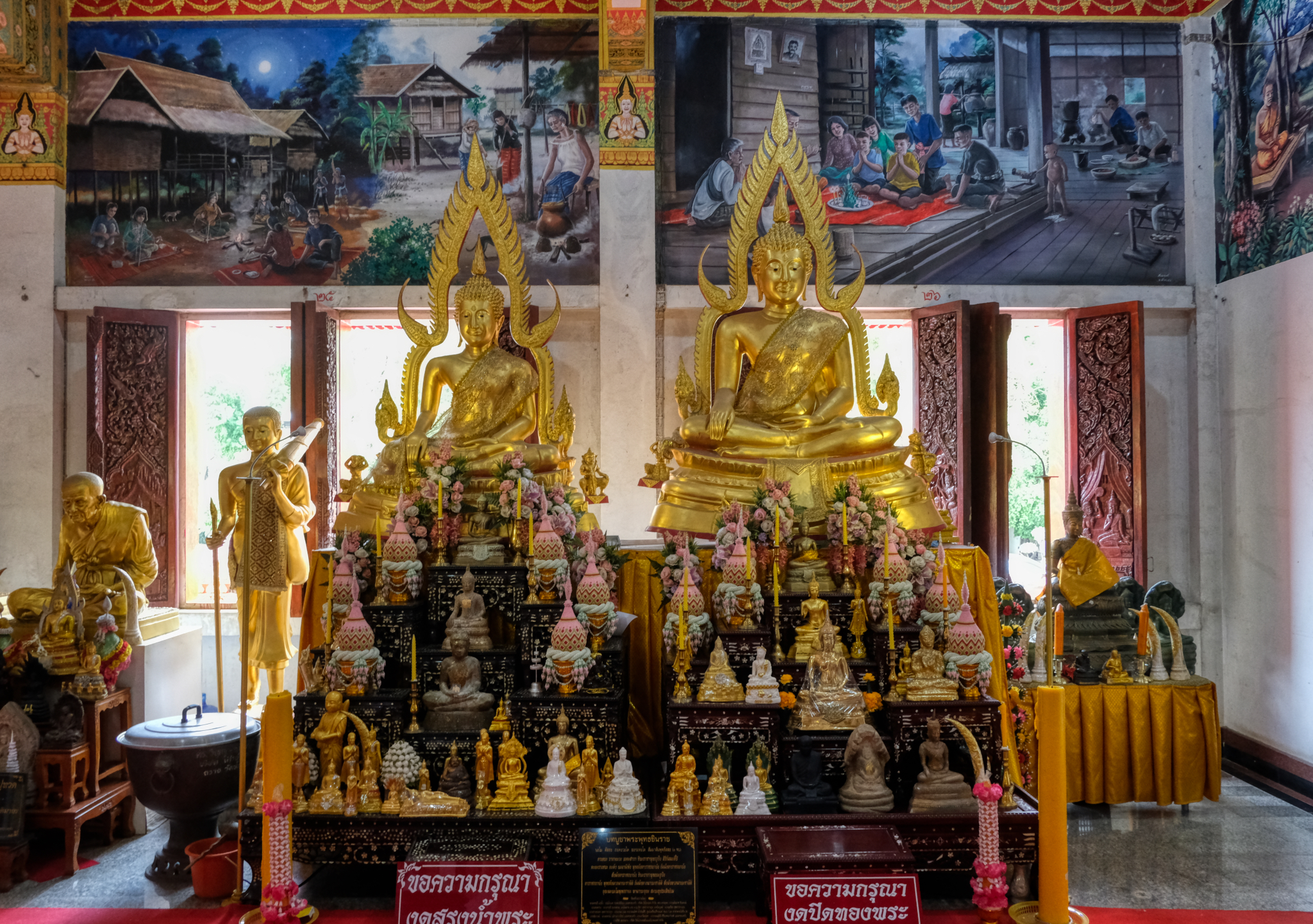 We paid our respects here and then chatted with a monk before leaving. We knew we haddn't spent enough time in Khon Kaen and vowed to return.
We paid our respects here and then chatted with a monk before leaving. We knew we haddn't spent enough time in Khon Kaen and vowed to return.
We left the next morning for a 7 hour drive home.
It had been a wonderful vacation in the middle of the COVID Pandemic!
Ratchaburi Ramble
 Wednesday, April 6, 2022 at 5:36PM
Wednesday, April 6, 2022 at 5:36PM One of the benefits of having a wife who is a serious golfer is that I get to tag along when she goes on an out-of-Bangkok golf junket with her pals. We were on vacation in the seaside town of Hua Hin and made the short drive north to the Ratchaburi Royal Golf Club early one morning after a spactacular sunrise over the Gulf of Thailand . . . . and while she played a competitive round, I explored the nearby countryside, the old town market in Ratchaburi town, and the 10th century Wat Mahathat Worawihan.
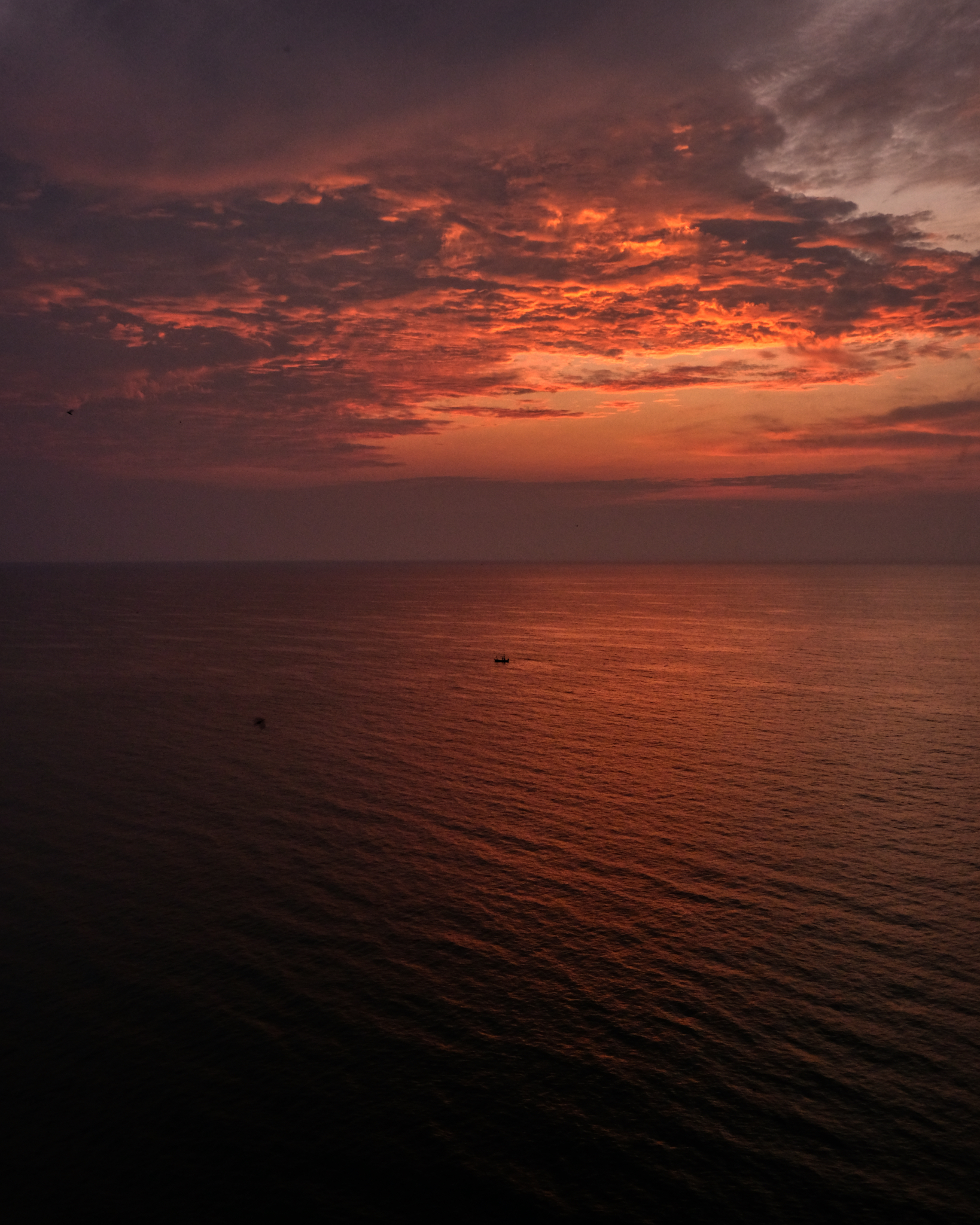 It's nice to sit on the balcony drinking the the first morning cup of coffee while the sun is rising over the Gulf of Thailand. The squid fishermen were returning with their catch after having been out to sea all night.
It's nice to sit on the balcony drinking the the first morning cup of coffee while the sun is rising over the Gulf of Thailand. The squid fishermen were returning with their catch after having been out to sea all night.
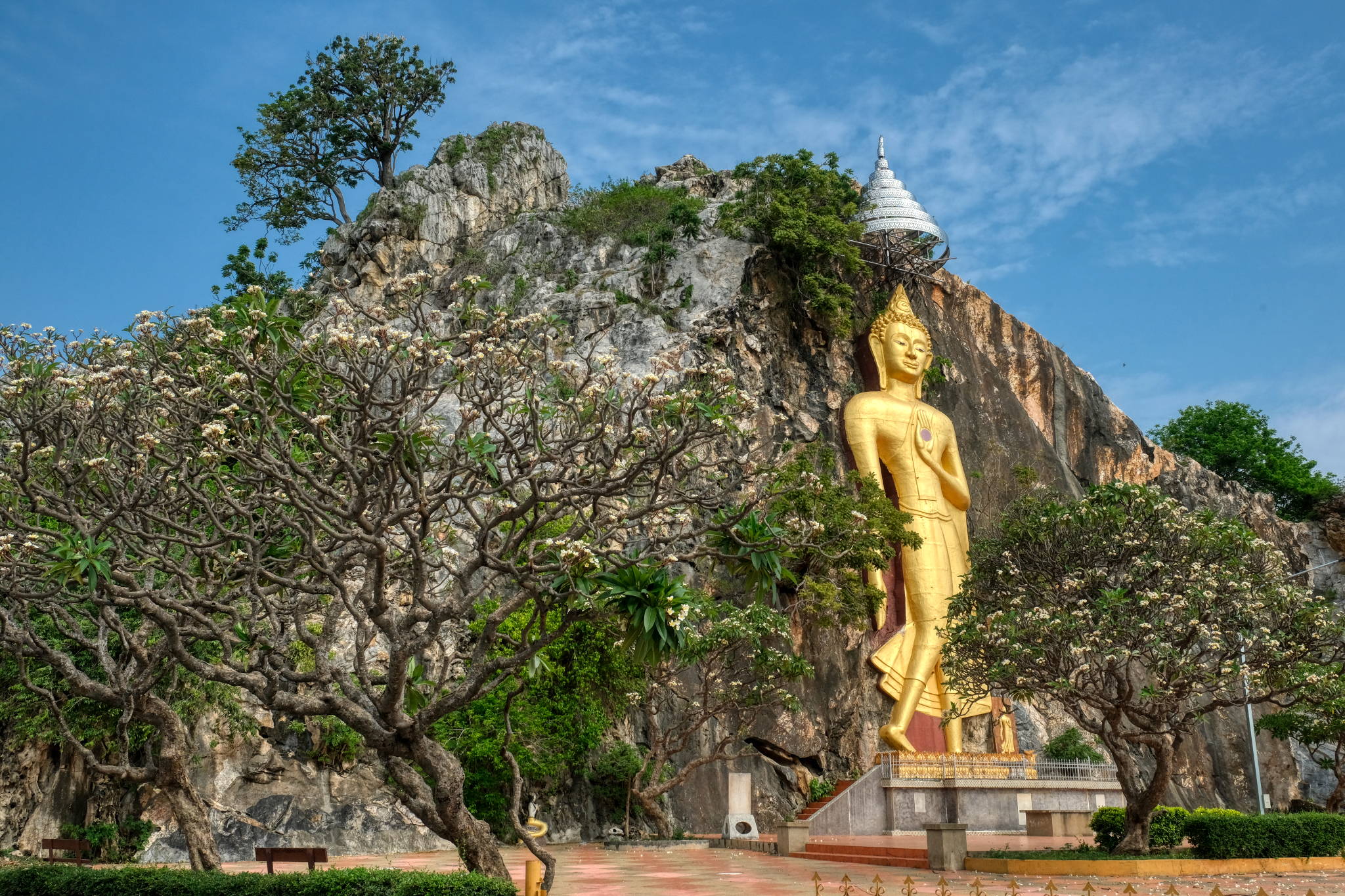 Along the Ratchaburi highway . . . a giant Buddha statue . . . without a place name.
Along the Ratchaburi highway . . . a giant Buddha statue . . . without a place name.
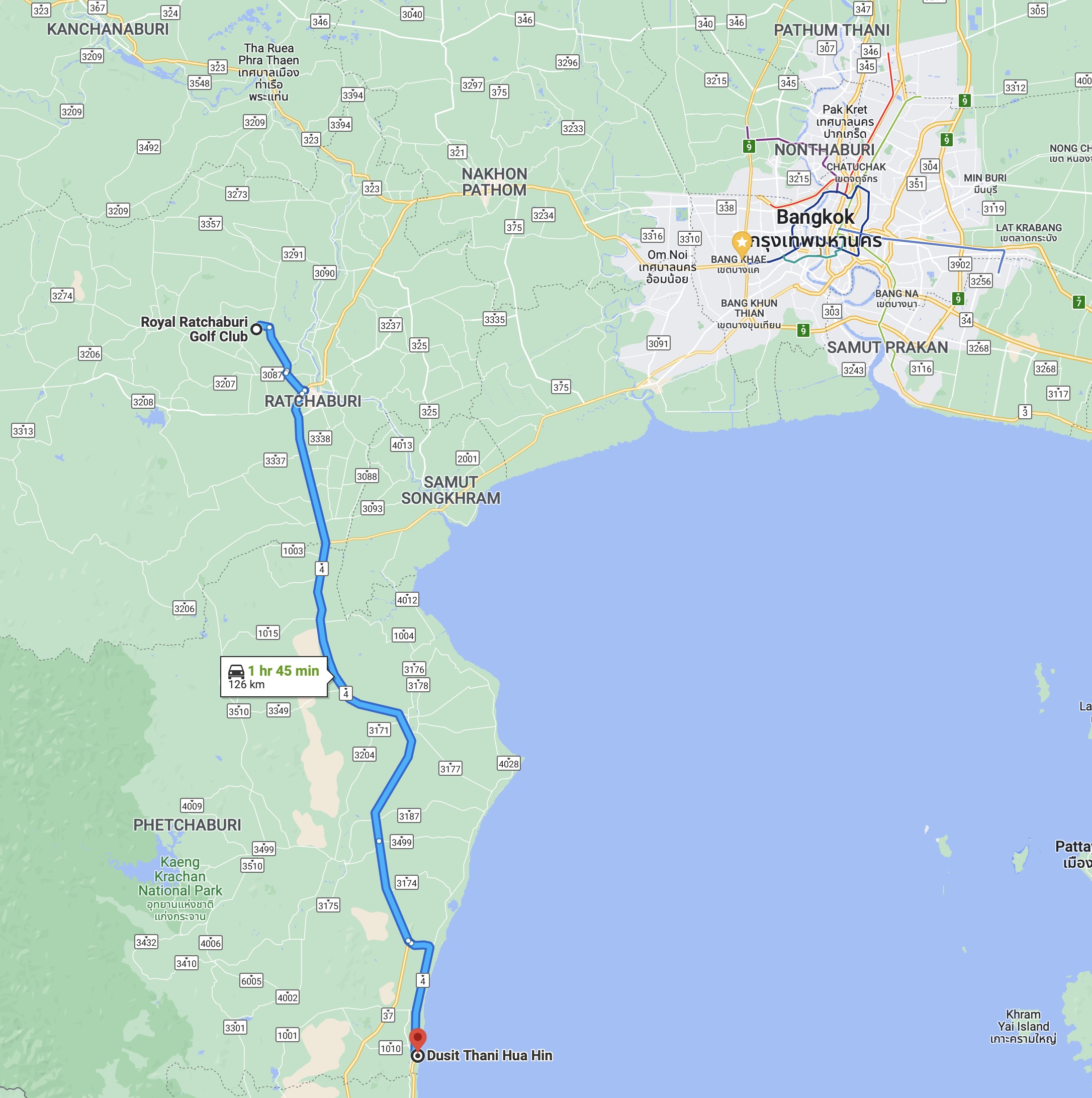 Only an hour and 45 minutes away . . . up and into the hilly Ratchaburi Province.
Only an hour and 45 minutes away . . . up and into the hilly Ratchaburi Province.
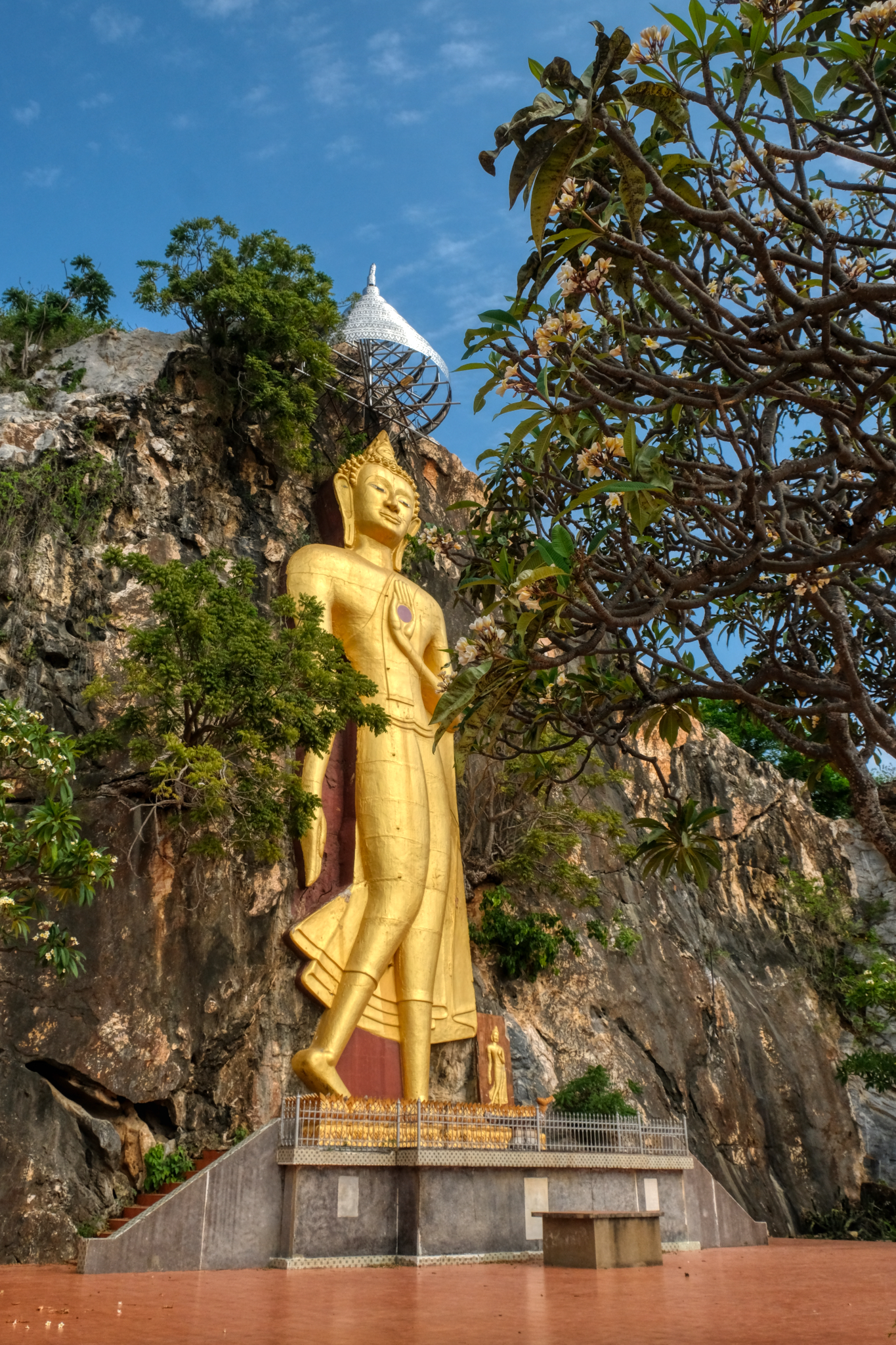 Small provincial roads in Thailand always serve up some amazing sights.
Small provincial roads in Thailand always serve up some amazing sights.
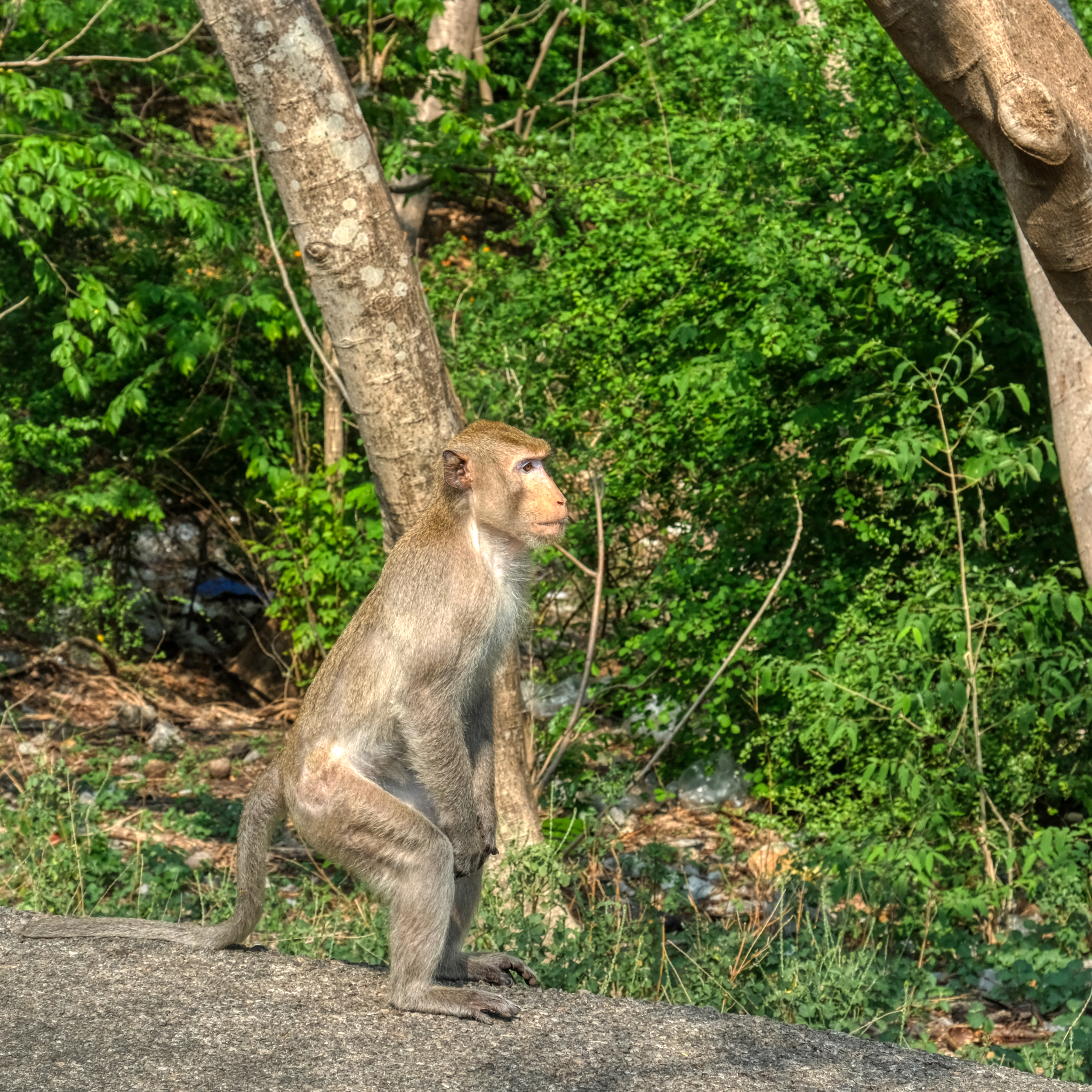 Yes, they have monkeys in Thailand. This one, and about 20 of his buddies kept me from leaving my car to walk up a trail to a large cave Buddha temple.
Yes, they have monkeys in Thailand. This one, and about 20 of his buddies kept me from leaving my car to walk up a trail to a large cave Buddha temple.
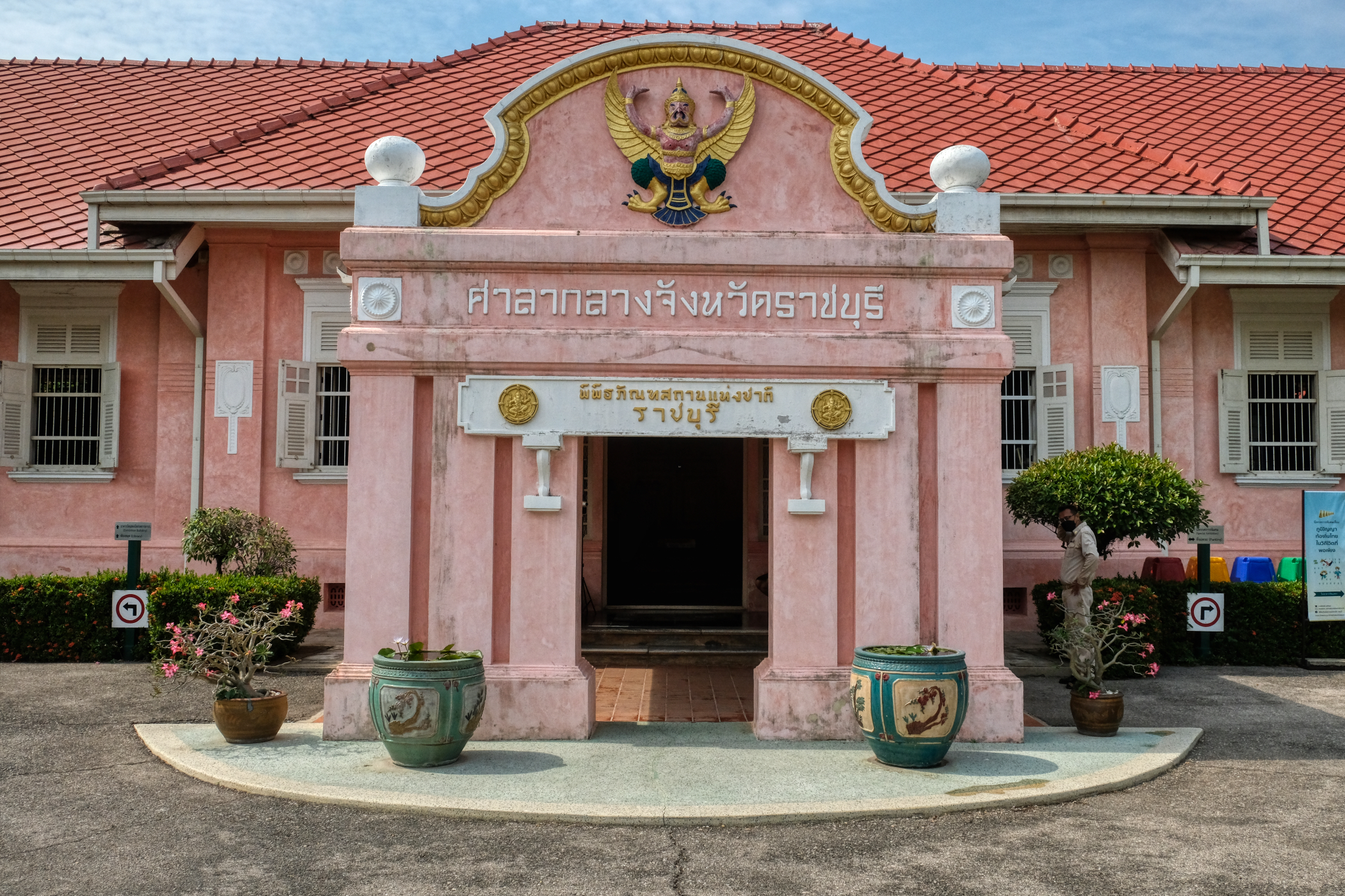 As I was on a 'ramble', I had no particular place to go. I made my way to Ratchaburi, a town I had never visited. I arrived in Ratchaburi on small roads and on the outskirts of town I discovered this wonderful place: The Ratchaburi National Museum.
As I was on a 'ramble', I had no particular place to go. I made my way to Ratchaburi, a town I had never visited. I arrived in Ratchaburi on small roads and on the outskirts of town I discovered this wonderful place: The Ratchaburi National Museum.
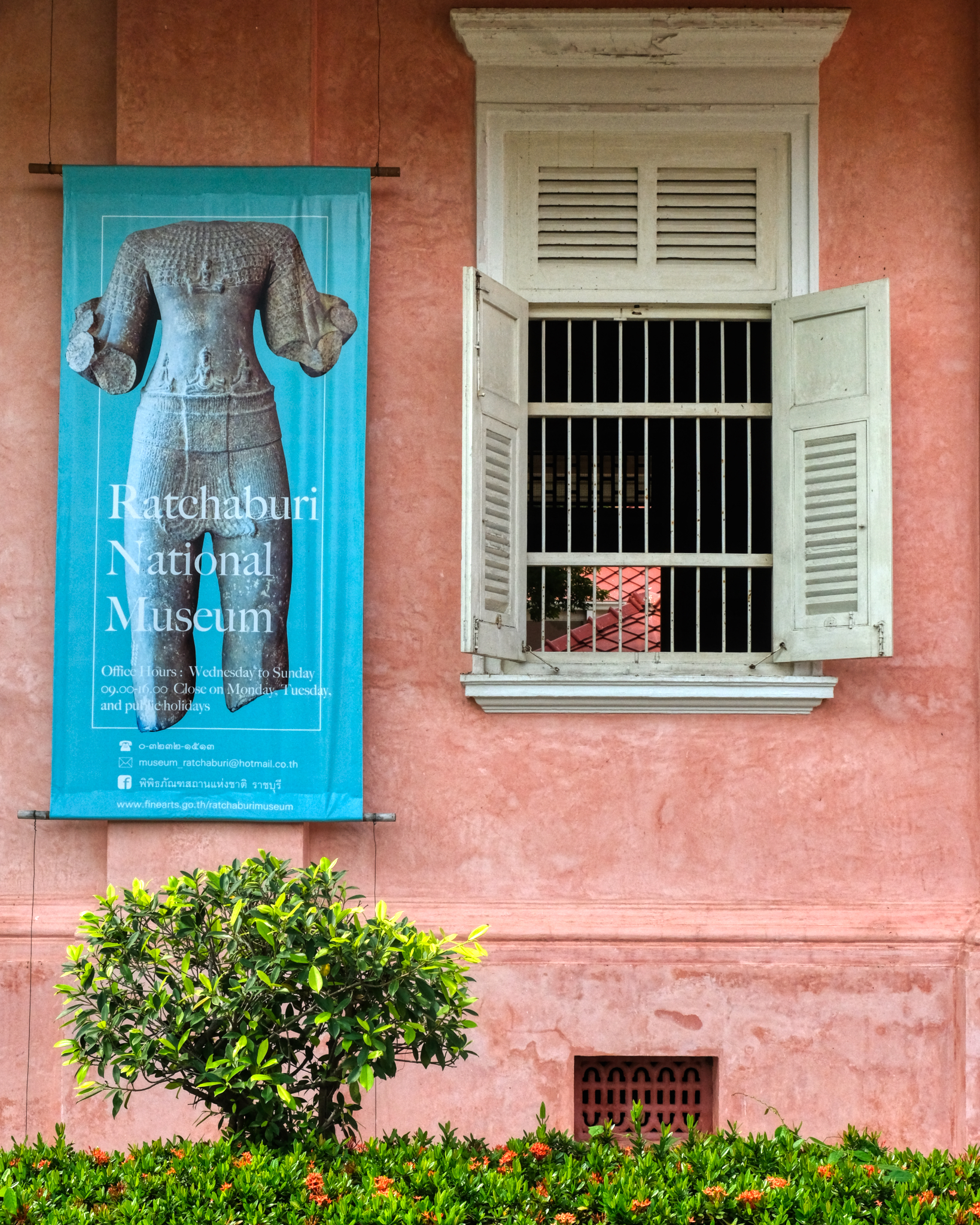 It was a gorgeous building . . . old Thai monumental style.
It was a gorgeous building . . . old Thai monumental style.
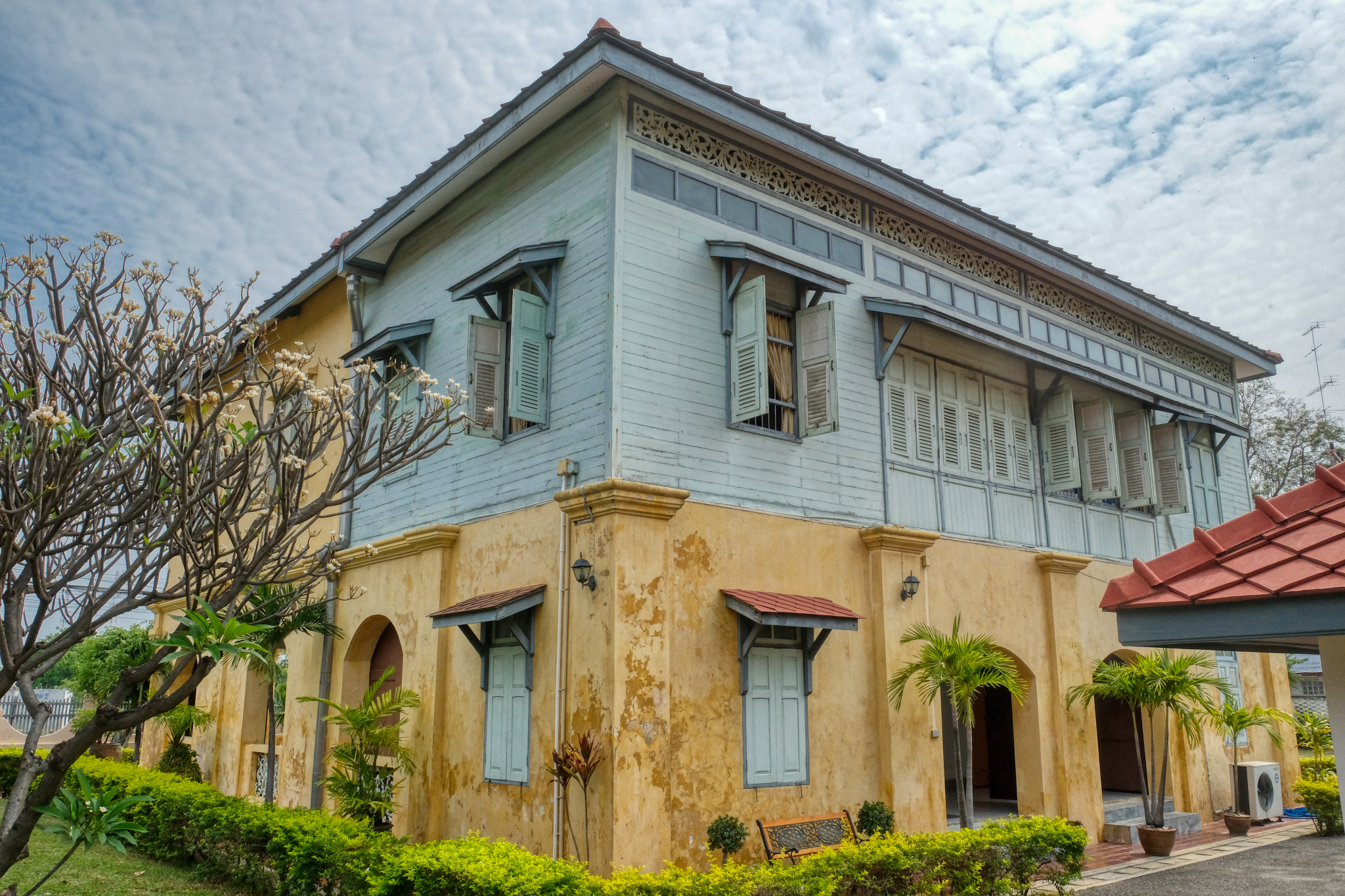 There were two buildings on the museum property. I adored the patina, color, and style of this old gem.
There were two buildings on the museum property. I adored the patina, color, and style of this old gem.
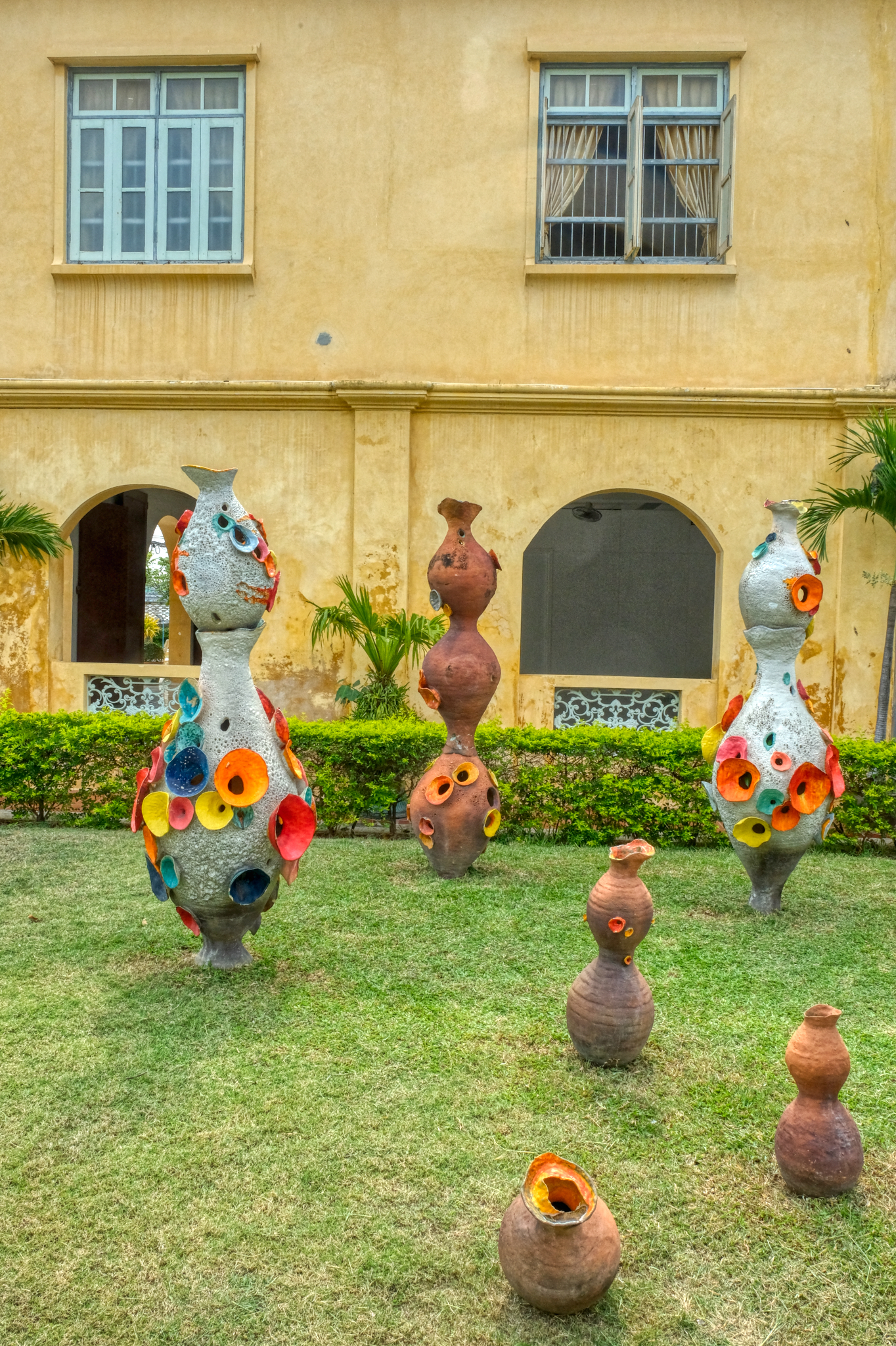 Being a museum, they had yard art too.
Being a museum, they had yard art too.
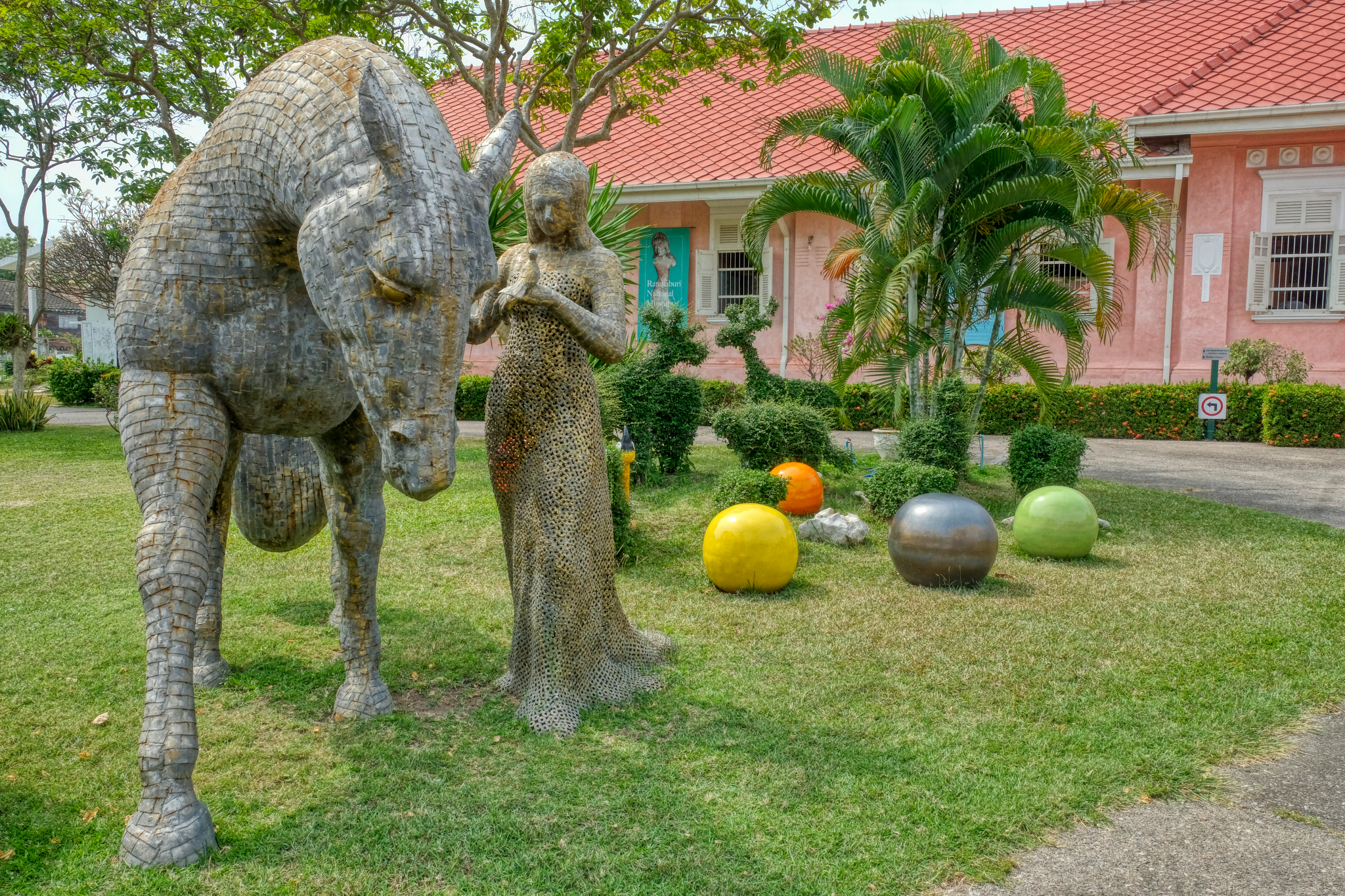 This large metal sculpture was fantastic.
This large metal sculpture was fantastic.
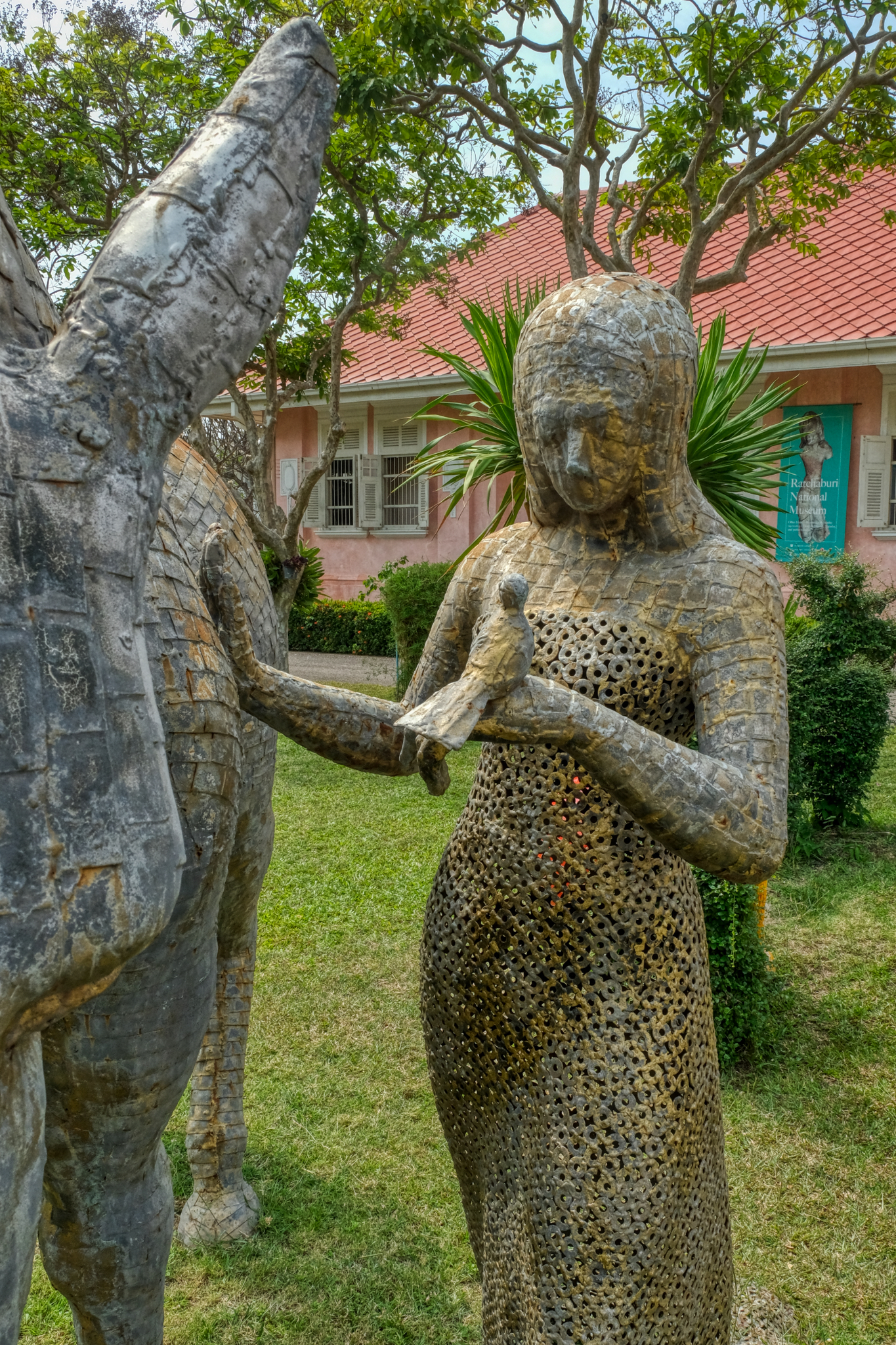 Made entirely of ordinary steel washers and small squares of steel. Amazing.
Made entirely of ordinary steel washers and small squares of steel. Amazing.
 The museum rules strictly prohibited photography of the exhibits . . . and they enforced this rule by having one of the museum staff follow me from room to room. They did, however, allow me to photograph the halls and courtyard when I asked.
The museum rules strictly prohibited photography of the exhibits . . . and they enforced this rule by having one of the museum staff follow me from room to room. They did, however, allow me to photograph the halls and courtyard when I asked.
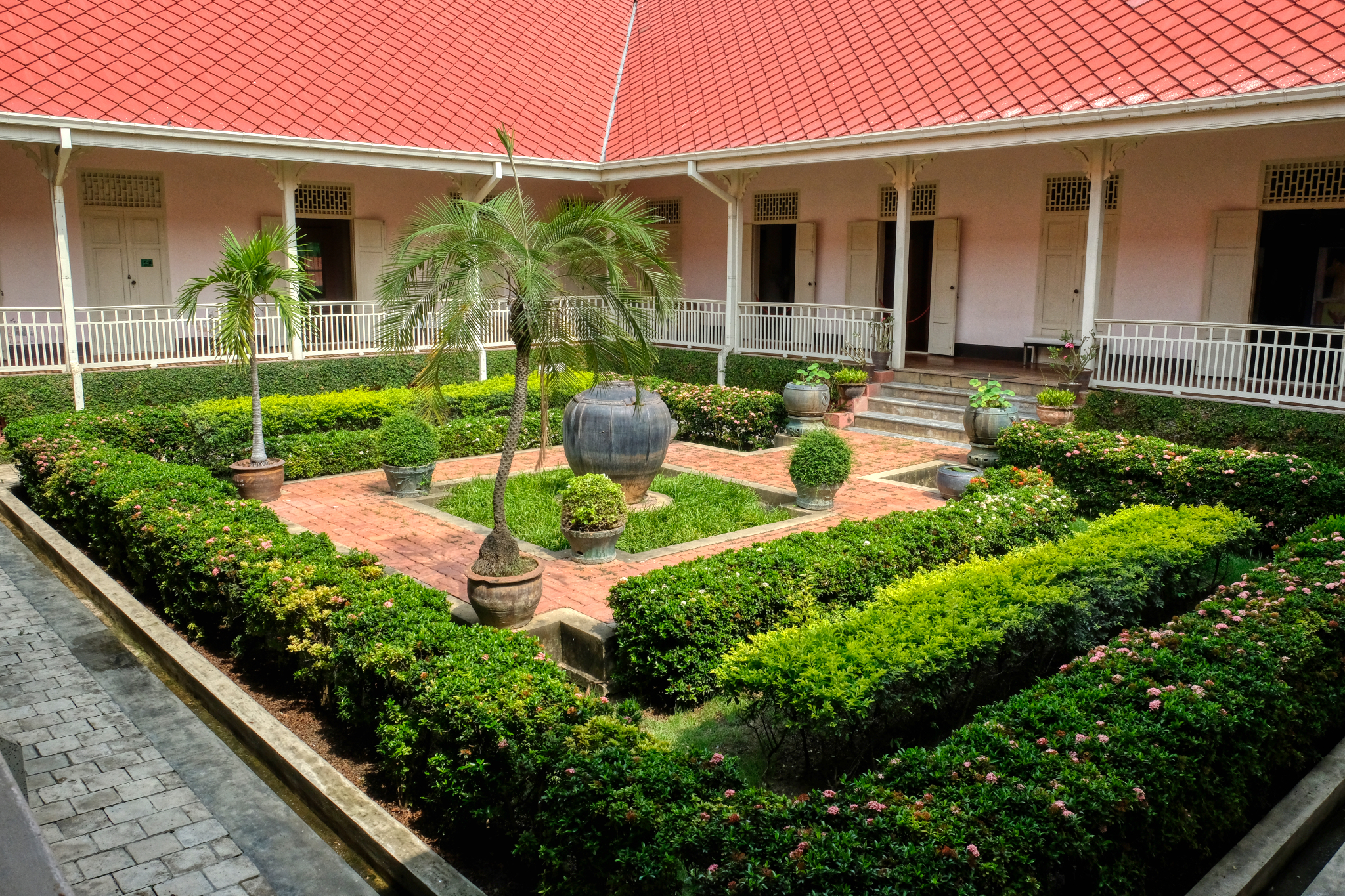 The museum collection was excellent and very well organized. The exhibits began in prehistory and ancient geology of the area and proceeded chronologically as you walked from room to room around the courtyard. It was one of the best, most informative provincial museums I have been to anywhere in the world.
The museum collection was excellent and very well organized. The exhibits began in prehistory and ancient geology of the area and proceeded chronologically as you walked from room to room around the courtyard. It was one of the best, most informative provincial museums I have been to anywhere in the world.
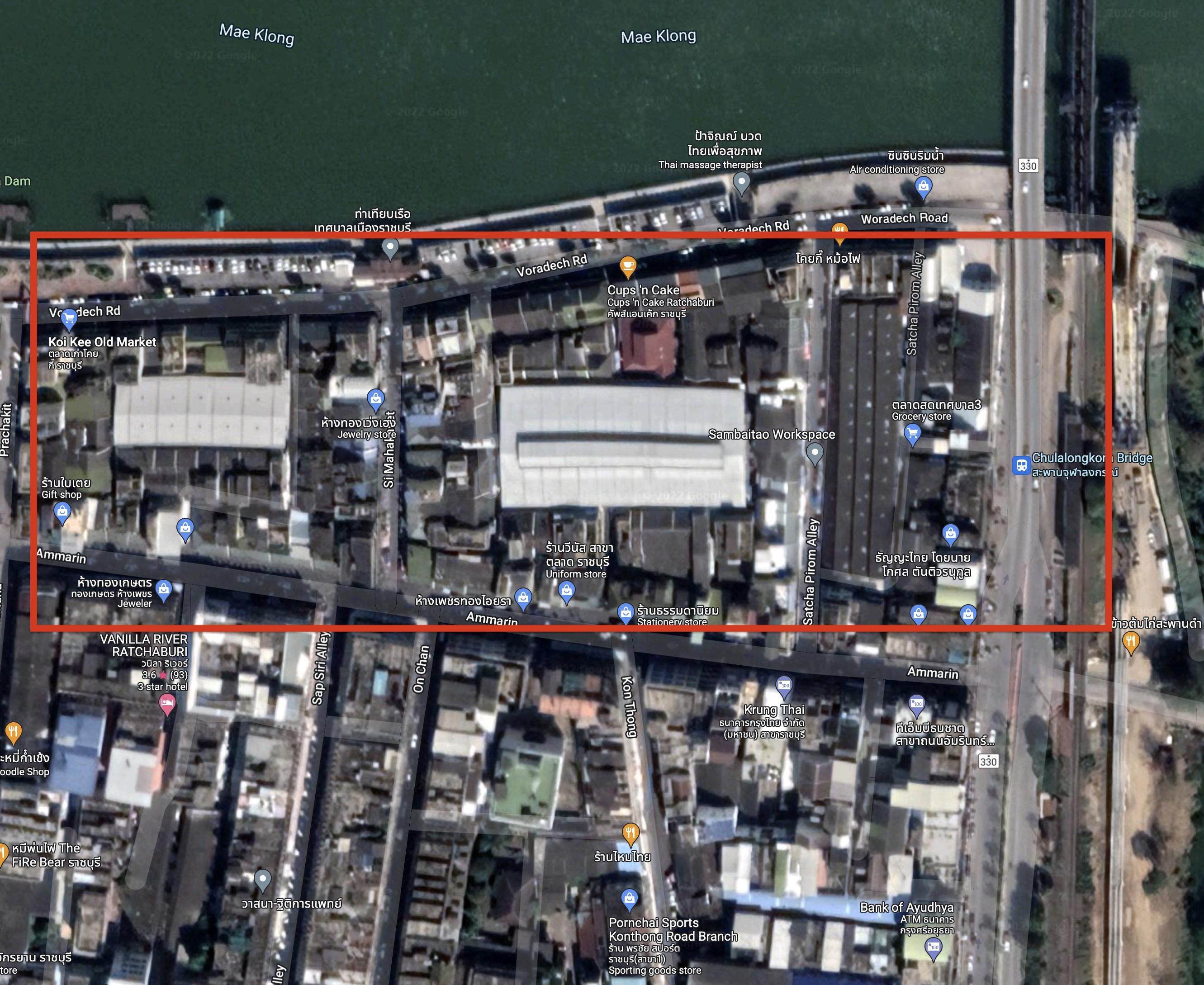 I next drove into the town center and the old city center market. The market occupies the inside center alleyways of several blocks along the Mae Klong River.
I next drove into the town center and the old city center market. The market occupies the inside center alleyways of several blocks along the Mae Klong River.
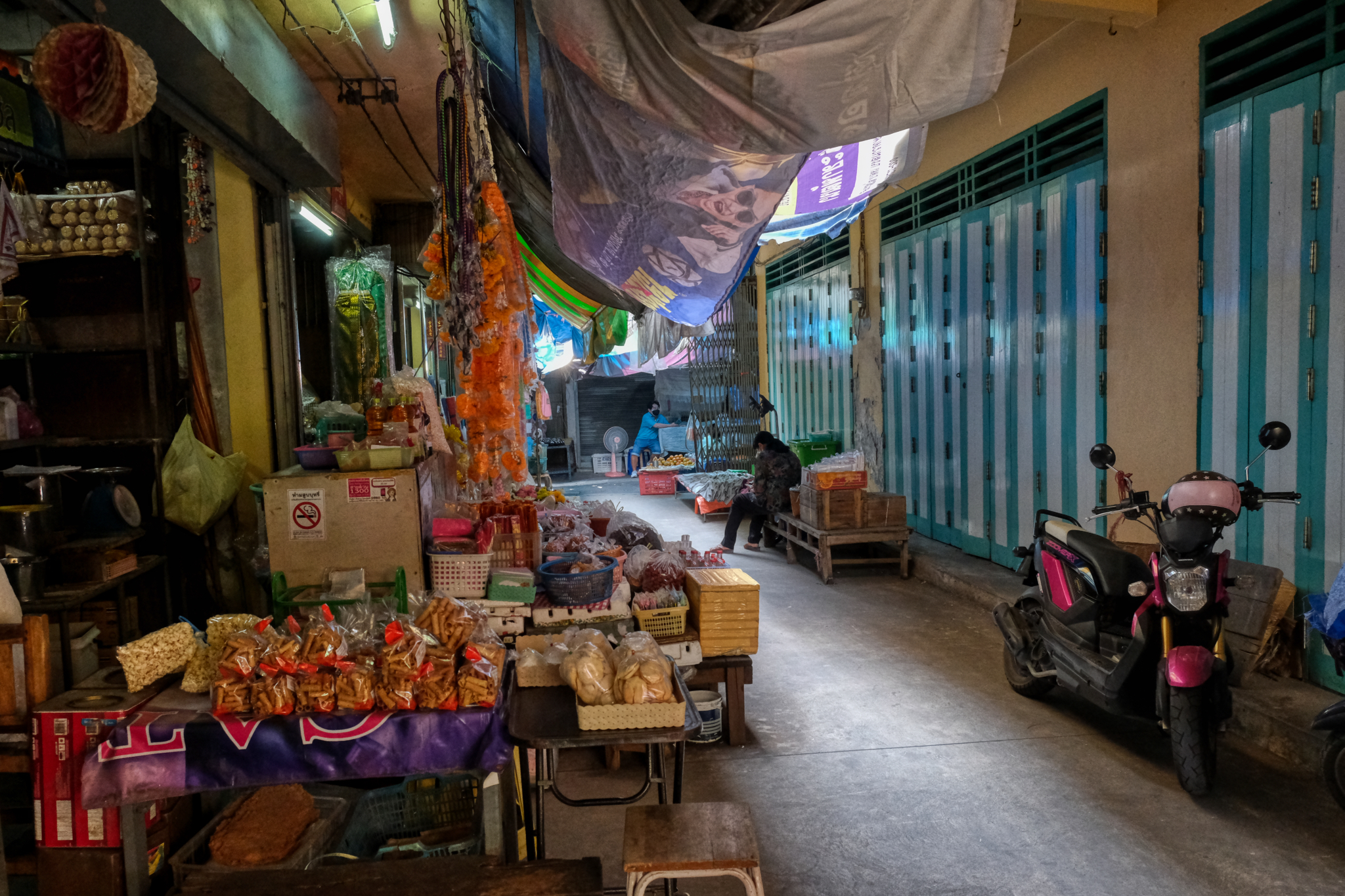 As I left the museum I looked on my GoogleMaps and spotted a river and "Old Town Market" . . . so I drove straight there. I love these old town, city center markets in Thailand's small cities. This market would have been in it's prime during the 1950s and 1960s.
As I left the museum I looked on my GoogleMaps and spotted a river and "Old Town Market" . . . so I drove straight there. I love these old town, city center markets in Thailand's small cities. This market would have been in it's prime during the 1950s and 1960s.
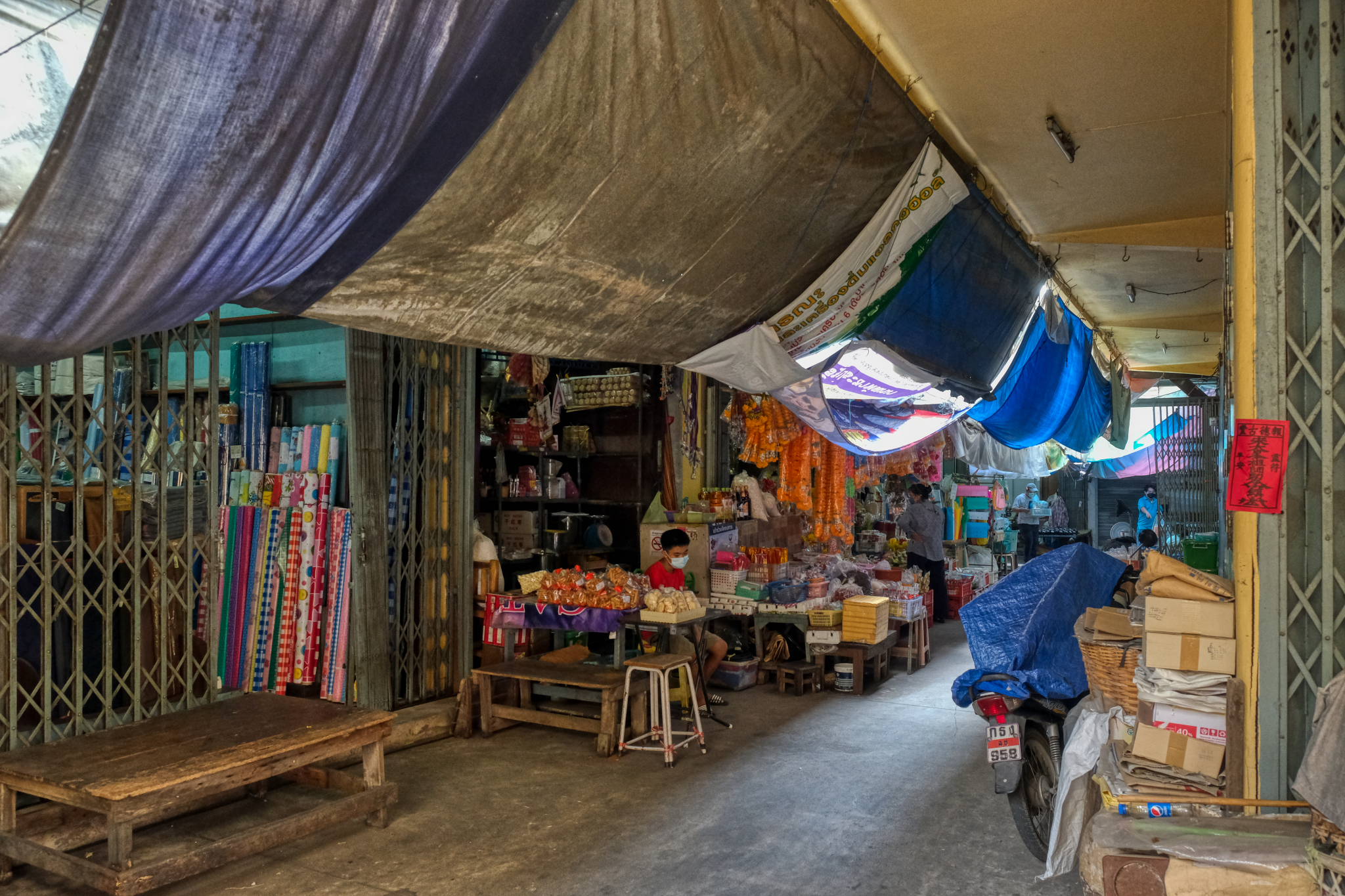 The old markets are the remnants of the oldest parts of Thai cities and maintain an older way of doing business.
The old markets are the remnants of the oldest parts of Thai cities and maintain an older way of doing business.
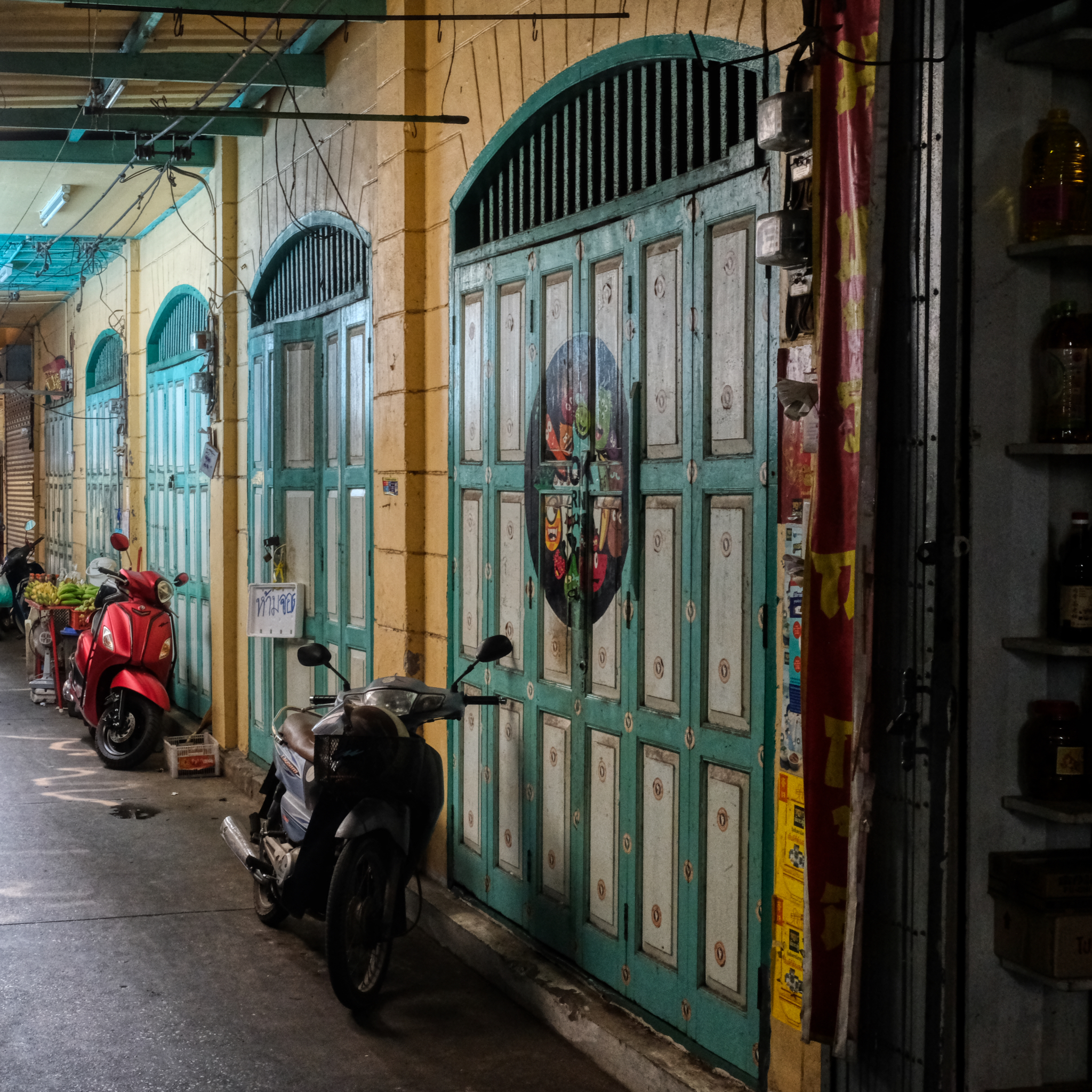 The city or local area government seems to have taken an interest in this old market. Many of the walls and old panel doors seem to have been painted recently. It looked very good.
The city or local area government seems to have taken an interest in this old market. Many of the walls and old panel doors seem to have been painted recently. It looked very good.
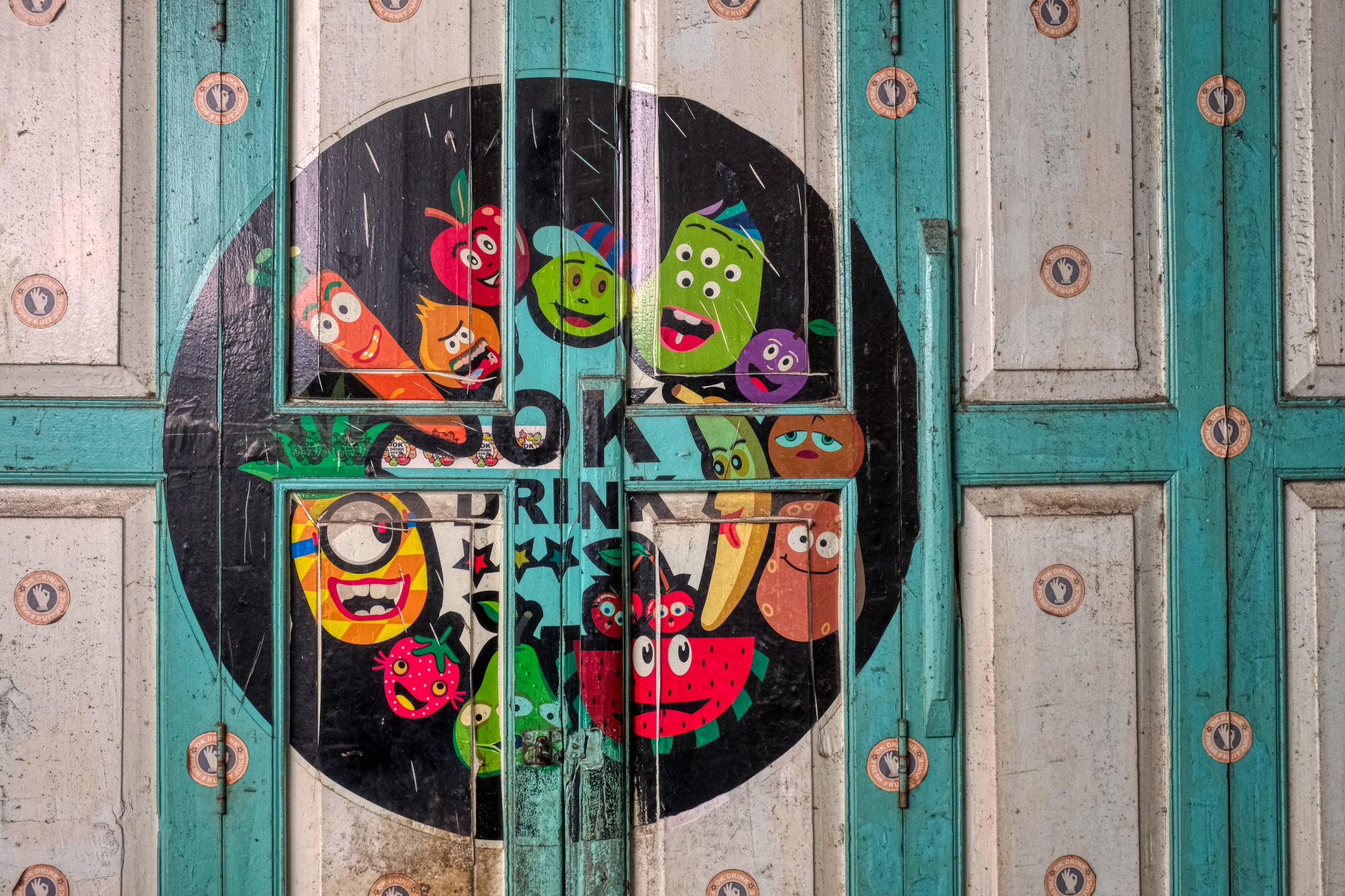 A colorful advertisement on the panel doors.
A colorful advertisement on the panel doors.
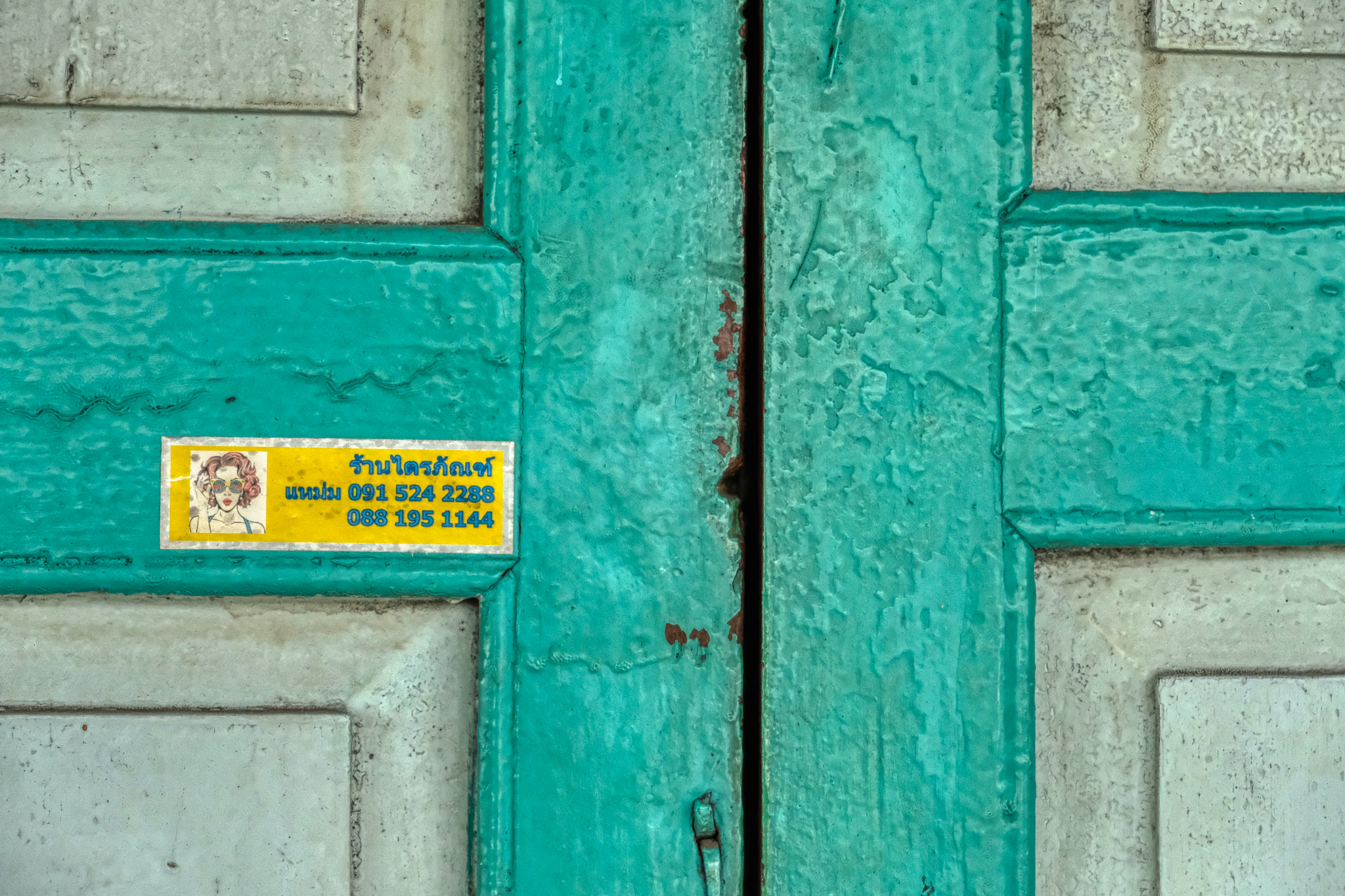 History in paint.
History in paint.
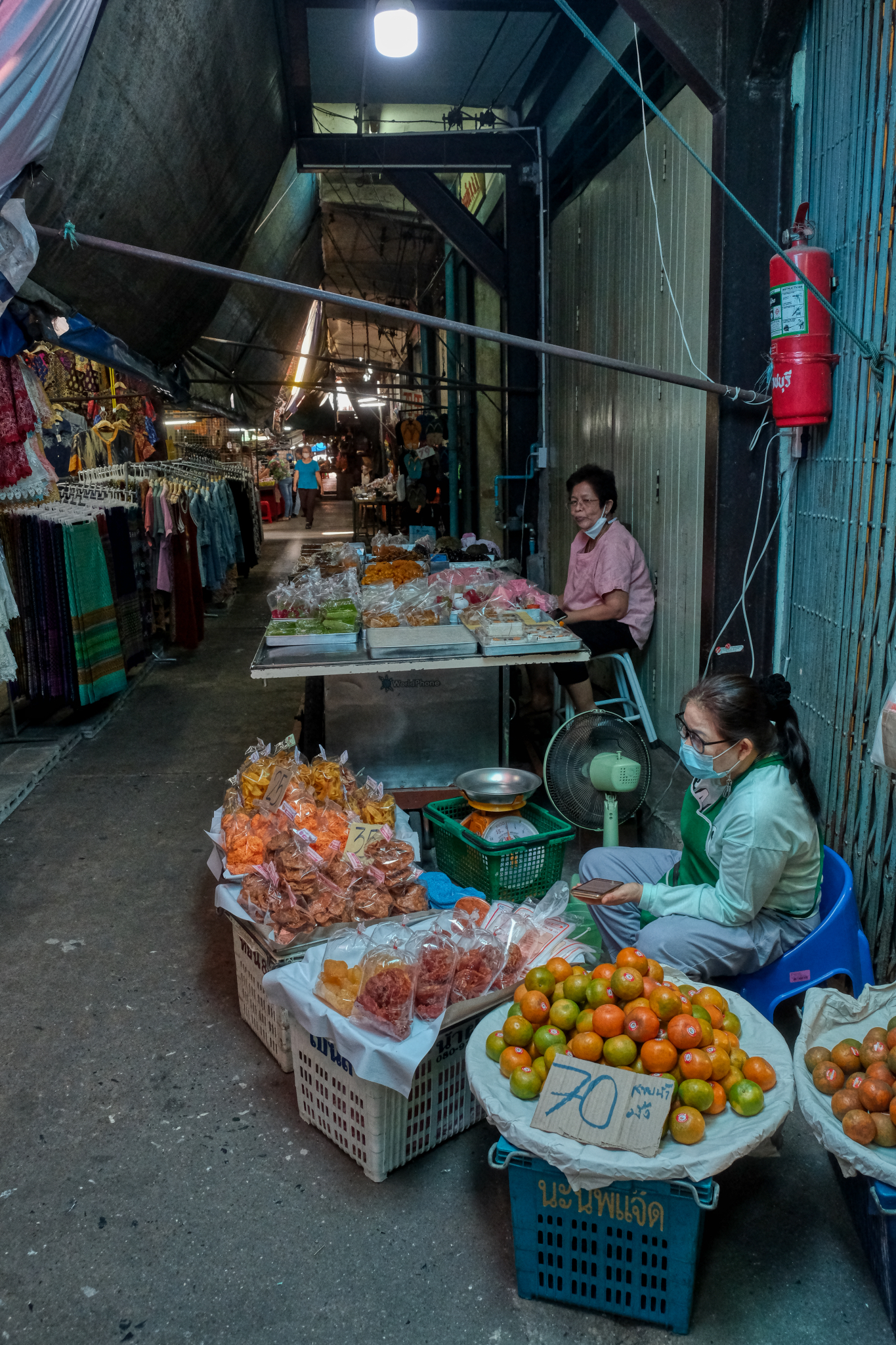 Small business in the alleys, which are themselves lined with very old small shops.
Small business in the alleys, which are themselves lined with very old small shops.
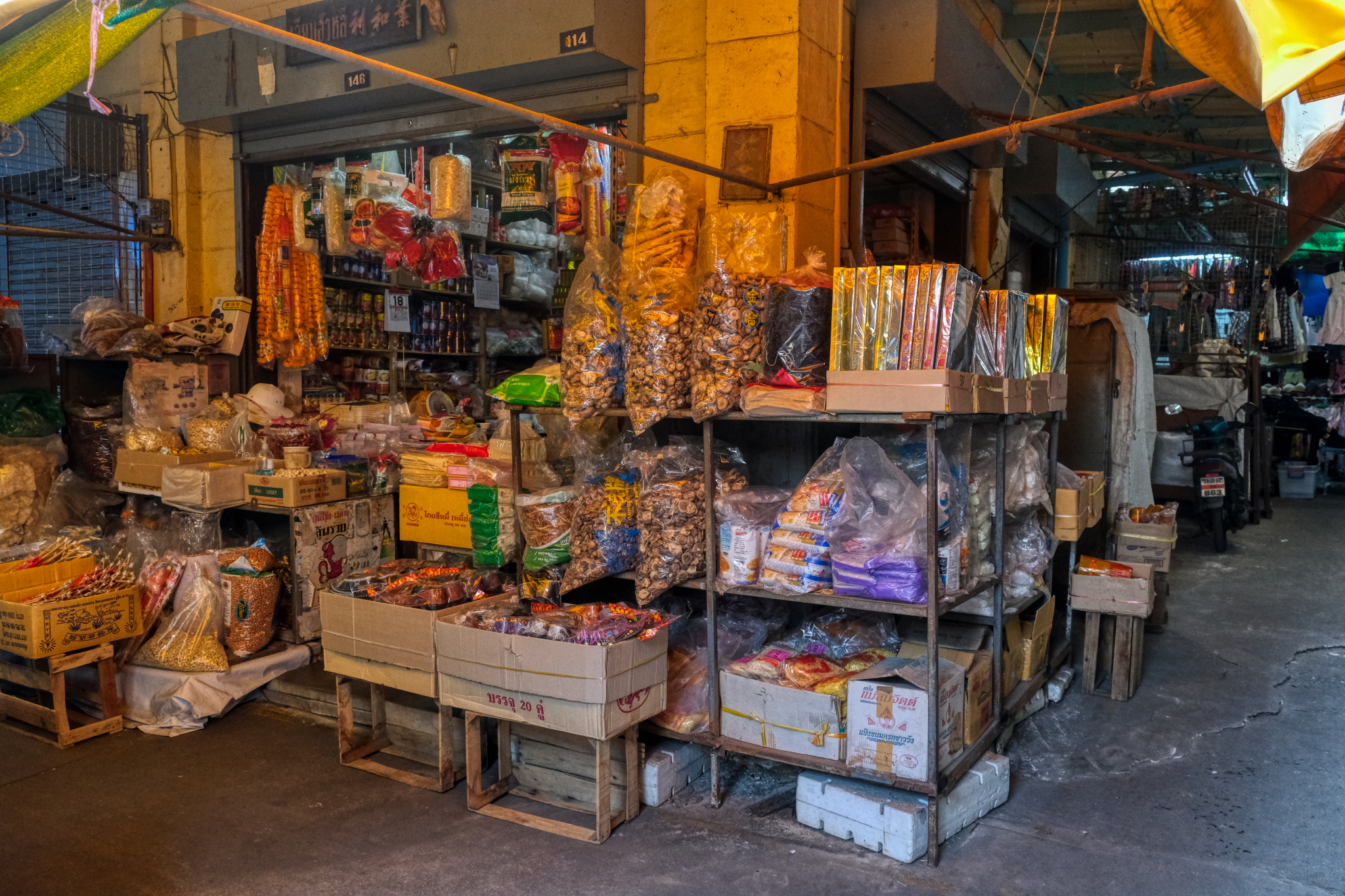 My first thought when seeing this shop was, 'supply and demand.' What kind of world is outside of this market can be deduced by what one sees for sale in it. There is an old pattern of consumption, imbedded in the cultural practices, the anthropology of food, that still demands these items.
My first thought when seeing this shop was, 'supply and demand.' What kind of world is outside of this market can be deduced by what one sees for sale in it. There is an old pattern of consumption, imbedded in the cultural practices, the anthropology of food, that still demands these items.
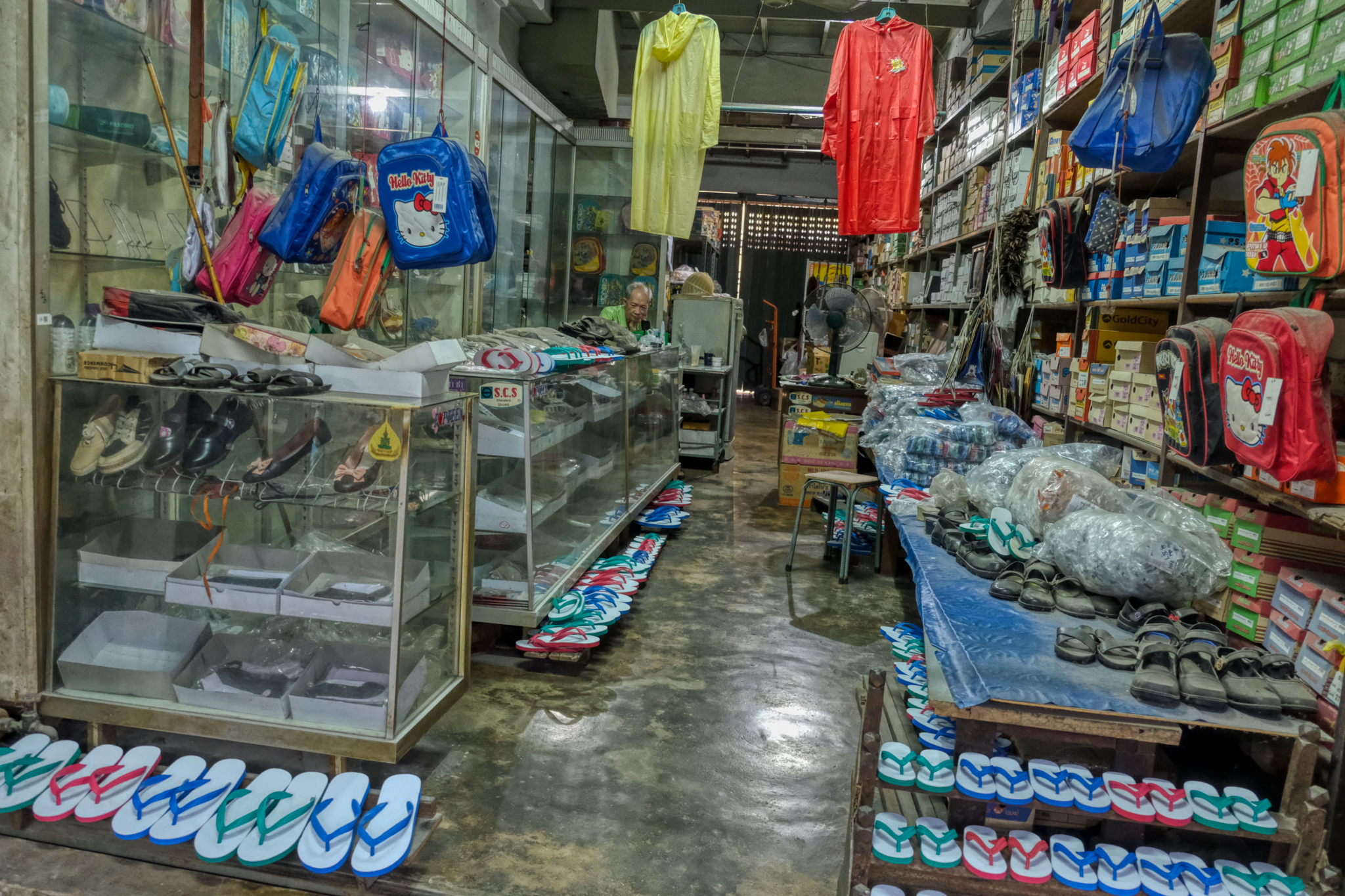 Times change. There was a time, maybe 50 years ago, when this shop was at the center of the Ratchaburi commercial center. You came here, and here only, if you wanted to buy a pair of new shoes. But the city grew in a different direction: what was the busy hub of activity has now became the backwater of the old town 'wet market.' This old man seems to have been here as long as the furniture. He doesn't even bother to dust off the shoes any more.
Times change. There was a time, maybe 50 years ago, when this shop was at the center of the Ratchaburi commercial center. You came here, and here only, if you wanted to buy a pair of new shoes. But the city grew in a different direction: what was the busy hub of activity has now became the backwater of the old town 'wet market.' This old man seems to have been here as long as the furniture. He doesn't even bother to dust off the shoes any more.
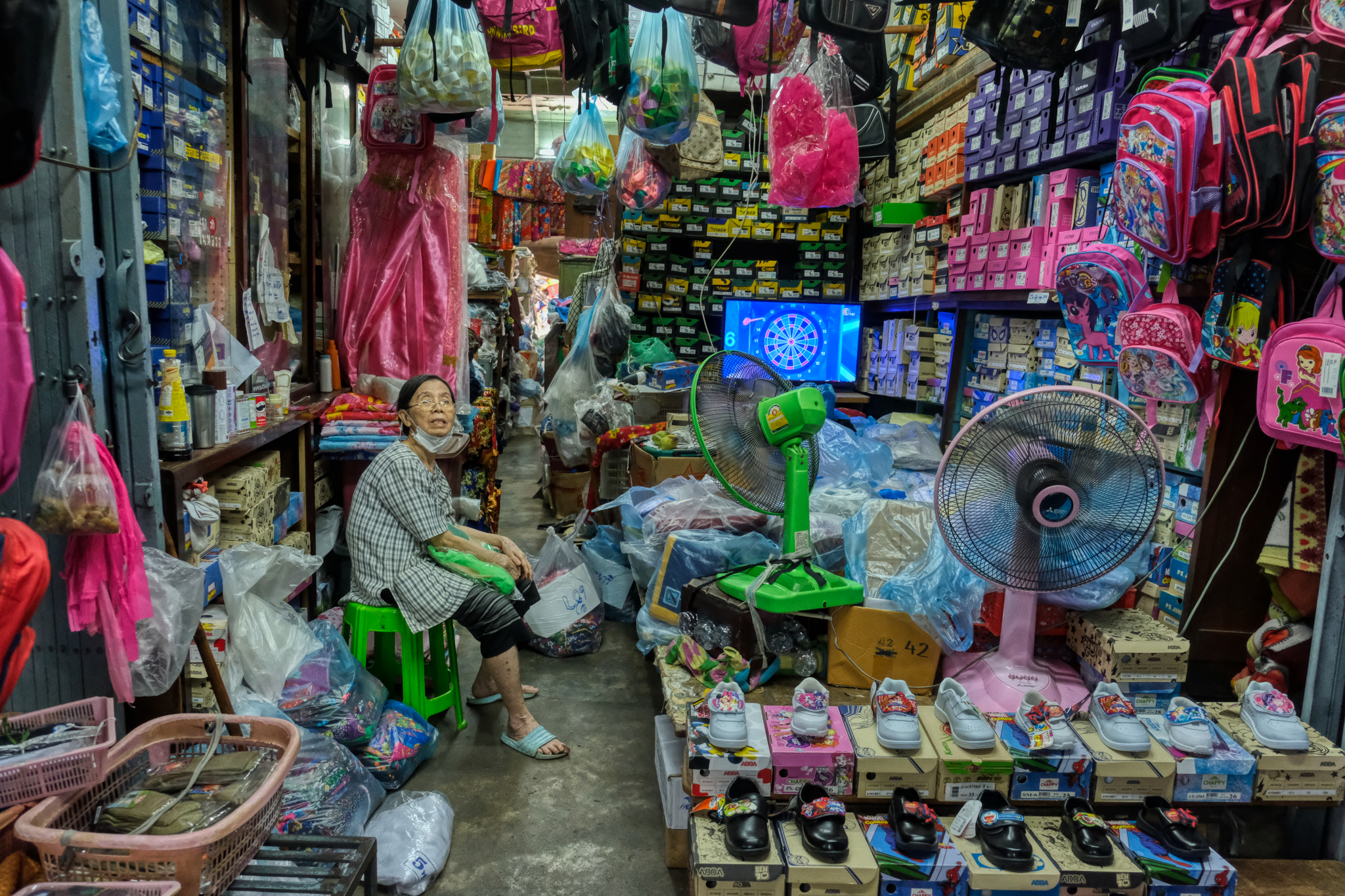 She is still hopeful and making an effort. These shops have suffered terribly during the pandemic: people do not like to congregate in the tight quarters of these narrow alleyways. I am sure she lives in the back of this shop.
She is still hopeful and making an effort. These shops have suffered terribly during the pandemic: people do not like to congregate in the tight quarters of these narrow alleyways. I am sure she lives in the back of this shop.
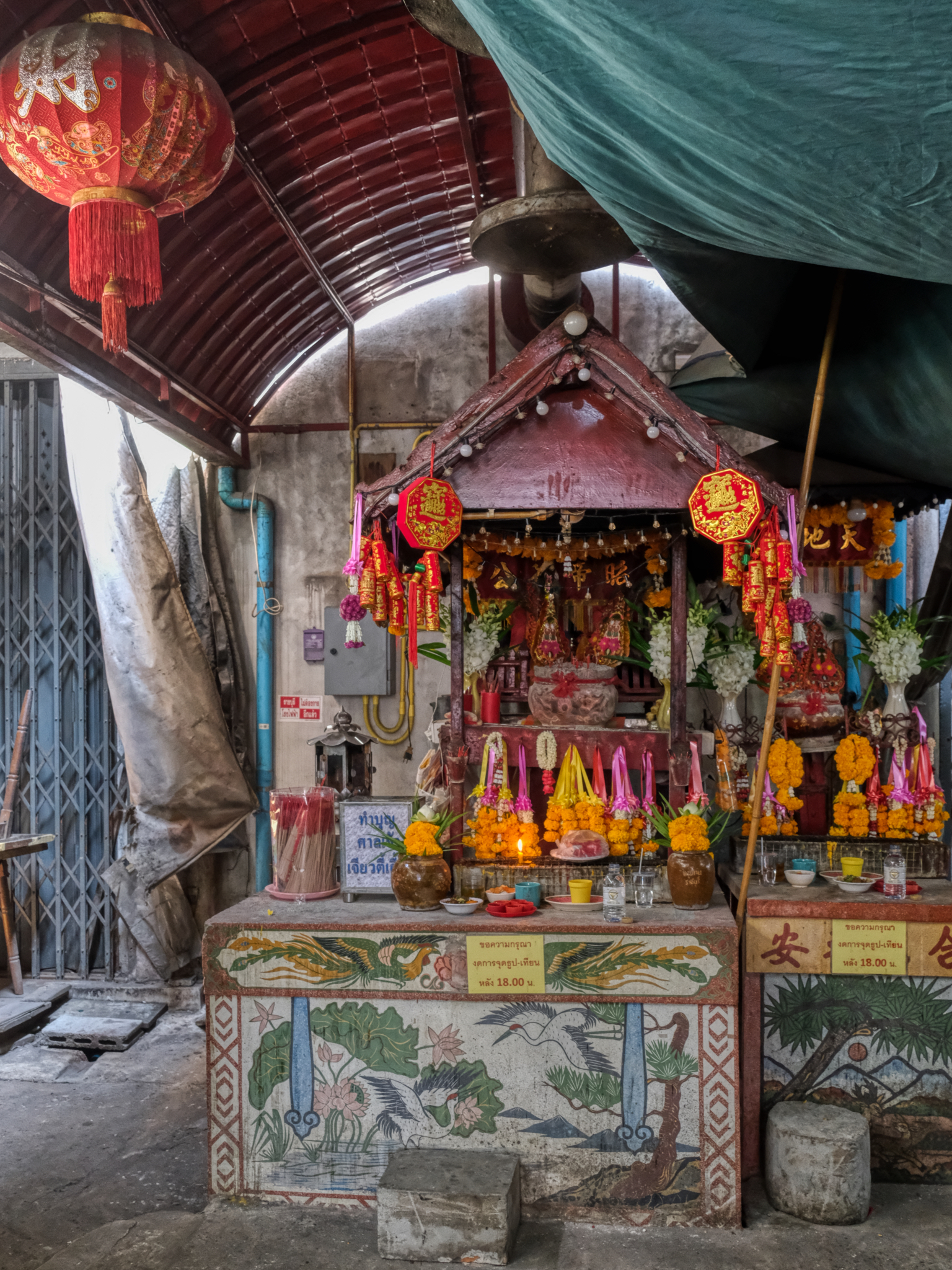 Tucked away deep in the old market is the spirit house/spirit altar for the shopkeepers to leave their offerings in hopes of better luck. The flowers and other offerings were all fresh from this very morning.
Tucked away deep in the old market is the spirit house/spirit altar for the shopkeepers to leave their offerings in hopes of better luck. The flowers and other offerings were all fresh from this very morning.
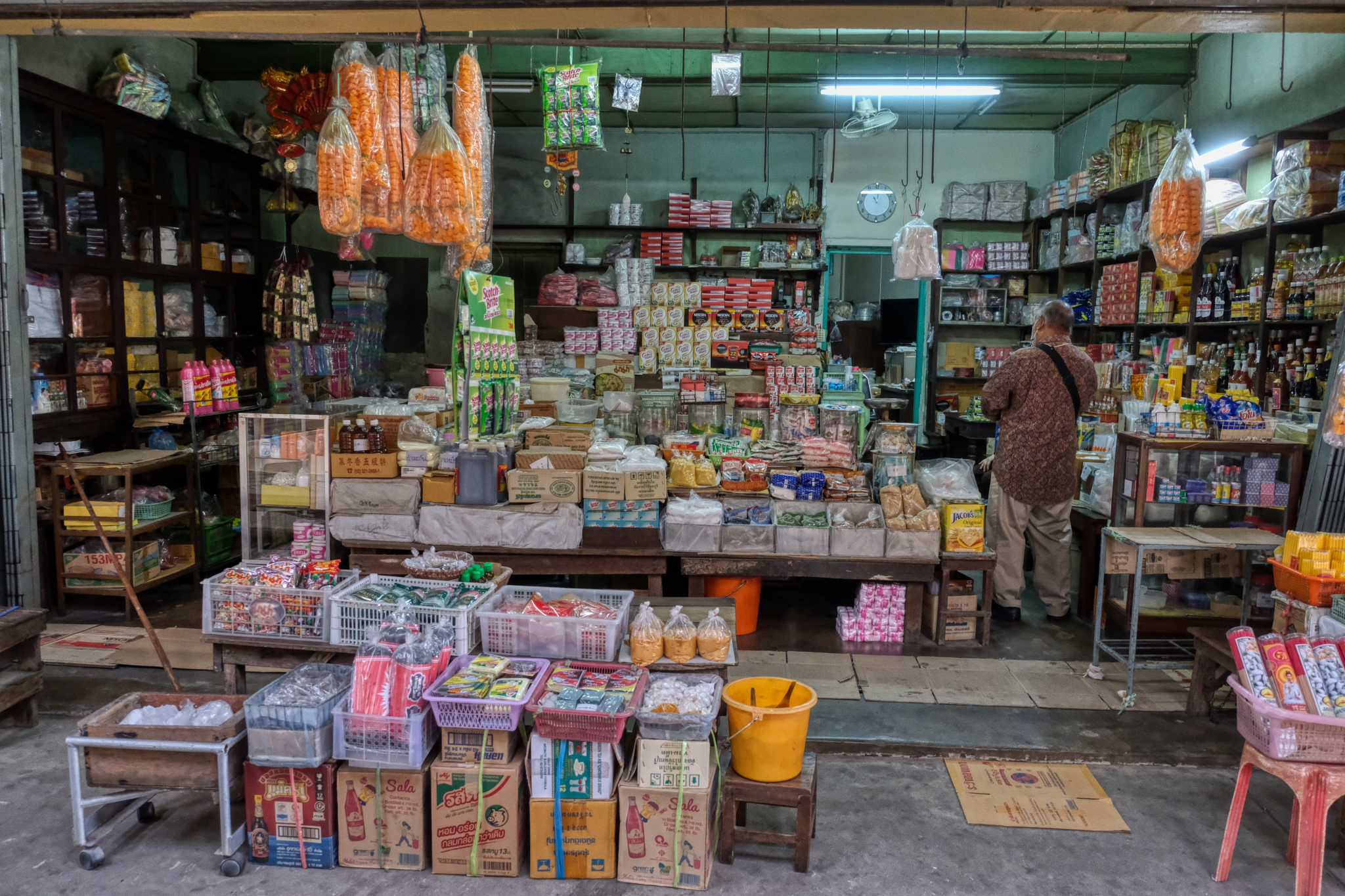 This dry goods shop in the old market seemed to be doing pretty good. You have to remember that less than a mile from this spot there are several multinational big box giant supermarkets. It is hard to understand how these small shops survive. I assume it survives by servicing those who work in the old market itself.
This dry goods shop in the old market seemed to be doing pretty good. You have to remember that less than a mile from this spot there are several multinational big box giant supermarkets. It is hard to understand how these small shops survive. I assume it survives by servicing those who work in the old market itself.
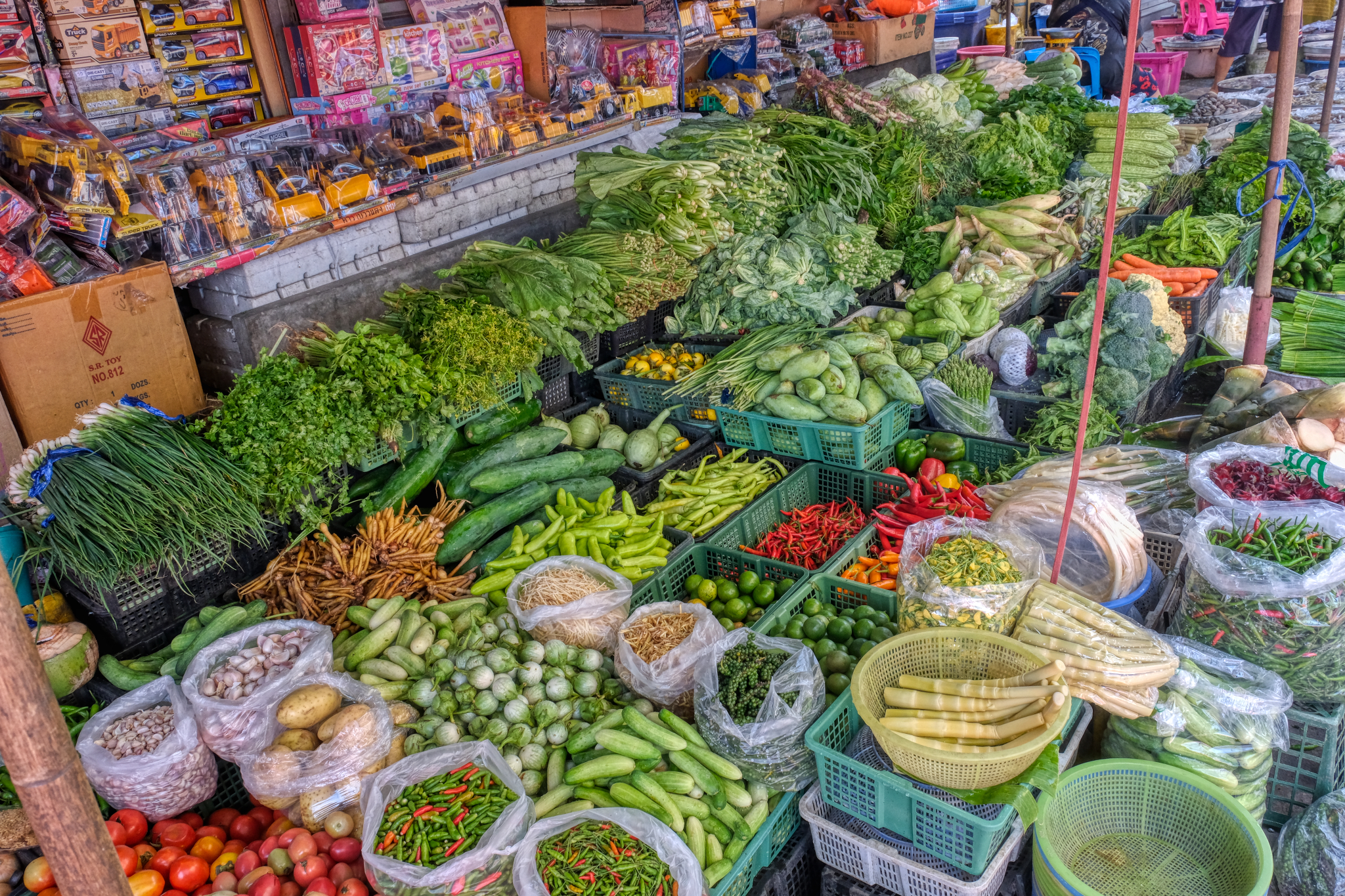 There were many sections of the old town market, and of course, one of them was for fresh fruits and vegetables. So delicious in Thailand.
There were many sections of the old town market, and of course, one of them was for fresh fruits and vegetables. So delicious in Thailand.
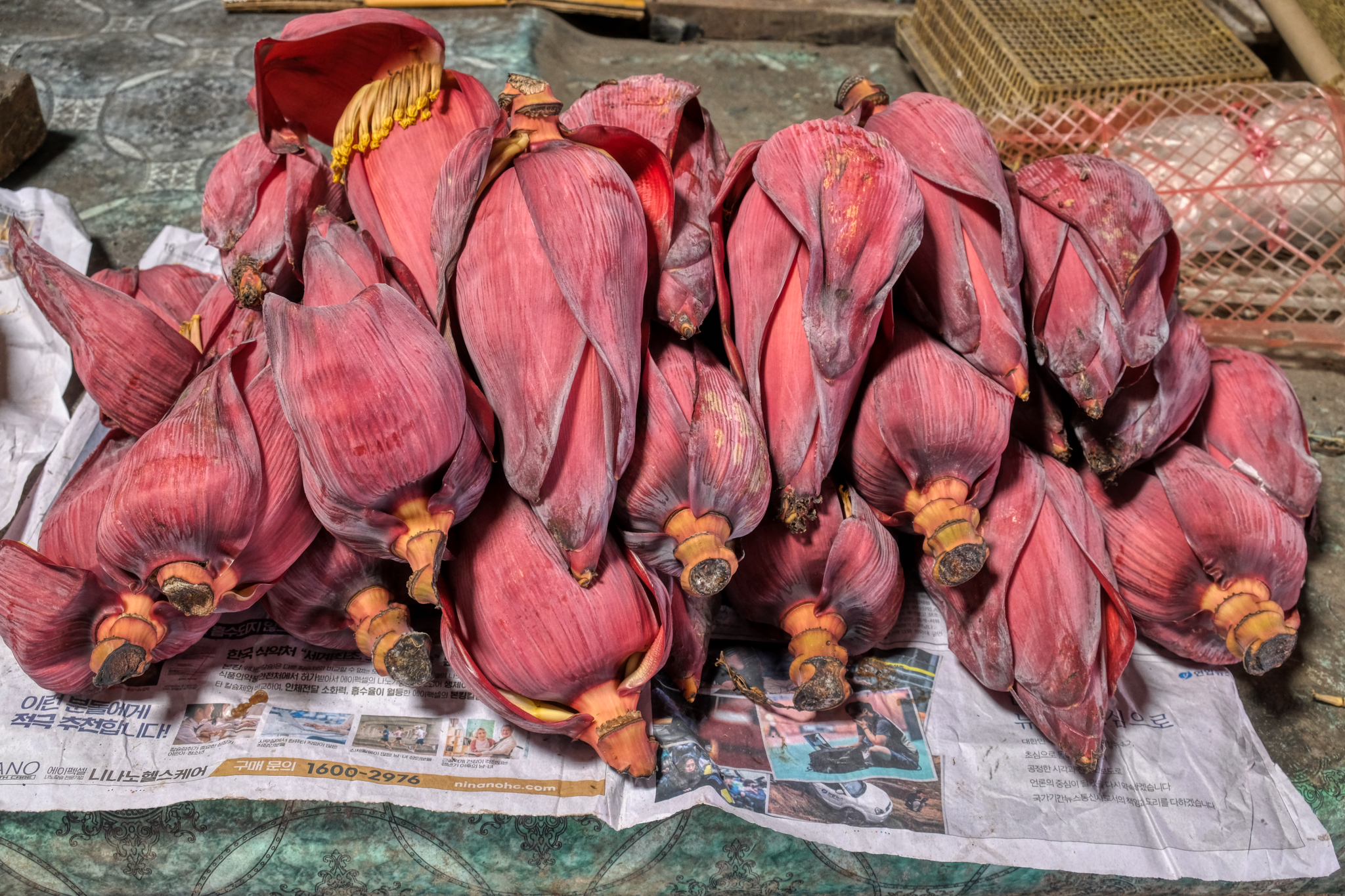 Banana flower hearts . . . used in some Thai dishes.
Banana flower hearts . . . used in some Thai dishes.
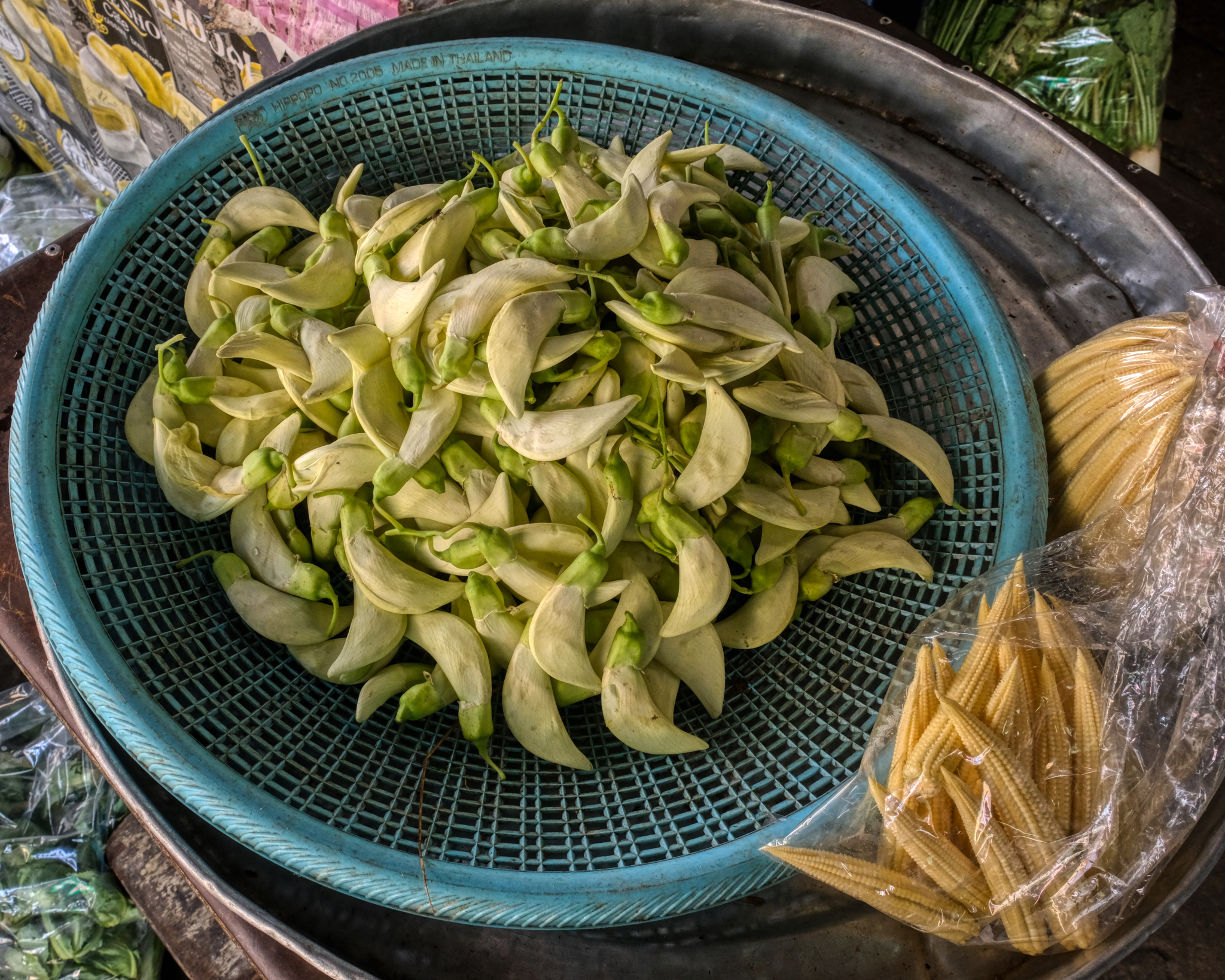 I had never seen this before . . . some kind of flower bud for use in one of the many thousands of Thai dishes.
I had never seen this before . . . some kind of flower bud for use in one of the many thousands of Thai dishes.
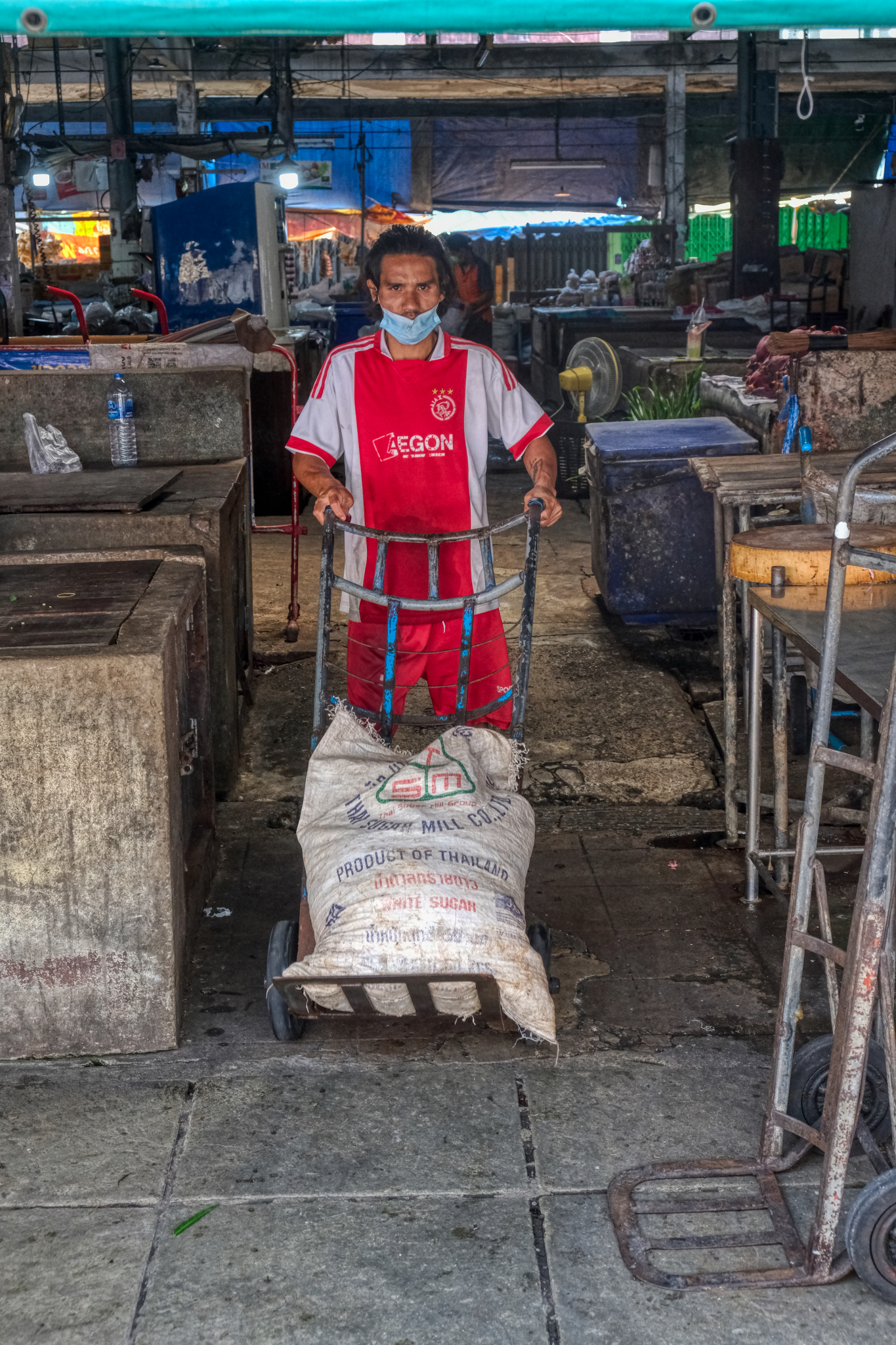 Although most of the market I saw so far was clean, neat, and recently refurbished, I eventually found the oldest part of the market. It was partially abandoned and the commerce there seemed to be left to the poorest people.
Although most of the market I saw so far was clean, neat, and recently refurbished, I eventually found the oldest part of the market. It was partially abandoned and the commerce there seemed to be left to the poorest people.
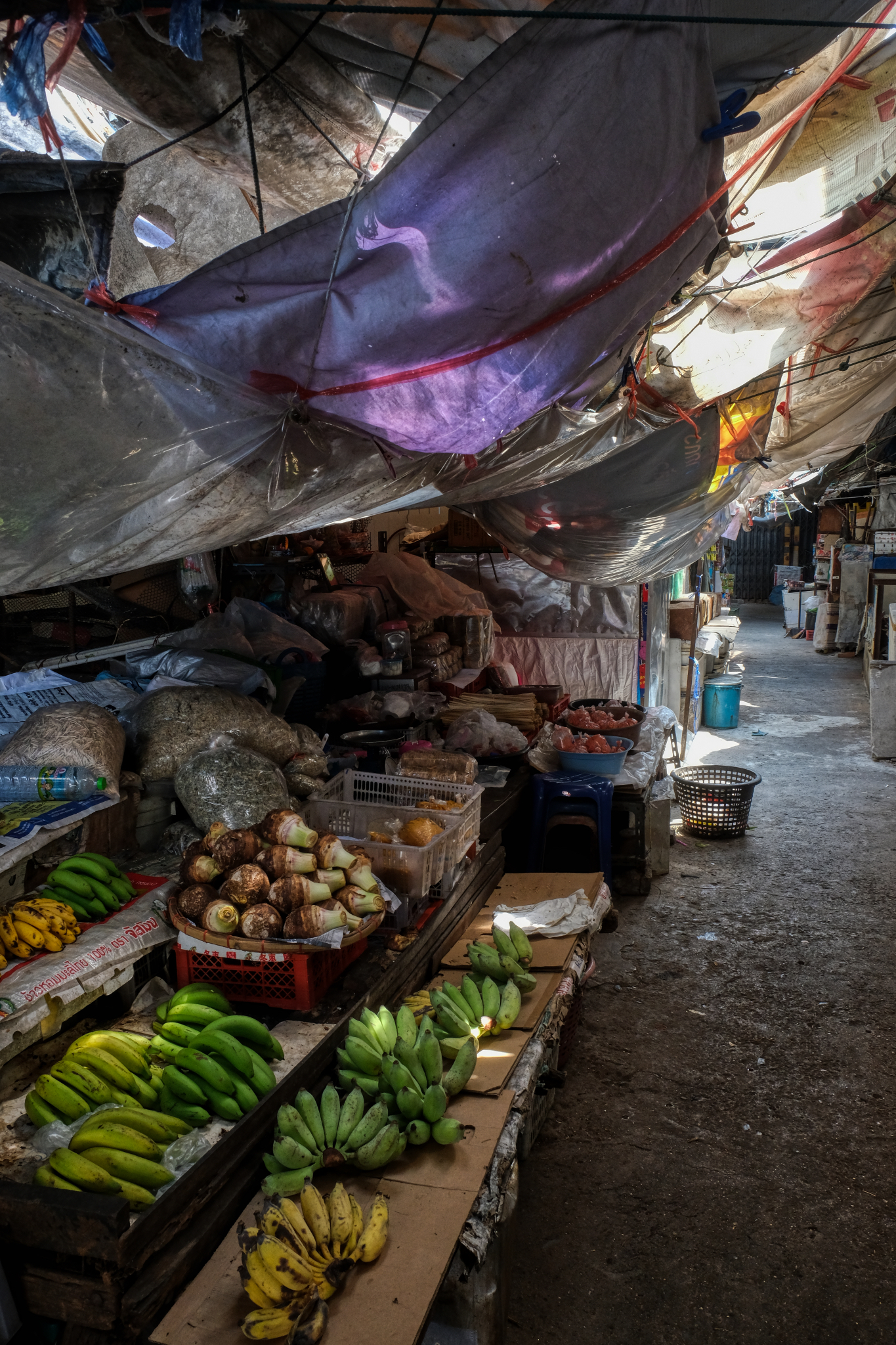 Old plastic rain flies over meagre offerings in the old, dead market. It is here we see the dilapidation caused by the corporate big box stores a couple of blocks away. I LOVE this photo.
Old plastic rain flies over meagre offerings in the old, dead market. It is here we see the dilapidation caused by the corporate big box stores a couple of blocks away. I LOVE this photo.
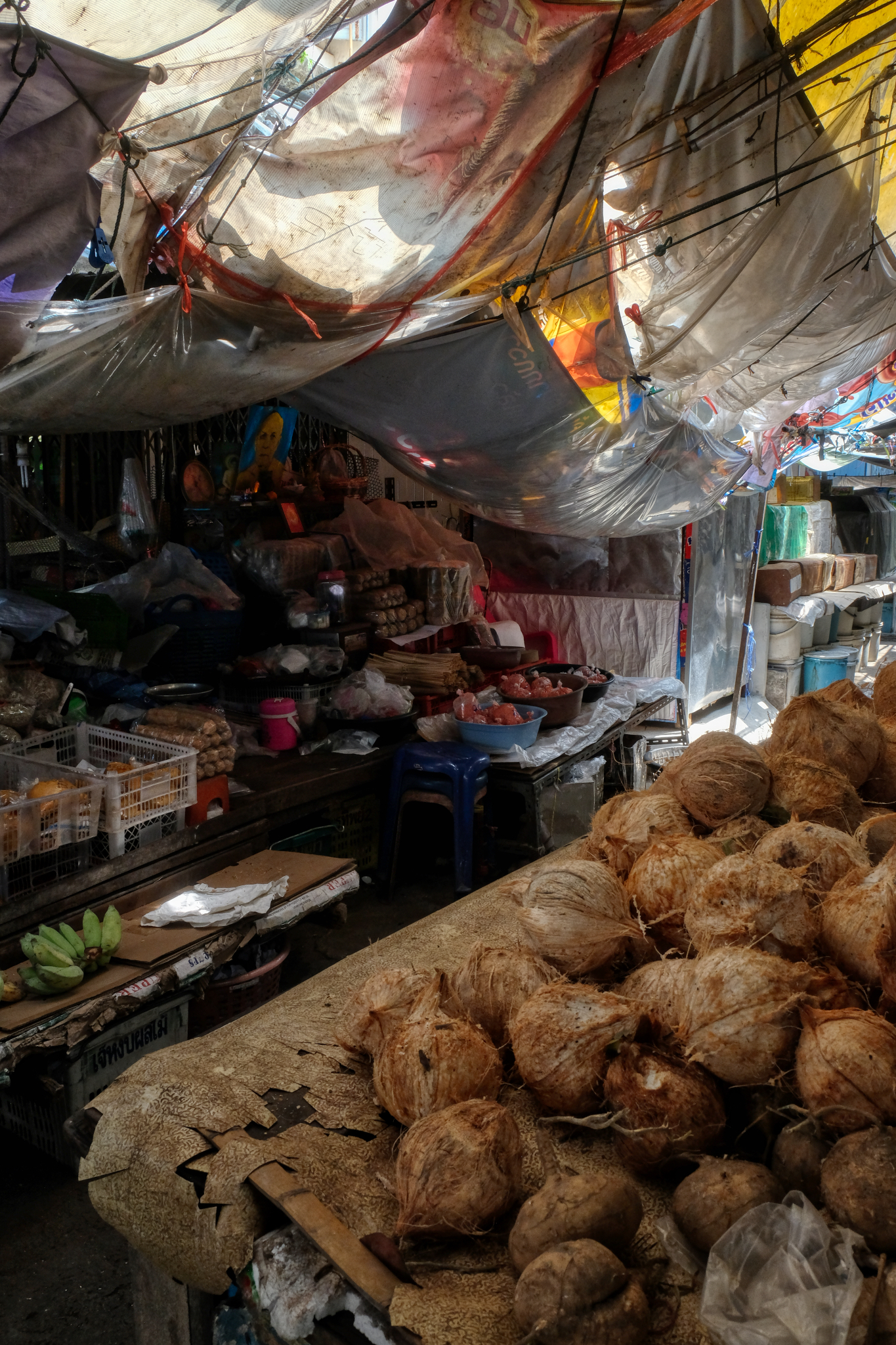 Old coconuts for sale.
Old coconuts for sale.
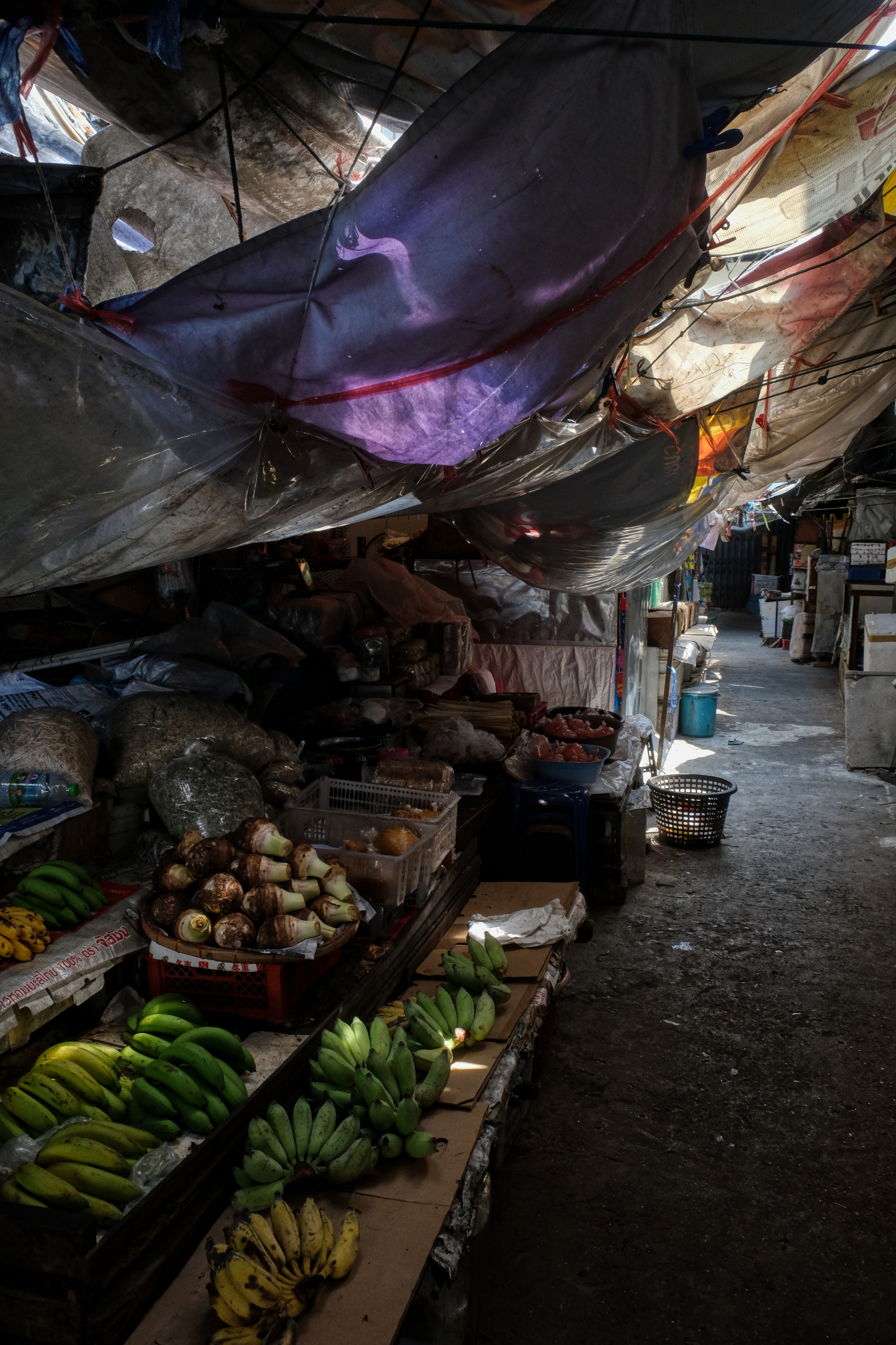 I was the ONLY person in this part of the market. Nobody was here, not even the merchants . . . at 10:00 in the morning.
I was the ONLY person in this part of the market. Nobody was here, not even the merchants . . . at 10:00 in the morning.
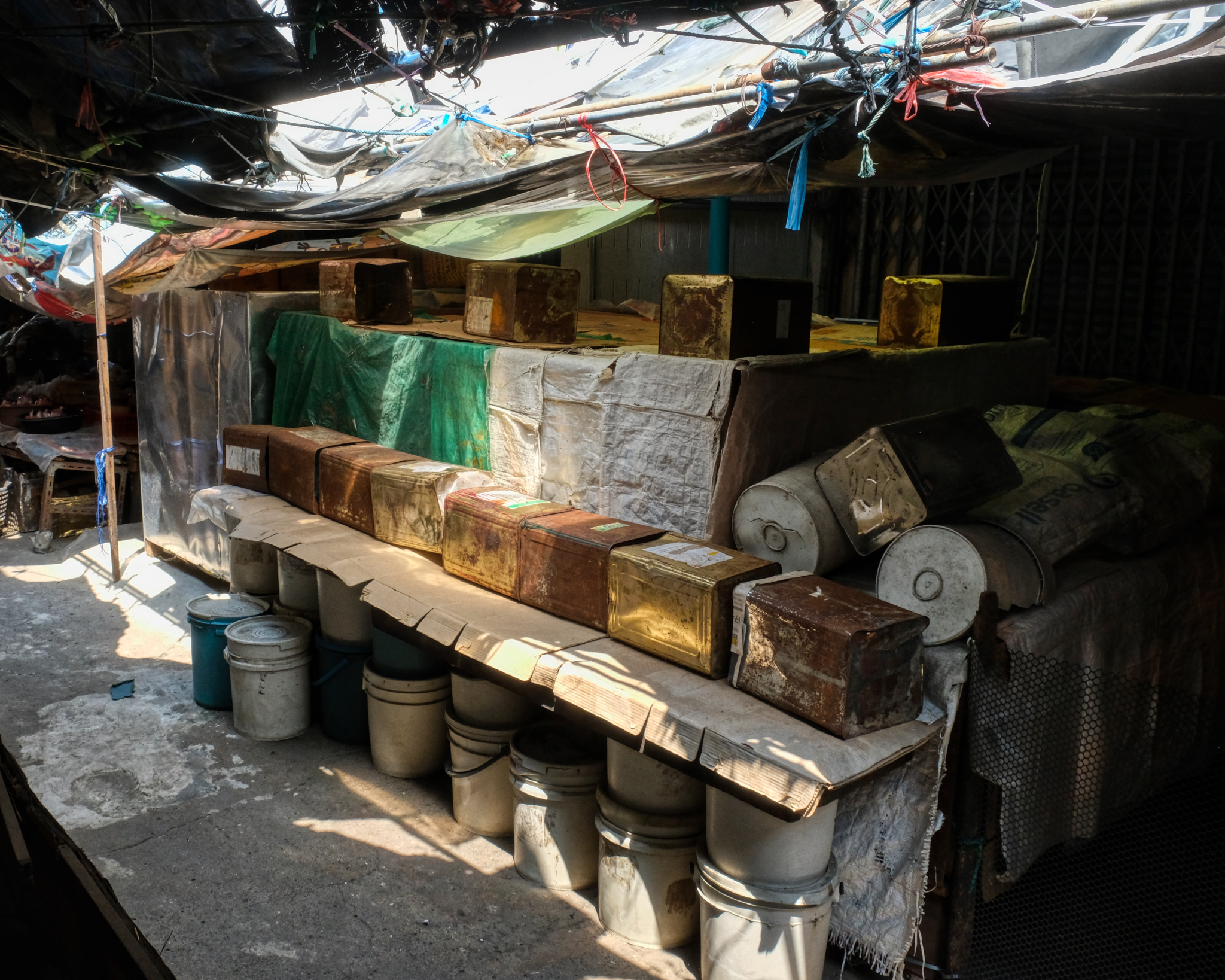 I tried to imagine what this 'business' was . . . but came up short.
I tried to imagine what this 'business' was . . . but came up short.
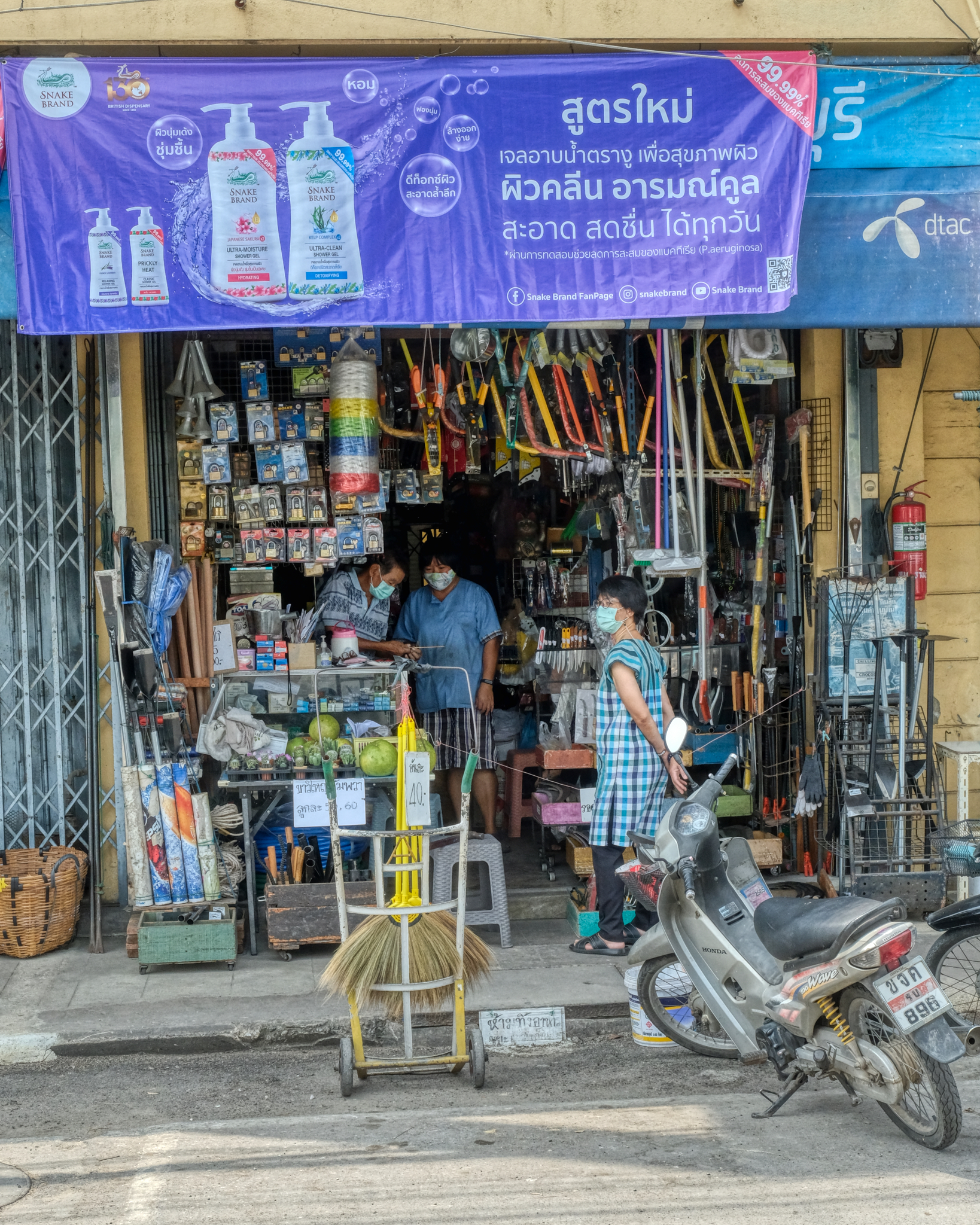
Outside of the inner alleyways of the old market, along the city streets, are more businesses. Here ,a hardware store.
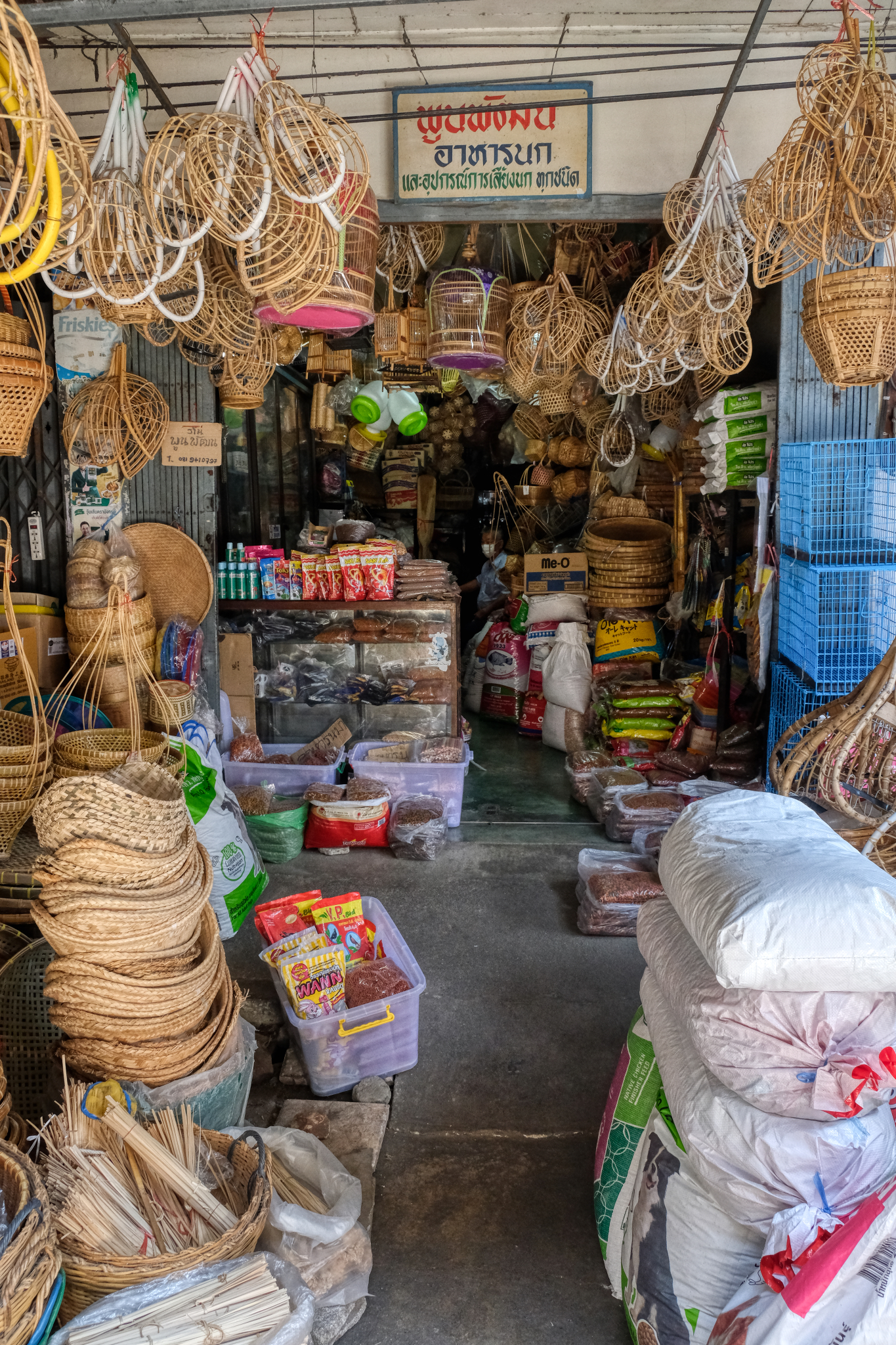 Shops that have everything a local resident would want and need.
Shops that have everything a local resident would want and need.
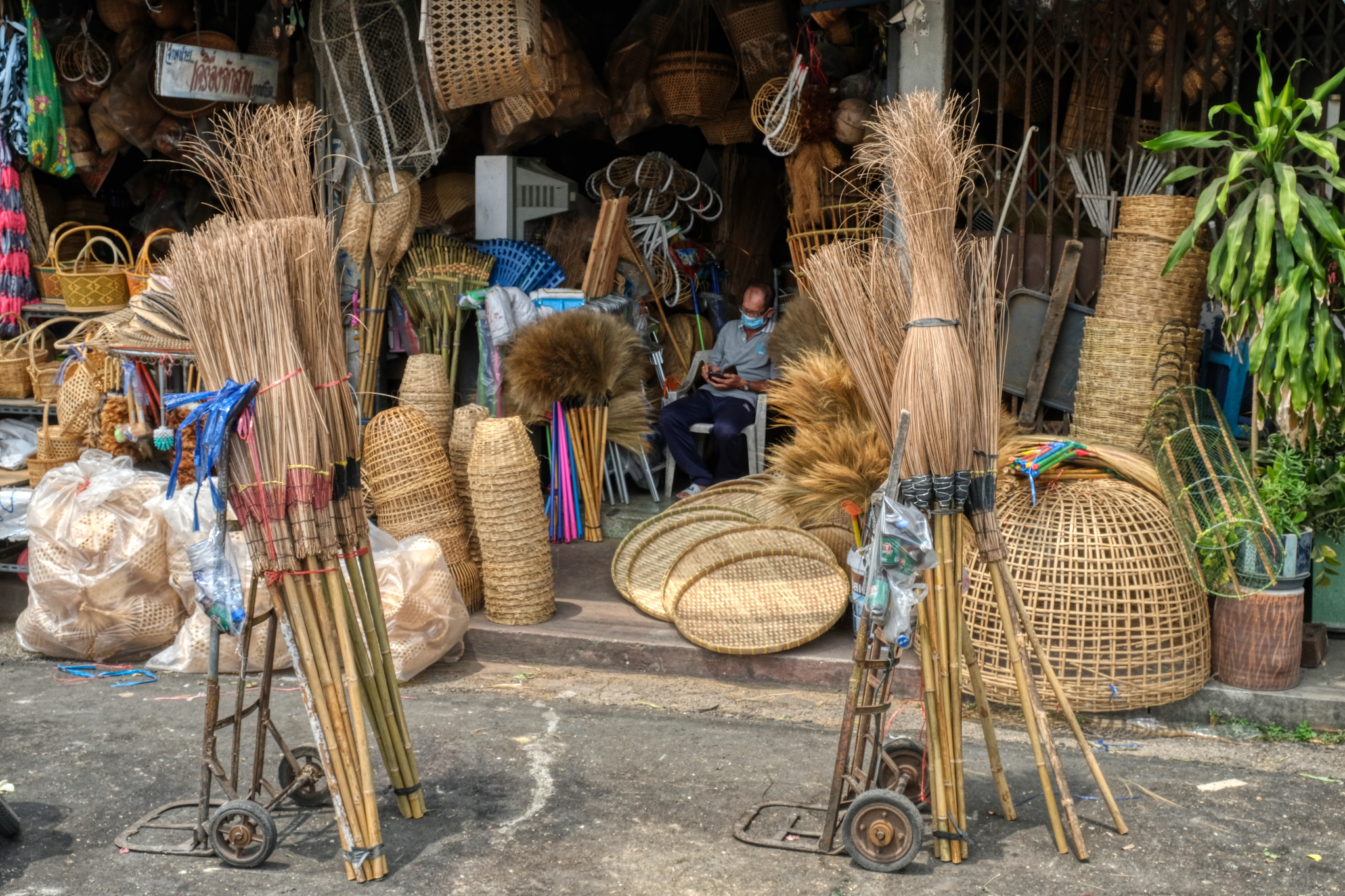 If it can be made out of straw, bamboo, or wicker . . . . they have it here.
If it can be made out of straw, bamboo, or wicker . . . . they have it here.
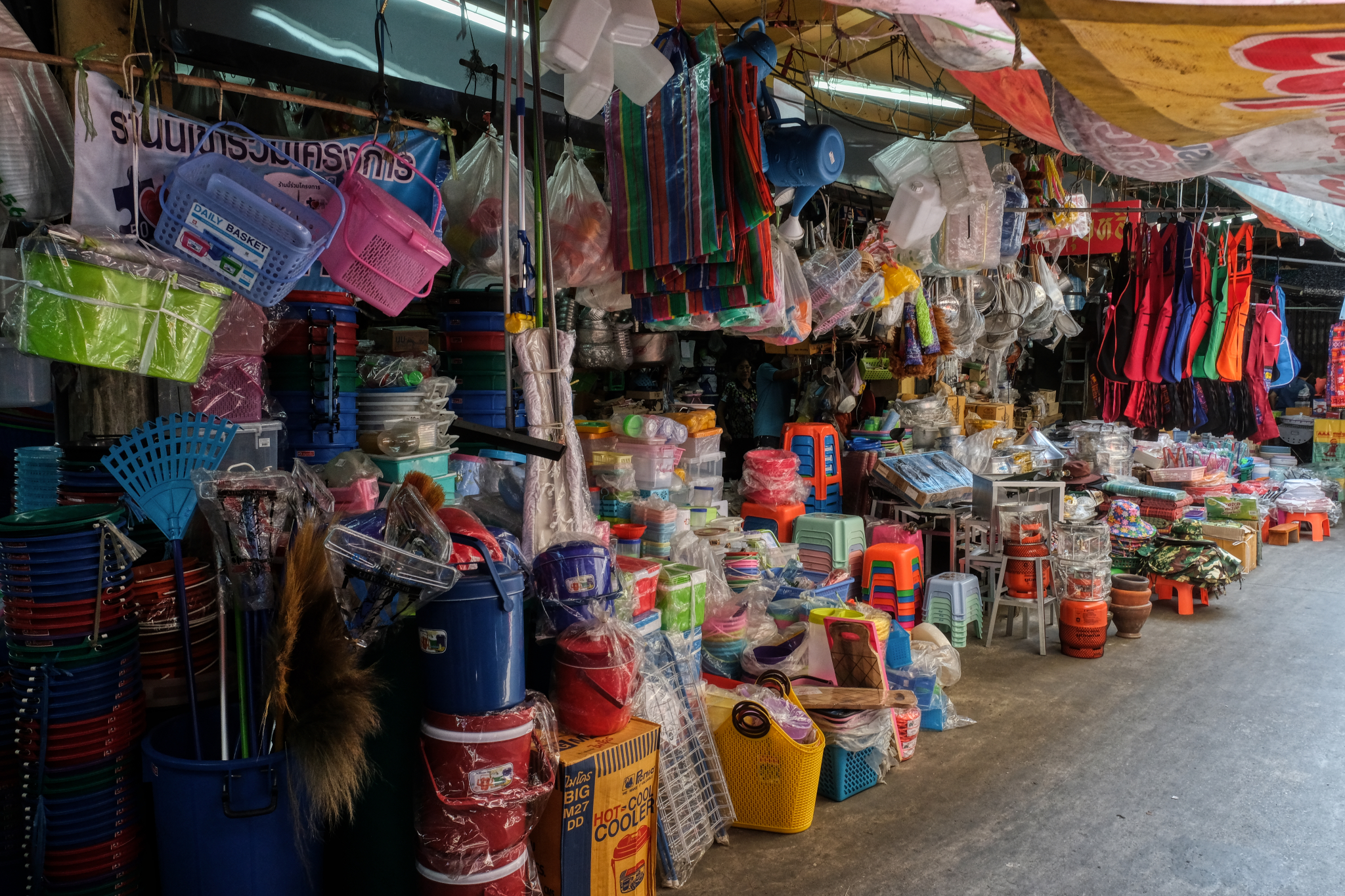 Of course, if it can be made out of straw, bamboo, or wicker . . . it can also be made out of plastic.
Of course, if it can be made out of straw, bamboo, or wicker . . . it can also be made out of plastic.
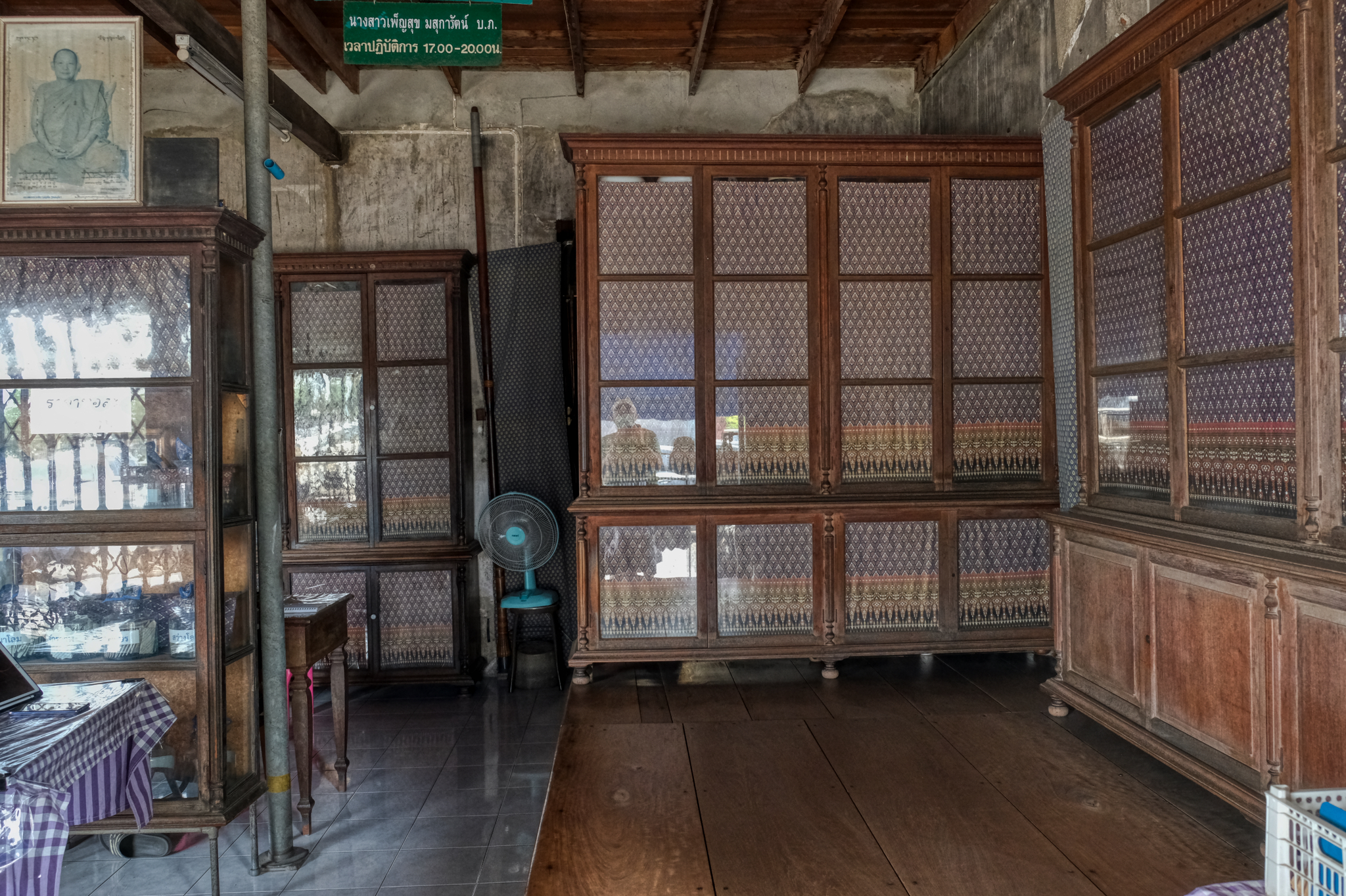 The owner of this shop told me it was restored to how it was when her family started it 100 years ago. A beautiful look into the past times in Thailand.
The owner of this shop told me it was restored to how it was when her family started it 100 years ago. A beautiful look into the past times in Thailand.
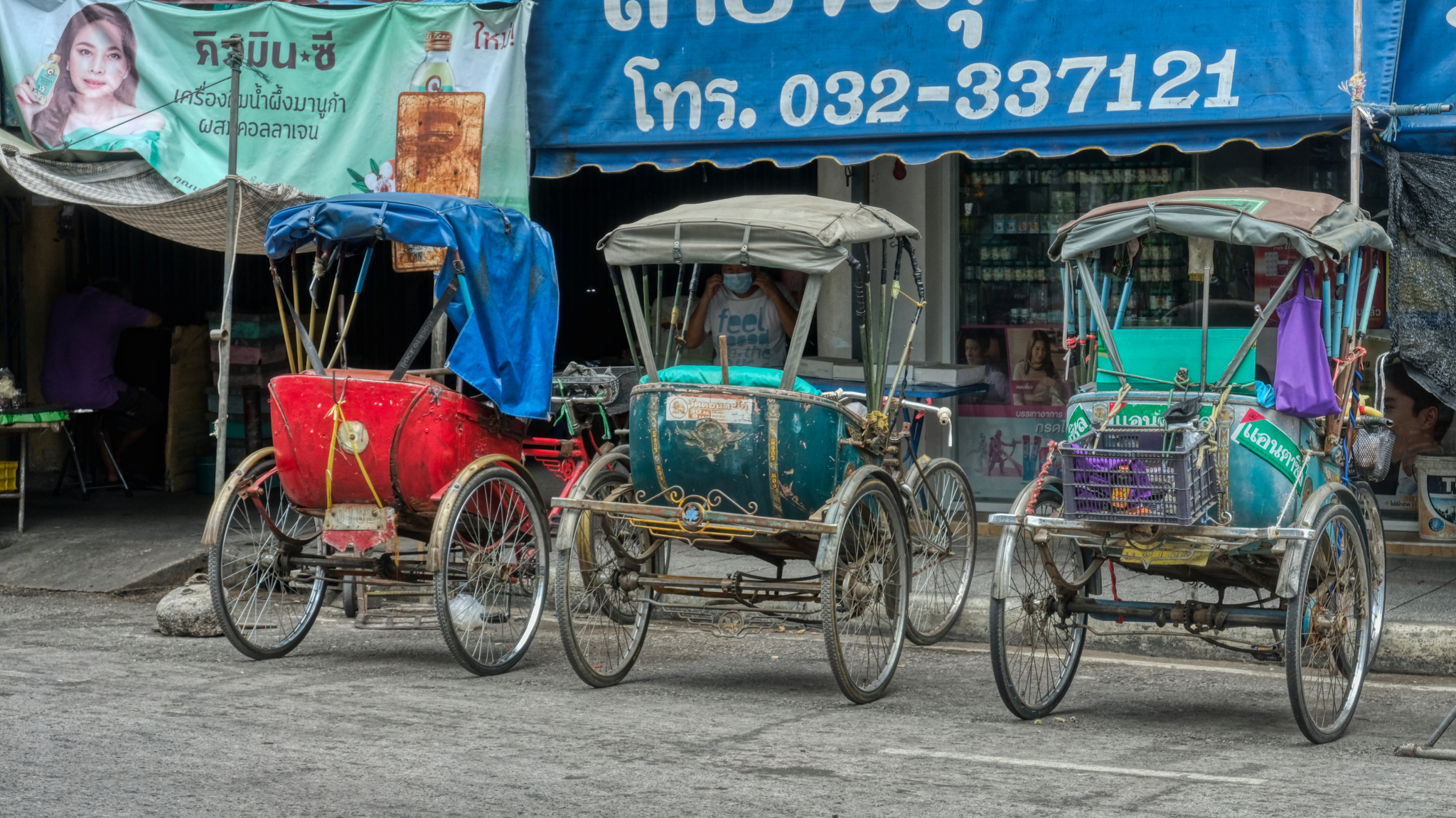 When I came to live in Thailand 26 years ago these samlors were ubiquitous. There would always be 20-30 of these 'pedal cabs' lied up next to the wet markets ready to take the customers home. Now it is rare to see them anywhere any more.
When I came to live in Thailand 26 years ago these samlors were ubiquitous. There would always be 20-30 of these 'pedal cabs' lied up next to the wet markets ready to take the customers home. Now it is rare to see them anywhere any more.
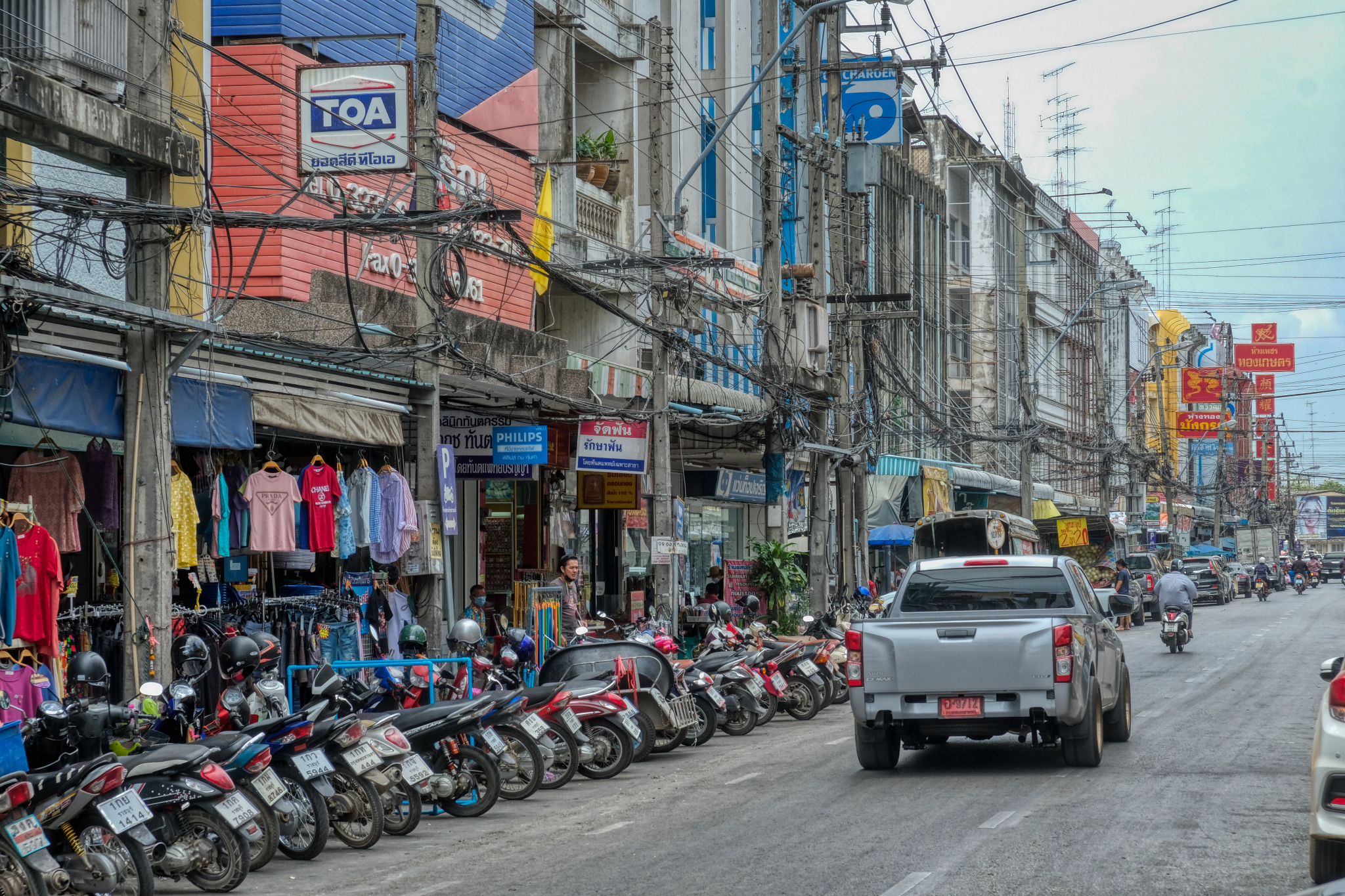 The "modern" Ratchiburi commercial center, dating from the 1970s and 1980s. Of course the true 'modern' Ratchiburi commercial zone is now located in the multinational Big Box stores and shopping malls that dot the major roads leading in and out of the town . . . and the Thais drive there in their pick-up trucks.
The "modern" Ratchiburi commercial center, dating from the 1970s and 1980s. Of course the true 'modern' Ratchiburi commercial zone is now located in the multinational Big Box stores and shopping malls that dot the major roads leading in and out of the town . . . and the Thais drive there in their pick-up trucks.
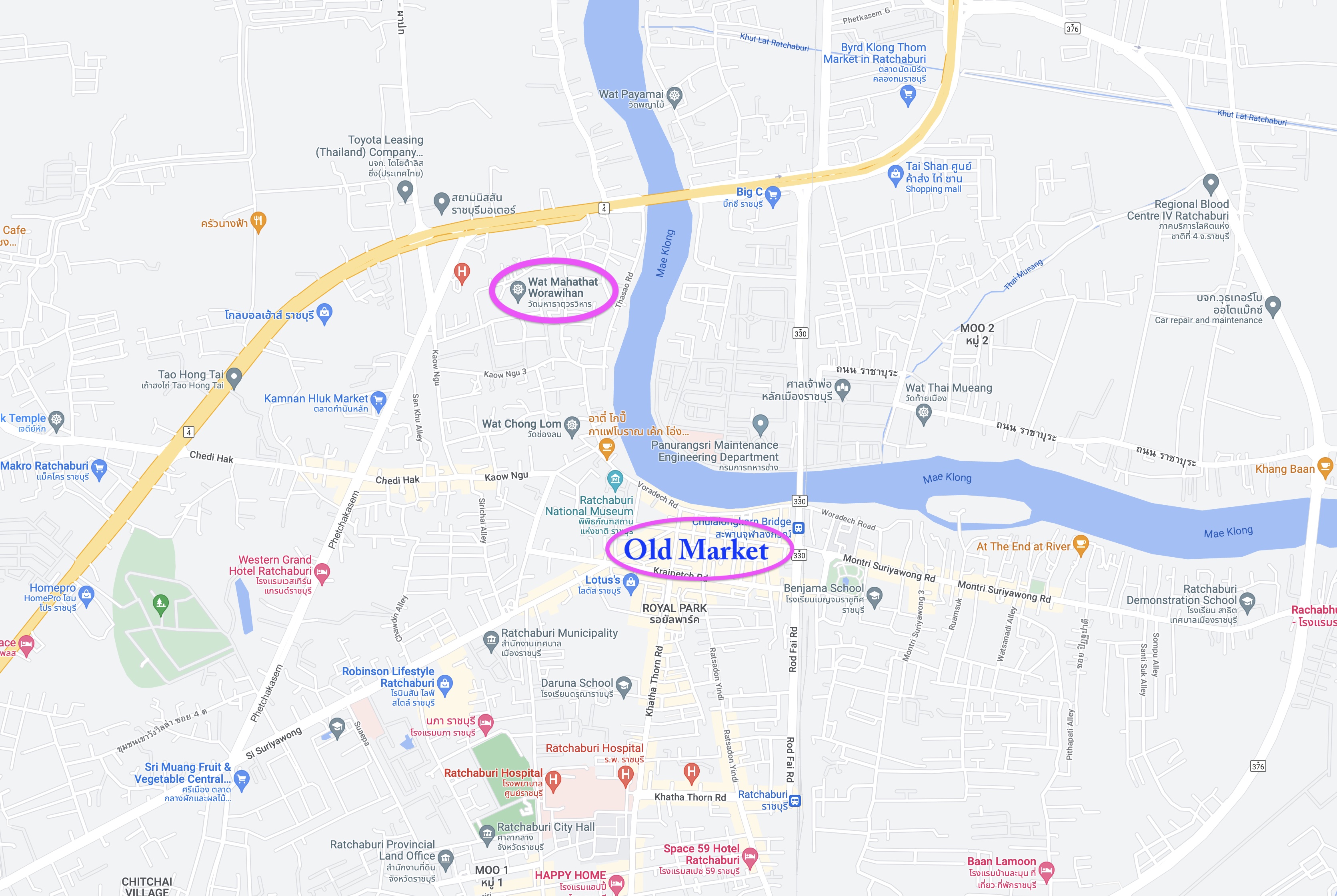 My last stop was at the amazing 10th century Wat Mahathat Worawihan.
My last stop was at the amazing 10th century Wat Mahathat Worawihan.
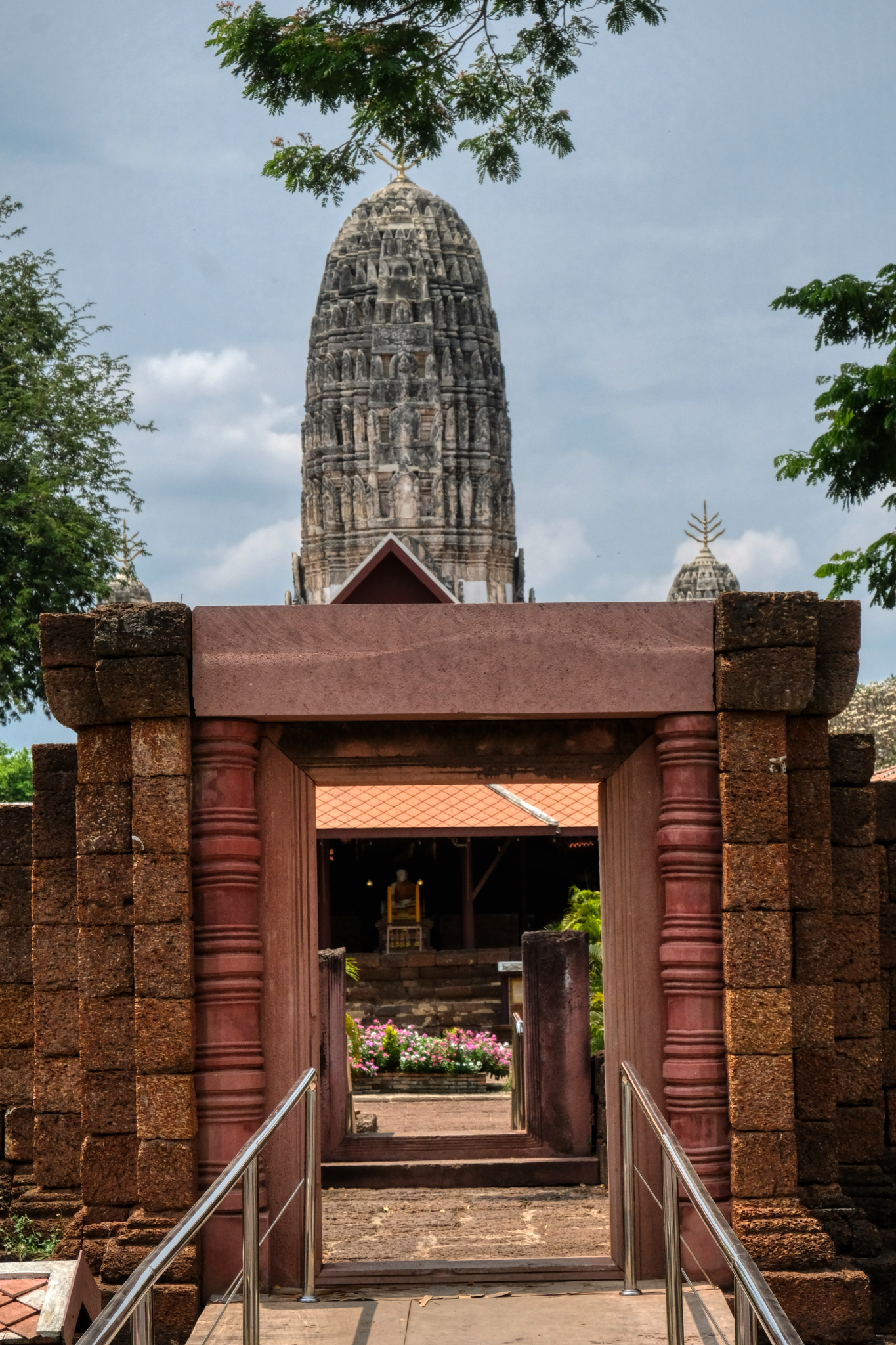 The front gate of Wat Mahathat Worawihan did not impress. But what was within astonished me.
The front gate of Wat Mahathat Worawihan did not impress. But what was within astonished me.
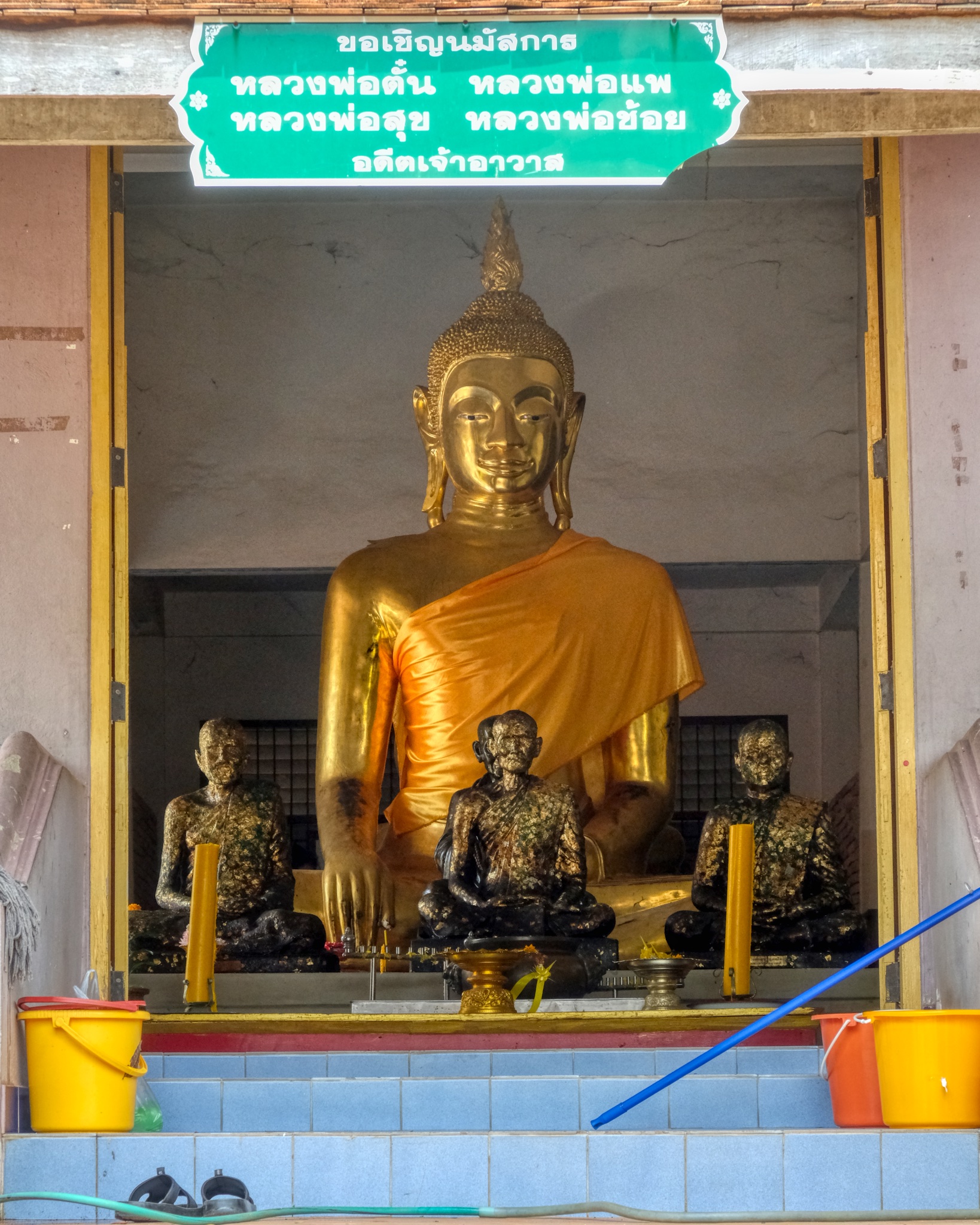 My first inkling about the beauty within this was was when I looked through a small building's window and saw this.
My first inkling about the beauty within this was was when I looked through a small building's window and saw this.
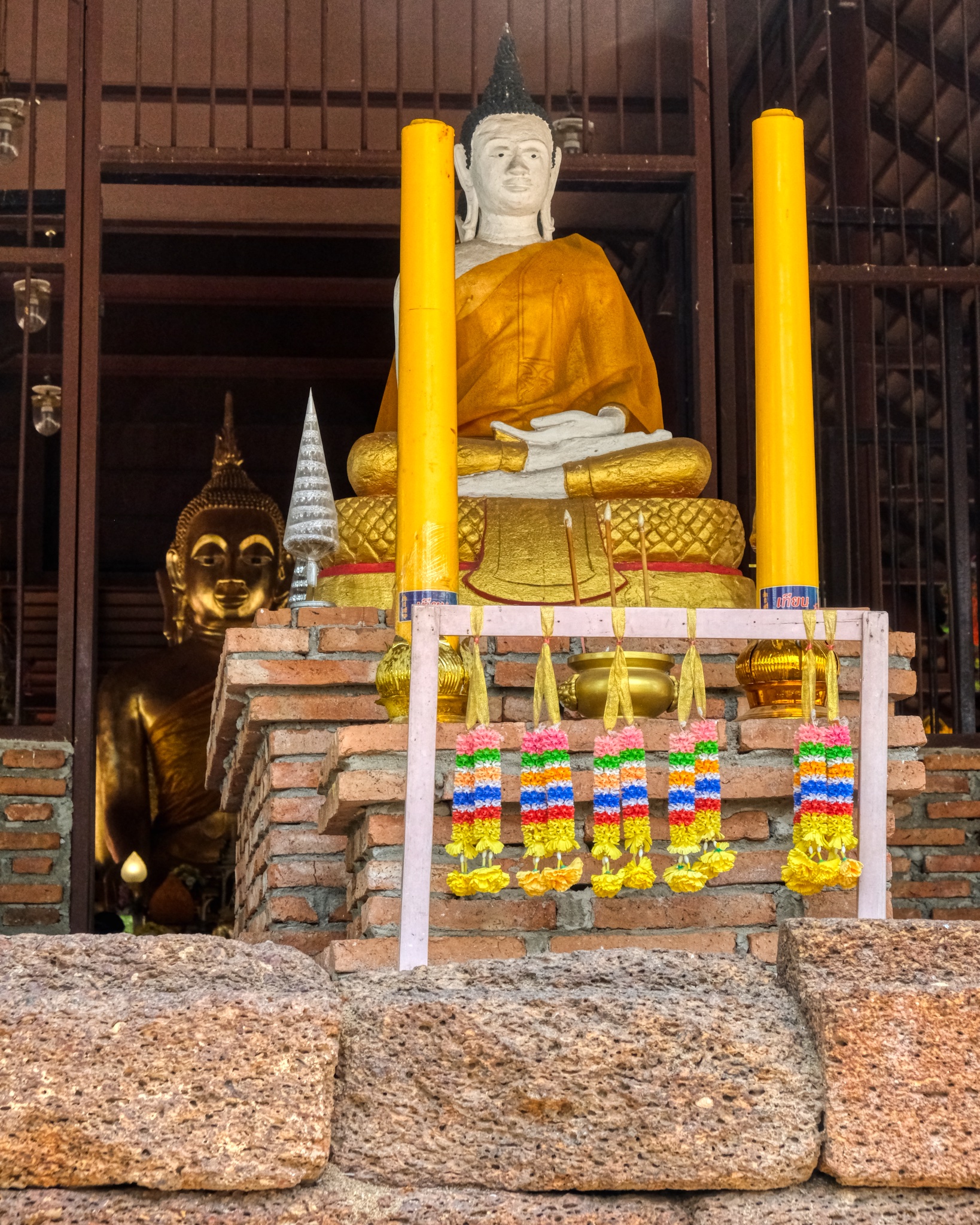 The sala/temple straight ahead looked inviting. I could see a large Buddha image within.
The sala/temple straight ahead looked inviting. I could see a large Buddha image within.
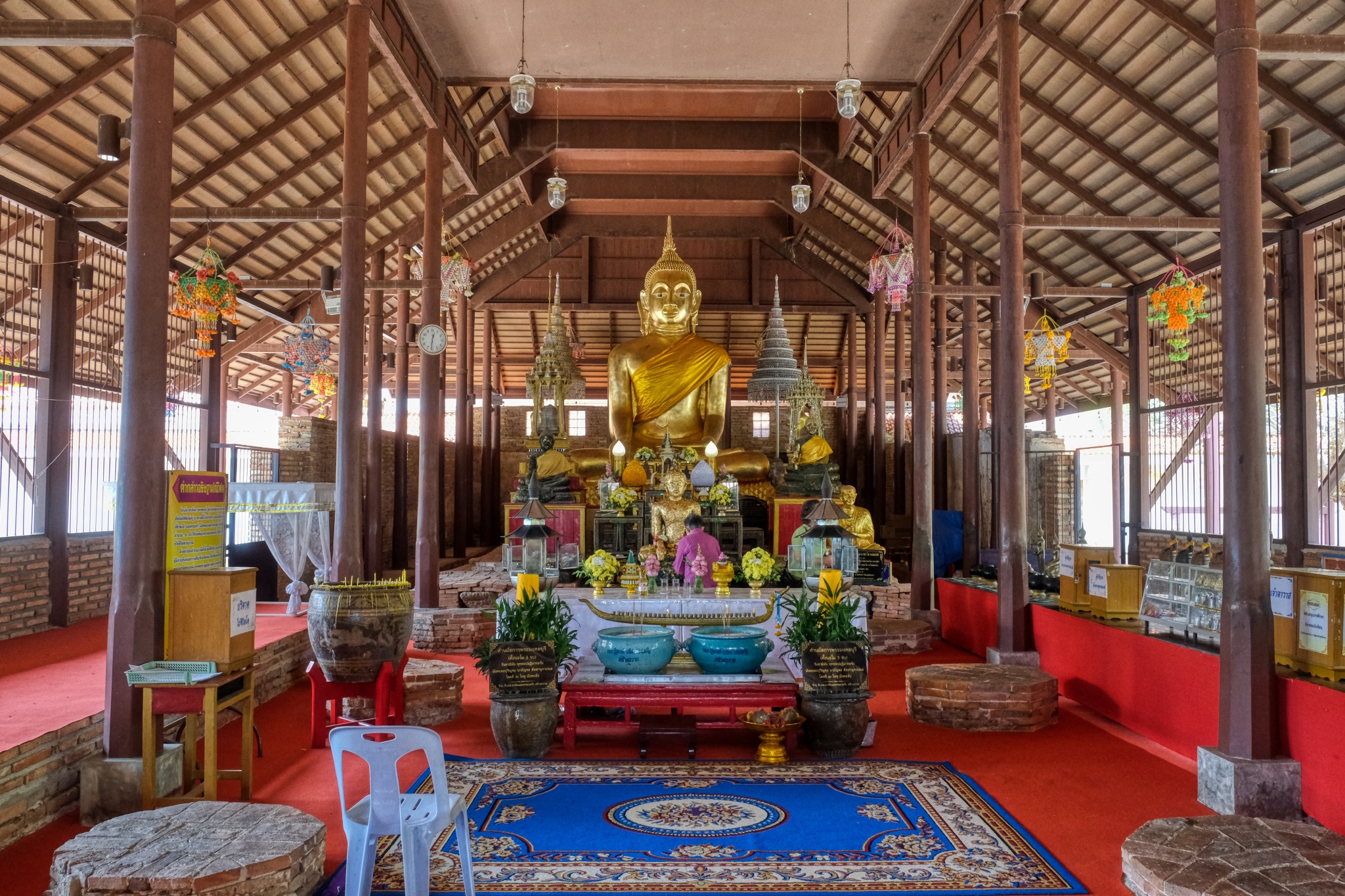 I took my shoes off and went in and discovered this remarkable spiritual space. If you look closely you can see the bases of the pillars that held up an earlier temple in the same location. "It is believed that this temple was built in the Dvaravati Period, around the 10th-11th Century, nearly the same time as when the old city of Ratchaburi was built. Later, a Khmer or Lop Buri sanctuary was built over the temple around the 13th Century to be the centre of the town according to the Khmer belief regarding the universe."
I took my shoes off and went in and discovered this remarkable spiritual space. If you look closely you can see the bases of the pillars that held up an earlier temple in the same location. "It is believed that this temple was built in the Dvaravati Period, around the 10th-11th Century, nearly the same time as when the old city of Ratchaburi was built. Later, a Khmer or Lop Buri sanctuary was built over the temple around the 13th Century to be the centre of the town according to the Khmer belief regarding the universe."
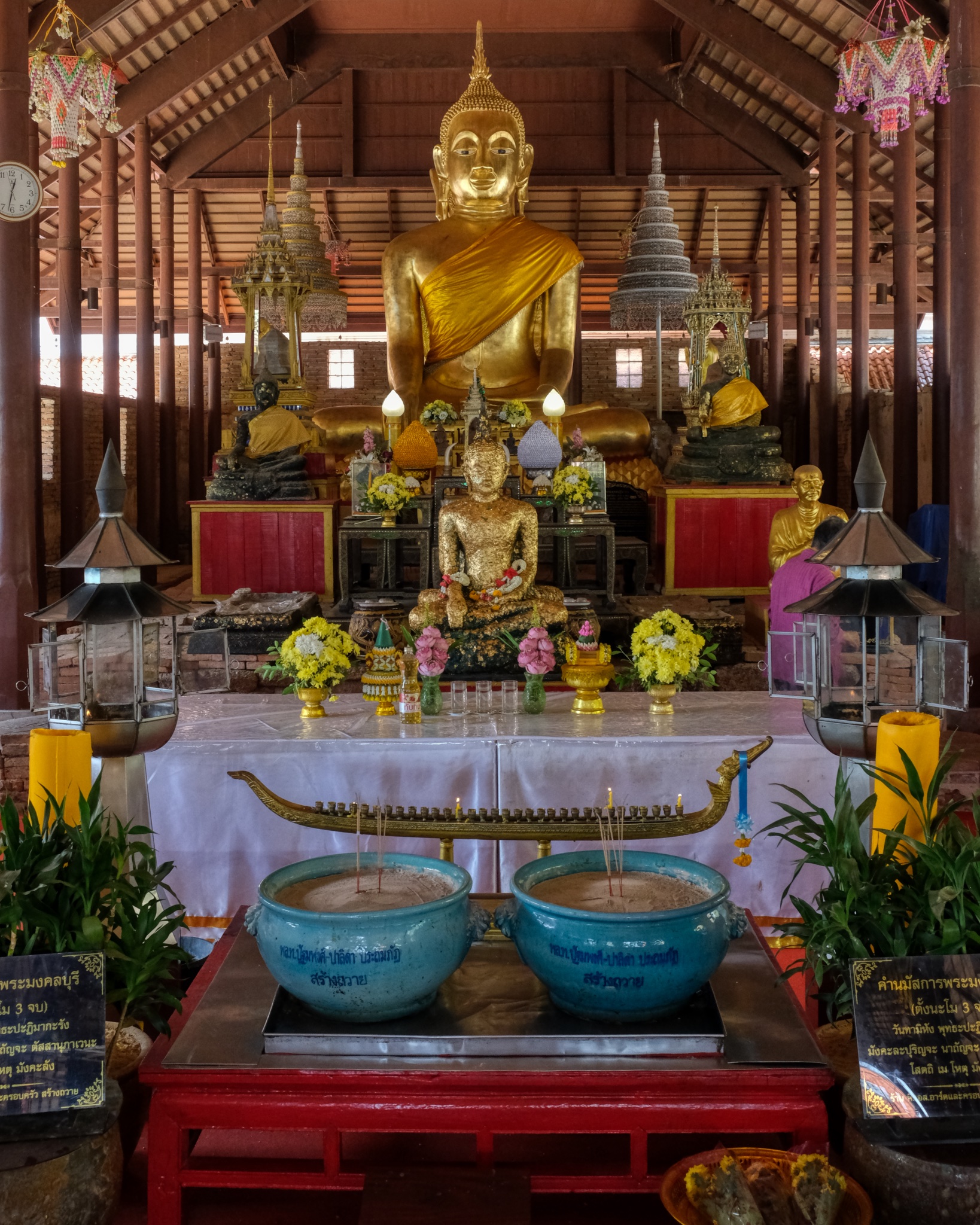 Exquisite Buddha images and a fine altar.
Exquisite Buddha images and a fine altar.
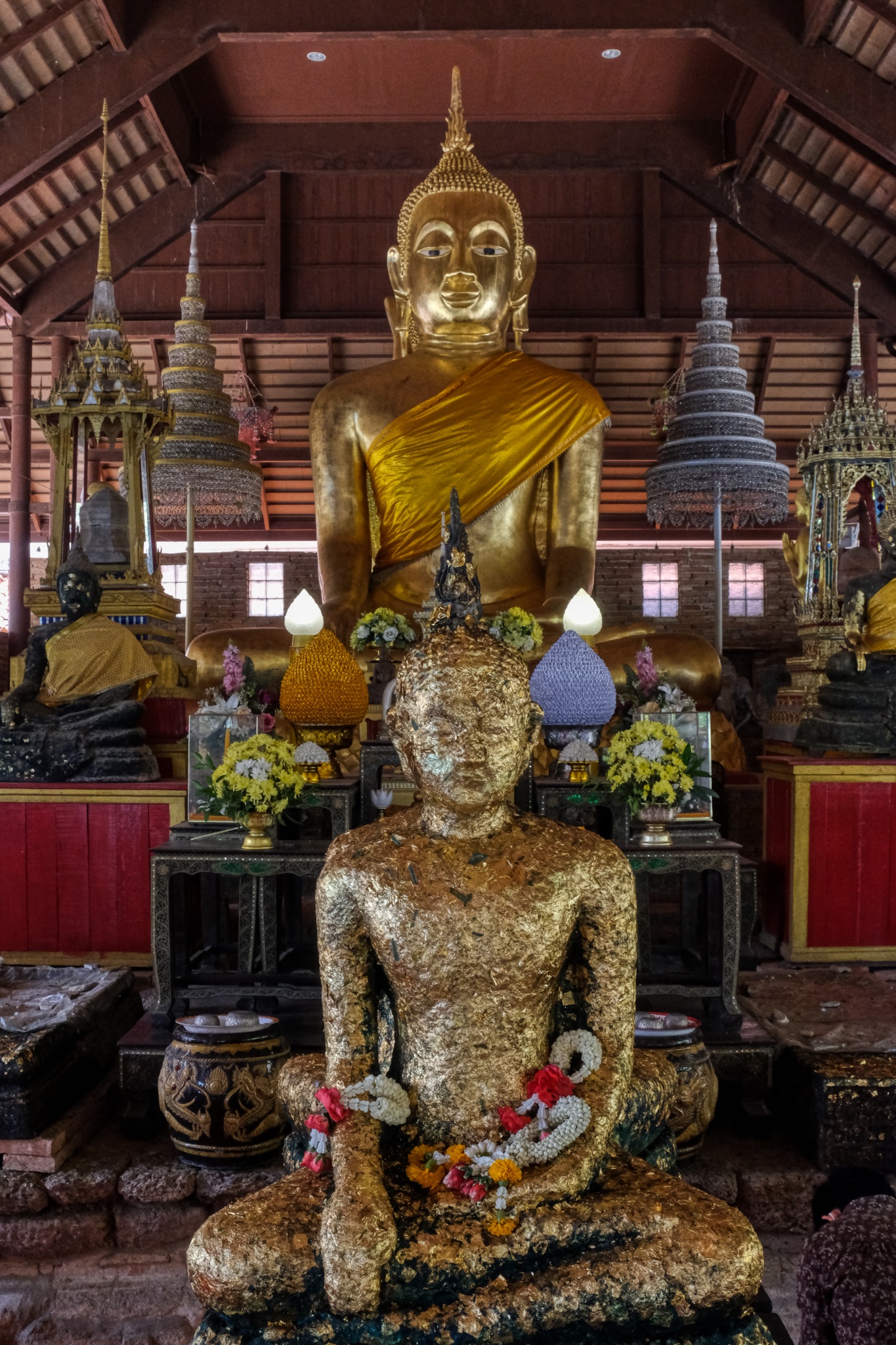 Buddha.
Buddha.
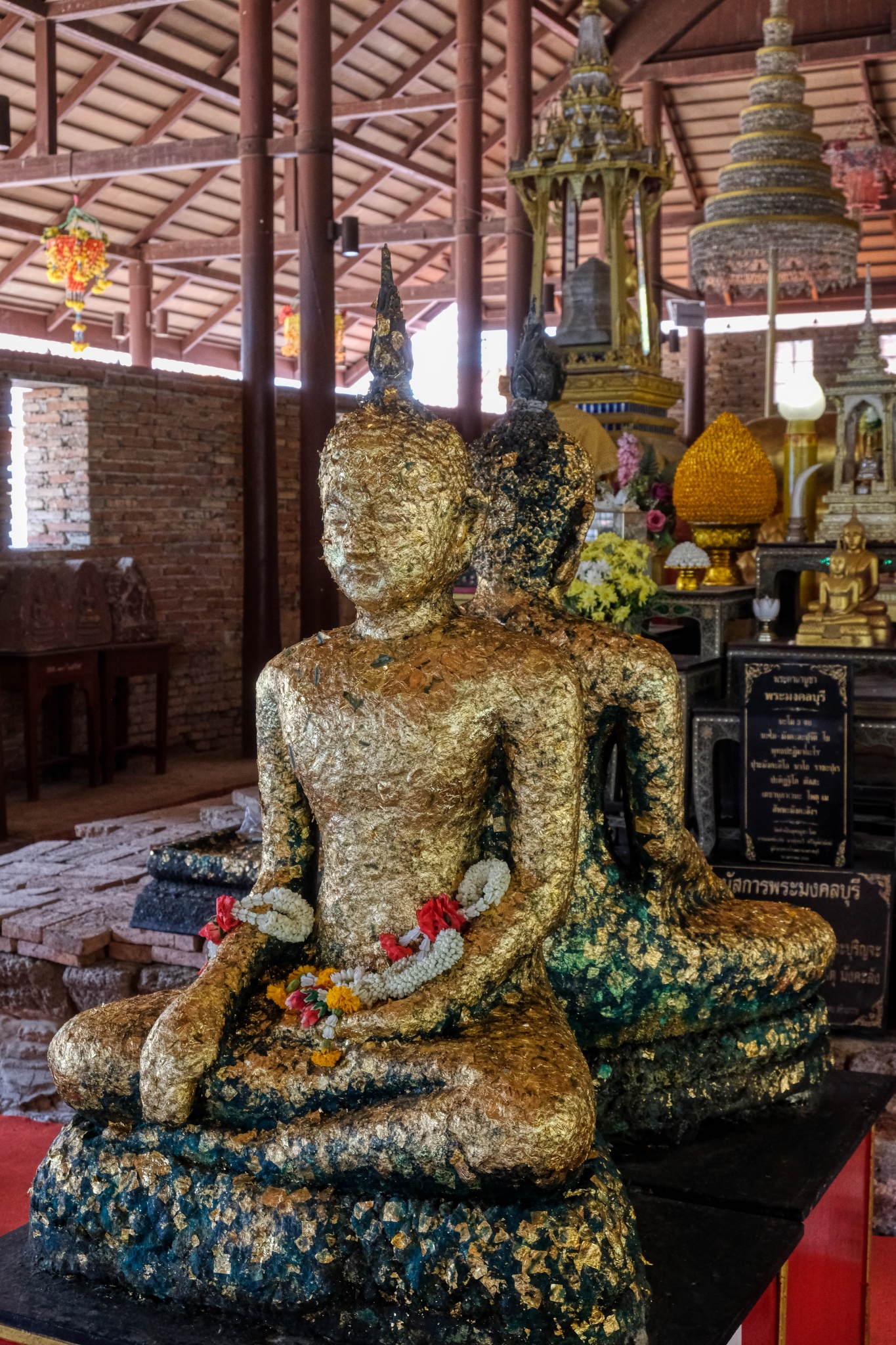 Devotees adorn Buddha images with gold leaf as a part of respectful practices. I was intrigued by these two Buddhas sitting back-to-back.
Devotees adorn Buddha images with gold leaf as a part of respectful practices. I was intrigued by these two Buddhas sitting back-to-back.
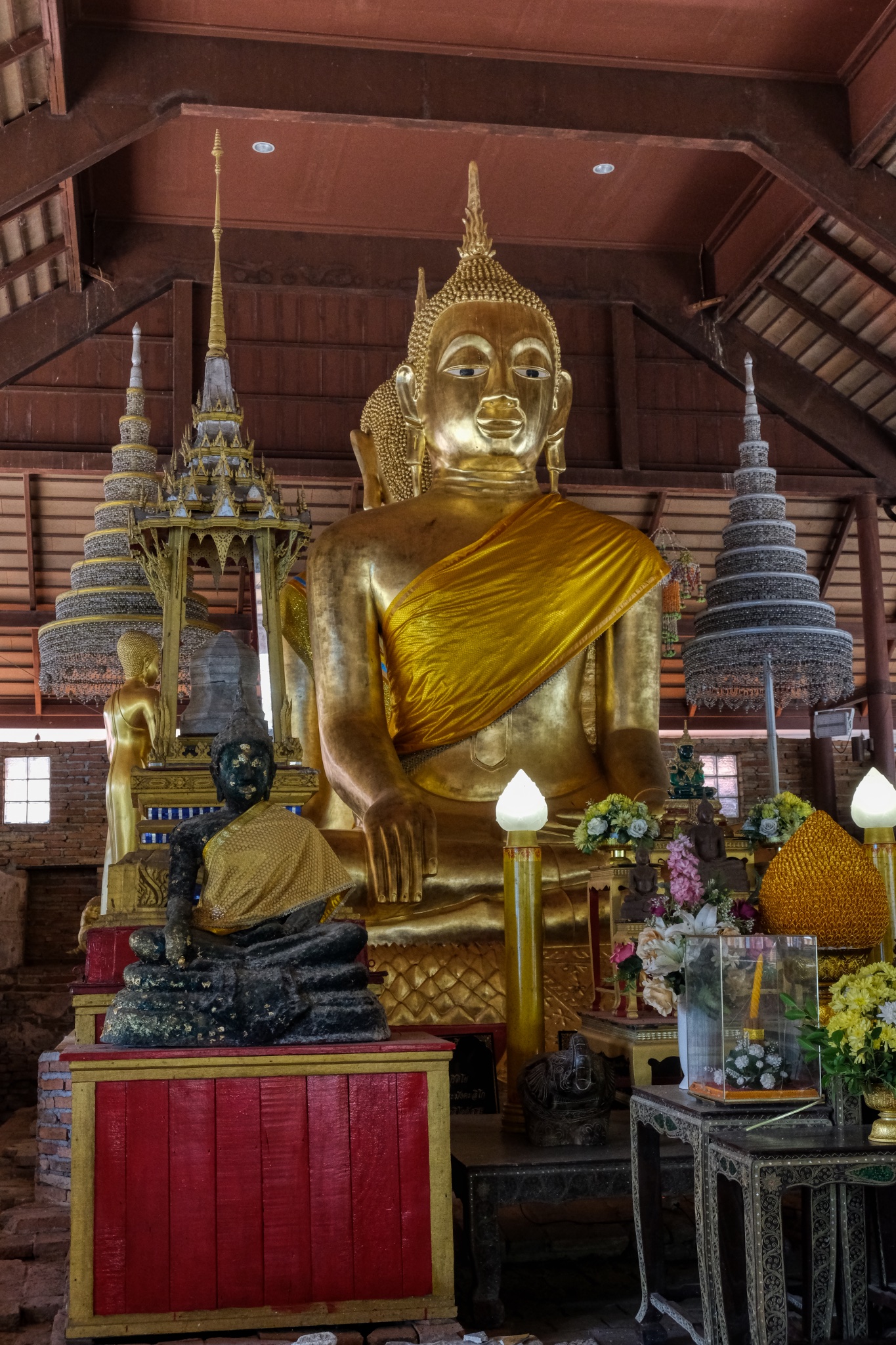 When I looked up at the main, large Buddha image I noticed that it was also a double Buddha. It is very unusual to see two Buddhas sitting back-to-back.
When I looked up at the main, large Buddha image I noticed that it was also a double Buddha. It is very unusual to see two Buddhas sitting back-to-back.
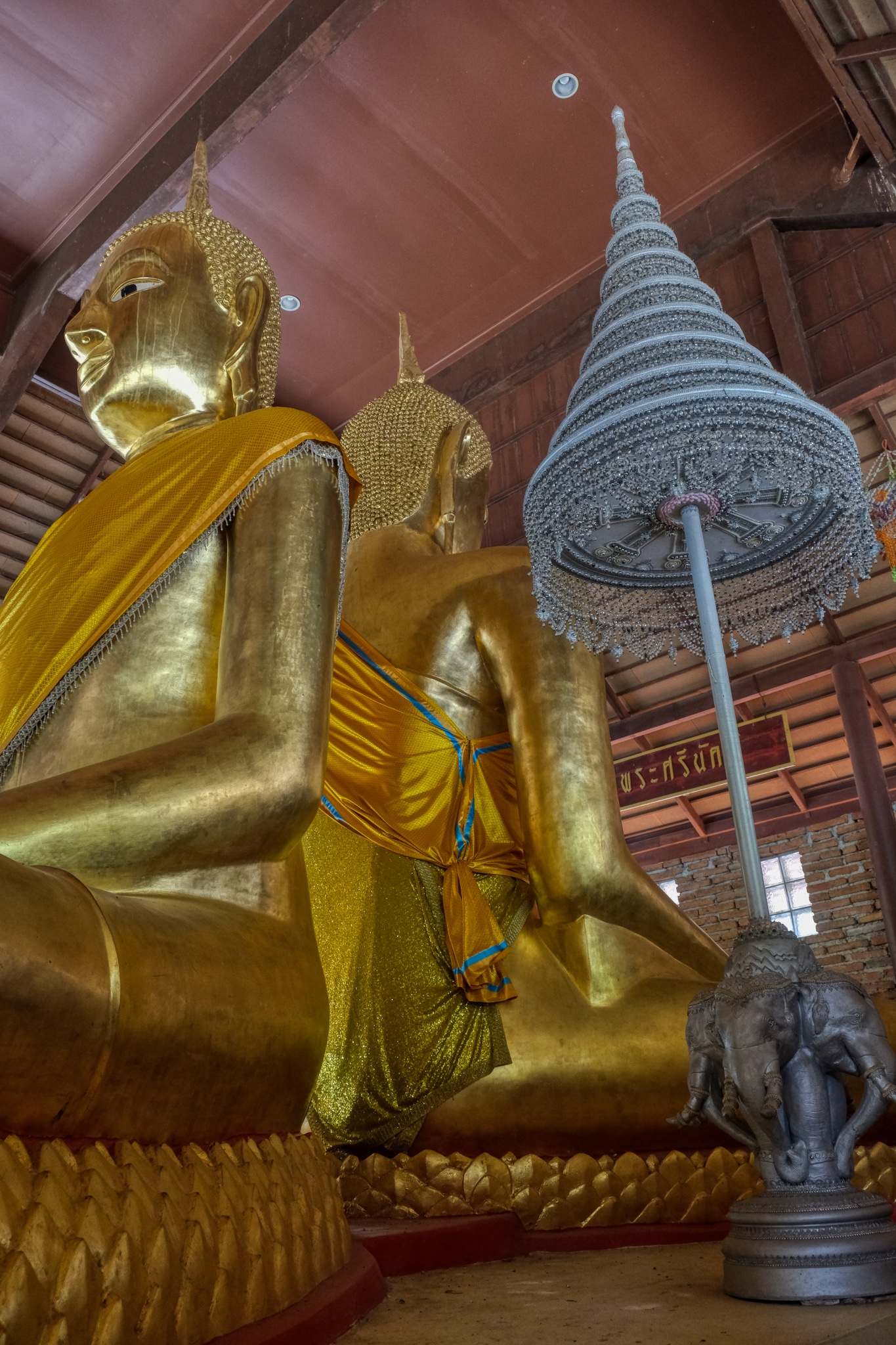 Normally only one Buddha sits in a Wat, and normally facing East.
Normally only one Buddha sits in a Wat, and normally facing East.
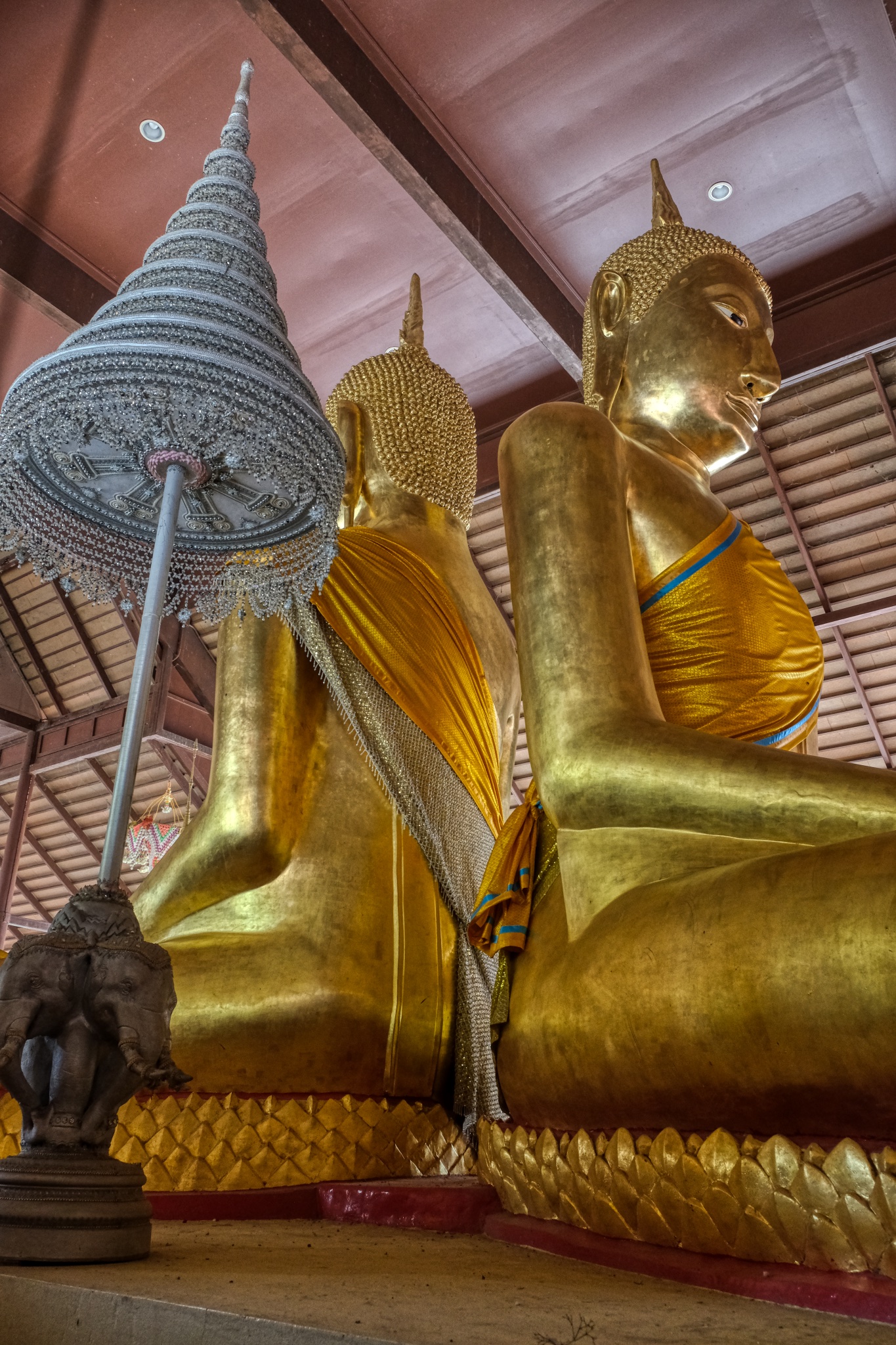 They were extraordinarily beautiful Buddhas. My research turned this up:"It is a stucco Buddha image in the gesture of subduing Mara, which has a lap width of 8 Sok 1 Khuep. Its characteristic is of the Pre-Ayutthaya art, with a Sukhothai style face. It has a long body but short knees. He turns his face to the east, and there is another Buddha image behind his back, turning its face to the opposite side or the west. This means we ask the Buddha’s blessing to prevent danger from the front as well as the back." (citation)
They were extraordinarily beautiful Buddhas. My research turned this up:"It is a stucco Buddha image in the gesture of subduing Mara, which has a lap width of 8 Sok 1 Khuep. Its characteristic is of the Pre-Ayutthaya art, with a Sukhothai style face. It has a long body but short knees. He turns his face to the east, and there is another Buddha image behind his back, turning its face to the opposite side or the west. This means we ask the Buddha’s blessing to prevent danger from the front as well as the back." (citation)
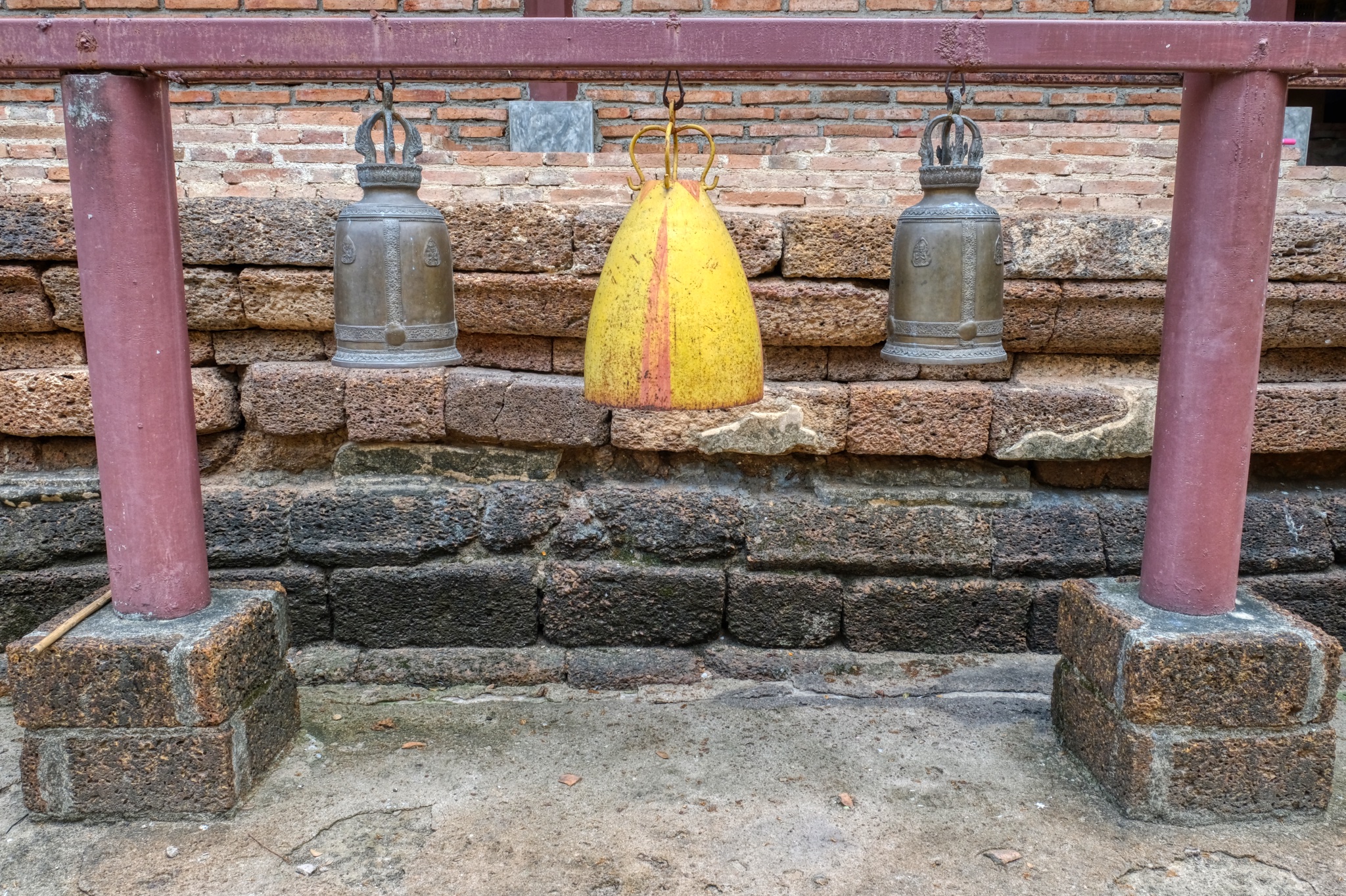 I left the Buddha hall to wander around the wat grounds.
I left the Buddha hall to wander around the wat grounds.
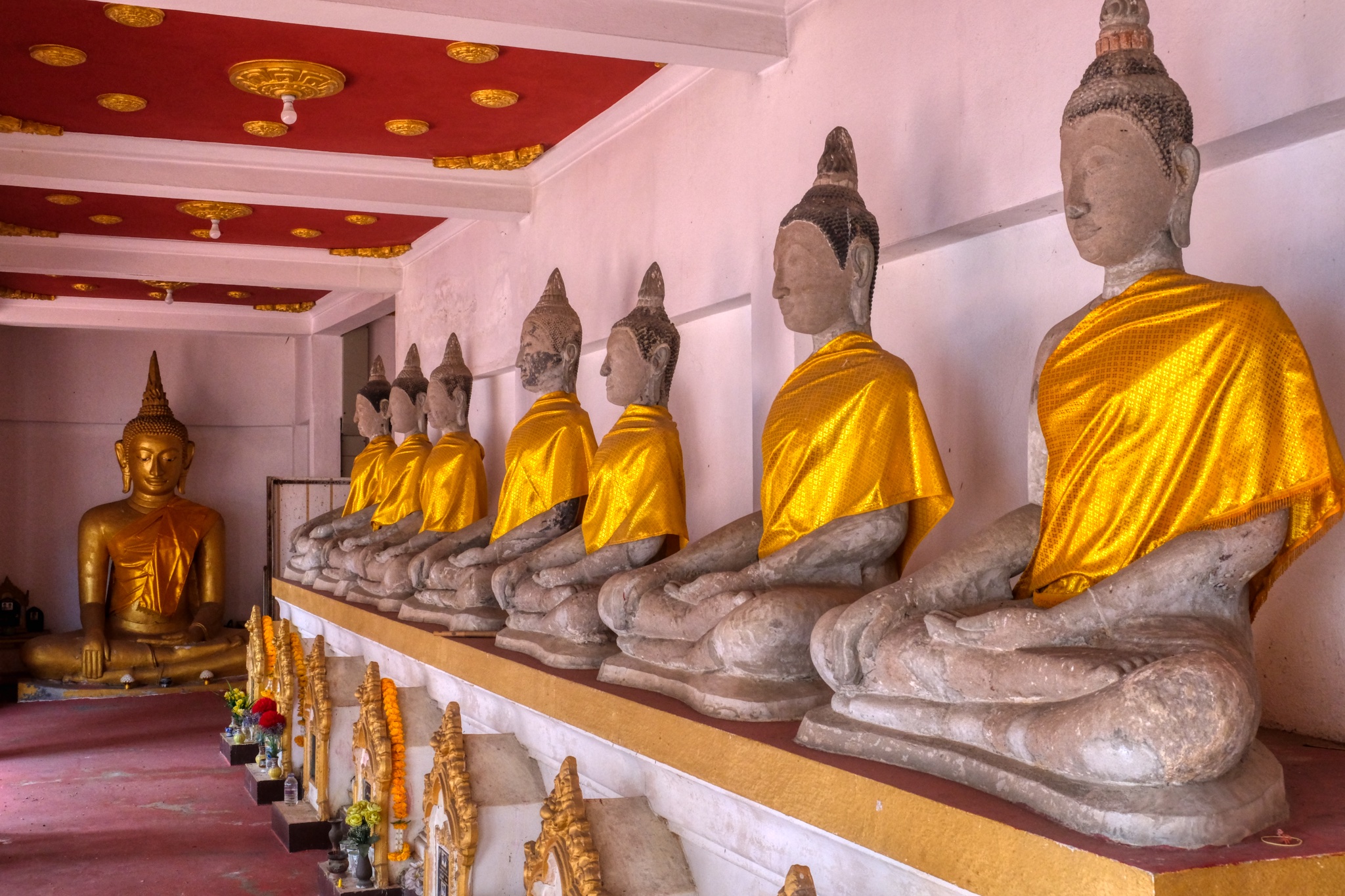 Like many Thai wats, there are covered halls lined with Buddha images, often as markers for the cremated remains of former monks and doners, as is the case here.
Like many Thai wats, there are covered halls lined with Buddha images, often as markers for the cremated remains of former monks and doners, as is the case here.
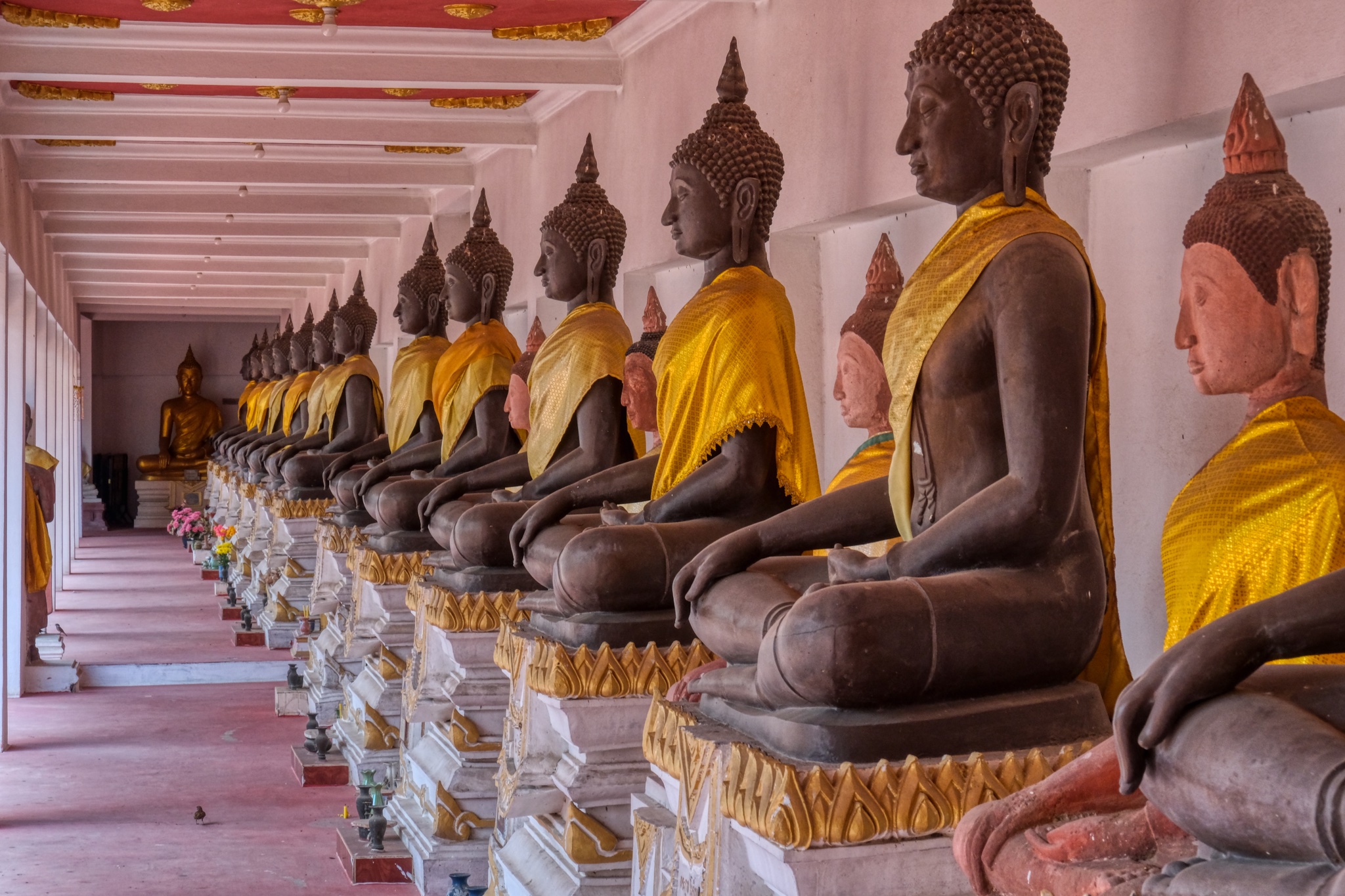 Such a beautiful sight.
Such a beautiful sight.
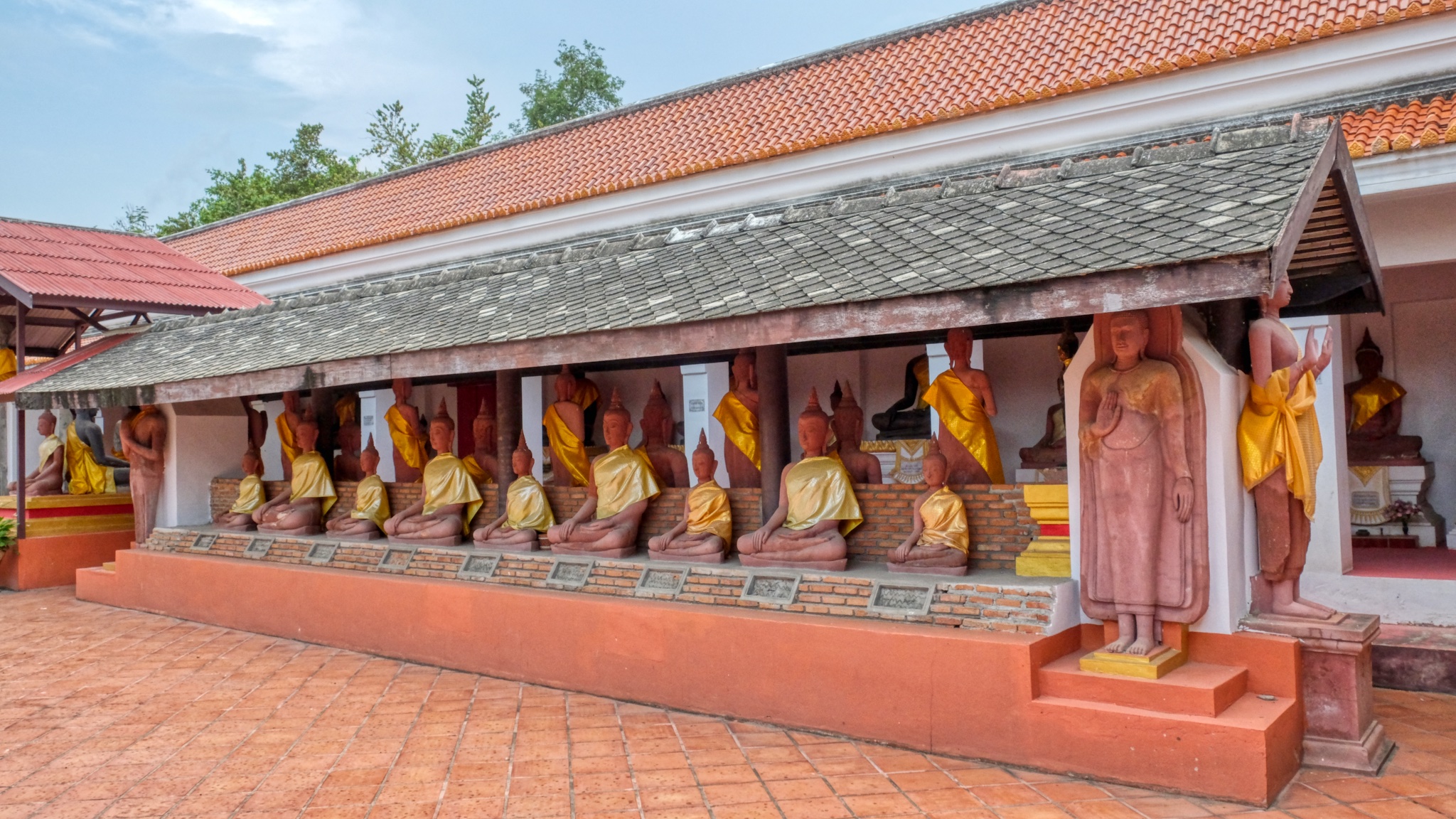 In fact, there are several rows of these grave marking Buddha statues.
In fact, there are several rows of these grave marking Buddha statues.
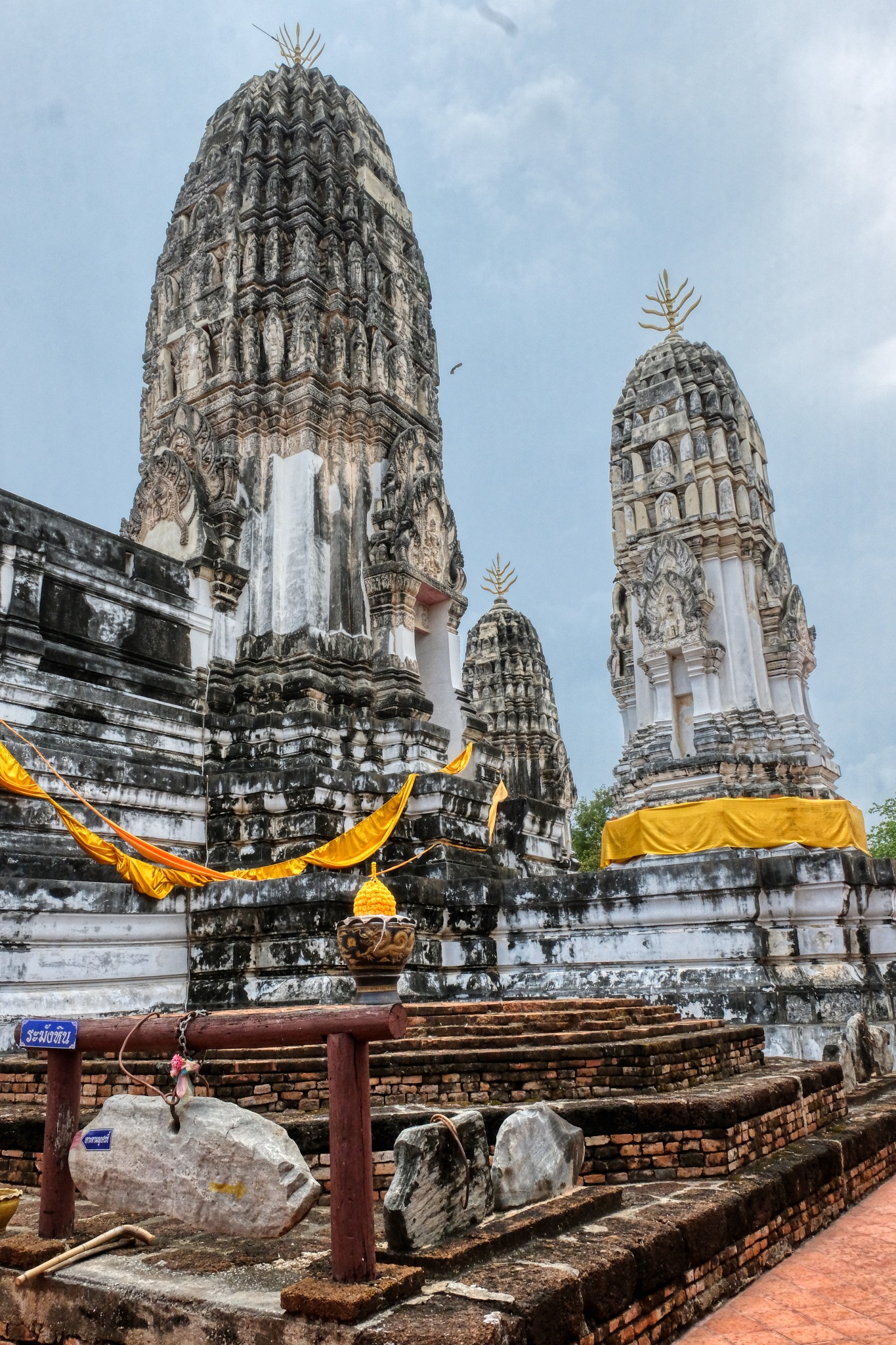 The Five Prangs. At the center of th Wat is a large courtyard enclosed by a cloister. At the center of the courtyard stand five massive parangs, known as "Phra Prang Ha Yod", or five peak prang. The Khmer/Lopburi style towers were constructed during the Sukhothai era.
The Five Prangs. At the center of th Wat is a large courtyard enclosed by a cloister. At the center of the courtyard stand five massive parangs, known as "Phra Prang Ha Yod", or five peak prang. The Khmer/Lopburi style towers were constructed during the Sukhothai era.
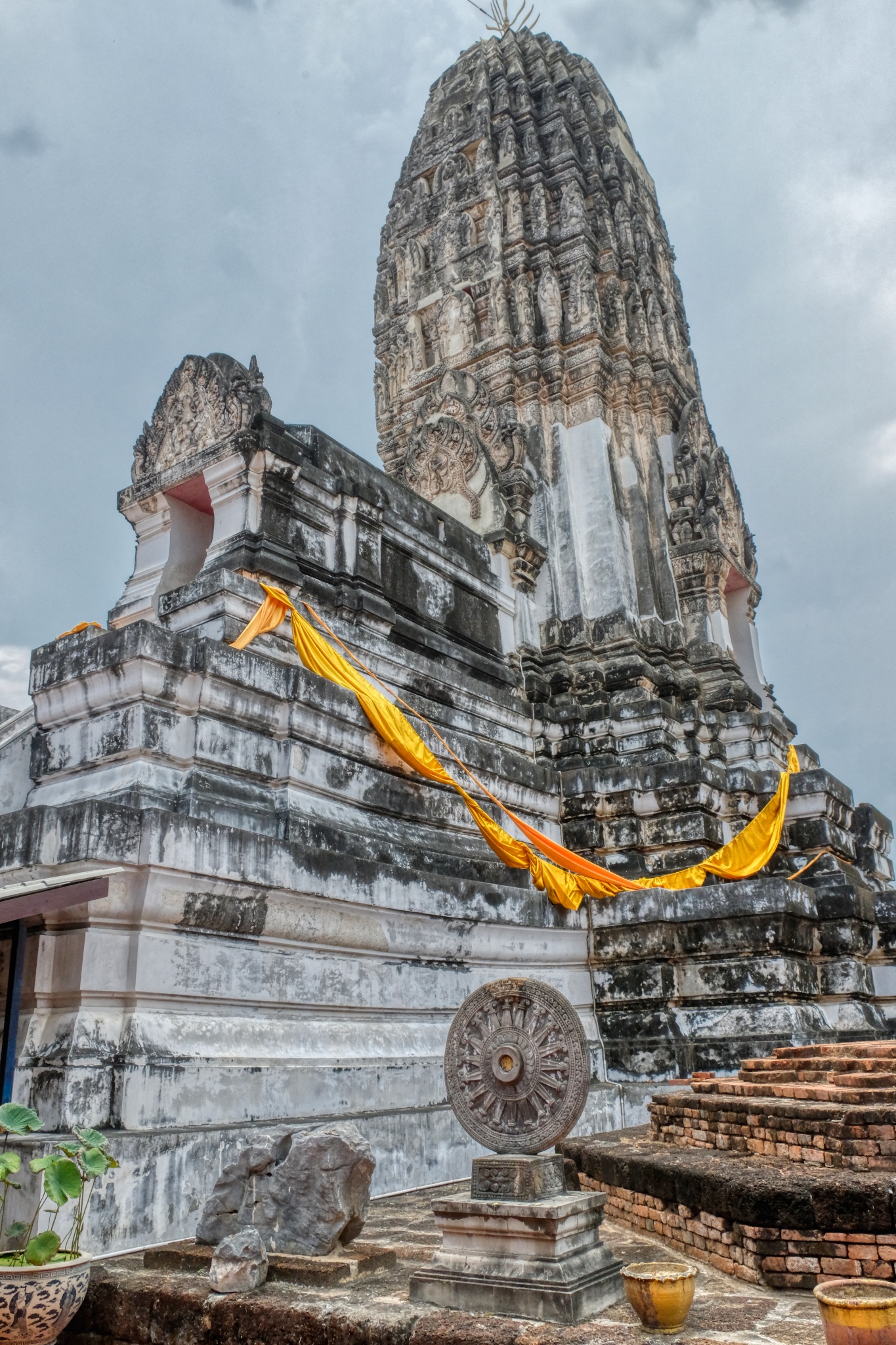
"Surrounded by four smaller ones, the tallest central prang rising over forty meters enshrines Buddha relics. Enshrined in large niches on all of its four faces are standing golden images of the Buddha. The brick plastered prangs, decorated with fine stucco work are topped with a trishula, a three pointed spear, the weapon of the Hindu God Shiva. Sheltering them is a small multi tiered ceremonial umbrella" (citation)
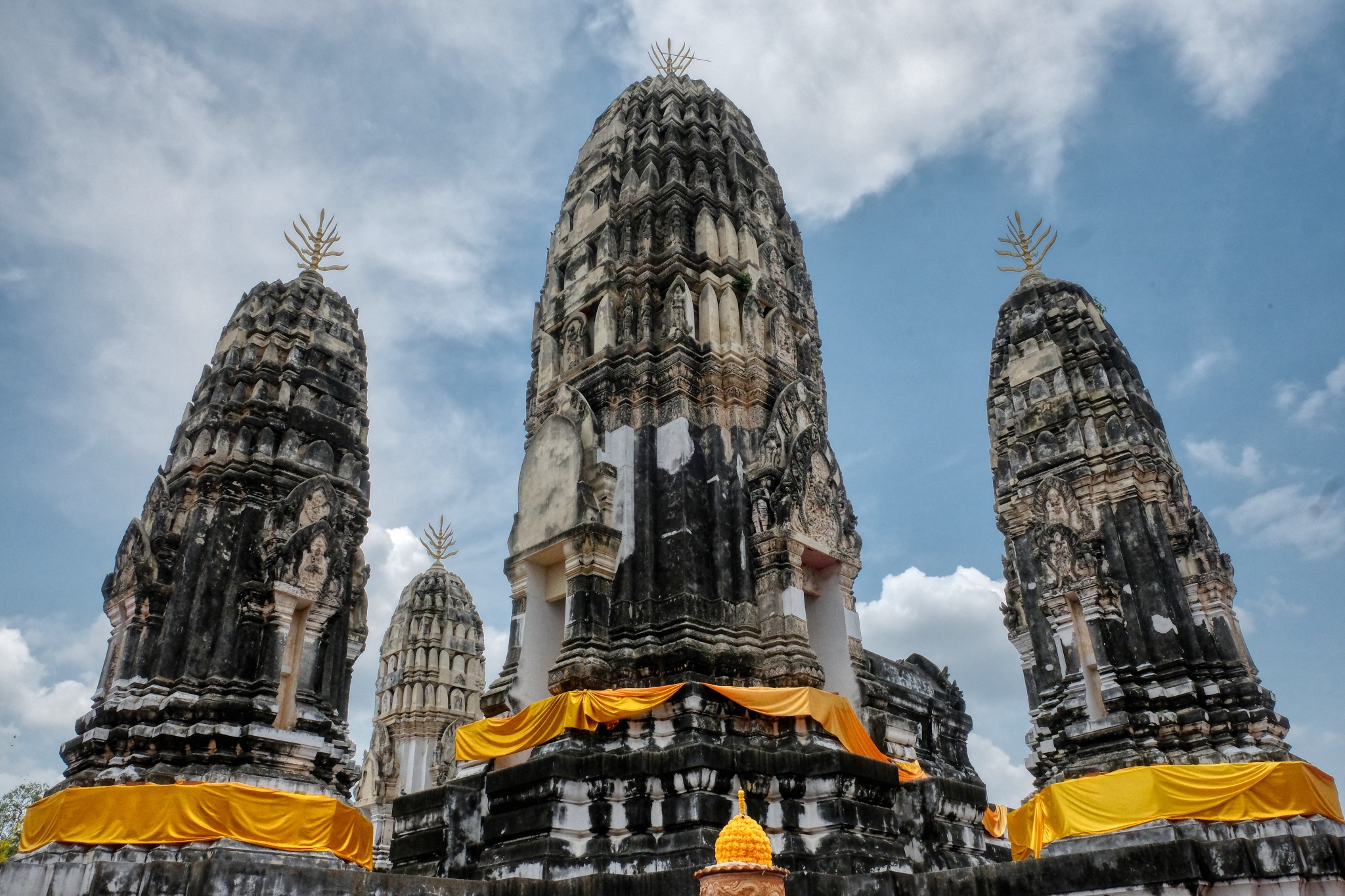 Extraordinary.
Extraordinary.
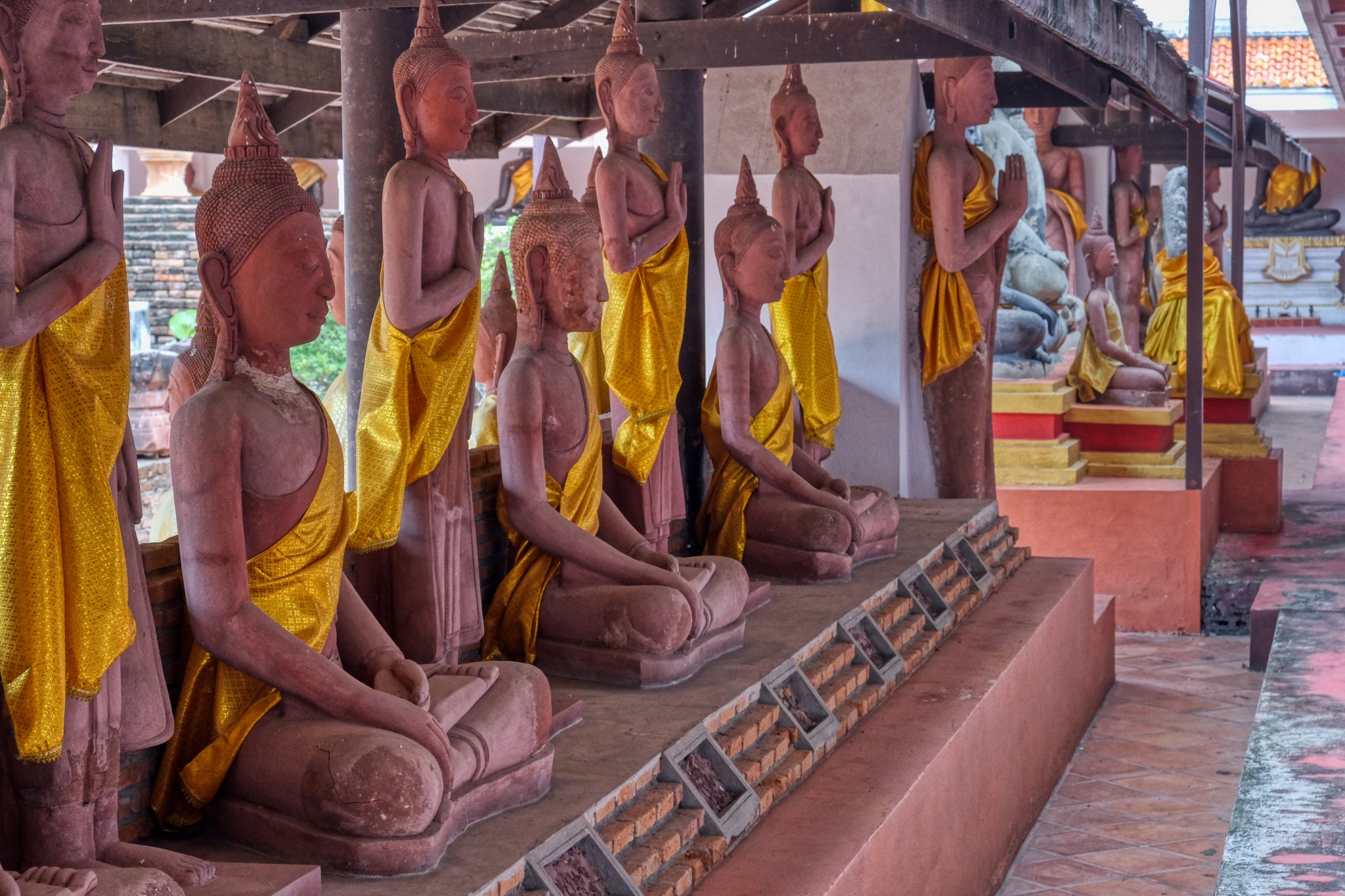 Ah! A phone message from my wife: she is on the 16th hole. Time for me to leave this amazing place. I headed back out along the Buddha colonnades.
Ah! A phone message from my wife: she is on the 16th hole. Time for me to leave this amazing place. I headed back out along the Buddha colonnades.
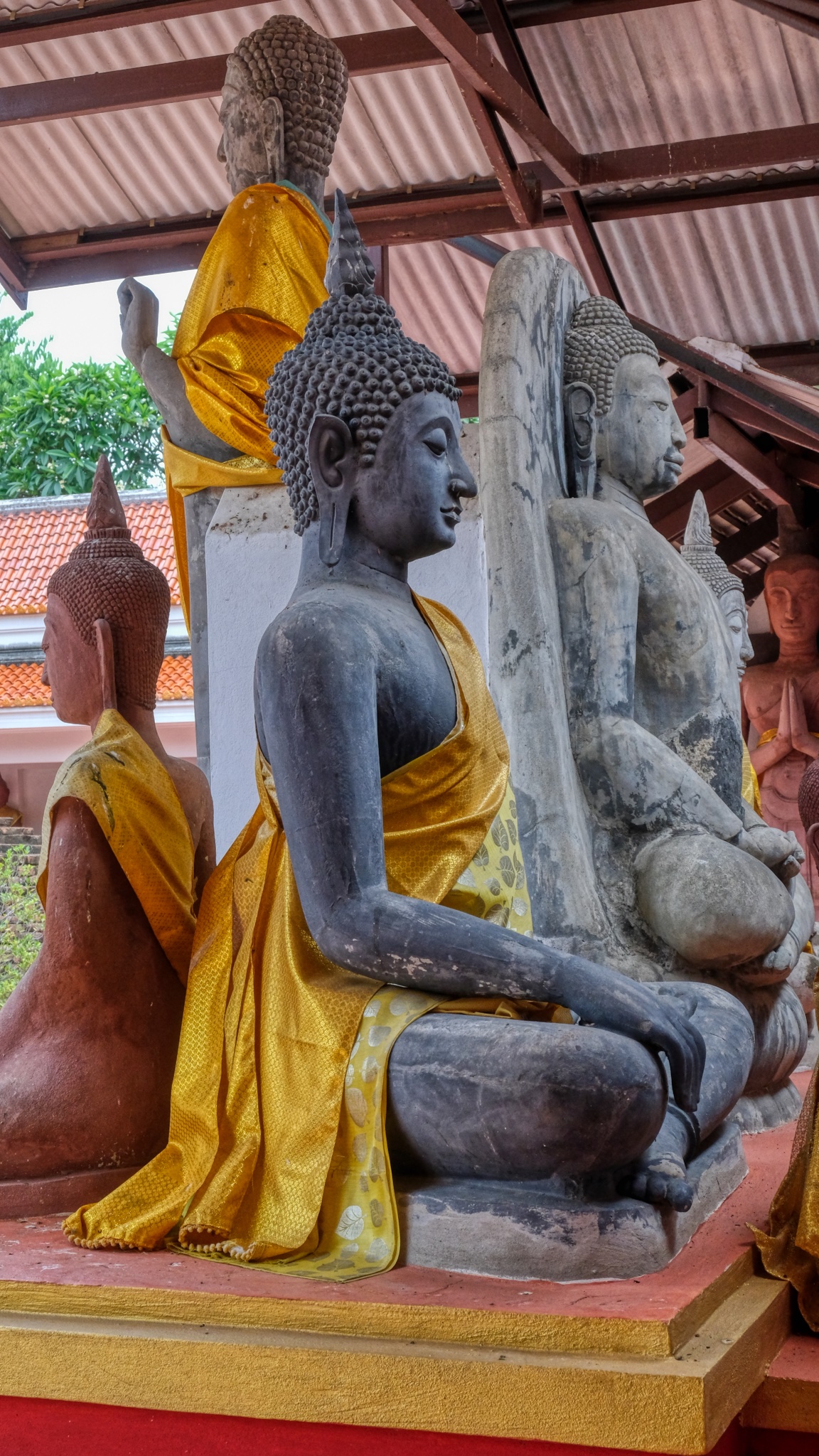 A wide variety of Buddha images present.
A wide variety of Buddha images present.
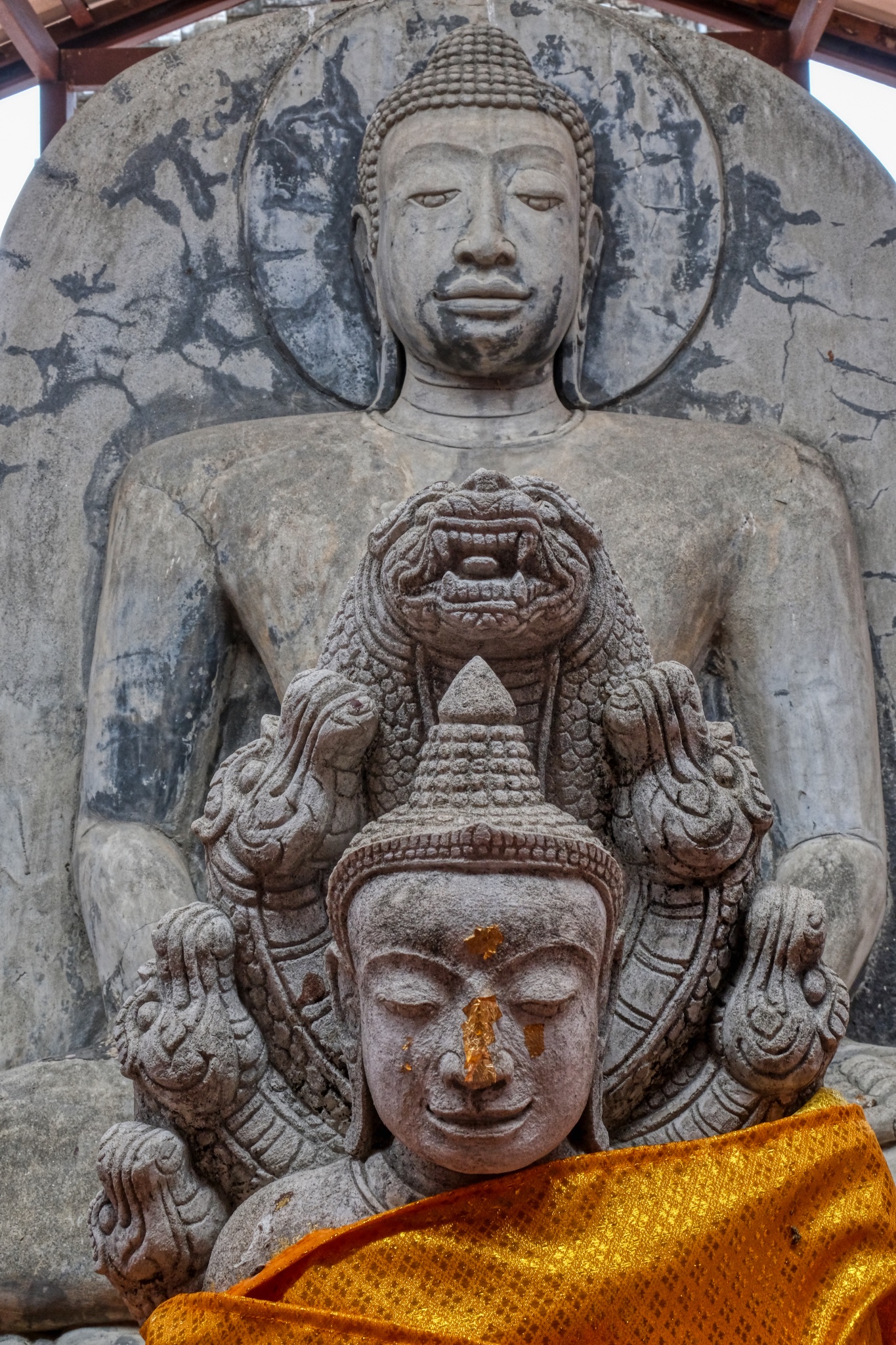 A fine reminder about my mortality and a questioning about what I am doing with my conscieness.
A fine reminder about my mortality and a questioning about what I am doing with my conscieness.
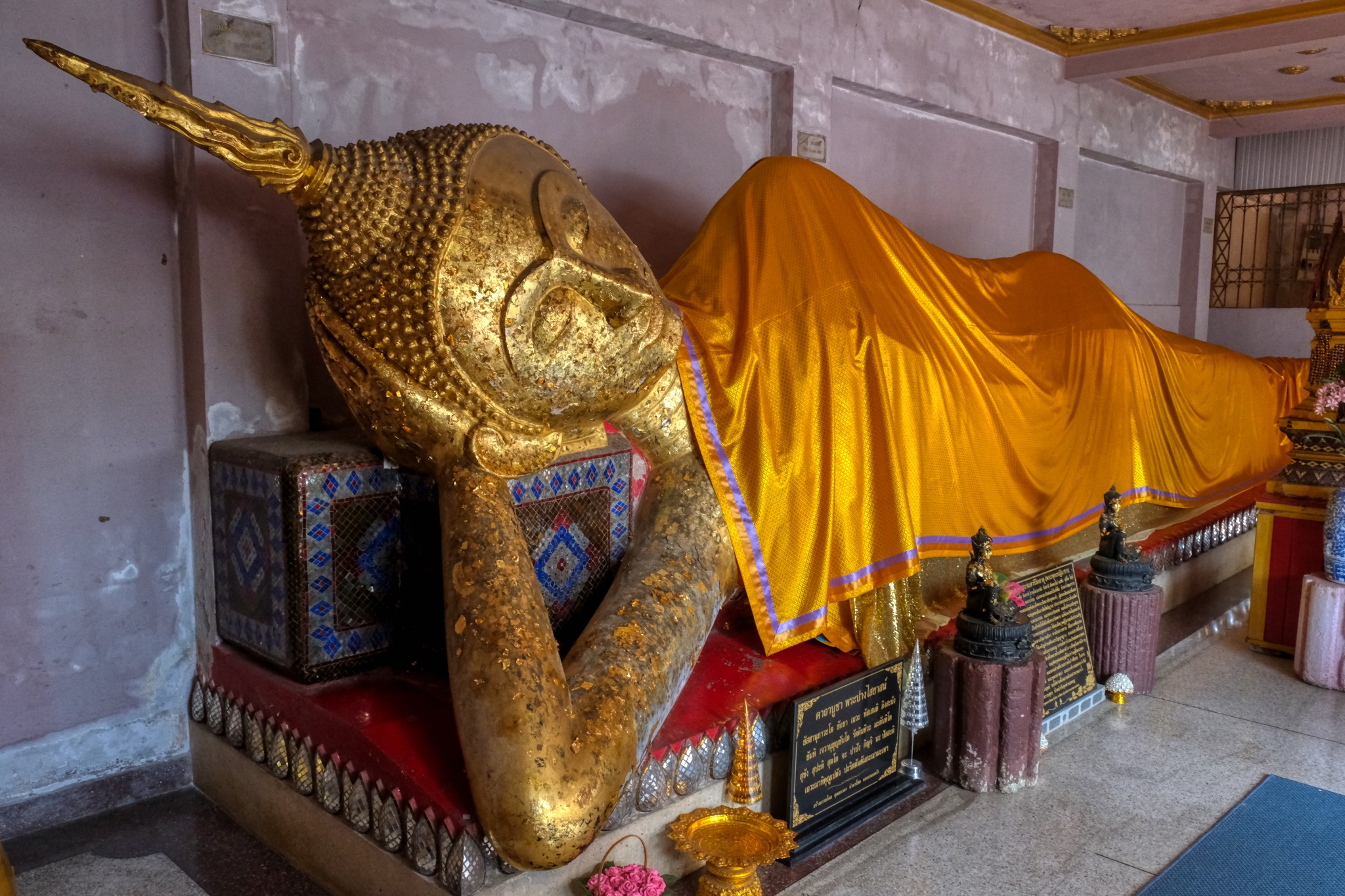 One last grotto . . . to visit a reclining Buddha.
One last grotto . . . to visit a reclining Buddha.
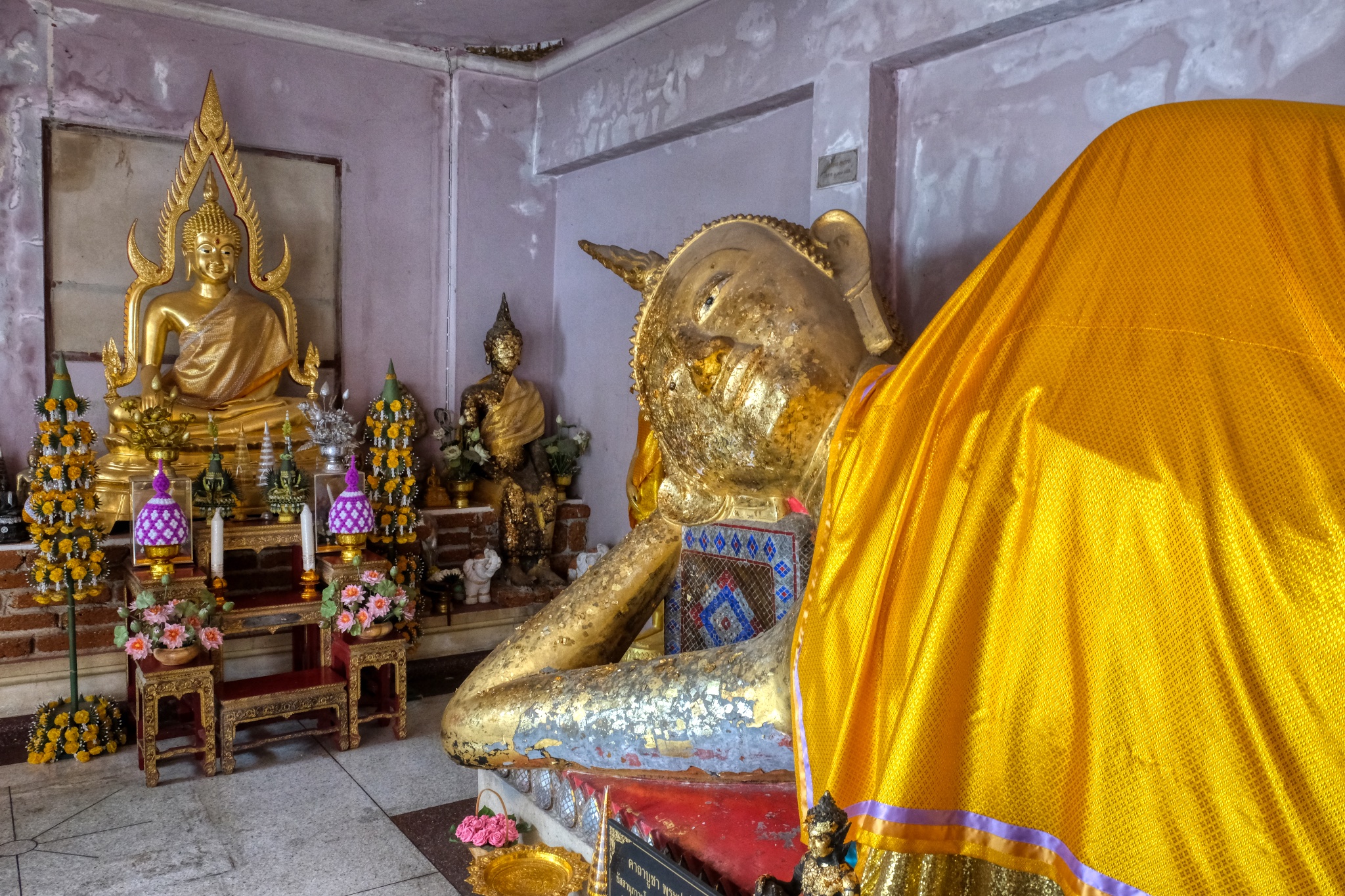 Such a beautiful display. An old 'nun' altar keeper offered me a bottle of water here, which I took. It was a hot day!
Such a beautiful display. An old 'nun' altar keeper offered me a bottle of water here, which I took. It was a hot day!
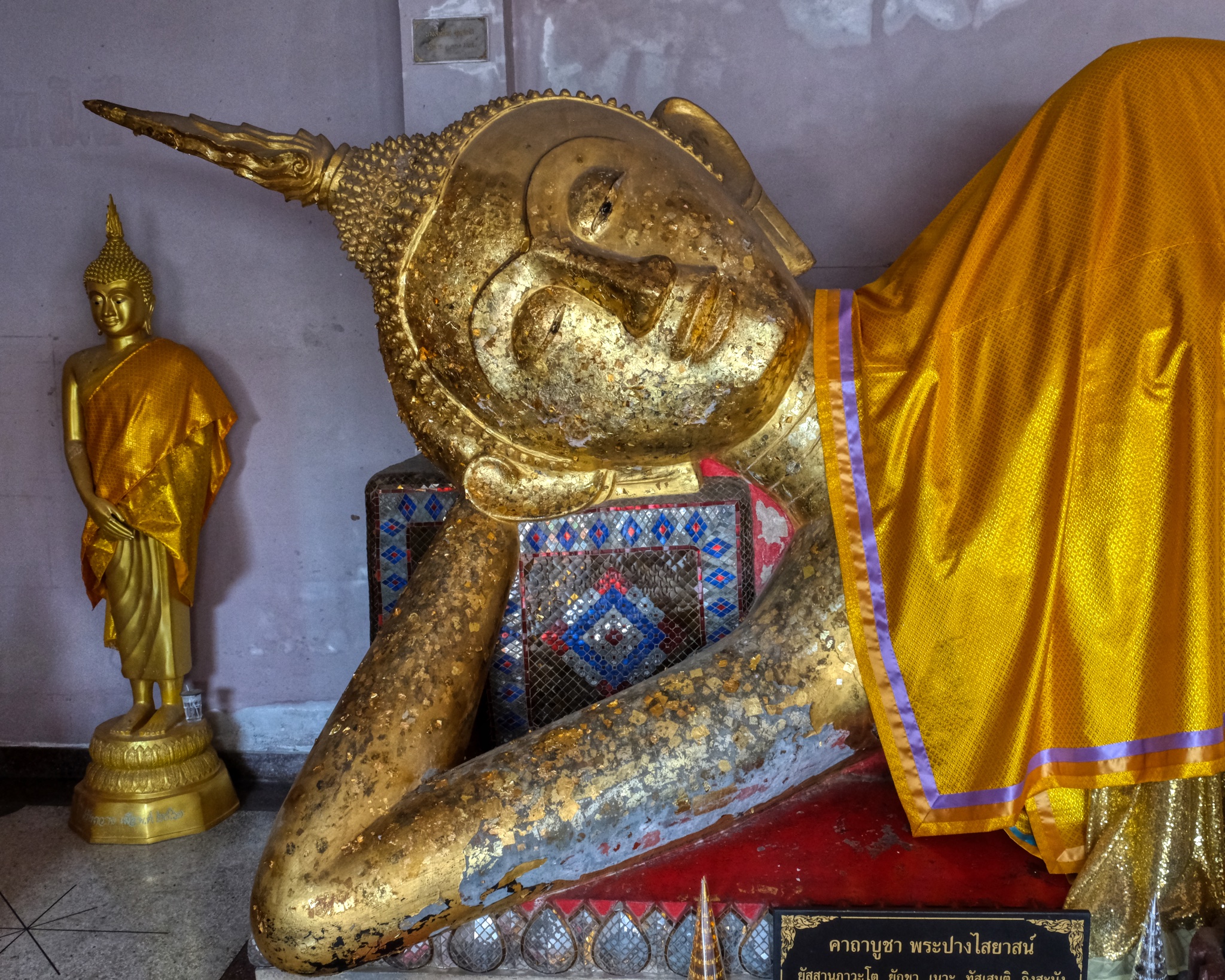 I lingered in this space to pay my respect to the Buddha. I also left my donation here.
I lingered in this space to pay my respect to the Buddha. I also left my donation here.
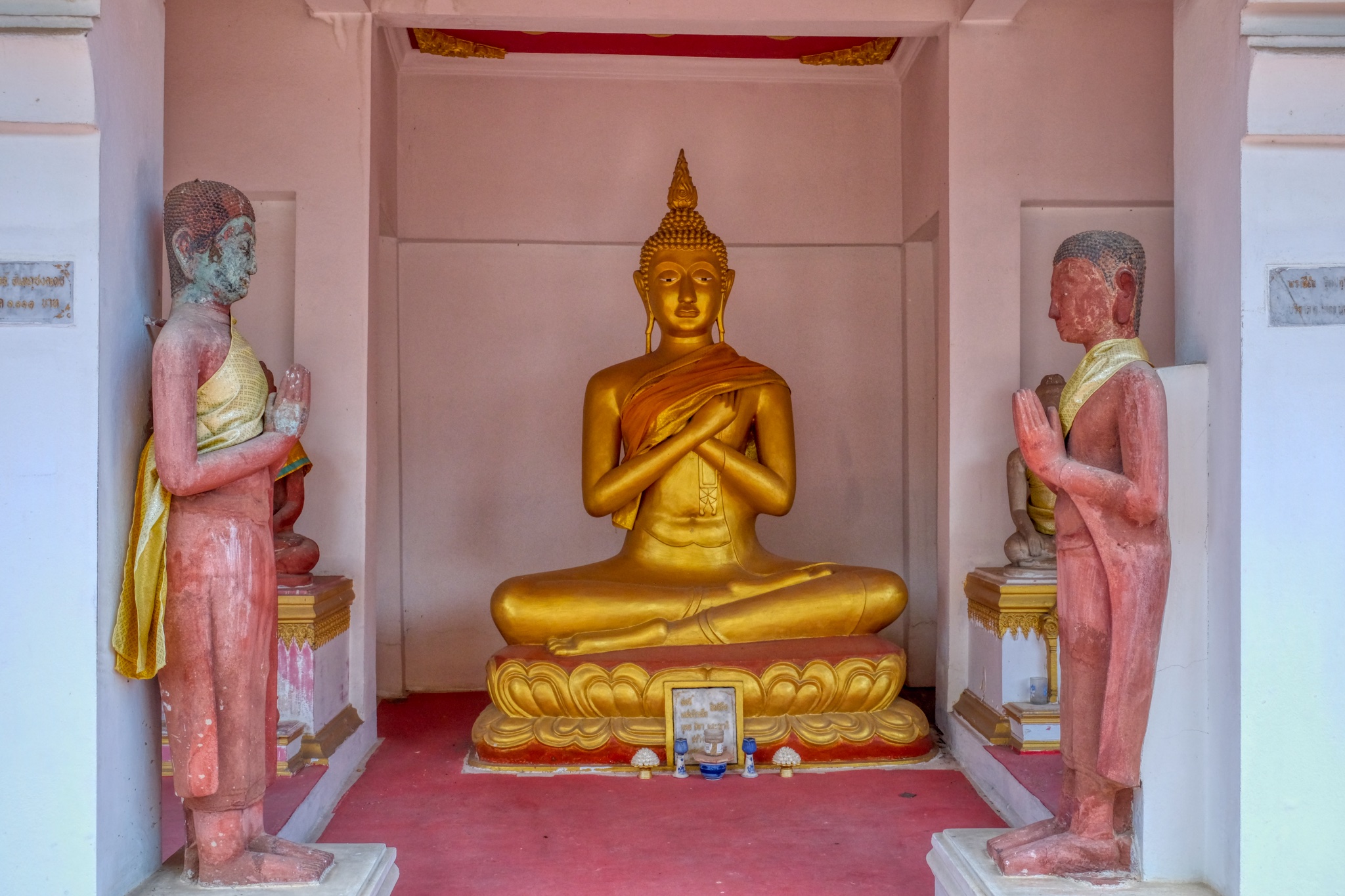 My last stop. Then the 25 minute drive to pick up my wife at the golf course and the 1 hour 45 minute drive back to Hua Hin. A wonderful day . . . .
My last stop. Then the 25 minute drive to pick up my wife at the golf course and the 1 hour 45 minute drive back to Hua Hin. A wonderful day . . . .
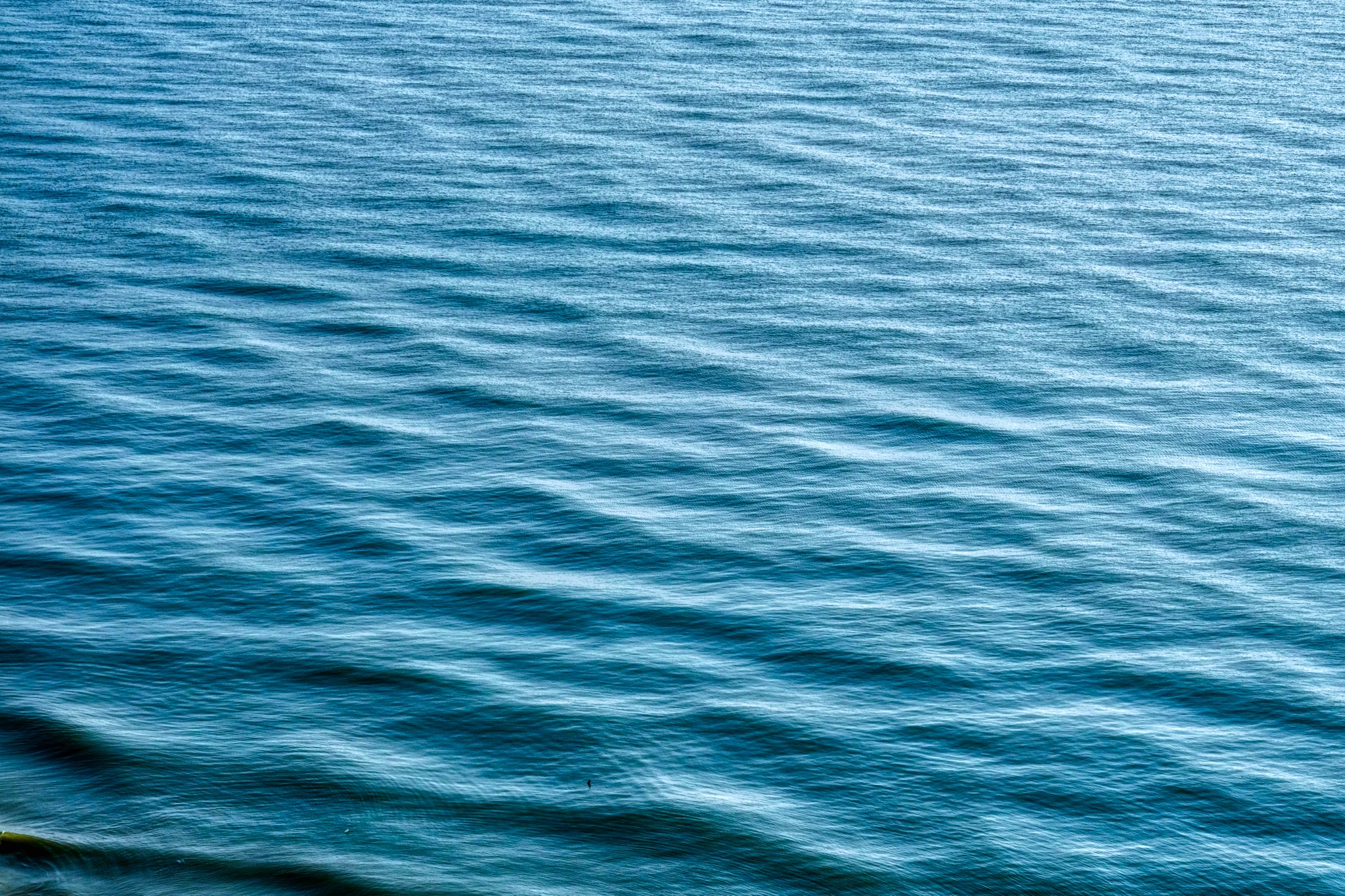 Back on the balcony for a gin & tonic and this strange blue sea . . .
Back on the balcony for a gin & tonic and this strange blue sea . . .
Pandemic Silver Linings: Two Week-End Trips in Khao Yai
 Sunday, March 21, 2021 at 11:16AM
Sunday, March 21, 2021 at 11:16AM The first Khao Yai week-end . . . . small roads and beautiful temples.
 As my university has called off live, in-person instruction, I have been making my lessons at home and posting them online. This has had the hidden benefit of allowing me to physically be wherever I want to be, as long as I have a computer and a good internet connection. So twice in the last month my wonderful wife and I have gone up to the mountains of Khao Yai, 2 1/2 hours northeast of Bangkok.
As my university has called off live, in-person instruction, I have been making my lessons at home and posting them online. This has had the hidden benefit of allowing me to physically be wherever I want to be, as long as I have a computer and a good internet connection. So twice in the last month my wonderful wife and I have gone up to the mountains of Khao Yai, 2 1/2 hours northeast of Bangkok.
 We visited friends at Toscana Valley in Khao Yai.
We visited friends at Toscana Valley in Khao Yai.
 Khao Yai is a region at the western end of Sankamphaeng Mountain Range and is a heavily wooded area with a fair amount of natural environment still with wild animals, such as elephant and tigers, in the Khao Yai National Park.
Khao Yai is a region at the western end of Sankamphaeng Mountain Range and is a heavily wooded area with a fair amount of natural environment still with wild animals, such as elephant and tigers, in the Khao Yai National Park.
 Although Khao Yai is known for the National Park, much of the region is developed for weekenders from Bangkok to escape the city hear (especially in the 'cool season'). There are many, many small resorts and tourist activities sprinkled around the beautiful countryside . . . as well as an interesting assortment of Buddhist Wats.
Although Khao Yai is known for the National Park, much of the region is developed for weekenders from Bangkok to escape the city hear (especially in the 'cool season'). There are many, many small resorts and tourist activities sprinkled around the beautiful countryside . . . as well as an interesting assortment of Buddhist Wats.
 So, while my wife played golf at the beautiful courses in the area, I explored the small roads to see what I could see. . . .
So, while my wife played golf at the beautiful courses in the area, I explored the small roads to see what I could see. . . .
 I had fun following 'points of interest' signs . . . and seeing if I could get to the hilltop temples I could see here and there in the landscape.
I had fun following 'points of interest' signs . . . and seeing if I could get to the hilltop temples I could see here and there in the landscape.
 Wat Sanaamsai is a giant white Buddha statue on top of a hill. To get there you have to climb up hundreds of stairs.
Wat Sanaamsai is a giant white Buddha statue on top of a hill. To get there you have to climb up hundreds of stairs.
 Hundreds of stairs and hundreds of bells to be rung.
Hundreds of stairs and hundreds of bells to be rung.
 I am often amused by the cartoonish monks who adorn Buddhist shrines and altars in Thailand. I decided to light some incense and candles before I embarked on the hundreds of steps. Fortunately, some nice people pointed out that I could drive all the way to the top if I wanted to. So I drove up.
I am often amused by the cartoonish monks who adorn Buddhist shrines and altars in Thailand. I decided to light some incense and candles before I embarked on the hundreds of steps. Fortunately, some nice people pointed out that I could drive all the way to the top if I wanted to. So I drove up.
 In addition to a fine mandala, there was a wonderful view across Khao Yai from the top of the stairs.
In addition to a fine mandala, there was a wonderful view across Khao Yai from the top of the stairs.
 I was glad that I hadn't walked up the stairs!
I was glad that I hadn't walked up the stairs!
 A fantastic giant Buddha image looking out over the valley.
A fantastic giant Buddha image looking out over the valley.

I loved this row of Buddha statues in the many symbolic poses.
 So many beautiful Wats in rural Thailand, and it seemed like there were more than the average number here in Khao Yai.
So many beautiful Wats in rural Thailand, and it seemed like there were more than the average number here in Khao Yai.
 Such a pretty setting for this hilltop Wat.
Such a pretty setting for this hilltop Wat.
 Back out driving on the small farm roads through a great variety of agricultural crops. These were planted in quite a few fields . . . but I have no idea what they were for.
Back out driving on the small farm roads through a great variety of agricultural crops. These were planted in quite a few fields . . . but I have no idea what they were for.
 Even out on the smallest rural roads there are little stalls for Thai street food.
Even out on the smallest rural roads there are little stalls for Thai street food.
 I saw a temple on a hill top and drove along very small rural lanes until I found the entrance.
I saw a temple on a hill top and drove along very small rural lanes until I found the entrance.
 I eventually found the Wat entry . . . and drove up the steep hill.
I eventually found the Wat entry . . . and drove up the steep hill.
 The road did not go all the way to the top. I parked and found the steep steps to the top. I opted to take a service path that wound along the side of the steep hill.
The road did not go all the way to the top. I parked and found the steep steps to the top. I opted to take a service path that wound along the side of the steep hill.
 The walk up to the temple had wonderful views out over the surrounding farm land. Some say this area looks like the Italian countryside around Tuscany.
The walk up to the temple had wonderful views out over the surrounding farm land. Some say this area looks like the Italian countryside around Tuscany.
 I arrived at last on top to discover a very fine, new Wat.
I arrived at last on top to discover a very fine, new Wat.
 Magnificent. Wat Pa Phu Hai Long.
Magnificent. Wat Pa Phu Hai Long.
 Buddhas of all kinds atop the hill.
Buddhas of all kinds atop the hill.
 A grand view.
A grand view.
 I love these stone balls that have been covered in gold leaf by pilgrims.
I love these stone balls that have been covered in gold leaf by pilgrims.
 Such an interesting contrast of shapes and textures . . .
Such an interesting contrast of shapes and textures . . .
 I left a donation at the beautiful altar.
I left a donation at the beautiful altar.
 I was sorry I had to leave this wat . . . it was so beautiful up on the hilltop.
I was sorry I had to leave this wat . . . it was so beautiful up on the hilltop.
 I enjoyed my walk back down the hill from the temple . . . and admired the view. Many people say this region of Thailand reminds them of Tuscany in Italy . . . yes, it does.
I enjoyed my walk back down the hill from the temple . . . and admired the view. Many people say this region of Thailand reminds them of Tuscany in Italy . . . yes, it does.
 I saw this little fellow near the car park.
I saw this little fellow near the car park.
 We stayed at the guest house at the Tuscana Resort, an Italian-themed development for mostly Bangkok week-enders. Beautiful.
We stayed at the guest house at the Tuscana Resort, an Italian-themed development for mostly Bangkok week-enders. Beautiful.
___________________________________________________
A Second Week-end Trip to Khao Yai: A Buddha Cave and a Floating Market Garden
 Another week-end out and about on the country roads of Khao Yai while my wife played golf.
Another week-end out and about on the country roads of Khao Yai while my wife played golf.
 Just a village Wat along a country road.
Just a village Wat along a country road.
 Such a wonderful, and brand new temple. So new, in fact, there was no sign and no marking on GoogleMaps.
Such a wonderful, and brand new temple. So new, in fact, there was no sign and no marking on GoogleMaps.
 There are an abundance of Wats to see in Khao Yai. This one on the way to the Magic Caves.
There are an abundance of Wats to see in Khao Yai. This one on the way to the Magic Caves.
 A beautiful multi-roofed staircase leading to a hilltop Chedi and temple . . .
A beautiful multi-roofed staircase leading to a hilltop Chedi and temple . . .
 I opted not to walk up the hundreds of steps to the top of the hill. The caves beckoned.
I opted not to walk up the hundreds of steps to the top of the hill. The caves beckoned.
 My GPS took me to this place.
My GPS took me to this place.
 My GPS makes perfect artistic decisions sometimes, for next to the hill was this fantastic corrugated building hung with an aging banner of some long forgotten festival. Textures to dream about!
My GPS makes perfect artistic decisions sometimes, for next to the hill was this fantastic corrugated building hung with an aging banner of some long forgotten festival. Textures to dream about!
 Road dust obscuring a sitting monk image . . . and corrugation . . .
Road dust obscuring a sitting monk image . . . and corrugation . . .
 The other end of the banner held another fabulous image.
The other end of the banner held another fabulous image.
MAGIC CAVE LAND
 After snooping around for a while I found the cave entrance located inside Wat Tham Trai Rat, a woman approached me and showed me a card that said she was an official guide for the Magic Cave Land. I asked how much it cost (in Thai)" and she answered in English, "Something or nothing." She took out her keys and we walked in the cave.
After snooping around for a while I found the cave entrance located inside Wat Tham Trai Rat, a woman approached me and showed me a card that said she was an official guide for the Magic Cave Land. I asked how much it cost (in Thai)" and she answered in English, "Something or nothing." She took out her keys and we walked in the cave.
 And down we went under the Earth into a colorful and wondrous world.
And down we went under the Earth into a colorful and wondrous world.
 Not long after the Buddha altar grottos began to appear. Magnificent!
Not long after the Buddha altar grottos began to appear. Magnificent!
 Ad on in to the cave we walked. Of course there were colored psychedelic lighting throughout!
Ad on in to the cave we walked. Of course there were colored psychedelic lighting throughout!
 Buddhas, monks, and hermit statuary throughout.
Buddhas, monks, and hermit statuary throughout.
 Some of the Buddha altars were more formal . . .
Some of the Buddha altars were more formal . . .
 I'll bet this place was on the Hippie 'must see' list!
I'll bet this place was on the Hippie 'must see' list!
 It seemed like wherever you looked there would be a Buddha statue in a nitch in the rocks. Wonderful.
It seemed like wherever you looked there would be a Buddha statue in a nitch in the rocks. Wonderful.
 Although the cave is not completely full of amazing rock formations, there are enough to make anyone with an interest in geology interested.
Although the cave is not completely full of amazing rock formations, there are enough to make anyone with an interest in geology interested.
 There were some fascinating flowing rock formations.
There were some fascinating flowing rock formations.
 After about 39 minutes of walking and stooping through narrow and low passages, a sign in the dim shadows appeared . . . I thought, "this is going to be interesting" . . .
After about 39 minutes of walking and stooping through narrow and low passages, a sign in the dim shadows appeared . . . I thought, "this is going to be interesting" . . .
 "Interesting" is an understatement. Truly a wondrous thing to see deep in a cave in Thailand.
"Interesting" is an understatement. Truly a wondrous thing to see deep in a cave in Thailand.
 Not only 'cave man bones' but the bones of animals and perhaps other humans were embedded in the stone display.
Not only 'cave man bones' but the bones of animals and perhaps other humans were embedded in the stone display.
 We caught up with a big family here . . . they were rubbing the bones and then spreading the 'bone spirits' around their heads . . . so, of course, I did the same. Very therapeutic.
We caught up with a big family here . . . they were rubbing the bones and then spreading the 'bone spirits' around their heads . . . so, of course, I did the same. Very therapeutic.
 As there always are, pots for making donations to the upkeep of the caves and nearby wat. I left coins in each.
As there always are, pots for making donations to the upkeep of the caves and nearby wat. I left coins in each.
 At one point there was an opening in the cave ceiling and a perfect light shaft shown through . . . I wished it had fallen on a golden Buddha . . . but it didn't.
At one point there was an opening in the cave ceiling and a perfect light shaft shown through . . . I wished it had fallen on a golden Buddha . . . but it didn't.
 My favorite Buddha altar in the cave. Magnificent.
My favorite Buddha altar in the cave. Magnificent.
 Astonishingly beautiful cave Buddha altar.
Astonishingly beautiful cave Buddha altar.
 Colorfully lit passages . . .
Colorfully lit passages . . .
 Passing from underground room to room and 'discovering' new vistas and Buddha altars. Extraordinary!
Passing from underground room to room and 'discovering' new vistas and Buddha altars. Extraordinary!
 After a 90 minute 'tour' underground we at last came to the stairs leading out. It was a very interesting experience in a low key kind of way. The cave was very low key, not at all an over-developed tourist attraction. It is, after all a Buddhist temple.
After a 90 minute 'tour' underground we at last came to the stairs leading out. It was a very interesting experience in a low key kind of way. The cave was very low key, not at all an over-developed tourist attraction. It is, after all a Buddhist temple.
The Khao Yai Floating Market
 I stopped in at the Khao Yai Floating Market and was greeted by this old Chevy pick-up. Nice.
I stopped in at the Khao Yai Floating Market and was greeted by this old Chevy pick-up. Nice.
 Another nice, funky old Vespa with a side-car at the entrance.
Another nice, funky old Vespa with a side-car at the entrance.
 Although it would be fair to say that the Khao Yai Floating Market is a bit of a 'tourist trap' . . . it is not without its charms, beauty, interest, pretty gardens, and photo opportunities.
Although it would be fair to say that the Khao Yai Floating Market is a bit of a 'tourist trap' . . . it is not without its charms, beauty, interest, pretty gardens, and photo opportunities.
 You enter the 'floating market' through pleasant gardens before walking 100 meters down a hill to the pond (not a river) they dug for the water feature.
You enter the 'floating market' through pleasant gardens before walking 100 meters down a hill to the pond (not a river) they dug for the water feature.
 I didn't have a map of the layout, so I followed the signs . . . OH! COFFEE! I'll have to check it out . . . but first . . .
I didn't have a map of the layout, so I followed the signs . . . OH! COFFEE! I'll have to check it out . . . but first . . .
 I started along this wooden boardwalk to explore the old buildings. Very pretty.
I started along this wooden boardwalk to explore the old buildings. Very pretty.
 The actual 'floating market' does not actually float. It is a manufactured replica of a traditional Thai floating market [my photos of a real floating market can be found here]. It looks nice, but is not authentic.
The actual 'floating market' does not actually float. It is a manufactured replica of a traditional Thai floating market [my photos of a real floating market can be found here]. It looks nice, but is not authentic.
 Before the pandemic, one assumes, Bangkok week-enders would flock here for food, a little shopping, and to enjoy the gardens.
Before the pandemic, one assumes, Bangkok week-enders would flock here for food, a little shopping, and to enjoy the gardens.
 At 10:00am on the morning I visited the Khao Yai Floating Market I was the only patron.
At 10:00am on the morning I visited the Khao Yai Floating Market I was the only patron.
 Fortunately there was ONE little food stand open selling my favorite papaya salad (sum-tam).
Fortunately there was ONE little food stand open selling my favorite papaya salad (sum-tam).
 A side order of sticky rice and puffed rice cakes (and a CokeZero) made a nice snack. It was delicious.
A side order of sticky rice and puffed rice cakes (and a CokeZero) made a nice snack. It was delicious.
 I cold see that it would be nice to while away a hot afternoon in a hammock here . . .
I cold see that it would be nice to while away a hot afternoon in a hammock here . . .
 There were a few antique items setting around to create an old-timey feel.
There were a few antique items setting around to create an old-timey feel.
 The wooden boardwalk was a thing of beauty (to me!). It was a little strange to be in this place all alone . . .
The wooden boardwalk was a thing of beauty (to me!). It was a little strange to be in this place all alone . . .
 I was fascinated by this old barber shop . . . I wondered if a real barber occupied it as a business during more touristy times.
I was fascinated by this old barber shop . . . I wondered if a real barber occupied it as a business during more touristy times.
 All the little shops along the boardwalk were closed . . . on to the gardens.
All the little shops along the boardwalk were closed . . . on to the gardens.
 This is good. I love flower gardens.
This is good. I love flower gardens.
 A vast and wonderful hillside garden greeted me!
A vast and wonderful hillside garden greeted me!
 They had a good eye for color.
They had a good eye for color.
 I followed a black butterfly around for a while . . .
I followed a black butterfly around for a while . . .
 Sunflowers are such a happy sight . . . always.
Sunflowers are such a happy sight . . . always.
 A sunflower is an amazingly complex thing.
A sunflower is an amazingly complex thing.
 A sunflower is one big flower filled with many, many smaller flowers opening up in rings around the center. WOW!
A sunflower is one big flower filled with many, many smaller flowers opening up in rings around the center. WOW!
 Each sunflower is quite unique.
Each sunflower is quite unique.
 Someone thought it was a good idea to plant sunflowers in the rose garden . . . it sorta worked . . .
Someone thought it was a good idea to plant sunflowers in the rose garden . . . it sorta worked . . .
 Many different flower beds winding up the hill to what I hoped was an open coffee stand.
Many different flower beds winding up the hill to what I hoped was an open coffee stand.
 Beautiful colored whispy fronds.
Beautiful colored whispy fronds.
 The flower gardens were quite extensive and well-maintained, considering the wet season had yet to begin.
The flower gardens were quite extensive and well-maintained, considering the wet season had yet to begin.
 Up on the hill were a row of lounging huts . . . places to spend the day.
Up on the hill were a row of lounging huts . . . places to spend the day.
 The coffee shop was open . . . and the coffee was delicious. There were pleasant places to relax while enjoying the coffee (and a brownie) too.
The coffee shop was open . . . and the coffee was delicious. There were pleasant places to relax while enjoying the coffee (and a brownie) too.
 Two couples in their 20s showed up and took photos of each other in this heart-shaped 'frame.'
Two couples in their 20s showed up and took photos of each other in this heart-shaped 'frame.'
 It was hot, and it was time to leave. I walked back down the hill under the cover on these wonderful stairs.
It was hot, and it was time to leave. I walked back down the hill under the cover on these wonderful stairs.
 Shadow and pattern . . . on the stairs down . . .
Shadow and pattern . . . on the stairs down . . .
 I passed this along the way . . . I have no idea what the plan was for it . . . but it was very interesting.
I passed this along the way . . . I have no idea what the plan was for it . . . but it was very interesting.
 And back along the pond . . .
And back along the pond . . .
 . . . and across a very rickety bamboo bridge . . .
. . . and across a very rickety bamboo bridge . . .
 For some reason, there was an old fashioned schoolroom set up. I suspect the developers were collectors of all kinds of old stuff, and this project was a good place to display it.
For some reason, there was an old fashioned schoolroom set up. I suspect the developers were collectors of all kinds of old stuff, and this project was a good place to display it.
 And at last I was back to the Strawberry People and the park exit. It was worth the nominal entry fee for a nice morning of photography and coffee.
And at last I was back to the Strawberry People and the park exit. It was worth the nominal entry fee for a nice morning of photography and coffee.
 And we finished the day at our friends house for a magnificent BBQ in Toscana.
And we finished the day at our friends house for a magnificent BBQ in Toscana.
A Petchaburi, Thailand 'Photo Ramble'
 Wednesday, March 17, 2021 at 4:03PM
Wednesday, March 17, 2021 at 4:03PM A 'photo ramble' blog entry in four parts: The Old Town of Petchaburi, The Buddhist Temples (Wats) of Petchaburi Town, Two Old Fishing Ports in Petchaburi Province, and Salt Pan Workers in Petchaburi Province.
PART 1: THE OLD TOWN
 Petchaburi is a provincial capital located between Bangkok and the beach towns of Cha Am and Hua Hin. It is a very small city that I pass by whenever I go to Hua Hin for a beach getaway from the pace of urban Bangkok . . . but I never stop to see what is there . . . until my old friend, John Stiles, and I decided to take a "photo ramble" there last week. [The 11th century Wat Mahathat Worawihan in the background.]
Petchaburi is a provincial capital located between Bangkok and the beach towns of Cha Am and Hua Hin. It is a very small city that I pass by whenever I go to Hua Hin for a beach getaway from the pace of urban Bangkok . . . but I never stop to see what is there . . . until my old friend, John Stiles, and I decided to take a "photo ramble" there last week. [The 11th century Wat Mahathat Worawihan in the background.]
 Petchaburi is only two hours away on good divided highway from home . . . and seemingly in a different decade.
Petchaburi is only two hours away on good divided highway from home . . . and seemingly in a different decade.
 We arrived and parked, as we planned to spend the day on foot. At first look, Petchaburi looks like a lot of old Thai market towns. An old, somewhat worn out downtown area with lots of 'street life' - civic culture. In Thai, Phetchaburi means "city of diamonds".
We arrived and parked, as we planned to spend the day on foot. At first look, Petchaburi looks like a lot of old Thai market towns. An old, somewhat worn out downtown area with lots of 'street life' - civic culture. In Thai, Phetchaburi means "city of diamonds".
 There are some interesting old buildings with a lot of character . . .
There are some interesting old buildings with a lot of character . . .
 . . . and ample material for one of my favorite photographic subjects: old door portraits.
. . . and ample material for one of my favorite photographic subjects: old door portraits.
 A magnificent old door with its life story written all over it.
A magnificent old door with its life story written all over it.
 Old Thai market towns have a special dilapidated charm I really enjoy.
Old Thai market towns have a special dilapidated charm I really enjoy.
 A corner coffee shop. We stopped here for iced coffee with milk. Very good.
A corner coffee shop. We stopped here for iced coffee with milk. Very good.
 The Petchaburi clothing shops spill right out onto the sidewalks.
The Petchaburi clothing shops spill right out onto the sidewalks.
 Buddhist votive offerings shops near the main city center Wat (temple).
Buddhist votive offerings shops near the main city center Wat (temple).
 These old wooden shop houses are slowly disappearing in Thailand's larger towns and cities.
These old wooden shop houses are slowly disappearing in Thailand's larger towns and cities.
 Our casual stroll brought us into an area of old alleys and a wet market.
Our casual stroll brought us into an area of old alleys and a wet market.
 We were literally stopped in our tracks when we rounded a corner into this narrow alley . . . and found a street full of art. Fantastic!
We were literally stopped in our tracks when we rounded a corner into this narrow alley . . . and found a street full of art. Fantastic!
 This was such a whimsical painting, made more so by the actual, real door knob that had been mounted in the wall!
This was such a whimsical painting, made more so by the actual, real door knob that had been mounted in the wall!
 The wall art was wonderfully integrated into the structures of the alley.
The wall art was wonderfully integrated into the structures of the alley.
 Dragon art . . .
Dragon art . . .
 A drayman starting his rounds in front of a fish mural. Wonderful!
A drayman starting his rounds in front of a fish mural. Wonderful!
 There was a 'missing building' in the art alley . . . no problem: paint the revered former King of Thailand on the exposed end . . .
There was a 'missing building' in the art alley . . . no problem: paint the revered former King of Thailand on the exposed end . . .
 There seemed to be a "pet" theme across much of the alley art work.
There seemed to be a "pet" theme across much of the alley art work.
 Scrumptious and stylish . . .
Scrumptious and stylish . . .
 A wall of sweet kitties.
A wall of sweet kitties.
 None of this Petchaburi alley art was signed, but we guessed that these two lovely people were the artists.
None of this Petchaburi alley art was signed, but we guessed that these two lovely people were the artists.
 Refreshed with Art, we walked on through the alleys of old Petchaburi town.
Refreshed with Art, we walked on through the alleys of old Petchaburi town.
 There were many very old shops in Peetchaburi . . . from a time before big box franchises and bar code stock control.
There were many very old shops in Peetchaburi . . . from a time before big box franchises and bar code stock control.
 I had the feeling that this woman has been sitting in this auto parts shop for a very, very long time.
I had the feeling that this woman has been sitting in this auto parts shop for a very, very long time.
 A city fabric shop . . . with cushions and plastic door mats.
A city fabric shop . . . with cushions and plastic door mats.
 My friend John among the basketry taking candid street photos.
My friend John among the basketry taking candid street photos.
 Our wanderings brought us to the Petchaburi River, which bisects the city.
Our wanderings brought us to the Petchaburi River, which bisects the city.
 We stopped here for a delicious lunch of noodle soup. Gotta love Thai street food!
We stopped here for a delicious lunch of noodle soup. Gotta love Thai street food!
 We left the old town and its interesting old alleys to explore the many Wats.
We left the old town and its interesting old alleys to explore the many Wats.
PART 2: THE BUDDHIST TEMPLES
 Wat Khoi on the outskirts of Petchaburi, near the hilltop Wat.
Wat Khoi on the outskirts of Petchaburi, near the hilltop Wat.
 Wat Khoi is a very special and architecturally unique Wat.
Wat Khoi is a very special and architecturally unique Wat.
 Wat Khoi is in the shadow of the Petchaburi hilltop Phra Nakhon Khiri (Khao Wang).
Wat Khoi is in the shadow of the Petchaburi hilltop Phra Nakhon Khiri (Khao Wang).
 There is a very beautiful Kuan Yin statue in the garden of Wat Khoi.
There is a very beautiful Kuan Yin statue in the garden of Wat Khoi.
 Wat Khoi had these amazing. worked metal bas reliefs of Thai people across a wall.
Wat Khoi had these amazing. worked metal bas reliefs of Thai people across a wall.
 The 500 year old Wat Sa-Bua was once a center of Buddhist evangelism in southern Thailand.
The 500 year old Wat Sa-Bua was once a center of Buddhist evangelism in southern Thailand.
 Two kind Wat Sa-Bua monks opened up the ancient Wat for us to take photos. Thank you.
Two kind Wat Sa-Bua monks opened up the ancient Wat for us to take photos. Thank you.
 This black Buddha statue is said to be even older than the Wat, +500 years old.
This black Buddha statue is said to be even older than the Wat, +500 years old.
 An amazing tree on the Wat grounds . . . and a monkey!
An amazing tree on the Wat grounds . . . and a monkey!
 Wat Sa-Bua is built up against a wooded hill with many monkeys scampering all over!
Wat Sa-Bua is built up against a wooded hill with many monkeys scampering all over!
 This ornery fellow let me know I was getting close enough.
This ornery fellow let me know I was getting close enough.
 The rocky hillside behind Wat Sa-Bua haad fantastic old chedis.
The rocky hillside behind Wat Sa-Bua haad fantastic old chedis.
 A beautiful and highly revered chedi.
A beautiful and highly revered chedi.
 We enjoyed our time at Wat Sa-Bua, but walked on up the road to see more Wats nearby . . .
We enjoyed our time at Wat Sa-Bua, but walked on up the road to see more Wats nearby . . .
 The area near the hill attracted many monkeys . . . some ventured out into the nearby neighborhood on a monkey elevated highway!
The area near the hill attracted many monkeys . . . some ventured out into the nearby neighborhood on a monkey elevated highway!
 Yep, just a monkey hanging out on your roof.
Yep, just a monkey hanging out on your roof.
 We drove up a small drive along the hillside hoping it would take us to the uppermost temples, but the road did not go all the way up. No problem, we found Wat Rattana Trai on the way.
We drove up a small drive along the hillside hoping it would take us to the uppermost temples, but the road did not go all the way up. No problem, we found Wat Rattana Trai on the way.
 There was a marvelous old Wat at this hillside Buddhist compound.
There was a marvelous old Wat at this hillside Buddhist compound.
 The beautiful arches and lighting made for perfect portraits. [Your humble photographer.]
The beautiful arches and lighting made for perfect portraits. [Your humble photographer.]
 John and I took turns posing for portraits.
John and I took turns posing for portraits.
 I appreciate old doors, but this one was very special . . .
I appreciate old doors, but this one was very special . . .
 Exquisitely inlaid door panels.
Exquisitely inlaid door panels.
 There were many chedis up the hillside behind Wat Rattana Trai. So interesting.
There were many chedis up the hillside behind Wat Rattana Trai. So interesting.
 We walked back out through the beautiful arches to move on to the city center . . . and the big Wat there.
We walked back out through the beautiful arches to move on to the city center . . . and the big Wat there.
 Near the center of the old city we found the gate to the 11th century Wat Mahathat Worawihan.
Near the center of the old city we found the gate to the 11th century Wat Mahathat Worawihan.
 This ancient Wat had amazing old structures as well as new buildings, like this one. These are living, contemporary places of devotion, not abandoned museums.
This ancient Wat had amazing old structures as well as new buildings, like this one. These are living, contemporary places of devotion, not abandoned museums.
 And we were not disappointed in the ancient temples still in perfect repair. So beautiful.
And we were not disappointed in the ancient temples still in perfect repair. So beautiful.
 Lovely artistry.
Lovely artistry.
 A large Buddha image in one of the many small temple buildings within the grounds of Wat Mahathat Worawihan.
A large Buddha image in one of the many small temple buildings within the grounds of Wat Mahathat Worawihan.
 The Wat temples were very crowed that day with devotees on Makha Bucha Day, a celebration of the ideal Buddhist community started by Buddha Gotama.
The Wat temples were very crowed that day with devotees on Makha Bucha Day, a celebration of the ideal Buddhist community started by Buddha Gotama.
 This temple entry . . . . stunning artistry.
This temple entry . . . . stunning artistry.
 Gorgeous Buddhist art.
Gorgeous Buddhist art.
 There were many monks around the Wat on this special day conducting blessings to the followers.
There were many monks around the Wat on this special day conducting blessings to the followers.
 This monk arrived at the temple and asked the 20 or so devotees to leave for a few minutes while he vacuumed.
This monk arrived at the temple and asked the 20 or so devotees to leave for a few minutes while he vacuumed.
 A 1000 year old window. Magnificent.
A 1000 year old window. Magnificent.
 An ancient founders' marker stone tablet.
An ancient founders' marker stone tablet.
 In our wanderings a round the Wat we came across this interesting building.
In our wanderings a round the Wat we came across this interesting building.
 Inside we found the monk meeting hall where the monks would gather every morning to take teachings from the Abbot.
Inside we found the monk meeting hall where the monks would gather every morning to take teachings from the Abbot.
PART 3: THE FISHING PORTS
 Rather than drive back to Bangkok, we spent the night just outside of Hua Hin. We woke up early to catch the sunrise along the road home. We stopped on this bridge over a canal for wonderful sunrise photos.
Rather than drive back to Bangkok, we spent the night just outside of Hua Hin. We woke up early to catch the sunrise along the road home. We stopped on this bridge over a canal for wonderful sunrise photos.
 Looking west along the same canal in the hot and humid misty Thai morning.
Looking west along the same canal in the hot and humid misty Thai morning.
 The next morning heading back to Bangkok along the tiny local farm roads, we happened upon two fishing ports, the first of which was very small.
The next morning heading back to Bangkok along the tiny local farm roads, we happened upon two fishing ports, the first of which was very small.
 I love these colorful Thai wooden fishing/squid boats.
I love these colorful Thai wooden fishing/squid boats.
 The first roadside fishing port was very small and seemingly very poor.
The first roadside fishing port was very small and seemingly very poor.
 These fishermen festoon their fishing boats' bows with colorful streamers for good luck.
These fishermen festoon their fishing boats' bows with colorful streamers for good luck.
 Where you have fishing boats and fish . . . you have cats.
Where you have fishing boats and fish . . . you have cats.
 There was a primitive charm to this old, unnamed fishing port.
There was a primitive charm to this old, unnamed fishing port.
 The second port we 'discovered', Moo 2 (Bang Tabun, Ban Laem District, Petchaburi Province), was an industrial fishing port. Bigger boats, lots of warehouses and clean, orderly docks.
The second port we 'discovered', Moo 2 (Bang Tabun, Ban Laem District, Petchaburi Province), was an industrial fishing port. Bigger boats, lots of warehouses and clean, orderly docks.
 A very busy port with boats coming and going all the time.
A very busy port with boats coming and going all the time.
 A delightful nautical scene.
A delightful nautical scene.
 Industrial squid boats with their outrigger bright light booms folded in. They catch squid by putting out very bright amber or green lights to lure the squid to the surface where the deck crew scoops them up with net scoops on long poles.
Industrial squid boats with their outrigger bright light booms folded in. They catch squid by putting out very bright amber or green lights to lure the squid to the surface where the deck crew scoops them up with net scoops on long poles.
 There were only a few of these small boats here.
There were only a few of these small boats here.
 I could have stood on this bridge watching the fishing boats come and go all day. But we needed to move on.
I could have stood on this bridge watching the fishing boats come and go all day. But we needed to move on.
 Before leaving the Moo 2 fishing port we explored a nearby Wat with amazing carvings on the roof ends.
Before leaving the Moo 2 fishing port we explored a nearby Wat with amazing carvings on the roof ends.
PART 4: SALT PAN WORKERS
 Back on the small coastal road we drove into a salt pan area with many white egrets.
Back on the small coastal road we drove into a salt pan area with many white egrets.
 We saw many of these old salt warehouses bursting at the seams out in the salt pans as we drove along . . . and wondered if there would be salt harvesting.
We saw many of these old salt warehouses bursting at the seams out in the salt pans as we drove along . . . and wondered if there would be salt harvesting.
 It wasn't long before we found the salt workers toiling in the heat to remove the salt, two baskets-full at a time.
It wasn't long before we found the salt workers toiling in the heat to remove the salt, two baskets-full at a time.
 Damp salt cones, raked by a previous crew, await portage.
Damp salt cones, raked by a previous crew, await portage.
 Hard work: scooping damp salt into your baskets and lugging it out to the road . . . but still a friendly spirit.
Hard work: scooping damp salt into your baskets and lugging it out to the road . . . but still a friendly spirit.
 The 'salt boss' keeping track of basket loads . . . many Thais wear these masks when working in the sun . . . they do not want their skin to become dark.
The 'salt boss' keeping track of basket loads . . . many Thais wear these masks when working in the sun . . . they do not want their skin to become dark.
 There was a steady line of salt porters delivering their loads from the pans.
There was a steady line of salt porters delivering their loads from the pans.
 No reason to not be colorful and stylish . . . .
No reason to not be colorful and stylish . . . .
 Reflecting on our experience, we had a wonder-full 36 hours in Petchaburi city and province. Did I really just say that?
Reflecting on our experience, we had a wonder-full 36 hours in Petchaburi city and province. Did I really just say that?
